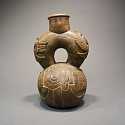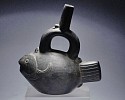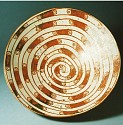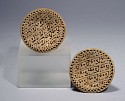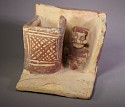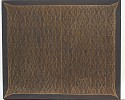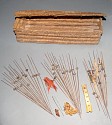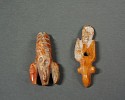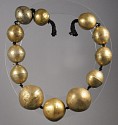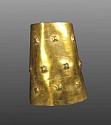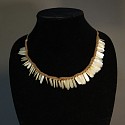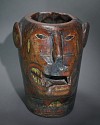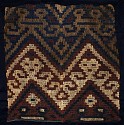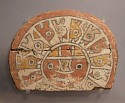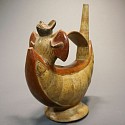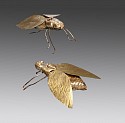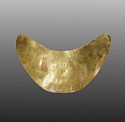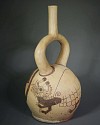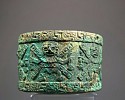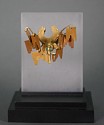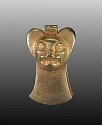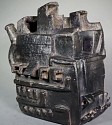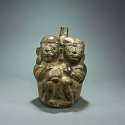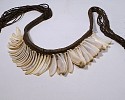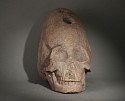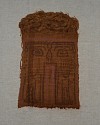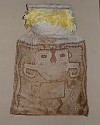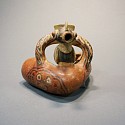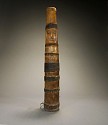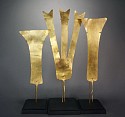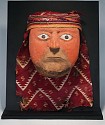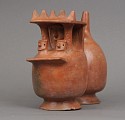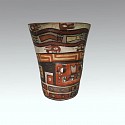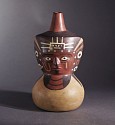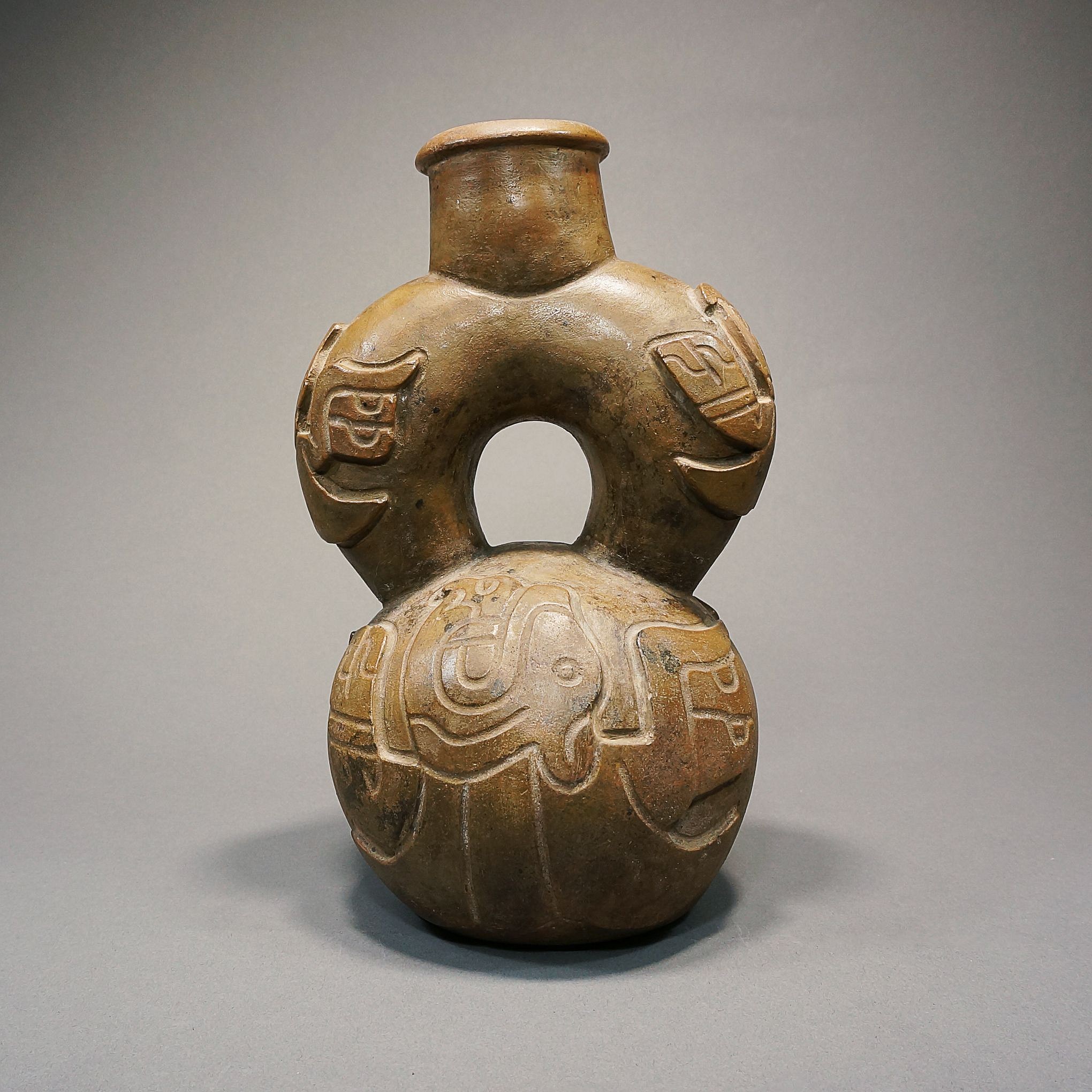
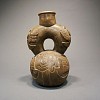

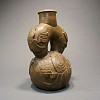
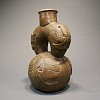
Peru, Chavin Cupisnique Style Stirrup spout Vessel Decorated with a Harpy Eagle.
Period: Peru, Chavïn, Cupisnique, Middle Phase, North Coast, circa 1200-800BC
Media: Ceramic
Dimensions: Height: 8"
Price Upon Request
n2067
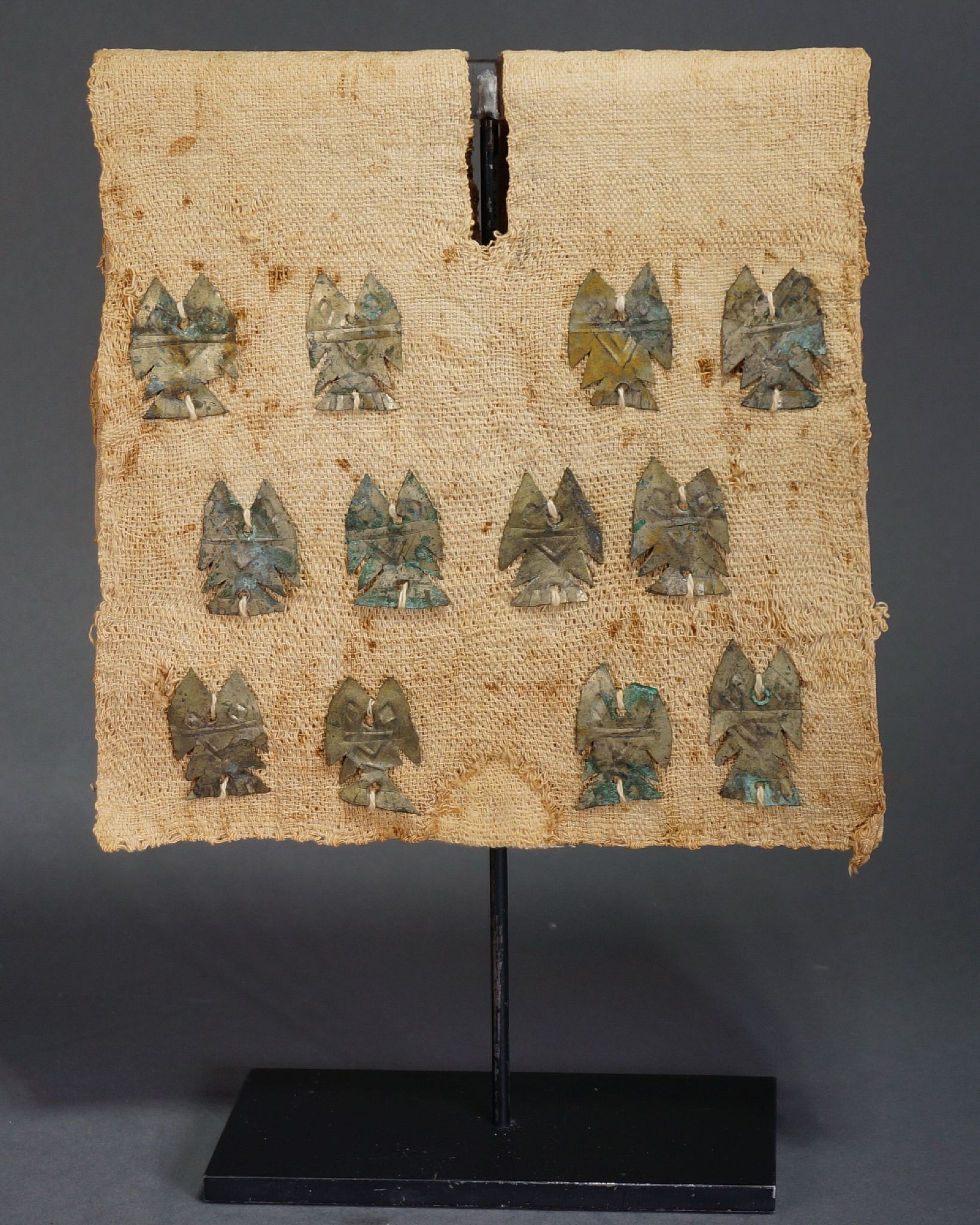


Peru, Miniature Tunic with Fish Appliques
This rare small tunic was made for a child or perhaps a doll. The silver fish are individually crafted - cutout with repousse details. The fish are attached with the original thread, through holes in the fish, and are applied to both the front and back of the tunic. The Metropolitan Museum of Art in New York possesses a similar miniature tunic, pair of shoes, and coca bag, all made in the same style using textiles with square-shaped silver appliques. These items, along with a larger textile, are illustrated in the Textile Museum's publication Costumes and Featherwork of the Lords of Chimor, figs. 148, 167,168.
Period: Peru, Chimu, Central Coast, c. AD 900 - 1350
Media: Textile
Dimensions: Width: 7" x Length: 13 1/2"
$2,500
91201A
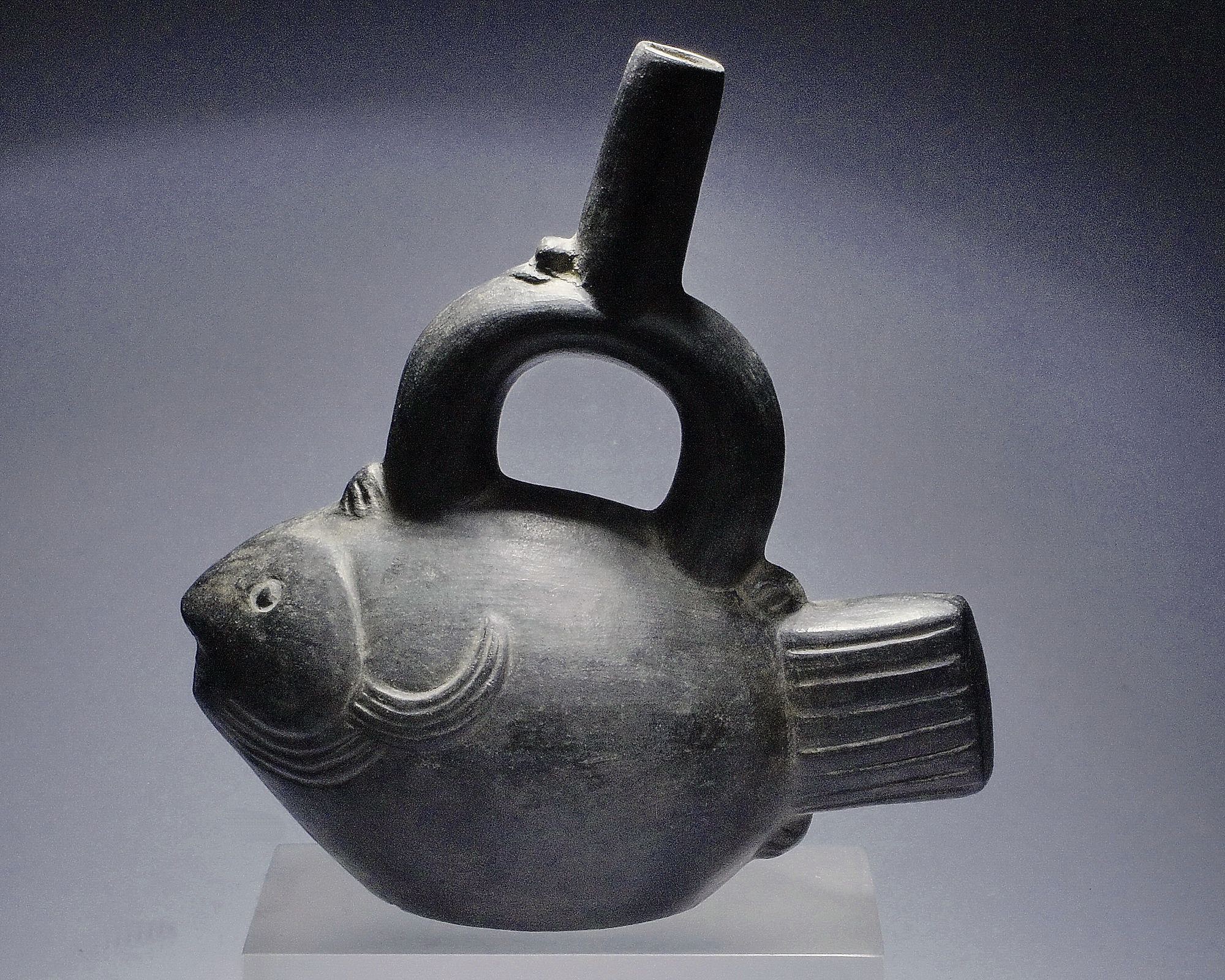




Peru, Blackware Vessel in The Form of a Bonito
This fish is identifiable as a bonito by its pointed mouth and teeth. In the same family as tuna, but smaller, the bonito is one of the most abundant fish in north coastal Peru.
Period: Peru, Lambayeque, North Coast, c. AD 500 - 1100
Media: Ceramic
Dimensions: Length: 8" x Height: 8 1/4"
$1,500
n2016
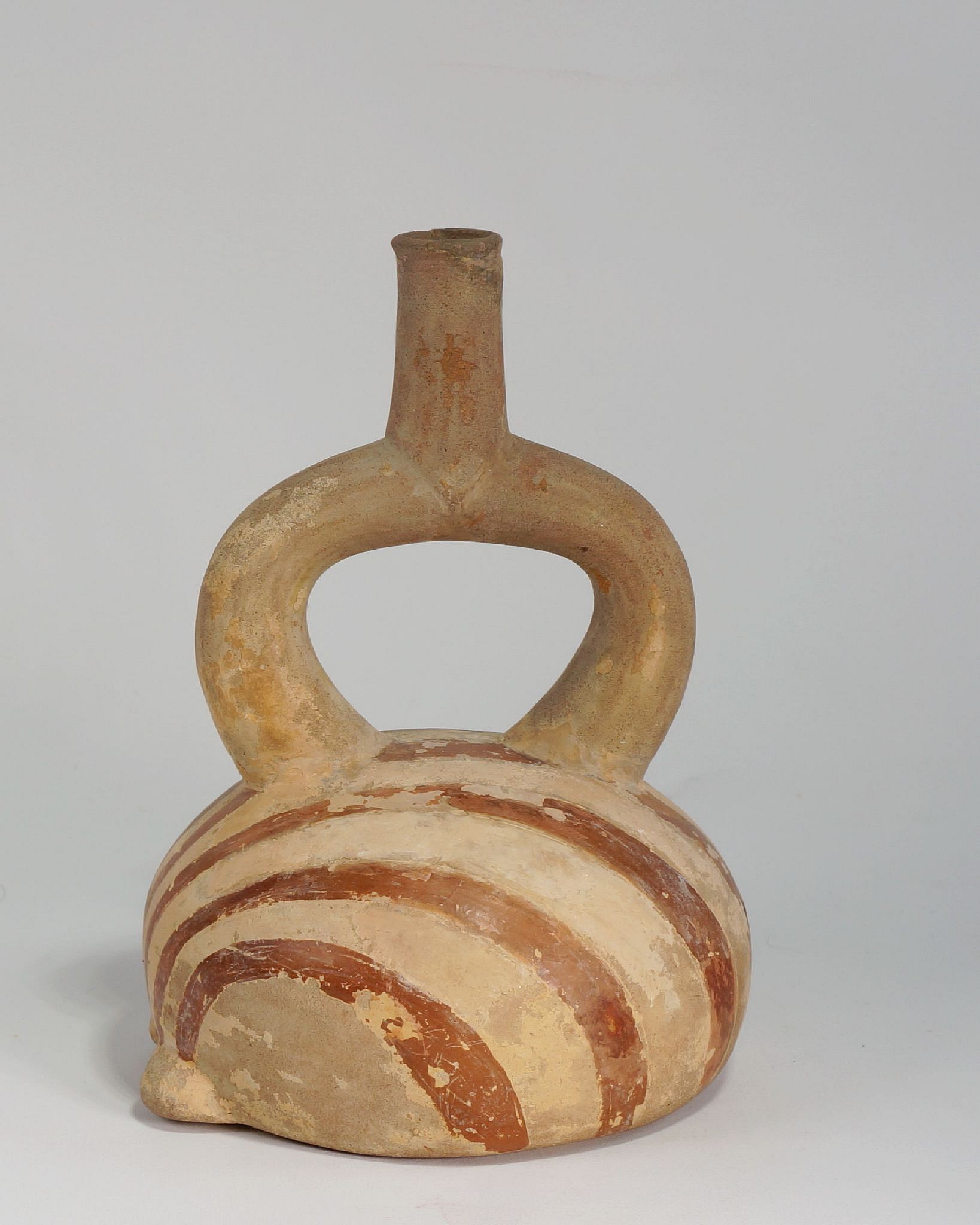




Peru, Stirrup Spout Vessel Depicting a Scallop
This elegant vessel is modeled after the Argopectin purpuratus (the Peruvian calico scallop). It is decorated with swirling painted stripes in brown slip on a cream ground and is a typical example of Moche realism. During El Niño events, bivalves proliferate along the coast; scallops are the most abundant species. The bivalves, in turn, attract octopi, which feed almost exclusively on these mollusks. Octopi are a frequent theme in Moche art. A similar example of a stirrup spout vessel in the form of a bivalve shell is illustrated in The Spirit of Ancient Peru: Treasures from the Museo Arqueologico Rafael Larco Herrera, edited by Kathleen Berrin (1997: fig. 41).
Period: Peru, Moche II, North Coast, c. AD 200 - 350
Media: Ceramic
Dimensions: Height 7"
Price Upon Request
95065
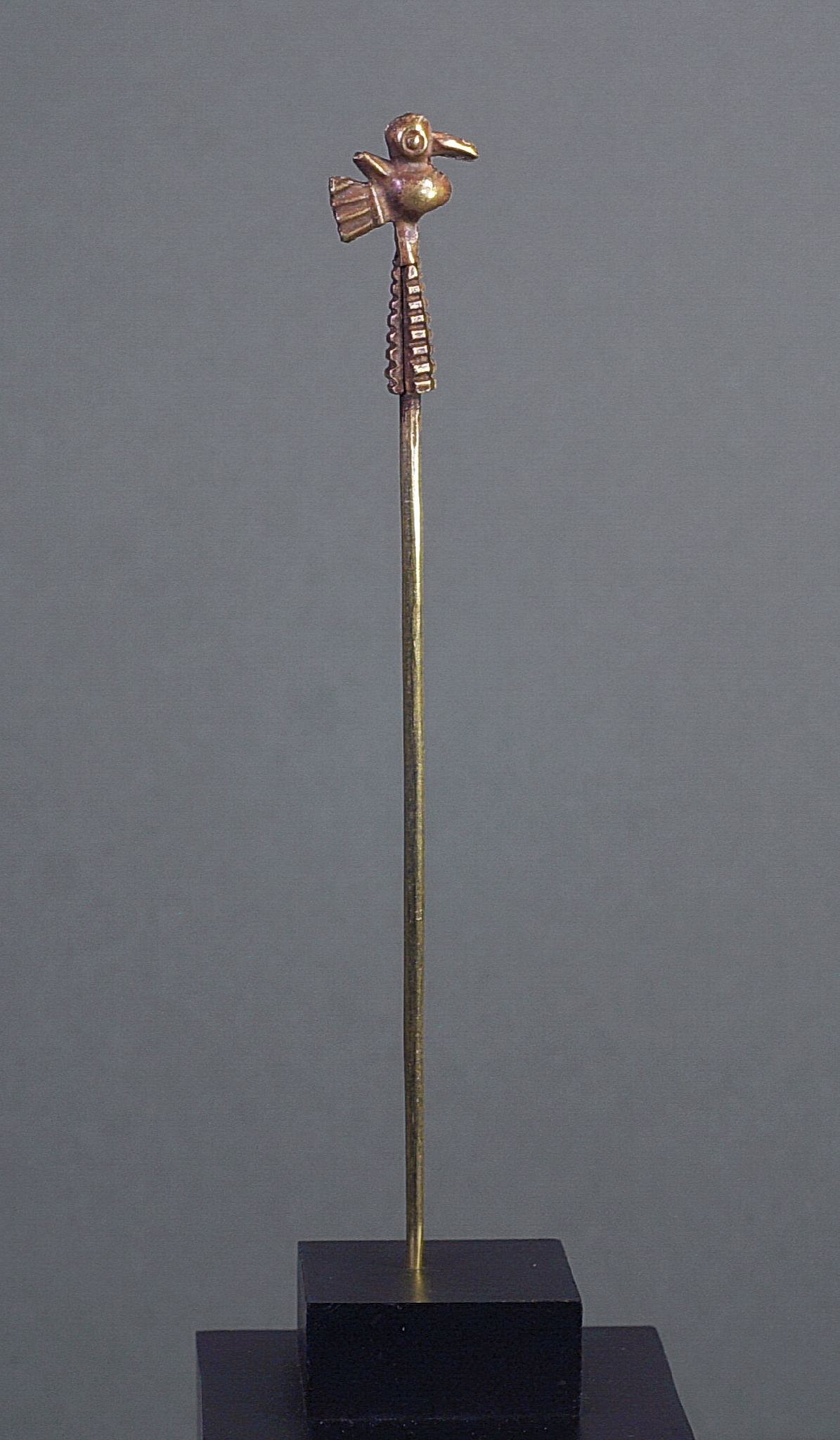





Peru, Inca Gold Fastening Pin Topped with Bird Perched on Corn Cob
Gold works of art from the Inca period is rare, as most Inca gold was confiscated and melted down by the Conquistadores during colonization. This apparently simple cast pin is quite complicated in its manufacture. The pin and the corn cob were cast, whereas the bird is made of a separate stamped sheet - designed head-to-head, bent, and soldered to itself. The bird was then fitted over the top to create the appearance of a single cast object. A similar piece appears in Kunst Und Kultur von Peru (Art and Culture of Peru) by Max Schmidt, page 396. From a private Florida collection, acquired prior to 1980.
Period: Peru, Chimu, North Coast, c. AD 900 - 1350
Media: Metal
Dimensions: Length: 5" Weight: 4.7 grams.
$1,950
MM625
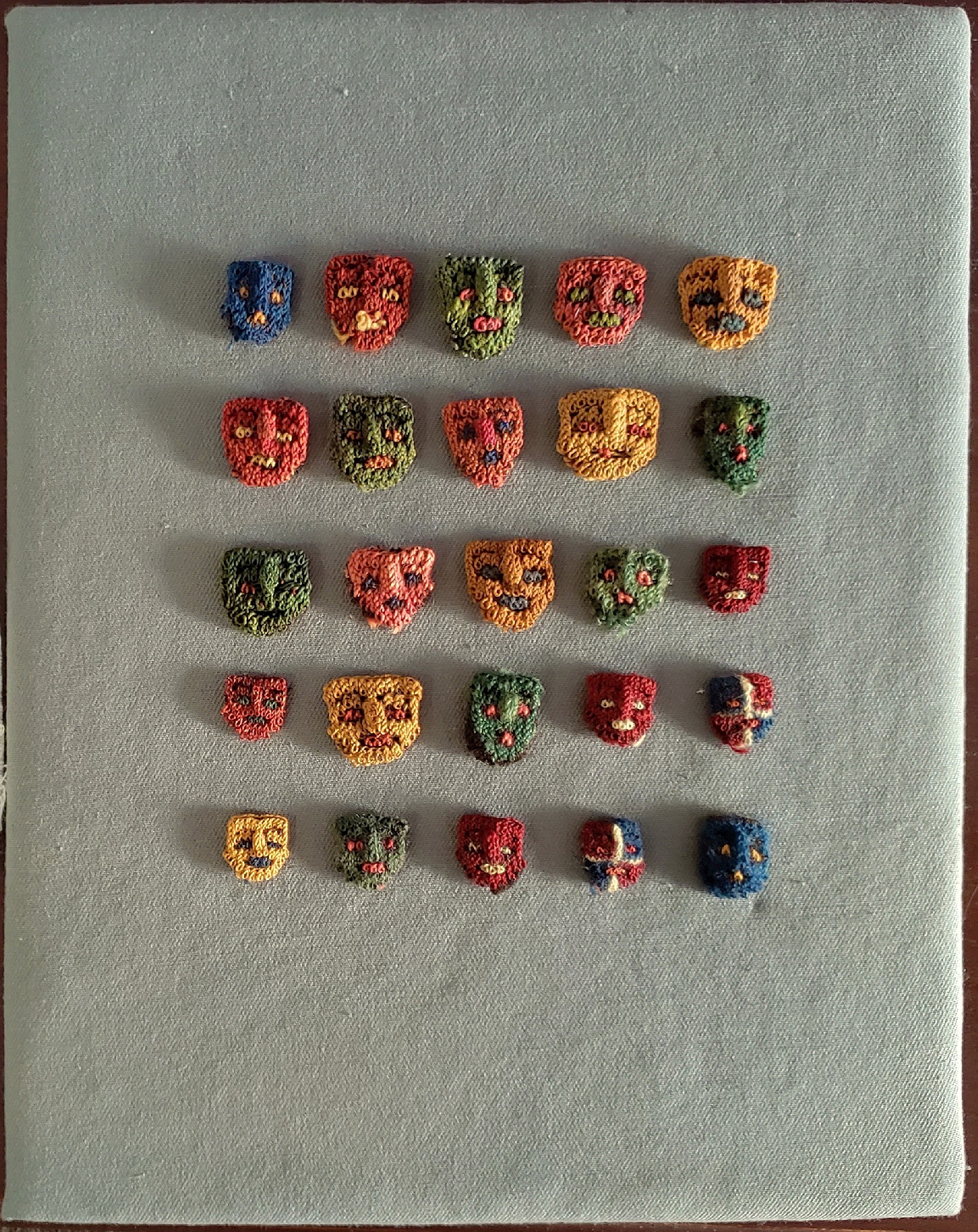


Peru, 25 Proto-Nasca Knitted Miniature Faces in Blue, Green, Pink, Red and Yellow
The faces were from a fancy fringe, made using the cross-loop needle stitch. Each face has two or more colors. They may have represented trophy heads, or perhaps were used as totems guard against evil spirits. Houston private collection, prior to 1980.
Period: Peru, Proto-Nasca, South Coast, c. 100 BC - AD 200
Media: Textile
Dimensions: Mounted in a shadow Box 10" x 11"
$1,500
p2039

Peru, 3 Inca Slings
These three slings double as tethers and were used to restrain llamas by attaching them through a hole in the ear. Llamas were herded by the Incas and were the primary source of cargo transport in the Andes. A llama could carry up to ninety pounds of cargo on its back.
Period: Peru, Inca, South Coast, c. AD 1200 - 532
Media: Textile
Dimensions: mounted dimensions: H. 36 x L. 17 in.
$3,000
89505A
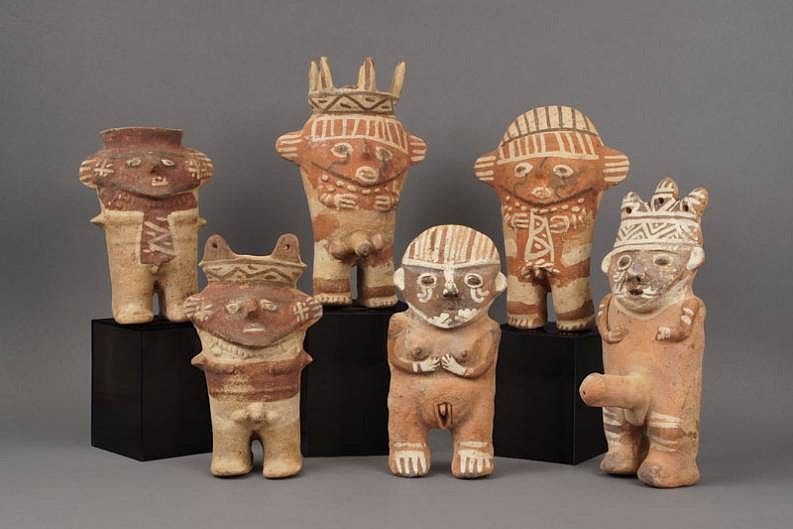
Peru, 3 Pairs of Early Chancay Fertility Figures
These are rare and unusual Chancay figurines with painted surfaces in brick, beige and brown umber. The strong brown umber painted lines suggest an early Chancay phase with Wari influence. The figurines are wearing costumes that suggest important status, particularly the male figures, which each have a crown. The women wear braided hairstyles. The genitalia are exposed in enhanced proportions, likely part of a fertility symbolism related to agricultural production.
Period: Peru, Chancay,/Huari Central Coast, circa AD 900-1100
Media: Ceramic
Dimensions: Height Males c.10" Height of Females c.9"
Price Upon Request
M9014Hb
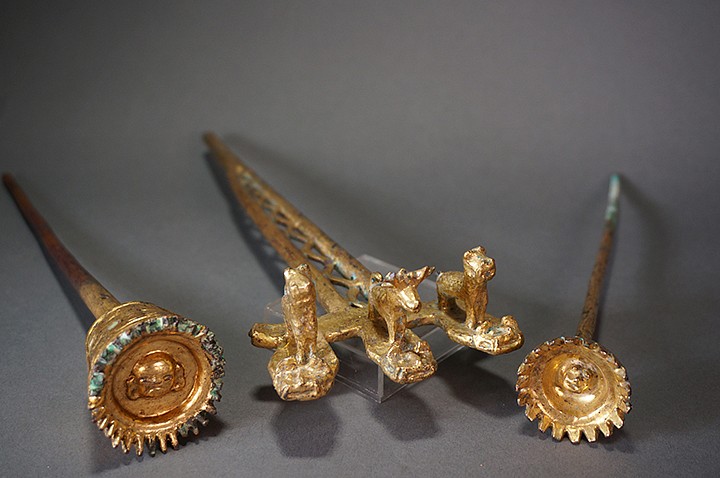








Peru, A Rare Recuay Gilt Scepter
This scepter is very rare with an unusual motif of three animals standing on three flayed feline skins. The central animal is a deer flanked by an unknown four-legged animal. The shaft of the scepter has two channels attached by a series of triangular soldered stock. Each channel has a suspension hole towards the top. This scepter must have belonged to a high status individual as its manufacture is very elaborate and technically sophisticated. Only one other known similar Recuay scepter is illustrated in Kultur Von Peru by Max Schmidt, pg. 392. The accompanying two tupus with decorated tops (longer and shorter) each have a different motif.
The longer tupu is decorated with a band of four stooping animals in low relief, each with a serpent emanating from its head. The inside of the the longer tupu’s upper cup is decorated with a frowning face, perhaps a mask. This is one of the largest known intact tupus. The smaller tupu has a rich gilt surface and is decorated with a band of two face masks. Inside the upper cup of the small tupu is the head of the same animal flanking the deer on the scepter. Both tupus have finials that are decorated with both an outside band and an inside head. The larger one has a band of 3 double headed serpents with a fox head inside. The smaller one has a band of a double-headed arched feline and a face inside.
Four tupus excavated at Pashash, the earliest known Recuay site, are illustrated in The Art and Archaeology of PSAHASH by Terence Grieder, figs. 114-117, and fig. 7. These tupus were originally sold by Alan Lapiner in the early 1970s along with a classic Recuay vessel of a lord flanked by arched felines on each side.
Period: Peru, Recuay, North Highlands, c. 300 BC - AD 700
Media: Metal
Dimensions: Scepter Length 9" x Width 3"
Longer Tupu Length 8 ½ x diameter 1 ½â€
Shorter tupu: Length: 7 ½†x diameter 1"
Price Upon Request
M3023
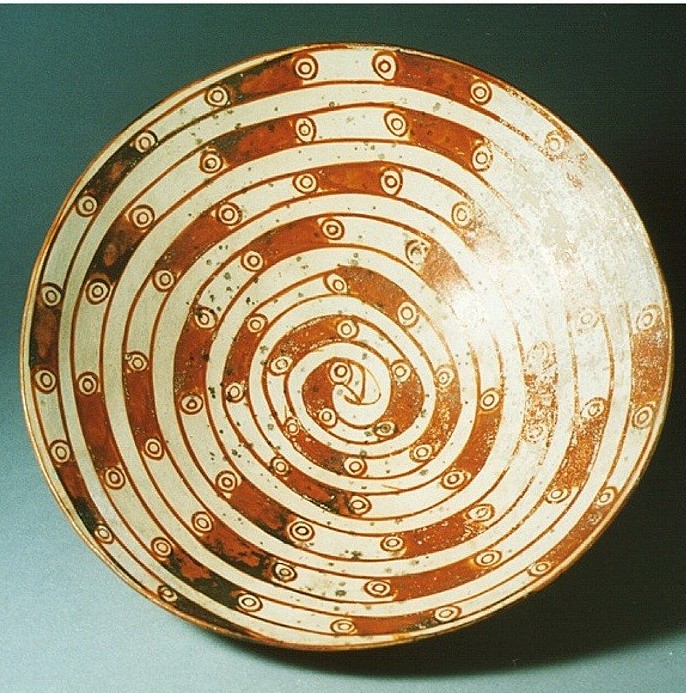
Peru, Cajamarca Low Orangeware Bowls with Coiled Serpent
This bowl has an orange and white spotted coiled serpent motif and a footed base. The Cajamarca culture has a long role in Peruvian pre-history going back to Chavin times until 1532 when the Inca king Atahualpa was killed by Pizarro. Today there still exists a beautiful cut stone "Inca Bath" of warm mineral water that was enjoyed by Inca nobility. A similar style of ancient plate from Cajamarca is in the Museum at Cajamarca. The orange and white slip decoration demonstrates the high artistic control that the Cajamarca artisans had over the medium. A great deal of control over the firing process was required to prevent the orange slip from turning brown
Period: Peru, Cajamarca, North Highlands, c. AD 1000 - 1400
Media: Ceramic
Dimensions: Diameter: 10 inches.
Price Upon Request
97111a
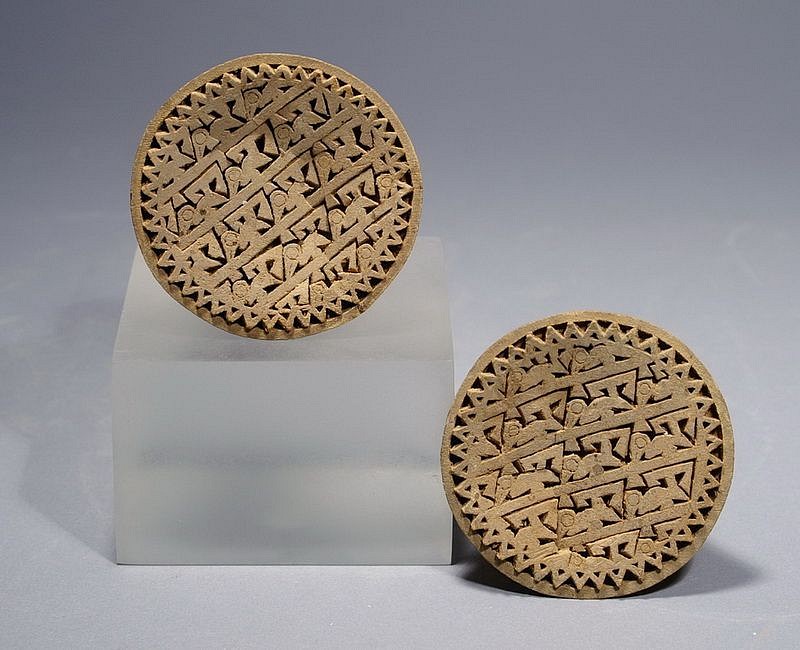



Peru, Central Coast Peruvian Wood Ear Spools
Probably late Huari or early Chancay, these light balsa wood ear spool carved in three sections, depicting a face, body and back. The design is cut out, with four rows of birds in profile – generally typical of Chancay or Chimu art. No glue or tree resin was used to keep the three sections together, rather they are carved perfectly to have a precise fit. Ear spools were used in the ancient Andes to display status and rank. Ex. Daniel Rifkin, acquired in New York prior to 1980.
Period: Peru, Wari, Central Coast, c. AD 650 - 1100
Media: Wood
Dimensions: Diameter: 3" x Depth: 4 1/2"
Price Upon Request
M4011
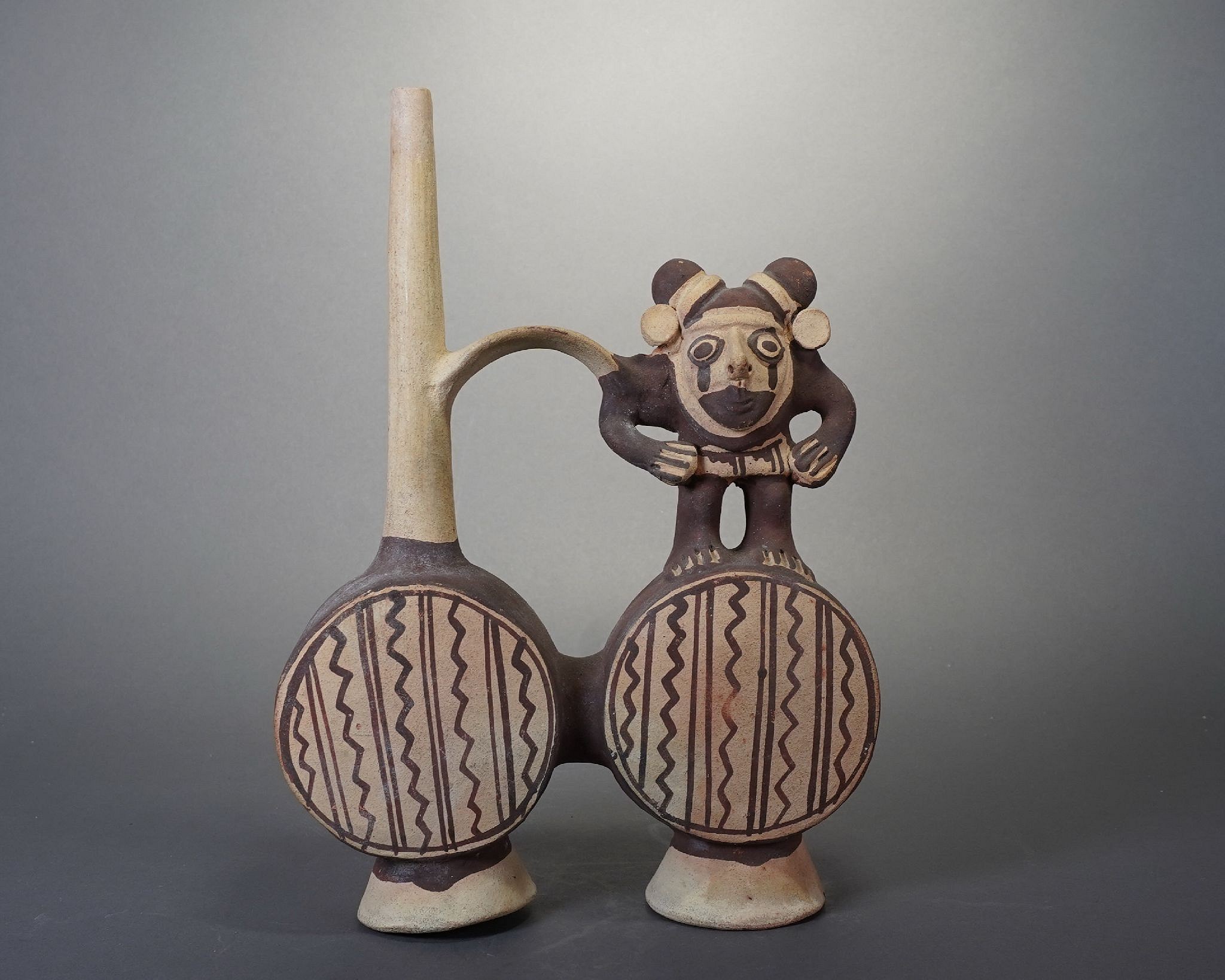



Peru, Chancay Double-Chambered Whistling Vessel with Animal Impersonator
The Chancay people were known for their ceramic workshops, where series of similar items were produced in groups. This bridge-spout vessel has two chambers and is painted with alternating straight and wavy lines. The figure sitting atop the vessel is an Animal Impersonator of a monkey. “Animal Impersonator†is a term used by Pre-Colombian scholars to refer to a shaman who dresses as a certain animal to embody the mythological characteristics associated with that animal. Monkeys, who dwell at the top of the forest canopy in the Amazon, are associated with ancestral secrets in Andean mythology. This shaman has a hairstyle arranged in two coils to resemble monkey ears, as well as white ear spools. He is hunched over and holds a weaving in his arms.
This vessel may have been used to pour a psychoactive brew as part of a shamanic rite. When brew was poured, the air moved from one chamber to the other, creating a whistling sound. The tone of the whistle was created by the specific shape of the resonance cavity. Whistling sounds would have enhanced the shamanic ritual. According to author Daniel K. Stat’s article Ancient Sounds: The Whistling Vessels of Peru, “the psycho-acoustical effects appear to be created by low frequencies or difference tones, or possibly the interaction of harmonic principles, which are produced when several vessels from a specific culture are played simultaneously.â€
This vessel would also have been intended for its owner for use in the afterlife.
Period: Peru, Chancay, Central Coast, c. 900 - 1300
Media: Ceramic
Dimensions: Height: 10 1/2" x Width: 7"
$1,400
n9047



Peru, Chancay Fringed Tapestry Border with Cats and Birds
This was likely the border of a tunic and was made as two loom widths sewn together with an additional fringe sewn horizontally. The design of cats and birds alternating in angled bands is bordered above and below with rows of additional small birds. It is unusual to see such red and gold highlights dyed on cotton.
Period: Peru, Chancay, Central Coast, c. AD 1100 - 1430
Media: Textile
Dimensions: Width: 37" Height: 9"
$2,200
94277
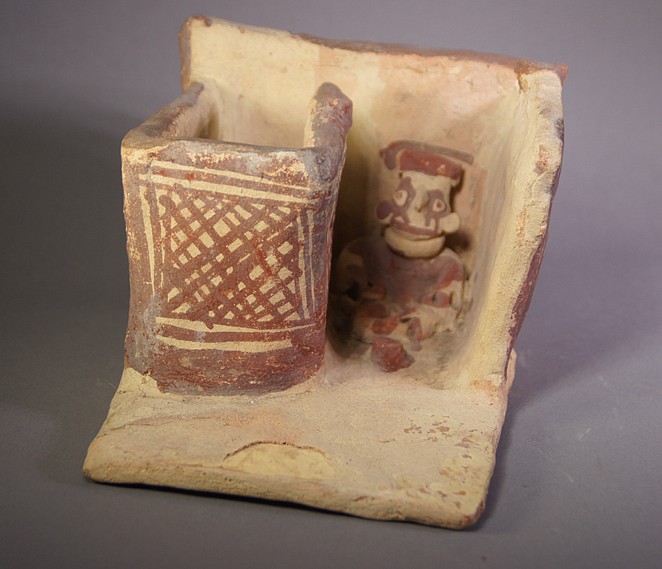




Peru, Chancay House with Seated Man in Two Room Interior
This ceramic piece represents the interior of a house. The inside is divided into two alcoves. One alcove is enclosed on three sides, with a crosshatch pattern on the exterior, and the other is open to expose a seated man facing outward. He sits with an open vessel in front of him. The two outside walls are higher than the ones inside.
Period: Peru, Chancay, Central Coast, c. AD 1100 - 1430
Media: Ceramic
Dimensions: Length, 7 2/8 in, width 4 12/16 in, height 4 in.
Price Upon Request
92237
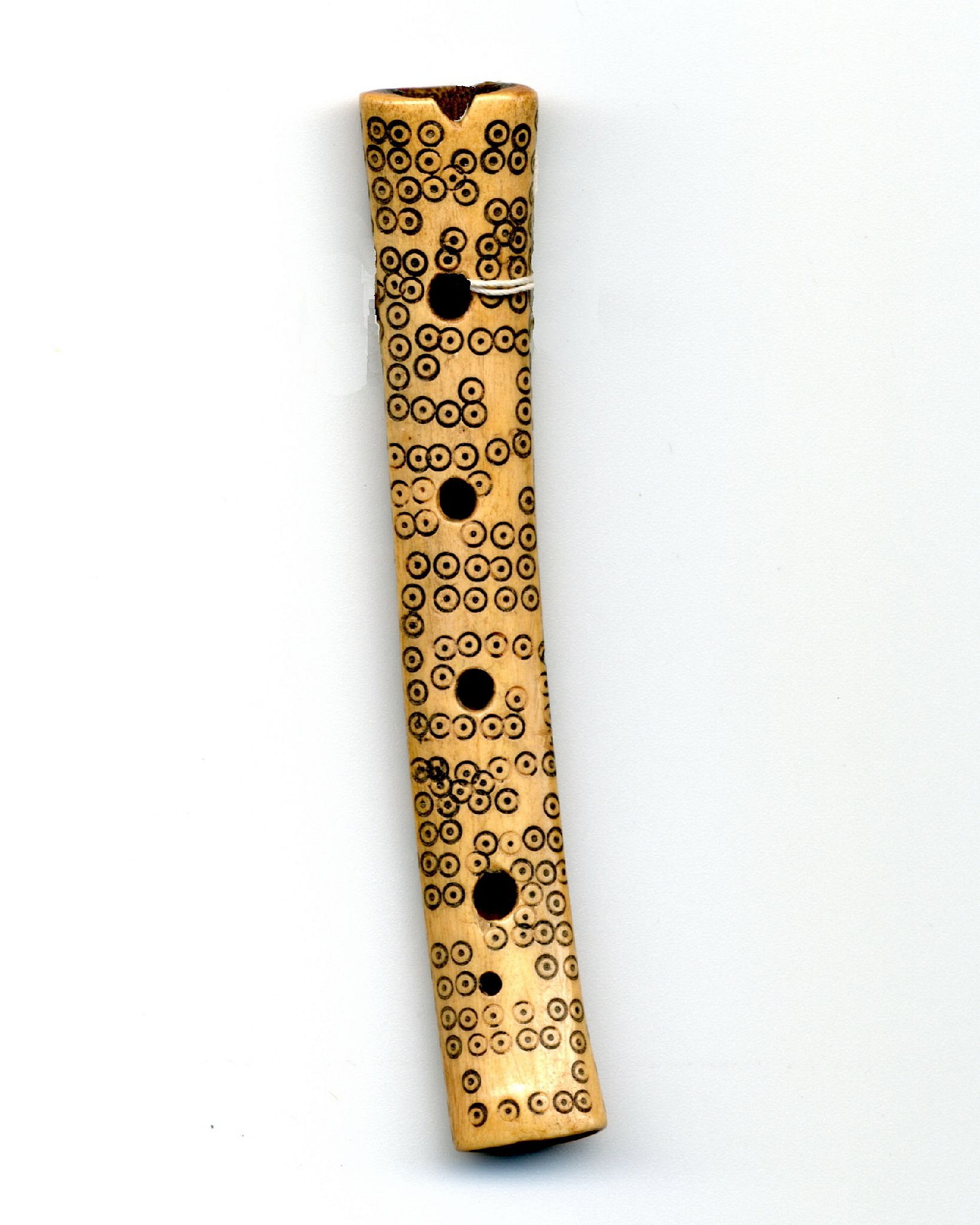
Peru, Chancay Miniature Bone Flute with Incised Circles and Four Holes
A flute made of animal bone decorated with over 175 circles with dots, likely representing the spots of the jaguar. There are two suspension small suspension holes on the opposite side. Similar bone flutes are represented in MUSIC OF ELDORADO by Dale A. Olsen pg.39 There have not been any studies so far to determine the symbols of the circles. Acquired in 1992 from Robert Kommer, Washing State.
Period: Peru, Central Coast, c. AD 900 - 1350
Media: Bone
Dimensions: Length: 3 1/2"
$475
92092
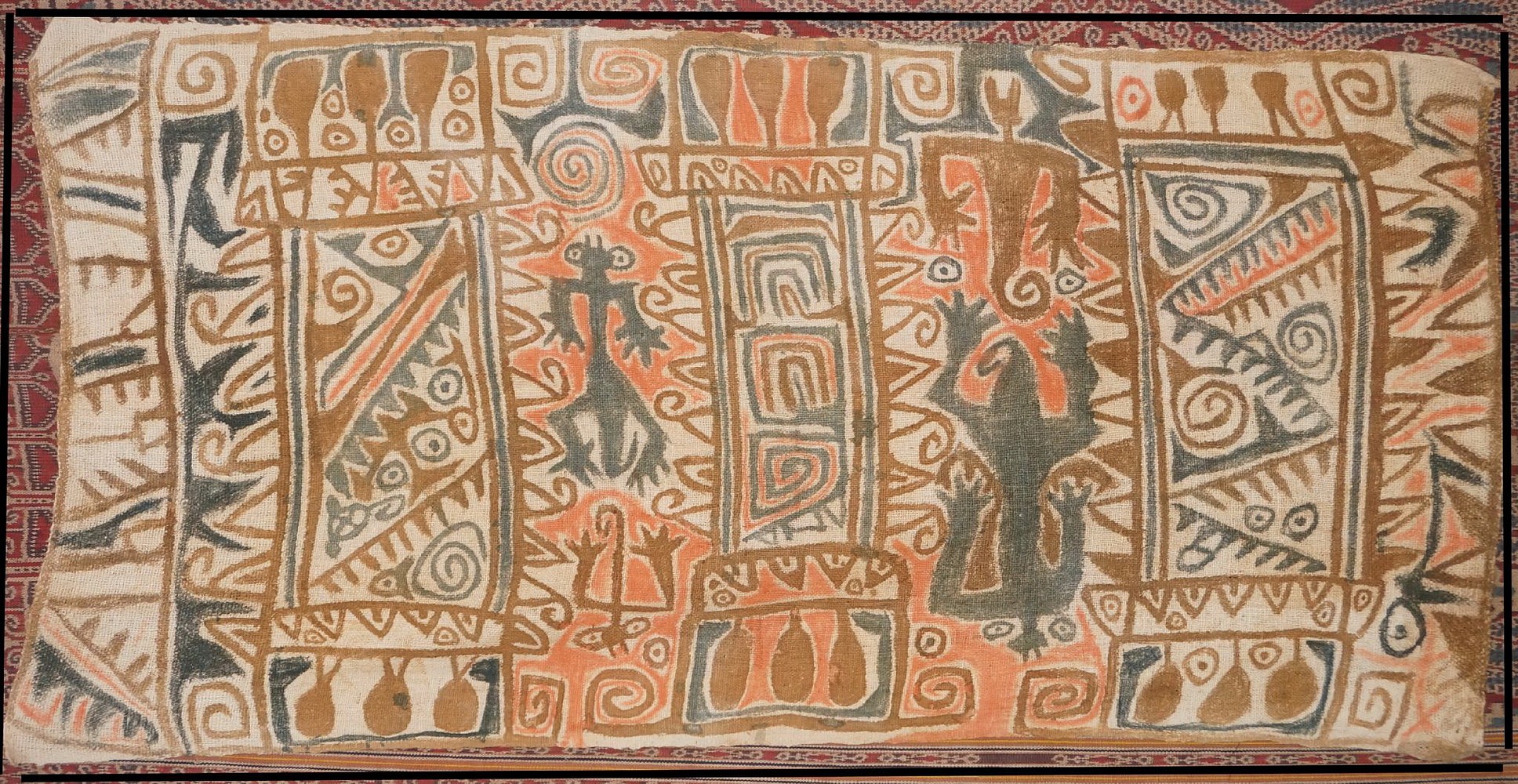


Peru, Chancay Painted Cotton Panel with Four Abstract Figures and Symbols
The cotton panel is painted in blue, tan and orange. The drawing can be interpreted as 3 woven panels or tunics with fringes, each decorated with different abstract designs. On each side of the central panel are two abstract creatures with curly tails on an orange ground.
Period: Peru, Chancay, Central Coast, c. AD 900 - 1500
Media: Textile
Dimensions: Length: 46" x Width: 23"
$7,500
n6056h
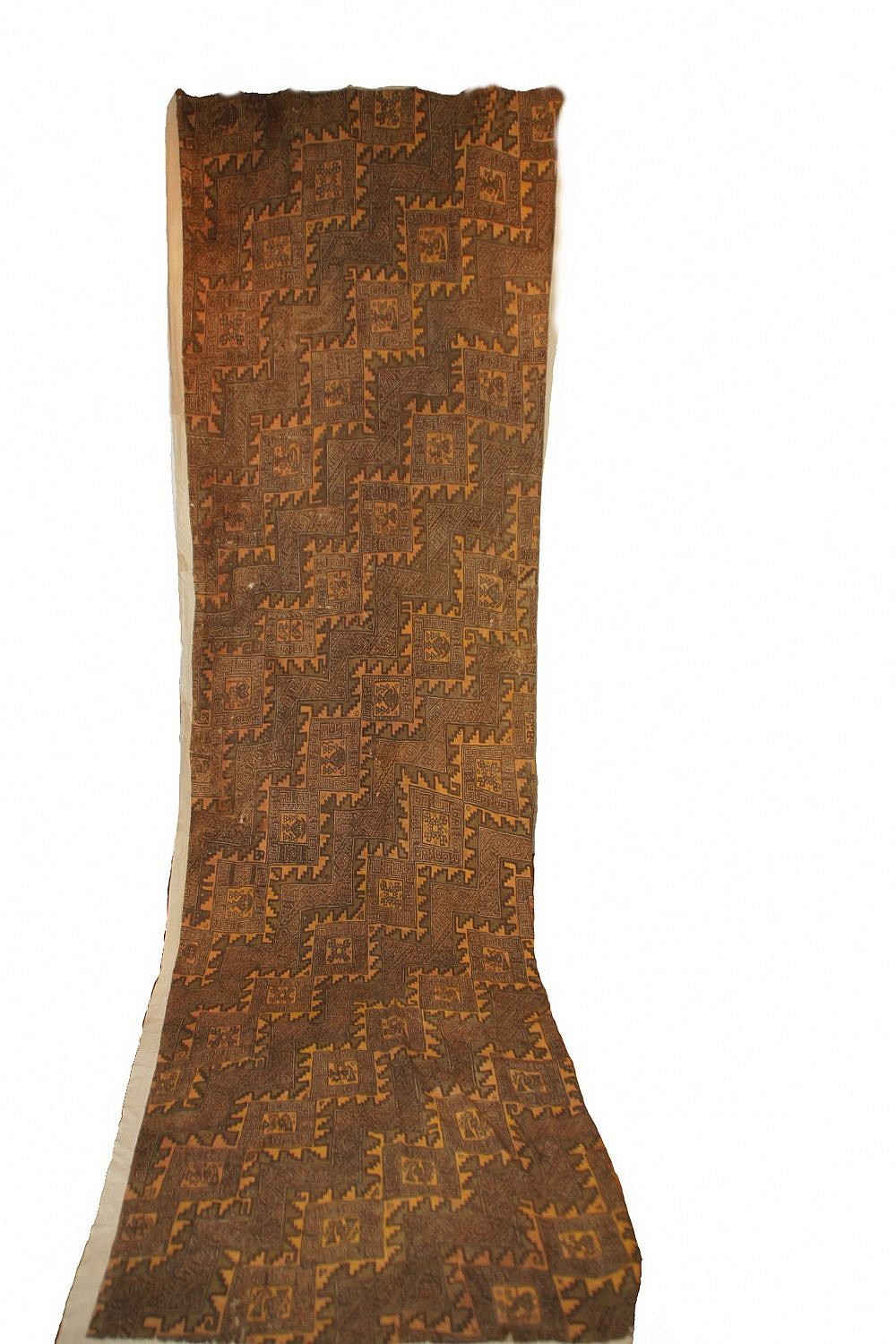




Peru, Chancay stamped decorated woven panel
The decoration is a combination of resist dying and then stamped design. There are over 7 different motifs all arranged in diagonal patterns.
Period: Peru, Chancay, Central Coast, c. AD 1100 - 1430
Media: Textile
Dimensions: Length: 15'(180") x Width: 4'(48")
$15,000
N2027
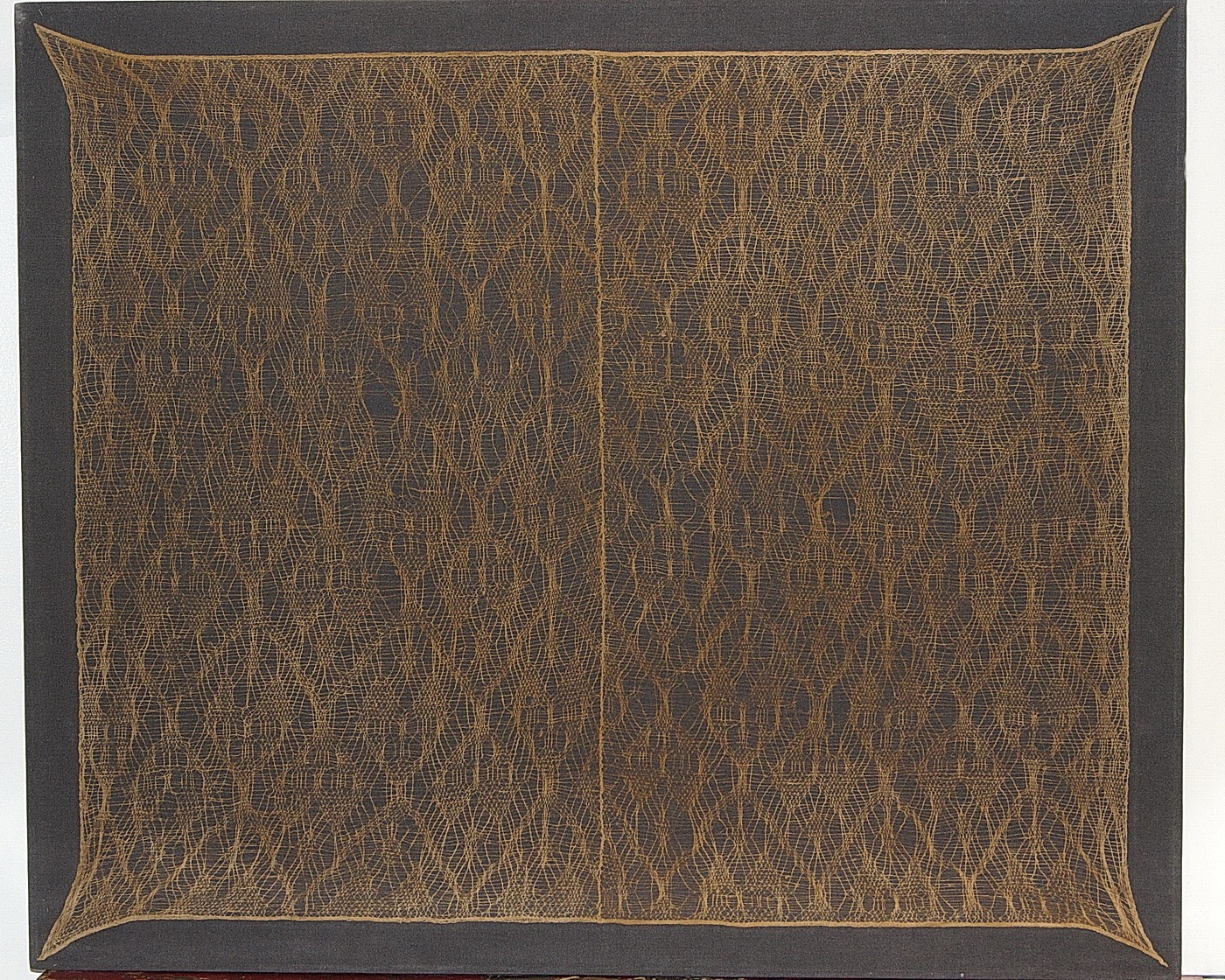
Peru, Chancay Tan Gauze Witch's Vail with a Complex Pattern of Cat Faces
Tan cotton complex gauze decorated with a lace-like pattern of cat faces in alternating orientations. Witches’ vails are often seen on Chancay dolls. This example has tightly spaced cat faces, making the gauze very dense and complex.
Period: Peru, Chancay, Central Coast, c. AD 1100 - 1430
Media: Textile
Dimensions: Height 38" x Width 32"
$3,350
94277A
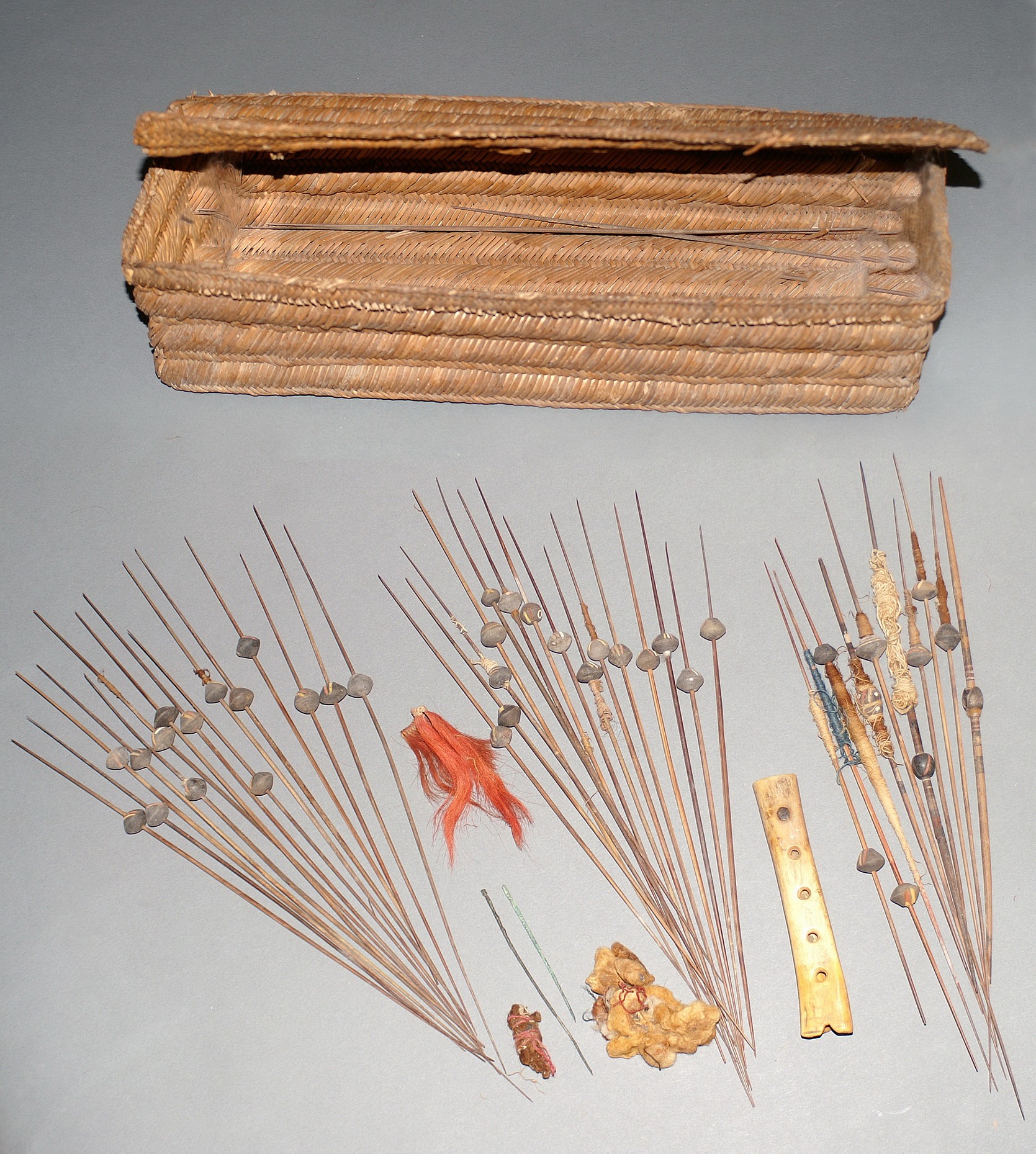






Peru, Chancay Weaver's Basket with Implements
This is a large basket, made of woven rush and contains 40 spindle whorls with different color arrangements. 18 with yellow and orange notched ceramic whorls, 8 with white, yellow and orange whorls, and 8 with spun cotton thread. There are 2 whorls with circles and 4 with polka dot designs. There are 2 copper needles, cotton samples, and a bone flute.
Period: Peru, Chancay, Central Coast, circa AD1100- 430
Media: Textile
Dimensions: Length 16" x Width 5" x Height 3 1/2"
Condition: Very good, as found with the original contents
Price Upon Request
N1043
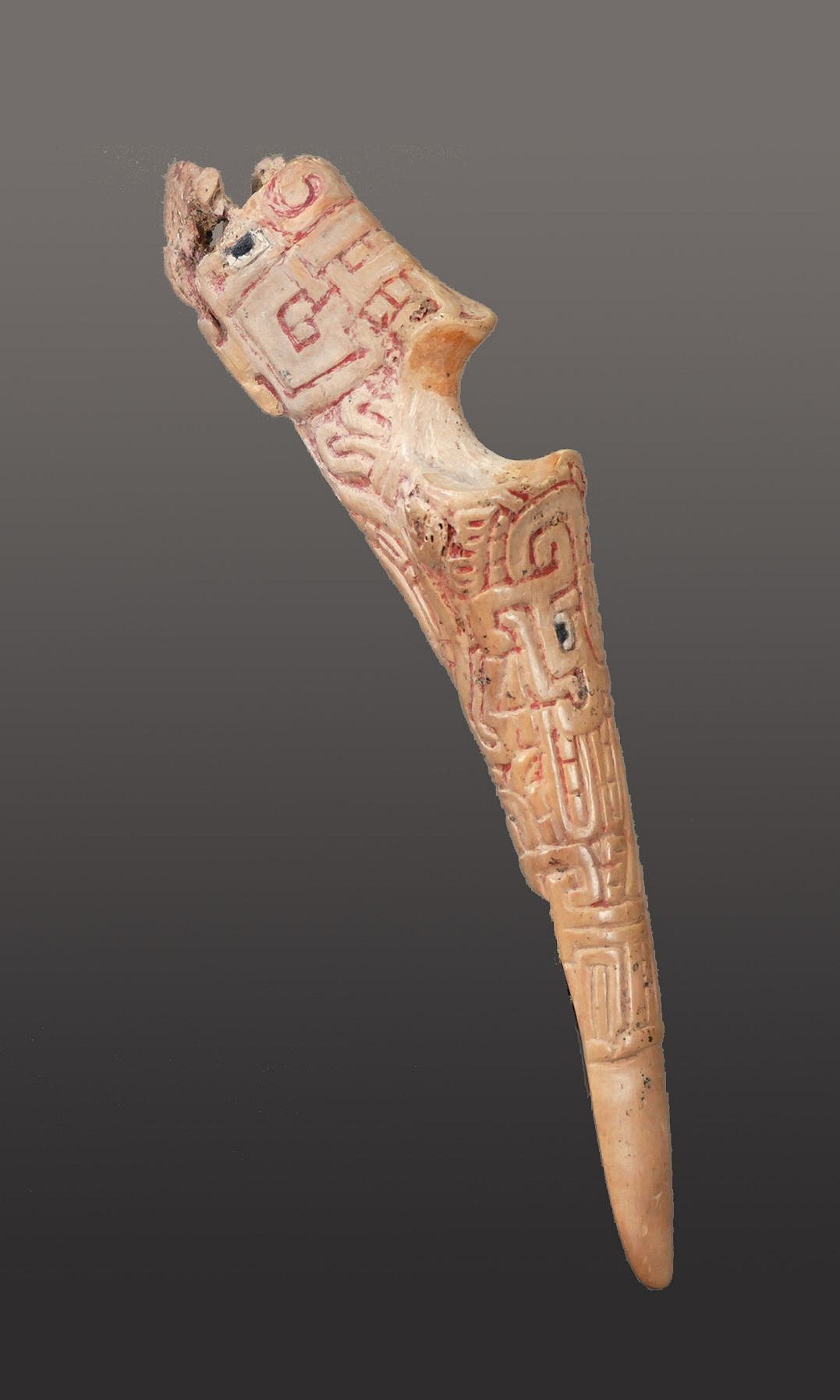





Peru, Chavin Carved Bone Spatula with Incised Morphed Faces
The bone is highly polished all over. The primary figure is a monster with a large mouth, snarly nose, and shell inlaid eye on each side. The body is carved with abstracted motifs. On the lower front side is a profile of the monster's head with a large mouth opening into the bone's joint. A similar example is illustrated in THE INKA EMPIRE AND ITS ANDEAN ORIGINS- pl.30 and is also on exhibit at the American Museum of Natural History, NY.
Period: Peru, Chavin, Cupisnique, Late Phase, North Coast, c. 700 - 400 BC
Media: Bone
Dimensions: Length: 6 1/4" x Wifth at shoulder 1 1/4"
$6,000
94149
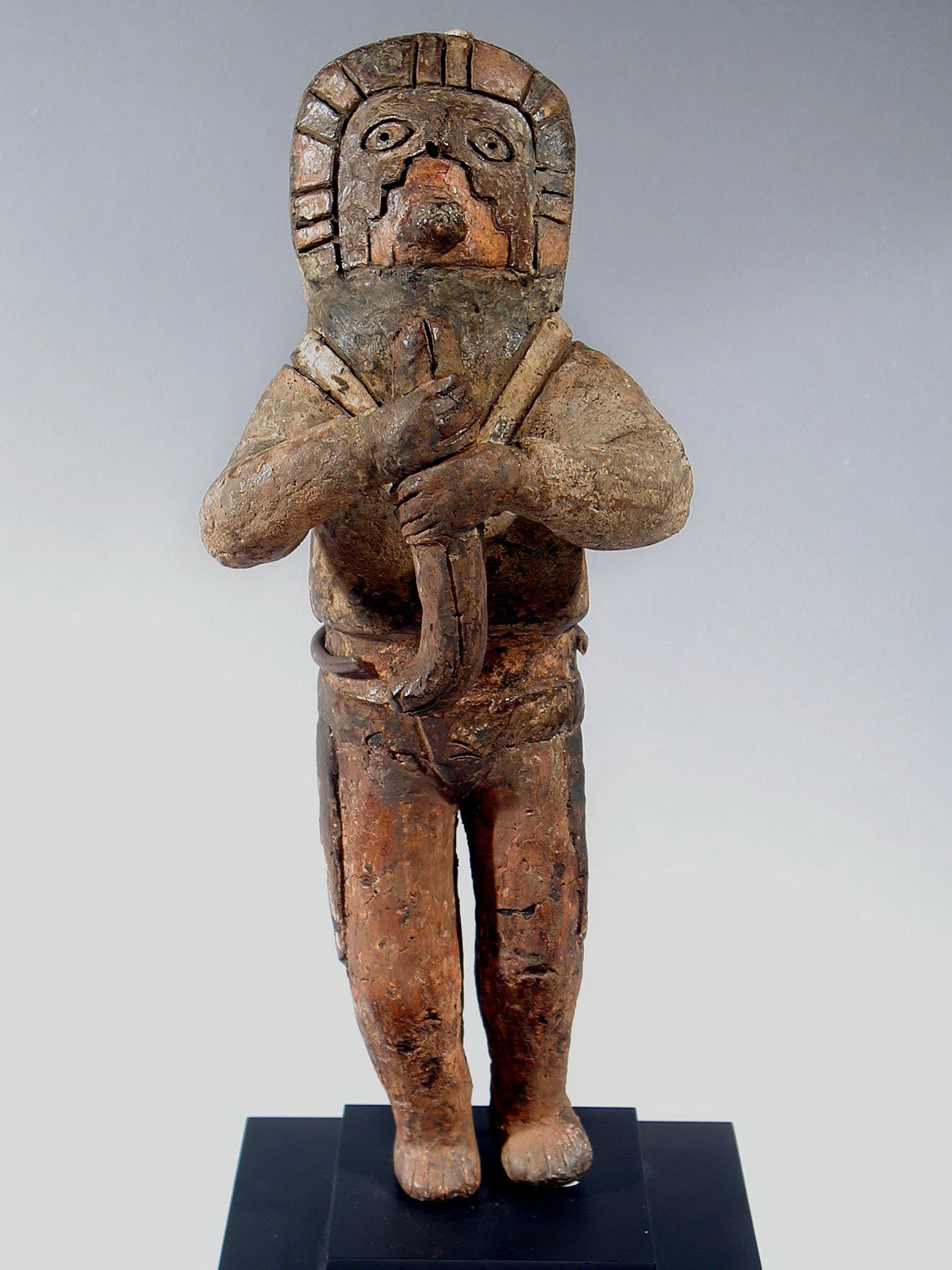



Peru, Chavin carved wood effigy of a shaman
Carved wooden effigy of a standing shaman holding a flute or serpent in front. The shaman has puckered lips as if he is whistling and appears in a trance like state. He is wearing a headdress, v neck tunic and belt with two long devices hanging down along the outside of each leg. On the back of the belt is a "U" shaped device of unknown use. From the top of the head emeniates a bone tube which has been broken. A similar shaman's face is illustrated in PRECOLUMBIAN ART OF SOUTH AMERICA by Alan Lapiner fig. 13. Wooden effigy figures are extremely rare and do not survive well. The left leg was broken off and re-attached and the evidence of age was apparent.
Period: Late Chavin, North coast Peru 700-400 B.C.
Media: Wood
Dimensions: Height 9.1/2"
Price Upon Request
95057
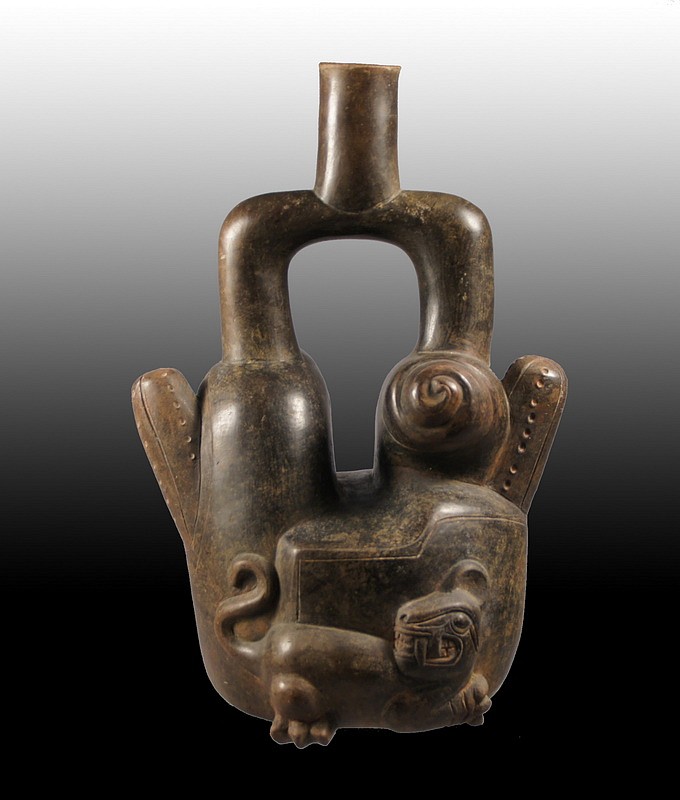







Peru, Chavin Ceramic Depicting a Recumbant Jaguar With San Pedro Cactus
On each side of the vessel there is a jaguar lying outside of a structure which is possibly a cave or a temple. A San Pedro Cactus is aside a Strombus shell; both have strong symbolic meaning for the Chavin feline cult. As the largest and the most -feared terrestrial carnivore in the Amazon, the jaguar serves as a natural symbol of raw aggression. Chavin shamans respected the jaguar for its nocturnal hunting skills and its ability to swim and climb into the forest, ruling earth, water and sky as their domain. Literary references of the same motif appear in The British Museum, The American Museum of Natural History, The Munson-Proctor Institute in Utica, and The Larco Herrera Collection at the Museo Nacional de Antropologia y Arqueologia in Lima.
Period: Peru, Chavïn, Cupisnique, Middle Phase, North Coast, circa 1200-800BC
Media: Ceramic
Dimensions: Height 10 3/4"
Price Upon Request
n2059
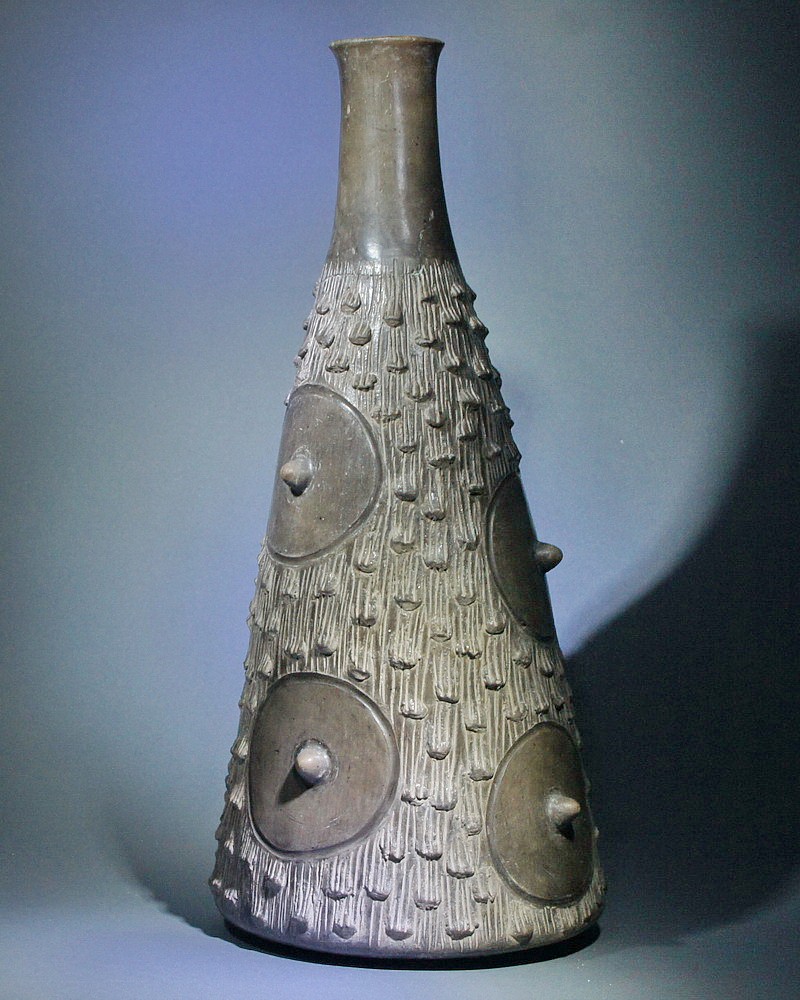
Peru, Chavin Cupisnique Style of a San Pedro Cactus
Vessel with long body, long spout, and concentric circular ornaments. Similar examples to be found in "Chavin Perus Geheimnisvoller Anden-Tempel" on page 285, and 359. Vessels like these were not usually made to destroy but to serve as vehicles for transporting the Chavin Cult. The surface area is highly burnished and original. The vessel is large for its type.
Period: Peru, Chavïn, Cupisnique, Middle Phase, North Coast, circa 1200-800BC
Media: Ceramic
Dimensions: Height 13"
Price Upon Request
n2058
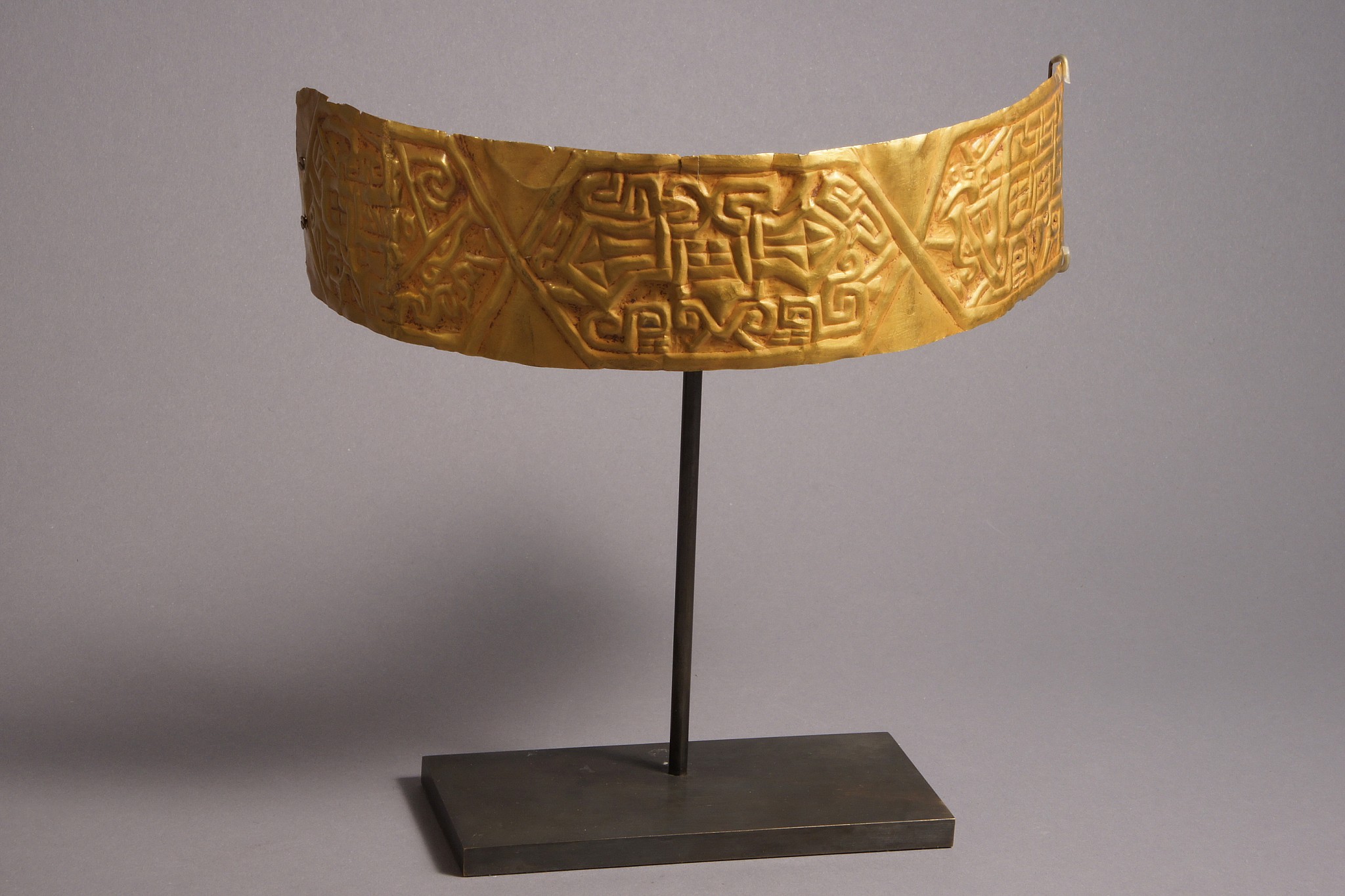



Peru, Chavin Gold Crown With Embossed Design
Chavin artists hammered gold sheets over wooden molds to make crowns and pectorals for the ruling elite. This crown was cut down and repaired in antiquity, but it originally had two profile faces on the sides and two frontal images of the feline deity so often seen in Chavin art. A cuff from the same grave lot is on display at the Houston Museum of Fine Arts with faces separated by diagonal designs. This crown is published in Jose Antonio Lavalle "Oro Del Antiguo Peru" (1992: pl. 10). Samuel K. Lothrop was the first scholar to analyze gold crowns and plaques that came from two tomb lots in Chongoyape, "Gold Artifacts of Chavin Style" (American Antiquity 1951, 3: 226 - 240). His work and other tomb finds are reviewed by Richar L. Burger in "Chavin and The Origins of Andean Civilization" (1992: 204 - 206) A number of crowns similar to this one are known to have come from these tombs, which also yielded gold cuffs, ear spools, nose pendants, chest plaques and tweezers. Examined and approved by Robert Sonin and Henri Reichlin in 1976. Ex-collection Marcel Ebnother, Switzerland.
Period: Peru, Chavin, North Coast Peru, Late Initial Period, circa 1200-200BC
Media: Metal
Dimensions: Length 11. 1/2" x Height 2"
Price Upon Request
M6075



Peru, Chavin Gold Pin with Simple Twisted and Hammered Diamond Design
This unusual diamond-shaped pin was made from one flat sheet that was hammered and twisted.
Period: Peru, Chavin, North Coast, c. 200 - 500 BC
Media: Metal
Dimensions: Length: 5 1/8" x Weight: 3.1 grams.
$1,200
N5041
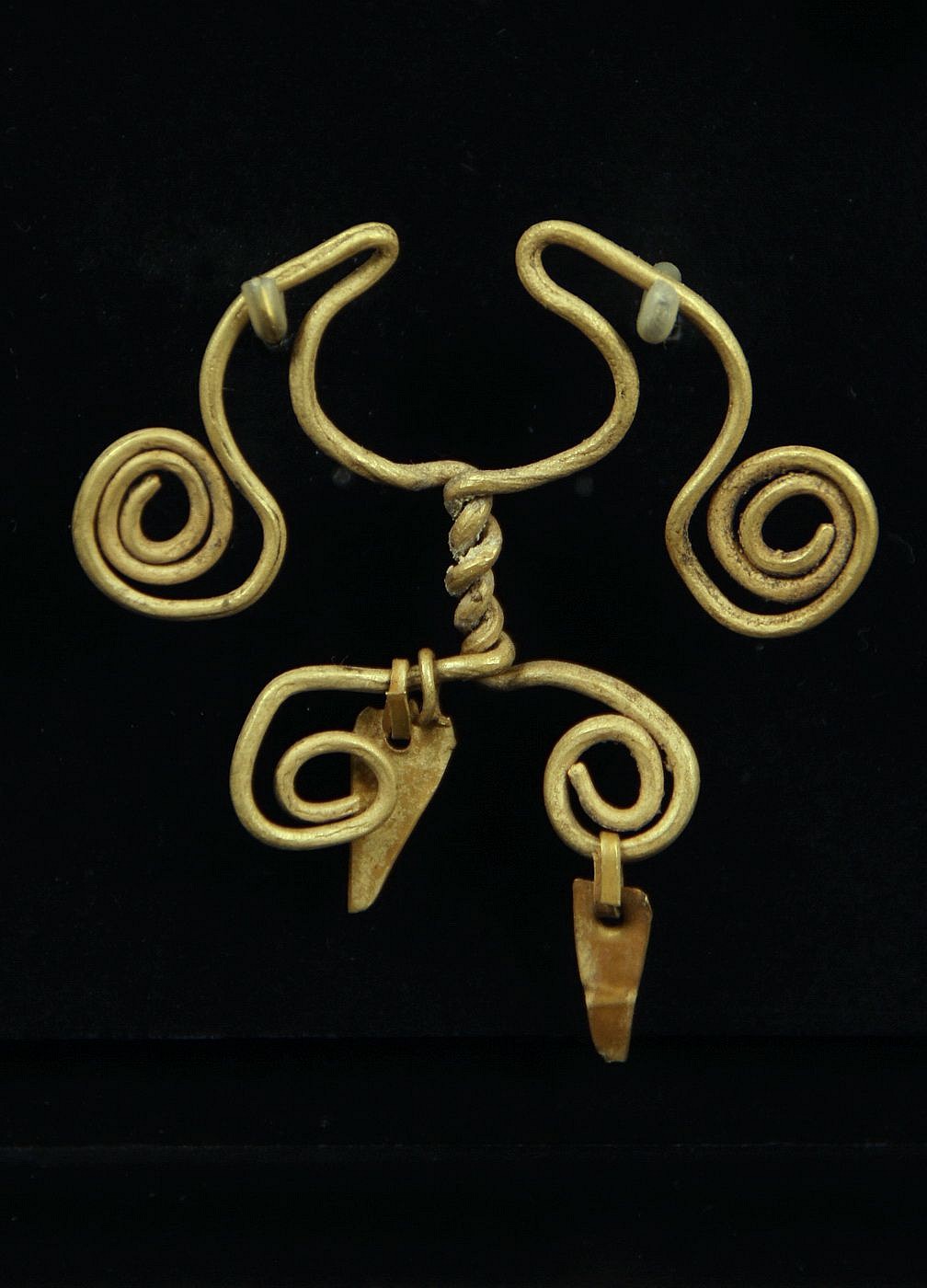
Peru, Chavin Gold Spiral Nose Ring with Two Twisted Wires and Two Dangles
This wire nose ring was made of one hammered sheet of gold, folded on itself, and cut. The ornament was hammered and coiled with the original suspended dangles.
Period: Peru, Chavin, North Coast, c. 1500 - 400 BC
Media: Metal
Dimensions: Height:1 1/4" Weight: 4.8 grams
$2,100
94222
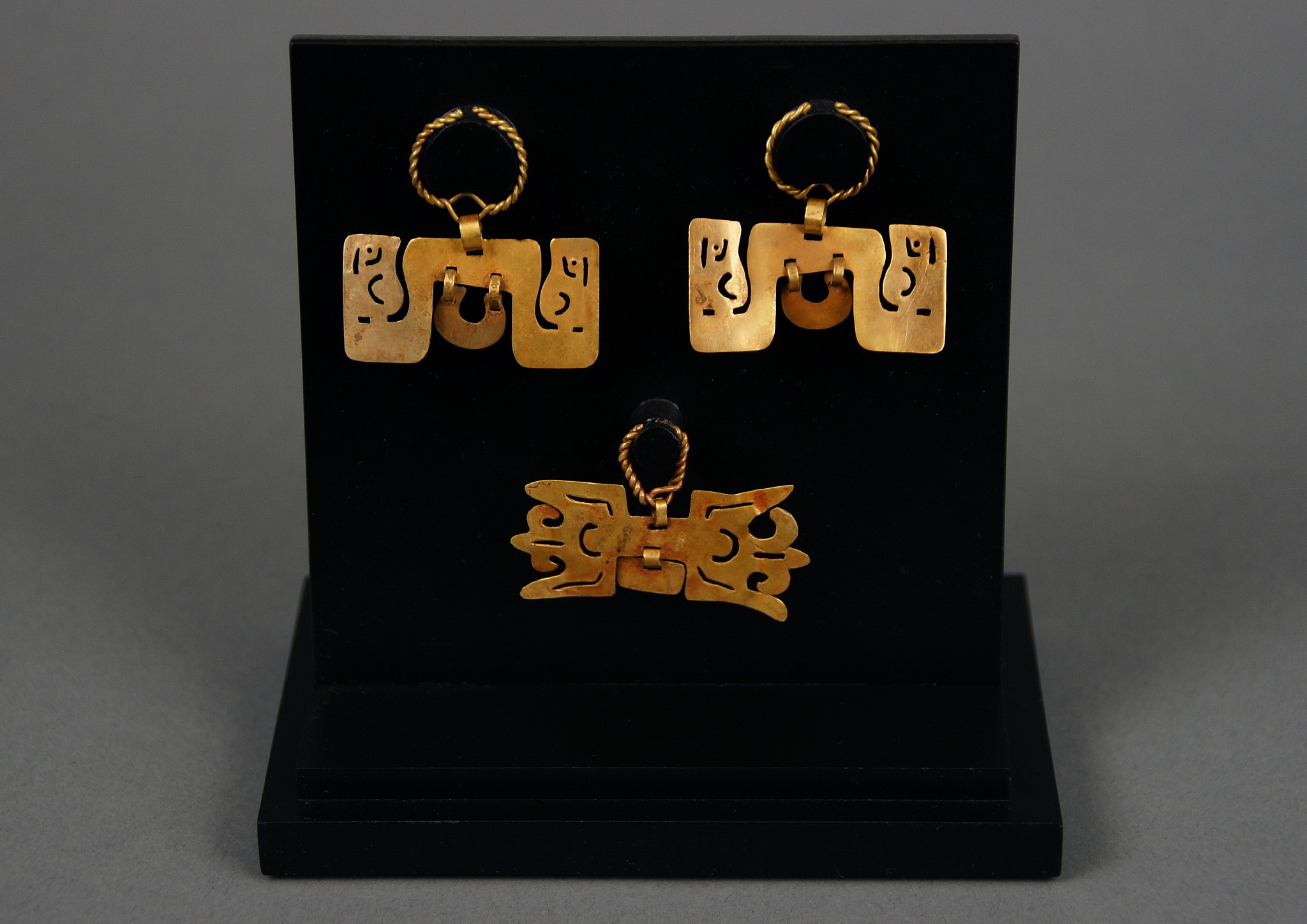




Peru, Chavin Pair of Gold Ear Ornaments and a Gold Nose Ornament with double chevron
The pair of gold ornaments, each with a double headed serpent with cut-out facial details, suspended by a twisted wire loop, and a suspension plaque dangleA gold nose ornament with cutout design and a central suspension plaque. The single nose ornament has a cut-out design sign in an abstract avian face or that of opposing chevrons, suspended by a twisted gold wire loop. pl. 15.
Period: Peru circa 500-300AD
Media: Metal
Dimensions: Widths 1 1/2 inches each; Width 1 3/4 inches
Price Upon Request
94157
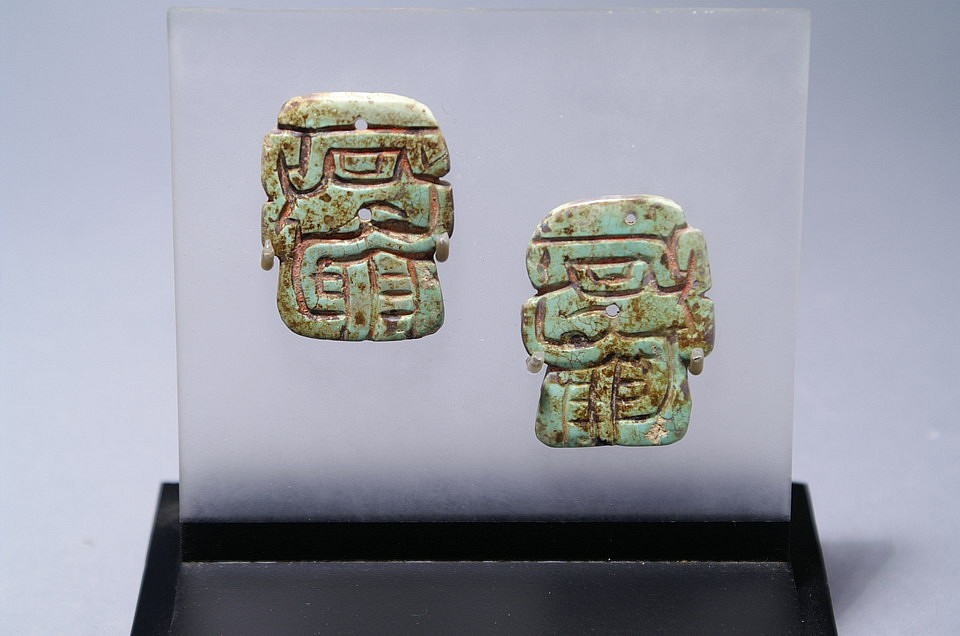
Peru, Chavin pair of Turquoise Plaques with Profile Faces
These faces could be trophy heads. There are two small drill holes center arranged vertically. It’s quite rare to find carved turquoise when most are made of shell. These may have been use as pendants to a textile. There is an abundance of manganese patina on the front.
Period: Peru, Chavin, Middle Phase, c. 1000 - 700 BC
Media: Stone
Dimensions: Height: 1 1/2" x Width 1 3/4"
$2,900
98046
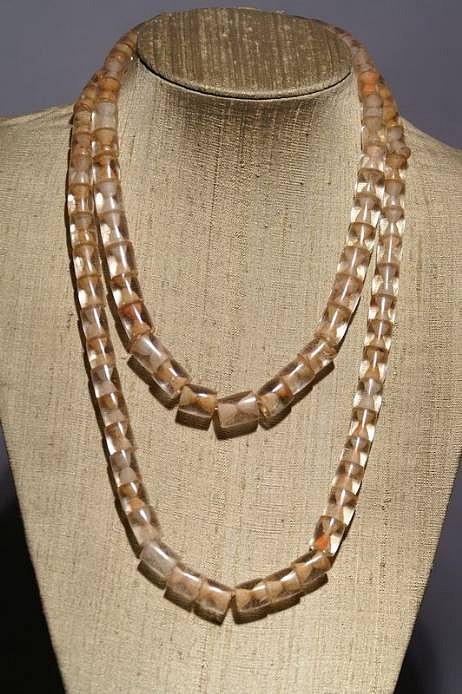




Peru, Chavin Rock Quartz Crystal 24" Necklace
Bi-conically drilled rock quartz crystal necklace with traces of cinnabar. The beads are graduated in size from approximately 9.22 mm to 11.17 mm. They were purchased between 1975 and 1985.
Period: Peru, Chavin, North Coast, circa 400-500BC
Media: Stone
Dimensions: Length: 24" inches
Price Upon Request
94049
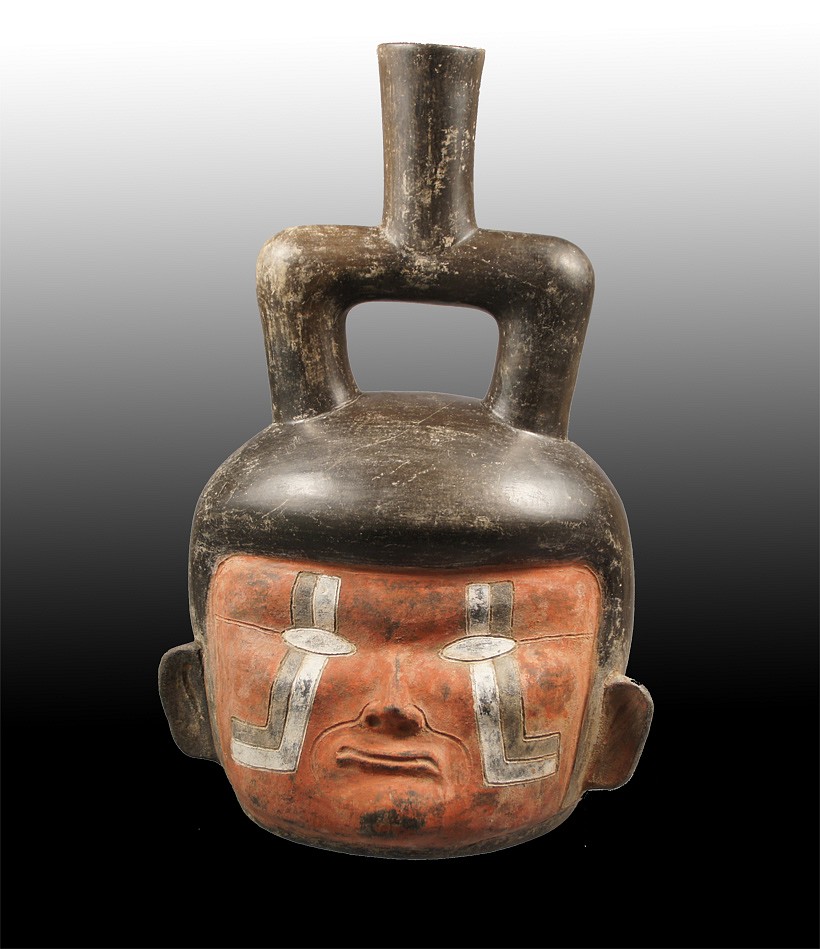
Peru, Chavin Stirrup Spout Portrait Vessel with Red Face and White Tears
There are few published, authenticated, Chavin ceramic portrait heads and this is the only known one of its kind with post -fire red and white pigment. The face has an unusually sensitive expression and delicately incised black and white tears that radiate outwards. There is a similar Chavin portrait vessel in the Linden Museum- Stuttgardt. Another Chavin portrait in the Larco collection and illustrated in THE SPIRIT OF ANCIENT PERU (pg.81) also has similar facial features: small ears, slanted eyes, small nose and thin lips - but in addition also has wrinkles. Author Richard Burger identifies this portrait as an elderly person. It is possible that the red-faced portrait is also a depiction of the same person that the Cupisnique people may have revered.
Period: Peru, Chavïn, Cupisnique, Late Phase, North Coast, circa 700-400BC
Media: Ceramic
Dimensions: Height 12 3/8" x Width 8"
Price Upon Request
n2108
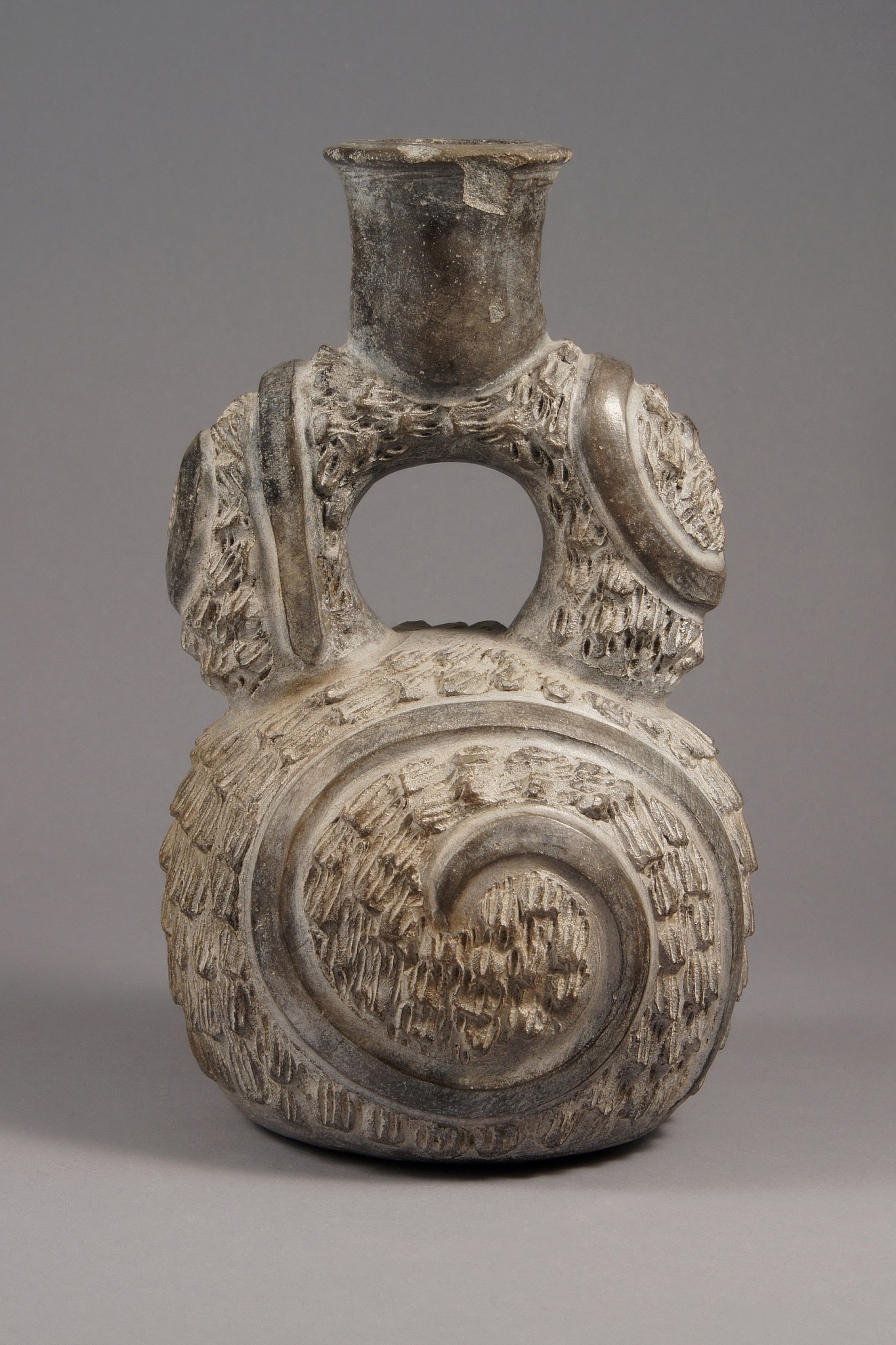






Peru, Chavin Stirrup Spout Vessel
This is an early and characteristic vessel from Cupisnique in the north coast of Peru, including the spiral design and comb texturing. A similar one is illustated in Donnan, "Ceramics of Ancient Peru" (1992: 29).
Period: Peru, Chavin, Cupisnique - North Coast of Peru, 1400-500 BC
Media: Ceramic
Dimensions: Height 9"
Price Upon Request
M5044
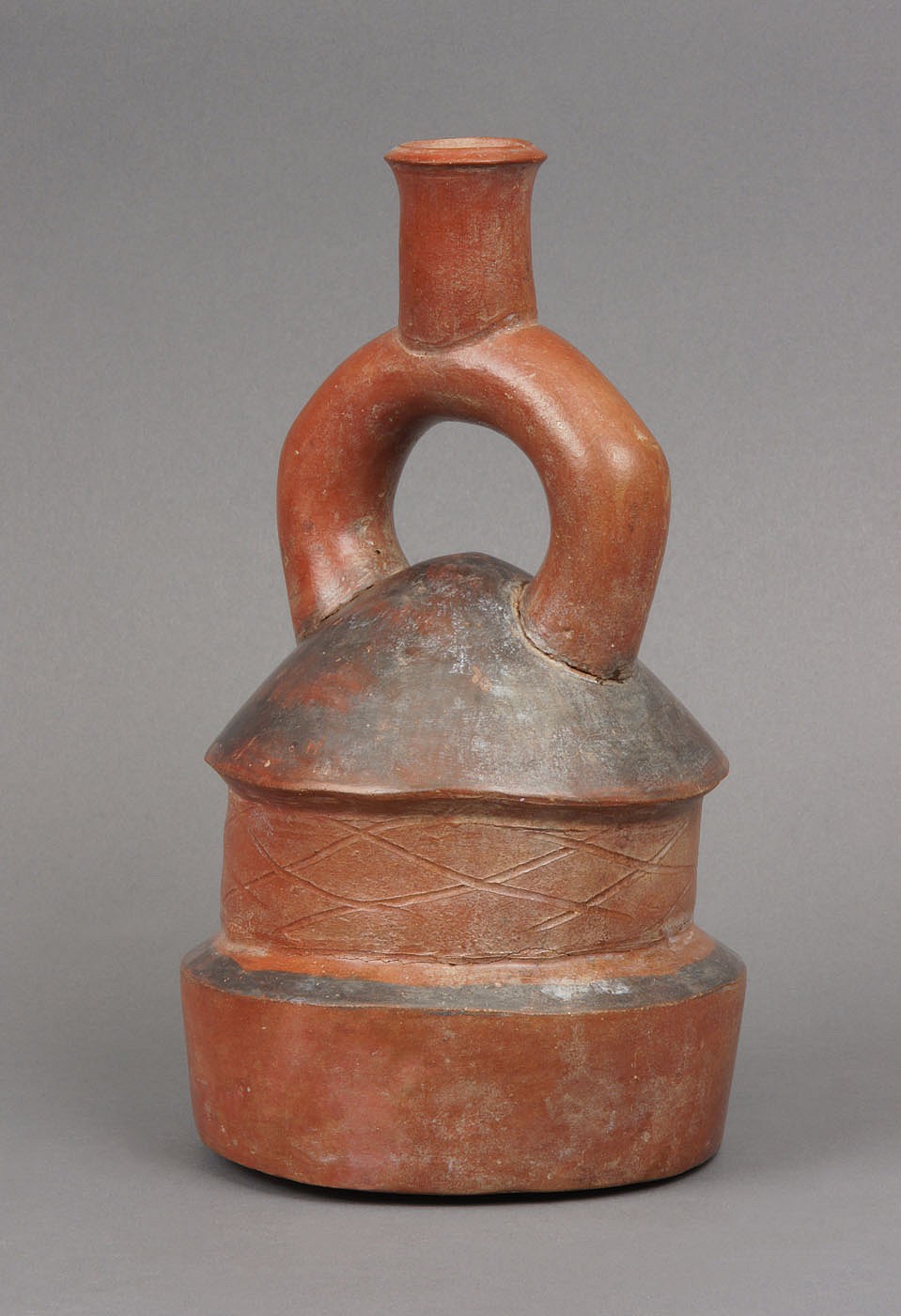
Peru, Chavin Stirrup Spout Vessel in the Form of a House
An unusual architectural motif of a round house which could have been a temple or ceremonial center. Round stone burial towers are found in the early Tiwanaku culture. This may have been what they were seeing and influenced their designs in Boliva.
Period: Chavin, North Coast Peru, c. 700-400 B.C.
Media: Ceramic
Dimensions: H. 9 in.
$7,500
92082
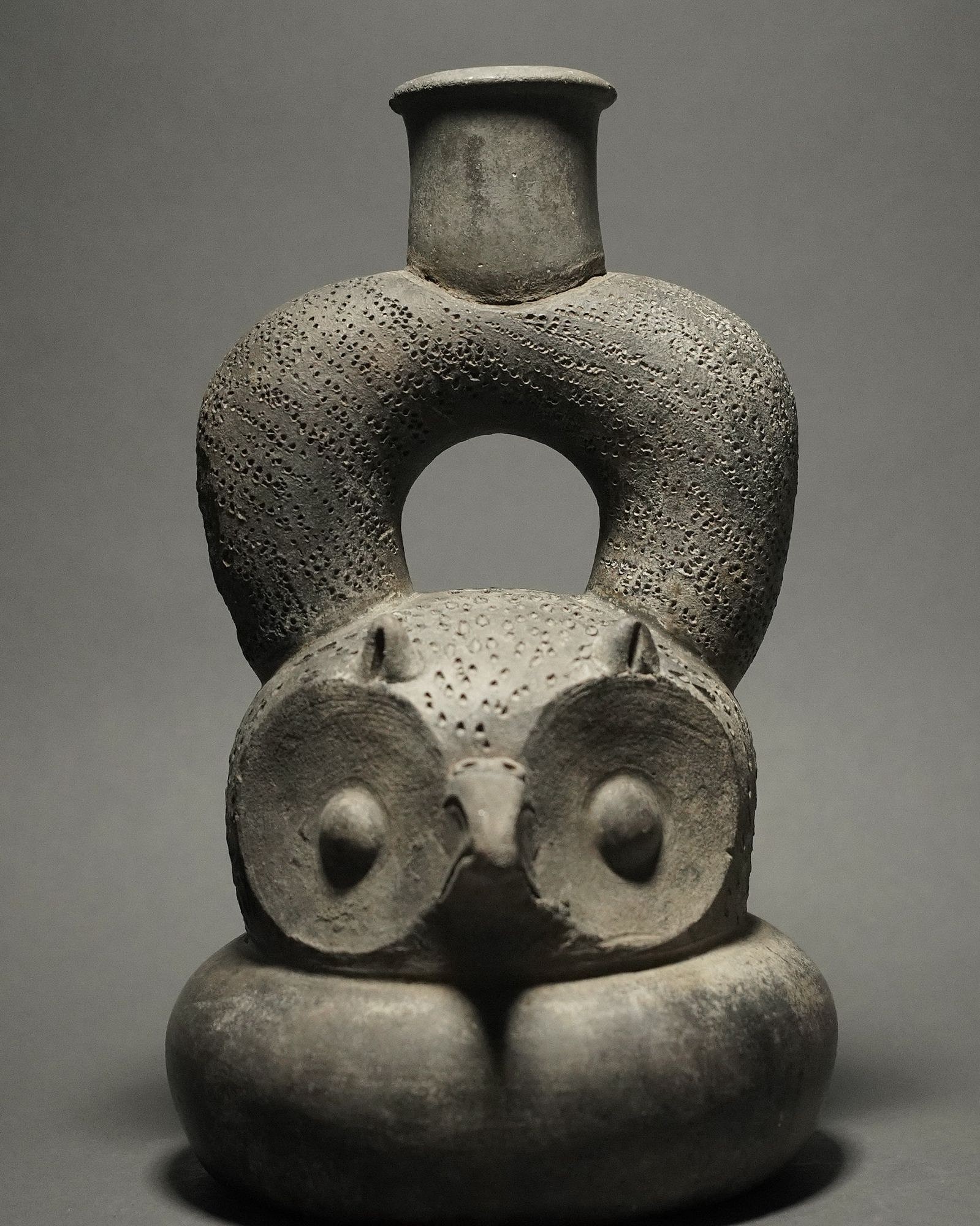




Peru, Chavin Stirrup Spout Vessel in the Form of an Owl's Head
Owls were revered by Peruvians because of their 180-degree vision, silent flight, and strong claws. Owls were often seen as magical and it was believed that they could transform into shamans. A similar vessel is illustrated in CERAMICS OF ANCIENT PERU by Christopher Donnan in plate 33 on page 28. Ex-collection Dr. Edmund Bourke, Yonkers, NY, prior to 1980s.
Period: Peru, Chavin, Cupisnique, Late Phase, North Coast, c.900 - 200BC
Media: Ceramic
Dimensions: Height: 91/2" x Diameter at base: 5 1/2"
$6,750
p2015
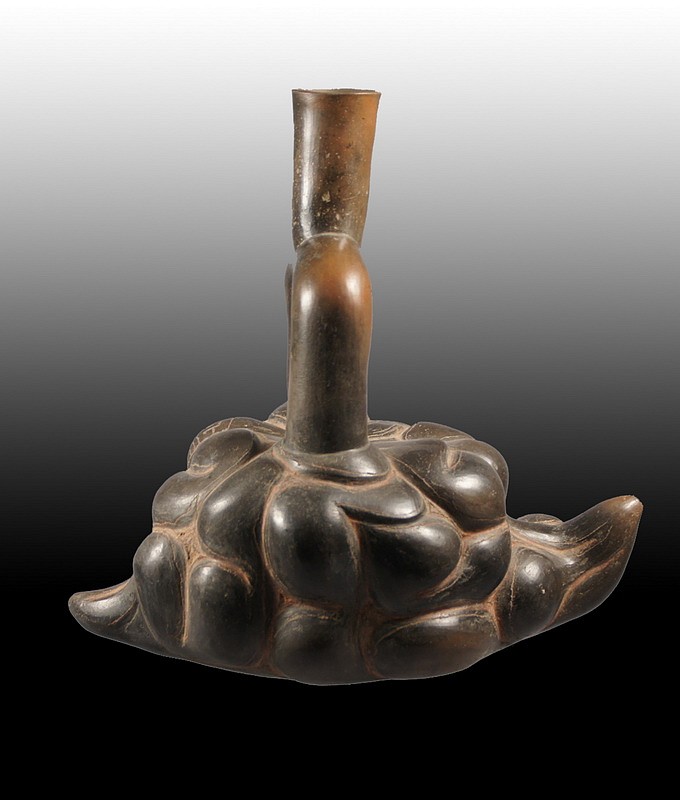
Peru, Chavin Stirrup Spout Vessel in the form of the Pijuayo Fruit
This Chavin Stirrup Spout Vessel has been shaped to mimic a ripe branch of Pijuayo (Peach Palm) fruits. Each individual fruit is red and semi-circular. It was mainly eaten after boiling in salt water for two hours, and has the taste and texture of a chestnut. Ancient Peruvians placed high value on the fruits and vegetables that surrounded them. To express this admiration of the transcendence that the plants in their daily life had, they often made works of art in tribute to them and the gods that made them. Similar fruit inspired vessels to this one are found in "Plantas Alimenticias en el Antiguo Peru" from pages 145 - 160; 1985. The peach palm was especially revered for its hard wood, which was used to carve spears. (The Ethnobotany of Pre-Columbian Peru pg. 28,1961).
Period: Peru, Chavïn, Cupisnique, Late Phase, North Coast, circa 700-400BC
Media: Ceramic
Dimensions: Length: 10" Height: 9"
Price Upon Request
n2096
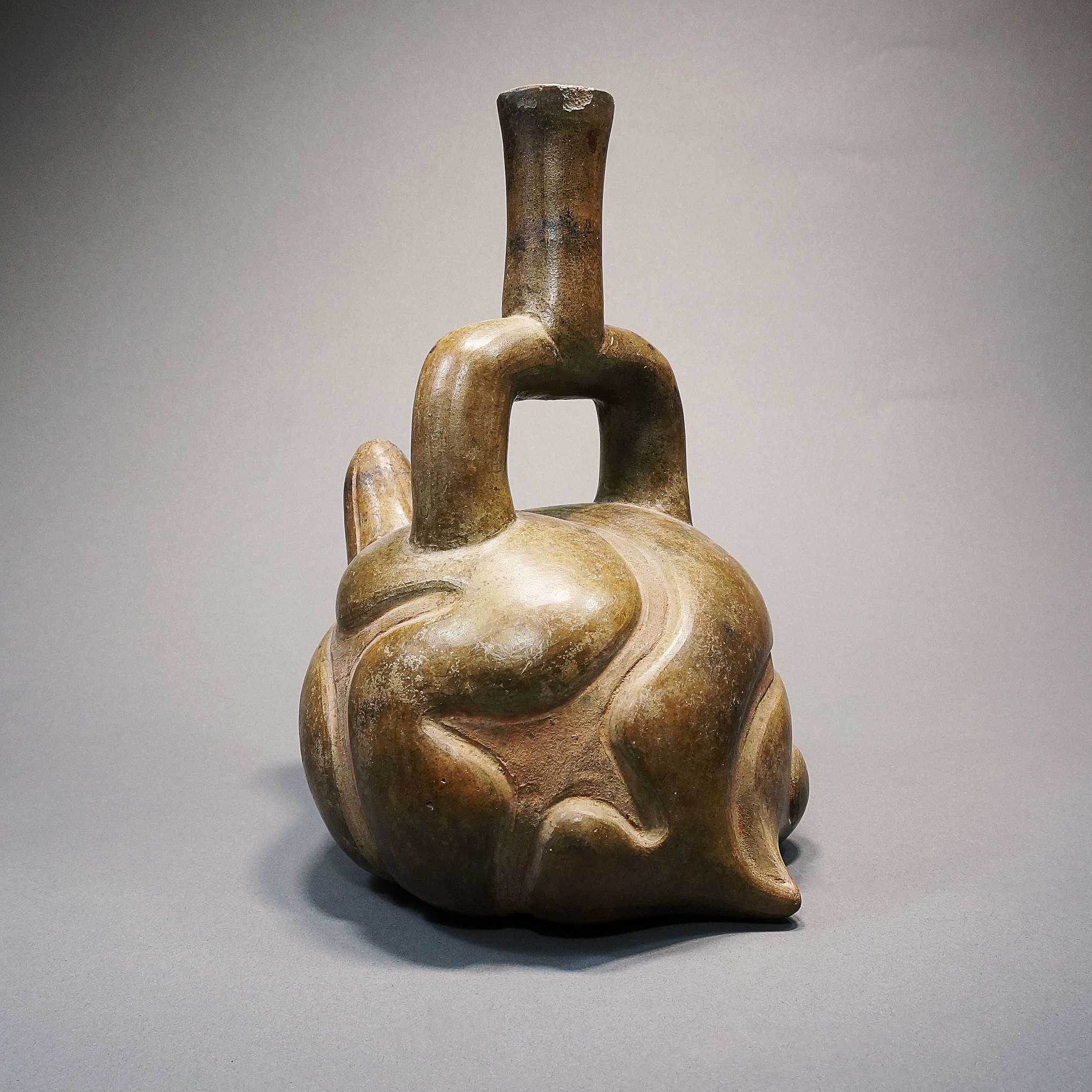
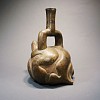
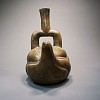
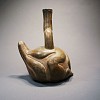
Peru, Chavin Tembladera Style Stirrup Spout Brownware Vessel in the form of an Abstract Animal
Period: Peru, Chavïn, Cupisnique, Middle Phase, North Coast, circa 1200-800BC
Media: Ceramic
Dimensions: Height 9 1/4"
$8,500
n2056
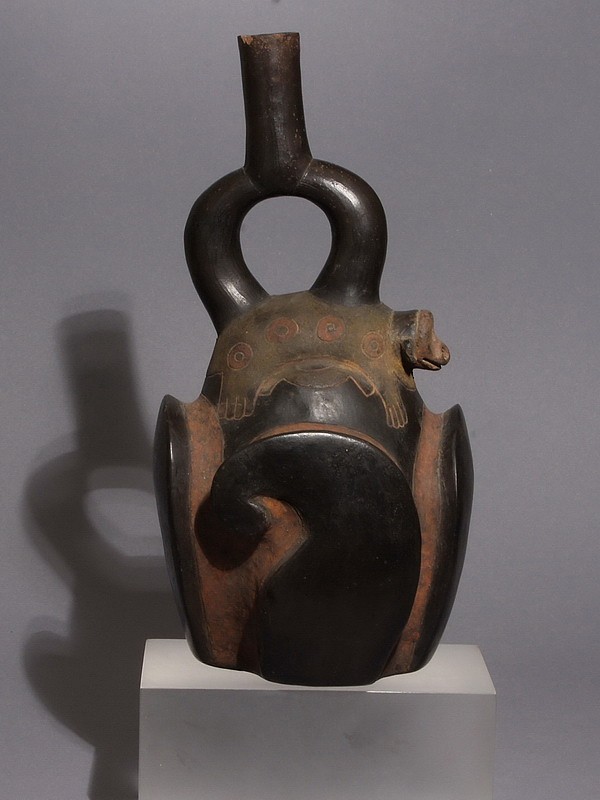
Peru, Chavin Tembladera Style Stirrup Spout Vessel Decorated with Sea Lion Deity
The animal appears to a splayed sea lion with flippers. The animal deity at the top is in a protective posture, as if birthing or protecting its young. All four sides are decorated with a wave-like element in high relief
Period: Peru, Chavïn, Cupisnique, Middle Phase, North Coast, circa 1200-800BC
Media: Ceramic
Dimensions: Height 9 1/4"
Price Upon Request
n2055
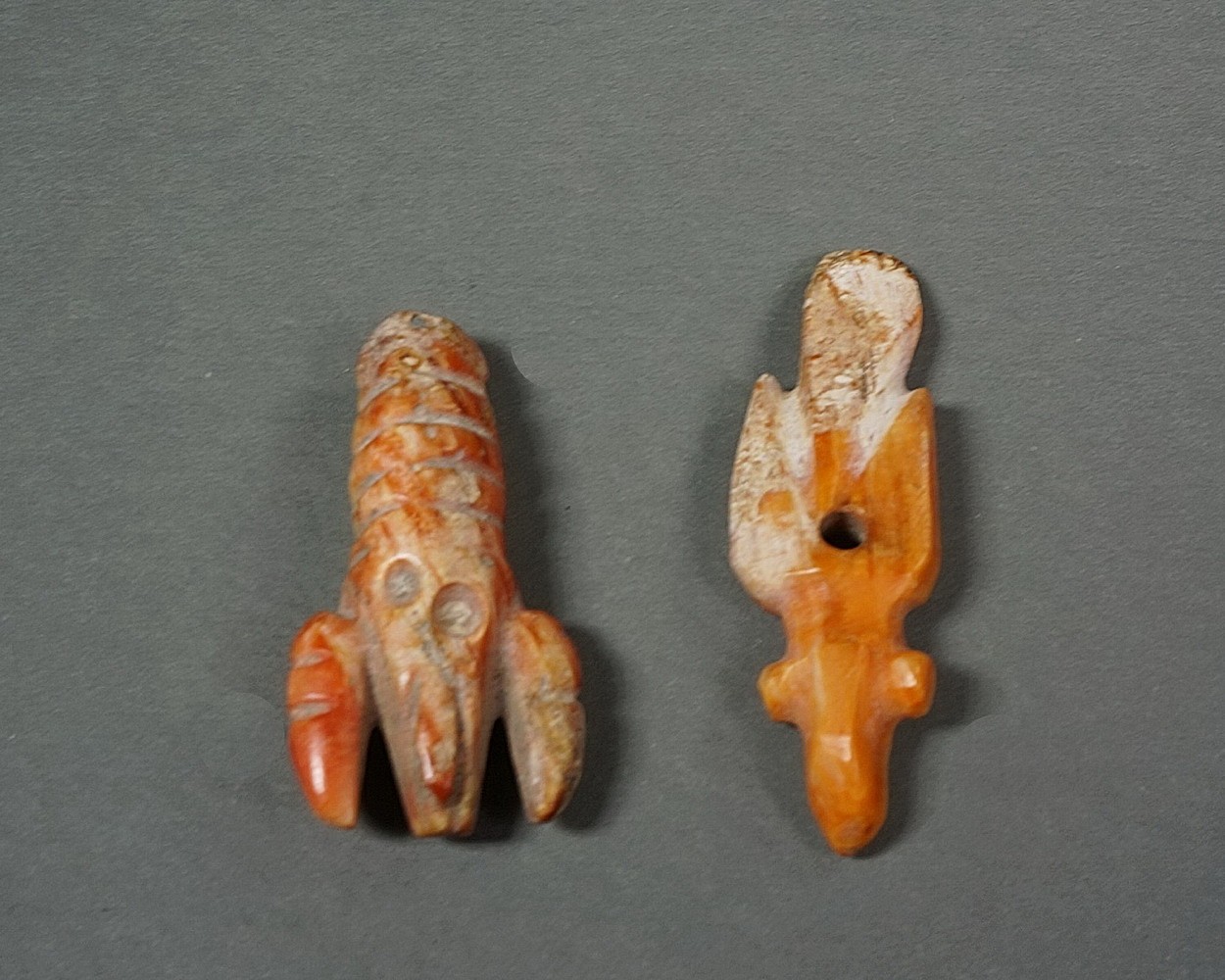




Peru, Chimu Carved Crayfish and Bird Pendants Carved from Spondylus Shells
The pendant on the left depicts a crayfish, while the one on the right represents a marine bird. Crayfish are found in the fresh water rivers along the Peruvian coast. Both pendants have suspension holes for attachment to a bracelet or necklace. Best seen from above, the bird has protruding eyes and a long tail. Both items are the types of Spondylus artifacts that are found on Peruvian North Coast Capa Pacha (child sacrifice ceremony). This is in discussed in PYRAMIDS OF TUCUME- The quest frof the Peru's Forgotten City by Thor Hyerdahl and Daniel Sandweisspg,106-112
Period: Peru, Late Chimu, North Coast, c. AD 1100-1530
Media: Shell
Dimensions: Crayfish Length: 1 3/8"
Bird Length: 1 1/2"
$1,250
N7002
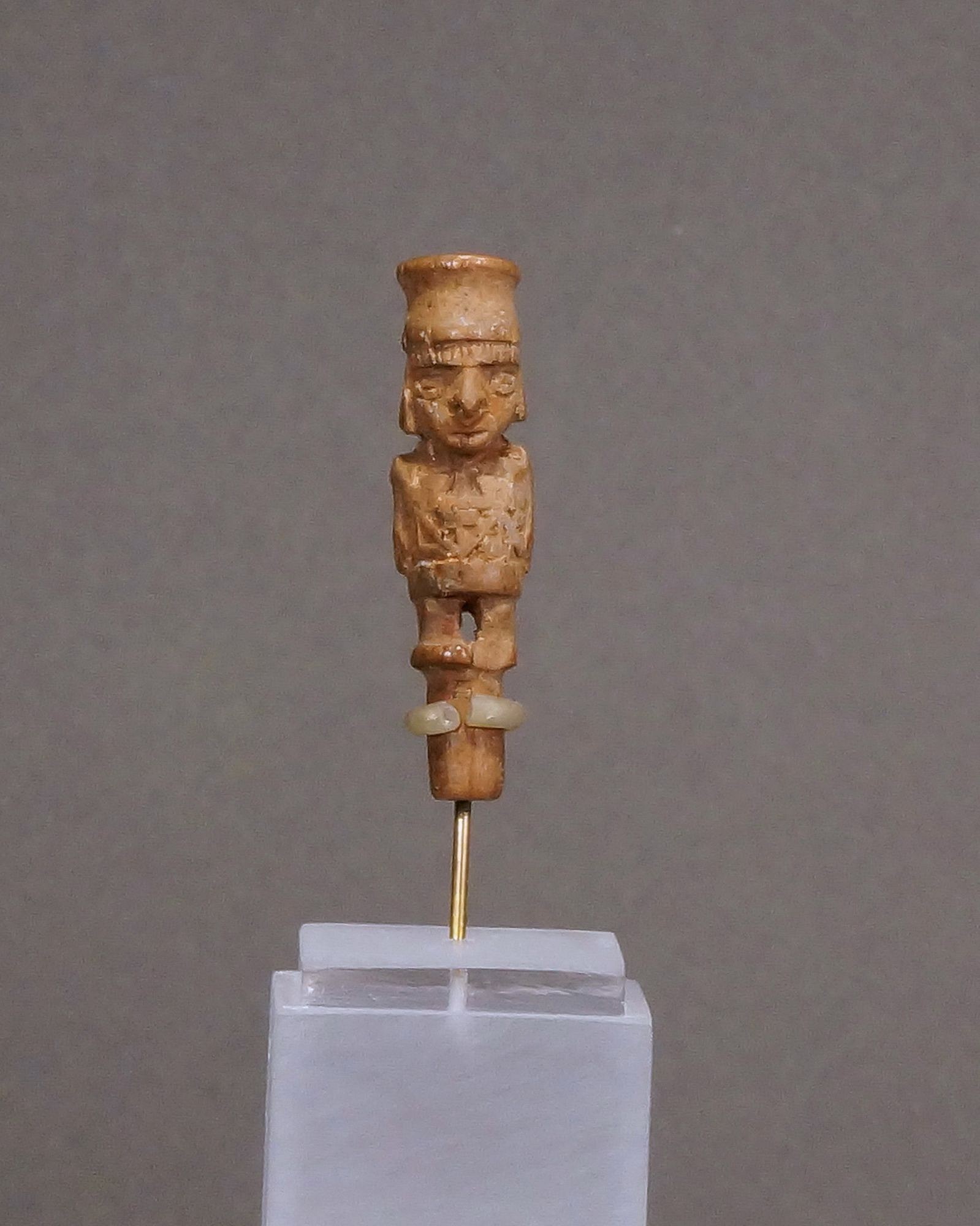
Peru, Chimu Carved Miniature Bone Standing Figure for a Top to a Container
This figurine wears a tunic and a hat showing his bangs. The facial features are well sculptured with the septum pierced for a nose ornament. He is wearing a tunic which once had triangular inlays with hand. The figure stands on top of a post suggesting that it was originally used as a top to a lime container. The figure is delicately carved, with precise details all around.
Period: Peru, Chimu, North Coast, c. AD 900 - 1350
Media: Bone
Dimensions: Length" 1 1/2 ".
$950
92254
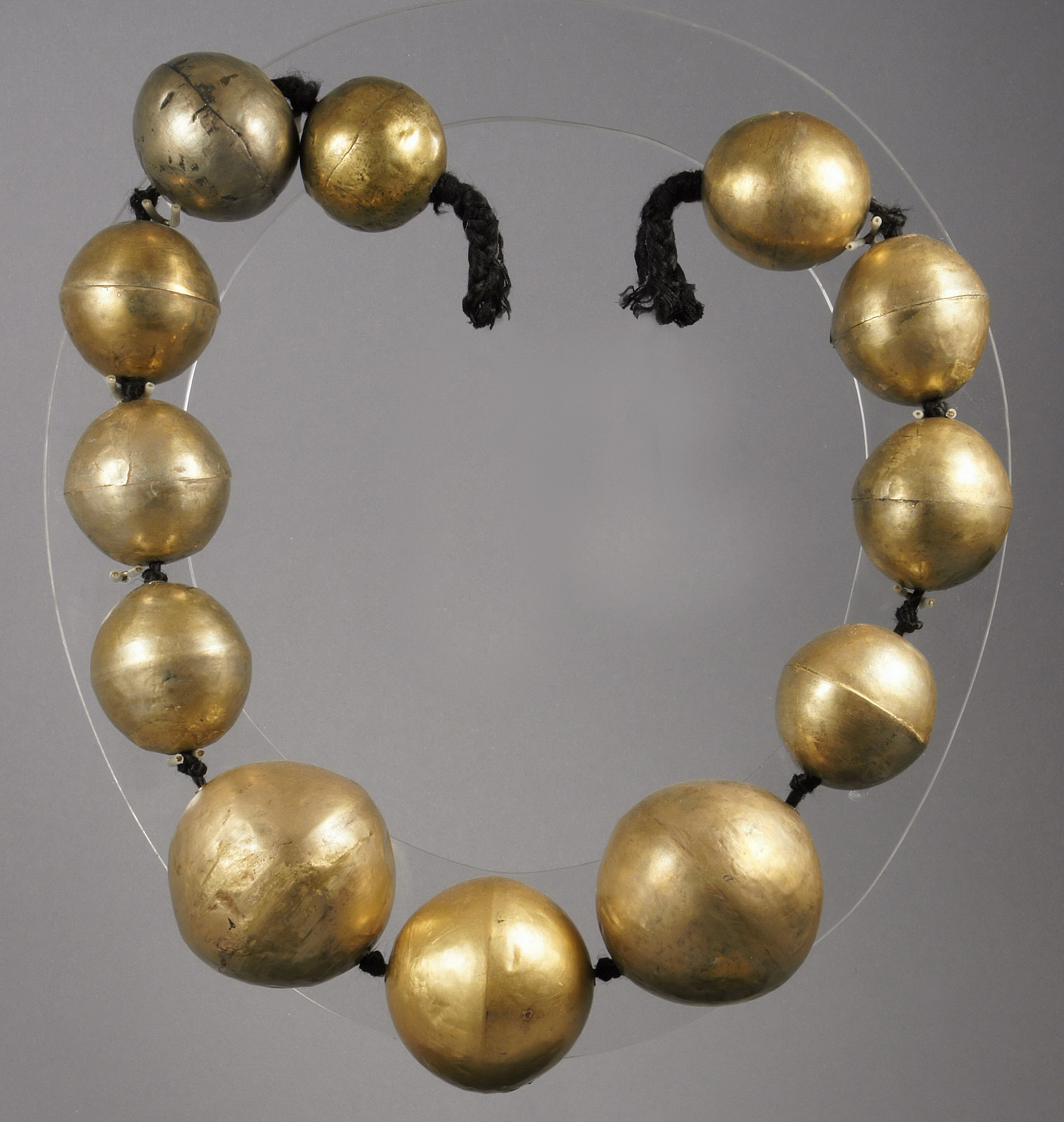

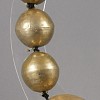
Peru, Chimú Gold 29" Necklace of Large Hollow Beads
The Chimú inherited a taste for hollow gold bead necklaces from their Moche predecessors. In both cultures, each bead was cast and hammered in two halves that were then joined together by soldering. In the Chimú technique, the edges of the two halves were nested together. These beads are extremely light with a greater percentage of silver than gold. They used depletion gilding to bring the gold to the surface by using of heats and salts. This allowed the Chimu to make the gold available for a large and growing ruling class. Private Florida collection prior to 1980.
Period: Peru, Chimu, North Coast, c. AD 900 - 1350
Media: Metal
Dimensions: Necklace Length: 29"; largest bead 2 1/4" diameter - smallest 1 1/2"
$27,000
M7991



Peru, Chimu Gold Cuff with Three Bands of 4 Repousse Stars Each
This gold cuff would have been worn as an adornment by a high-status male warrior. It features three rows of repousse starts, with four stars in each row, and two tie holes. A cuff with a similar star design is illustrated in the catalog of the Gold Museum of Peru on page 127. Formerly in the collection of Camilla Deitz Bergeron, New York antiquaire, acquired prior to the 1980s.
Period: Peru, Chimu, Early Phase, North Coast, c. AD 900 - 1100
Media: Metal
Dimensions: Height 4 1/2" Weight: 65.5 grams.
$9,500
N2064
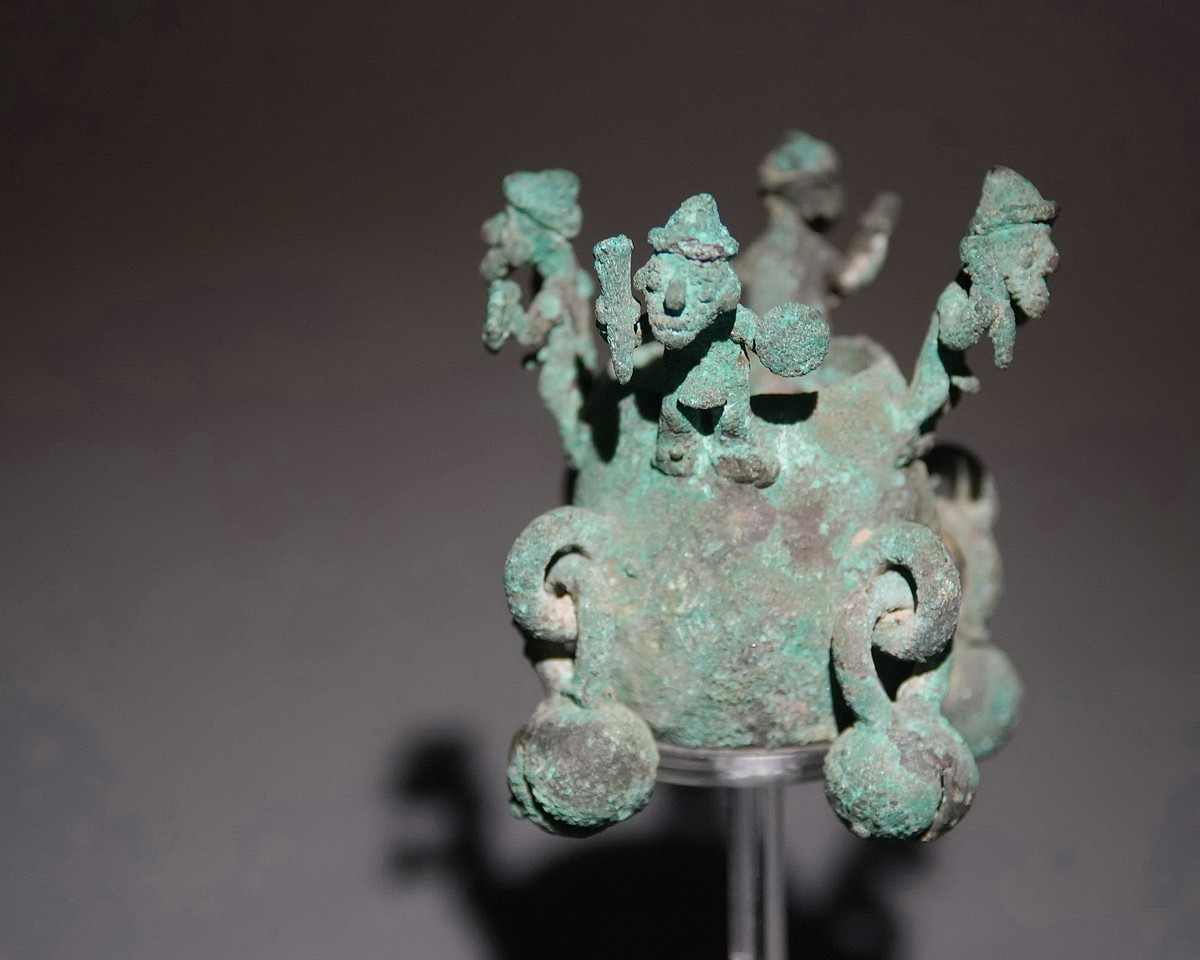




Peru, Chimu Lost Wax Cast Bronze Finial with Four Warriors
Metal objects that are cast with rings or bells that move to make a sound are known as idiophones. Each warrior wears a loincloth and holds a club in one hand and a shield in the other. Each of the loops around the shaft holds a bell, which when moved, clanks against the shaft.
Period: Peru, Chimu, North Coast, c. AD 900 - 1350
Media: Metal
Dimensions: Height: 2 3/4" x Width: 3:
$5,500
P1038
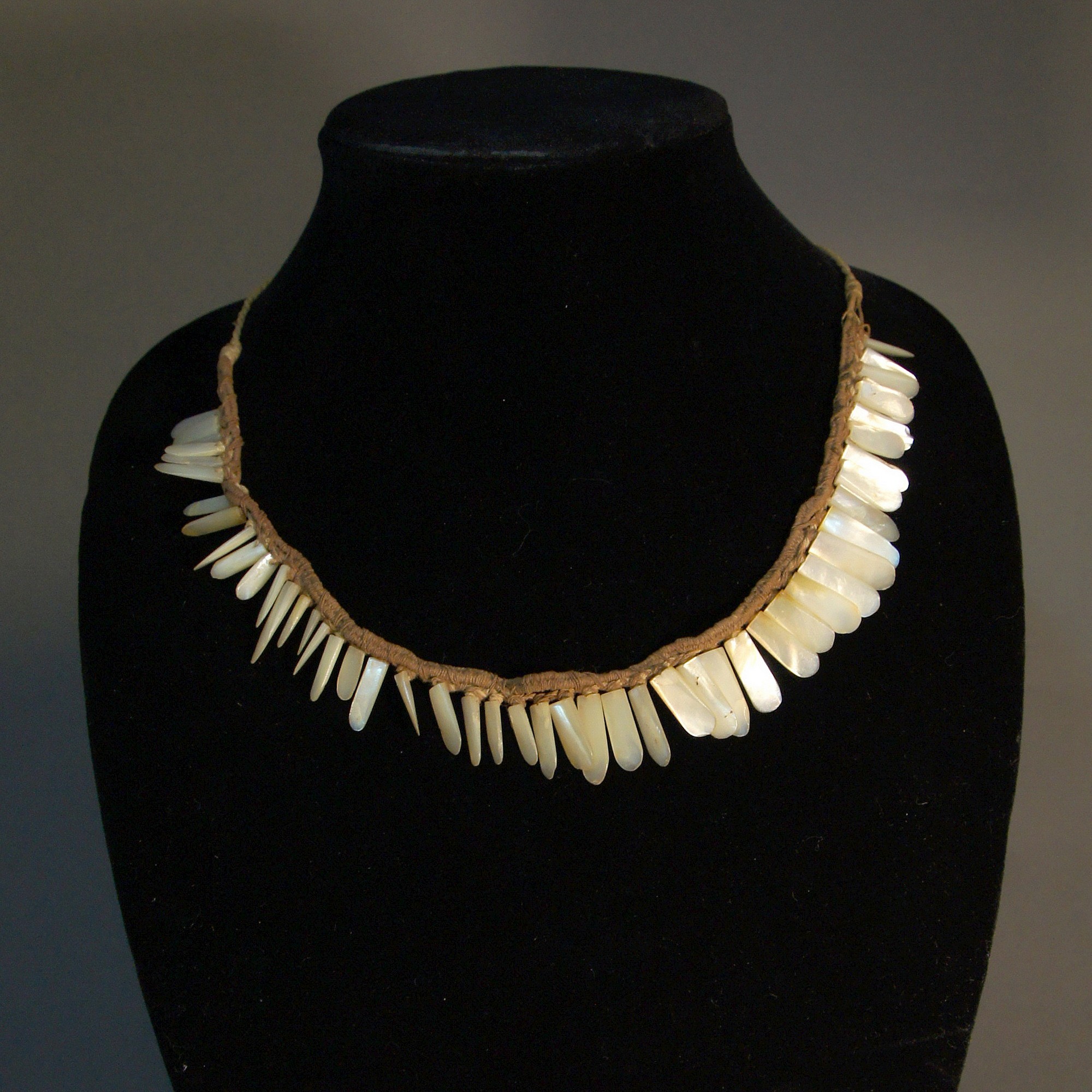
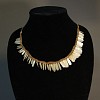




Peru, Chimú Necklace of Mother of Pearl on Original Cotton Line
There are 50 matched mother-of-pearl elements each with a single suspension hole starting at the top and exiting from the side and sewn on a continuous strand around a double cotton cord. Similar mother-of-pearl tab shaped beads are on a pectoral in the American Museum of Natural History and illustrated in THE INKA EMPIRE AND ITS ANDEAN ORIGINS by Craig Morris, pl 131.
$2,800
m7148
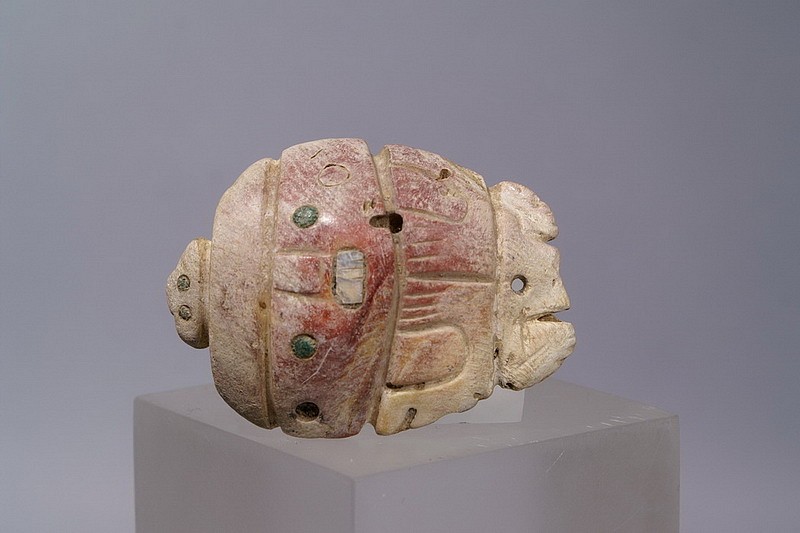


Peru, Chimu Shell Turtle Pendant
This turtle head and carapace have inlays of turquoise and mother of pearl. This is an unusually large shell, carved with double imagery. A human figure appears on the carapace when the pendant is vertical. When horizontal, the shell appears as a turtle, with a small head at the top, and tail and rear flippers at the bottom. From a Private New York collector prior to 1980's. Published in Ocean Fishing in Pre-Columbian Chile and Peru, plate 60.
Period: Peru, Chimu, North Coast, circa AD900-1350
Media: Shell
Dimensions: Height: 3" inches
Condition: As found with original inlays.
$2,900
M8027
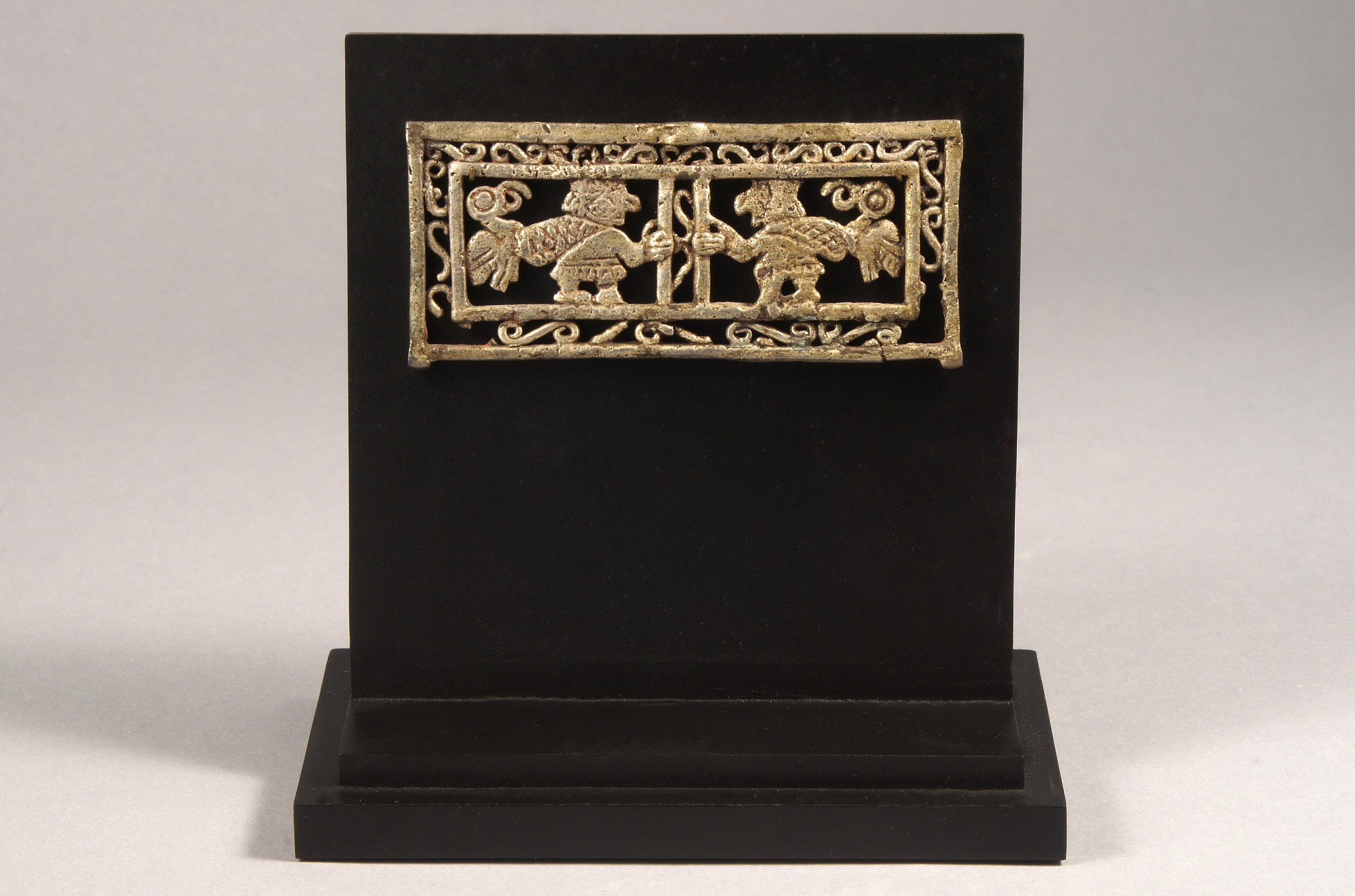




Peru, Chimu silver balance with 2 warriors
A rare Chimu silver balance beam decorated with two bag carrying individuals followed by a perched bird. This depiction could explain how the balance beams were used by exchanging feathers of different birds of equal weight. Trade across long distances of exotic materials was a key element in the ancient economy. The balance beam is made of both cast and soldered elements. It is true soldered filigree work of curls decorating the edge. The individuals and birds were cast. It is also extremely rare to find balance beams in silver, as most of them are of wood or bone. There is a single suspension hole in the top bar center and one hole for a net on each side of the lower bar.
Period: Peru, Chimu, North Coast, circa 900 - 1350 AD
Media: Metal
Dimensions: H: 2" W:3.5"
$4,500
98361
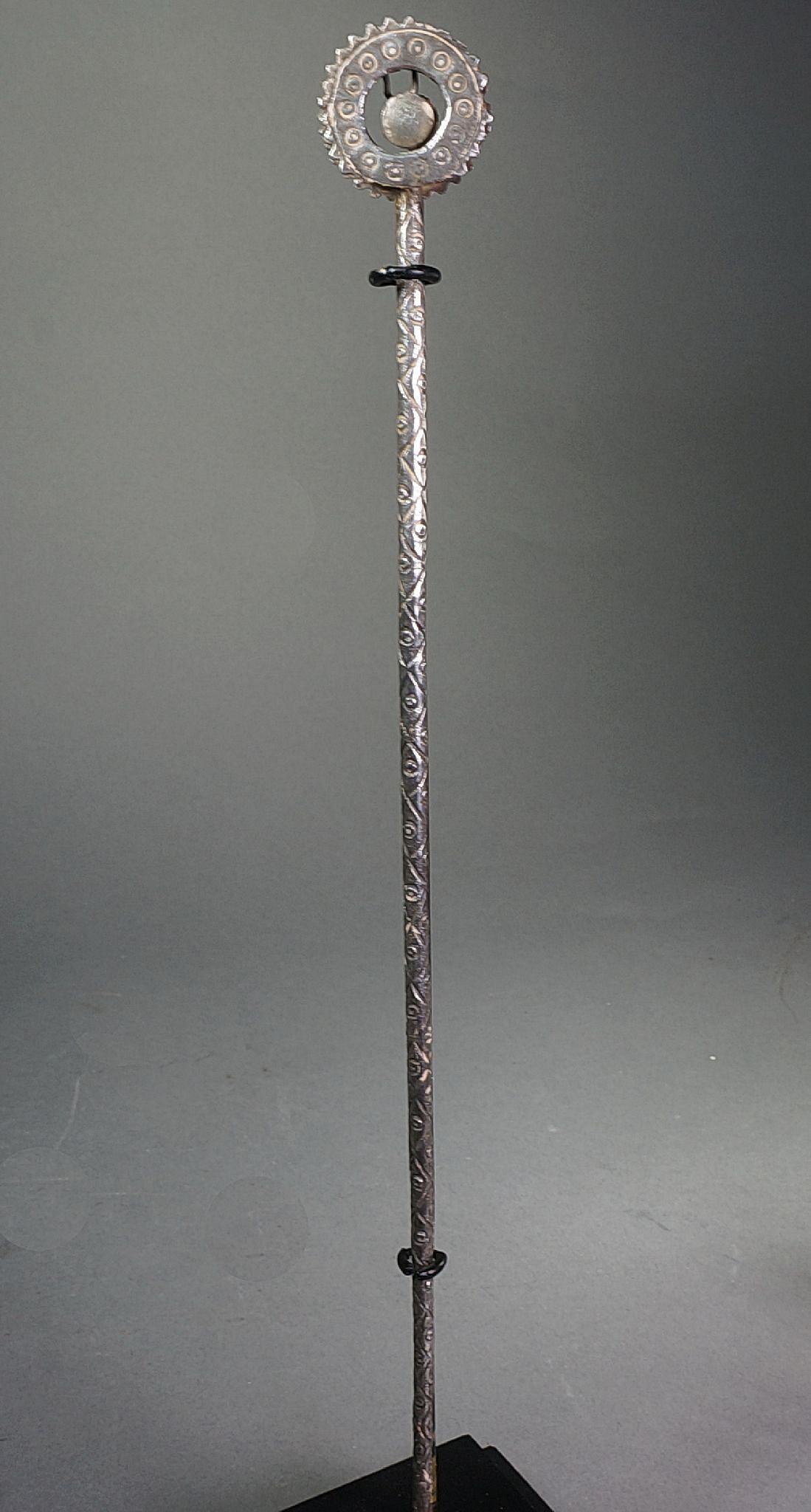




Peru, Chimu Silver Tupu with Ornate Rattle
Tupu pins were used by high status individuals to fasten their garments. The level of fine detail and craftsmanship indicates that this silver tupu would have belonged to an extremely important person. The shaft is completely incised with a repeating diamond motif. The rattle at the top is constructed with two incised discs, soldered to a curved band. Inside is a delicate suspended cylinder. This rare tupu is in good condition and has been professionally cleaned and stabilized.
Period: Peru, Chimu, North Coast, c. AD 900 - 1350
Media: Metal
Dimensions: Length:10" x Weight: 25 grams
$2,650
MM615
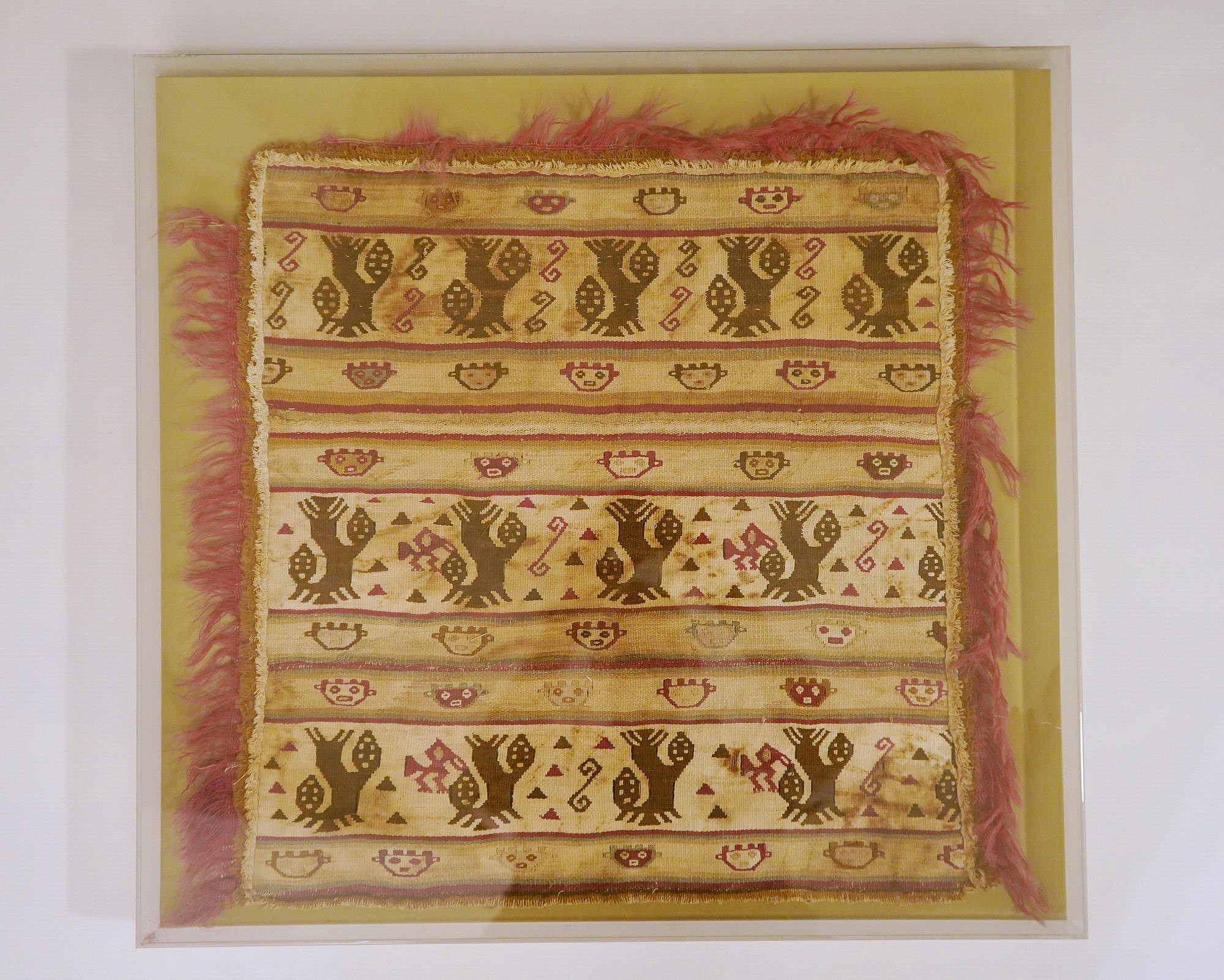


Peru, Chimu Tapestry Panel with 18 Cacti
The panel is arranged with three rows of cacti, probably the San Pedro cactus species. The San Pedro is also eaten as psychoactive fruit and is shaped like a star or flower when sliced. This panel illustrates three rows of plants, each with a bird eating the fruit. The rows of cacti are bordered by double rows of stylized crowned Chimu crowned.
This panel was cut from a larger weaving. The fringe is authentic, coming from the original weaving, but was re-attached. The panel is mounted in a Plexiglas box. The framer used an adhesive to attach the weaving to the ivory cotton ground; it should not be removed from the stretcher.
Formerly in a New York private collection prior to 1979.
Period: Peru, Chimu, Central Coast, c. AD 900 - 1350
Media: Textile
Dimensions: Height: 22" x Width: 23"
$3,250
n9042
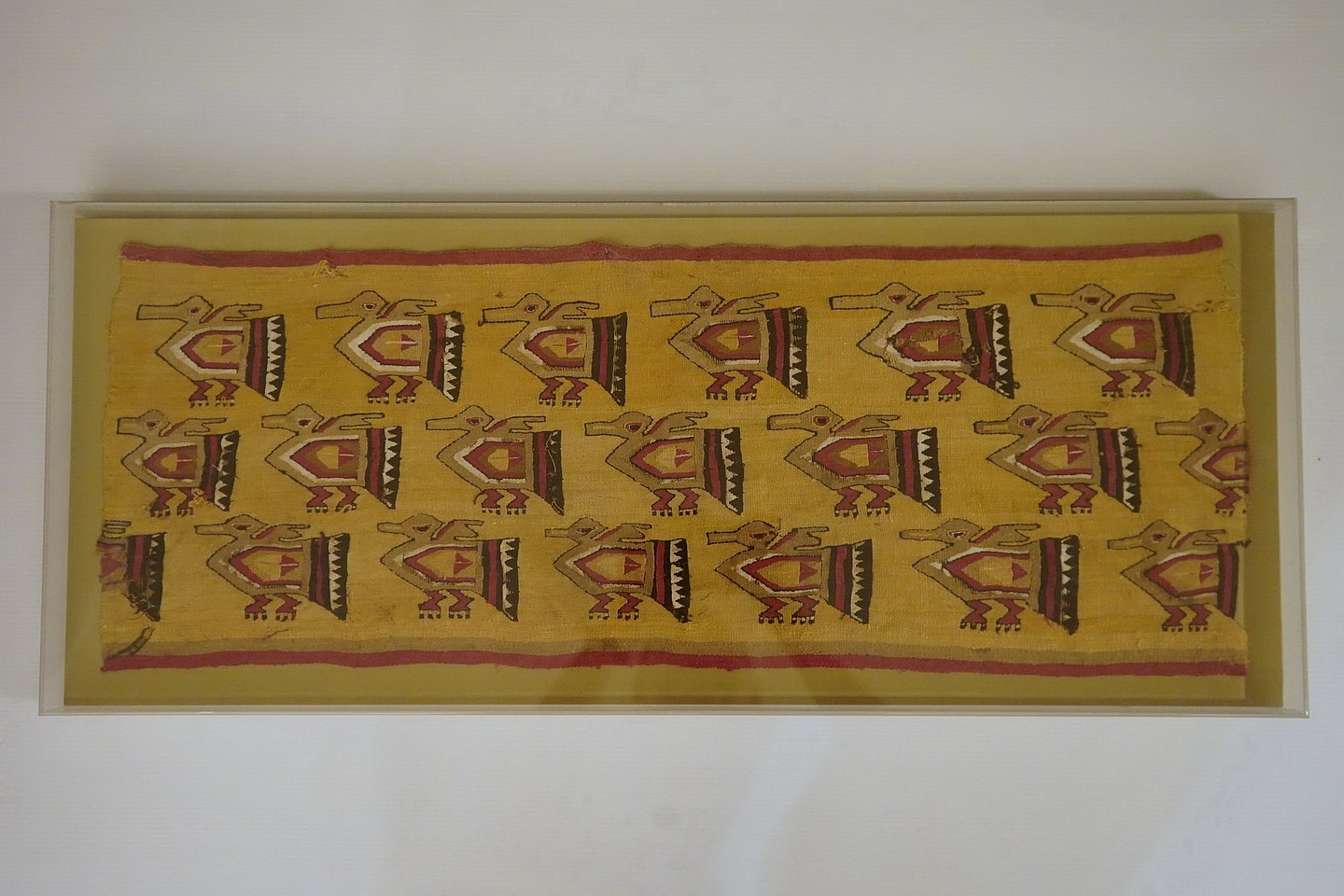


Peru, Chimu Tapestry Panel with 18 Ducks in Profile
This tapestry features 18 ducks in profile, and arranged in three rows, each oriented in the same direction. Each duck has one wing stylized in the shape of a single feather and the other behind its head. There is delicate detailing in the feet and tail feathers. The panel is mounted in a Plexiglas box. The framer used an adhesive to attach the weaving to the ivory cotton ground; it should not be removed from the stretcher.
Period: Peru, Chimu, North Coast, c. AD 900 - 1350
Media: Textile
Dimensions: Height: 13" x Width 31"
Price Upon Request
n9041
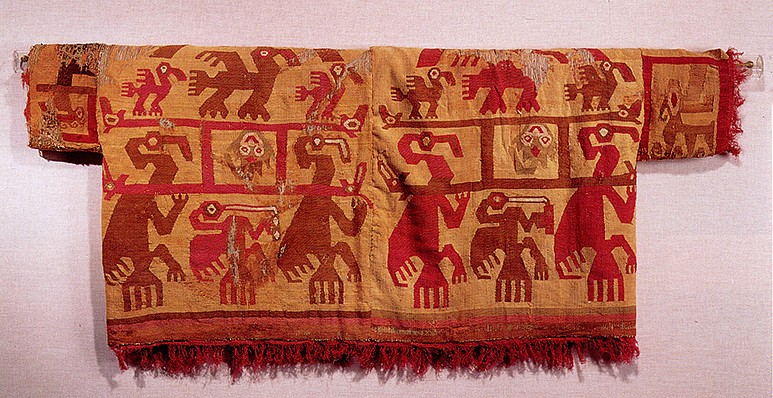




Peru, Chimu Tapestry Shirt with Pelican Narrative
This is a complete tapestry woven shirt with sleeves constructed of cotton warps and camelid wefts in red, brown, olive and white on an ochre ground. It depicts a mythical marine narrative with two pelicans carrying a litter bearing a trophy head in the form of a skate with a face. Litters were considered a prestigious mode of transportation on the North coast. The presence of this image within the narrative reinforces the importance of the individual who wore this shirt. There is a pelican with a crescent headdress on top of each litter. Each of the four panels displays the same scene in reverse colors. This shirt is illustrated in Rowe, Ann, "Costumes and Featherwork of the Lords of Chimor" published by The Textile Museum, 1984, fig 103. Formally in the collection of the Southwest Museum in California.
Period: Peru, Chimu, North Coast, c. AD 900 - 1350
Media: Textile
Dimensions: Width 47-1/2" x Length 19-1/2"
Price Upon Request
96127
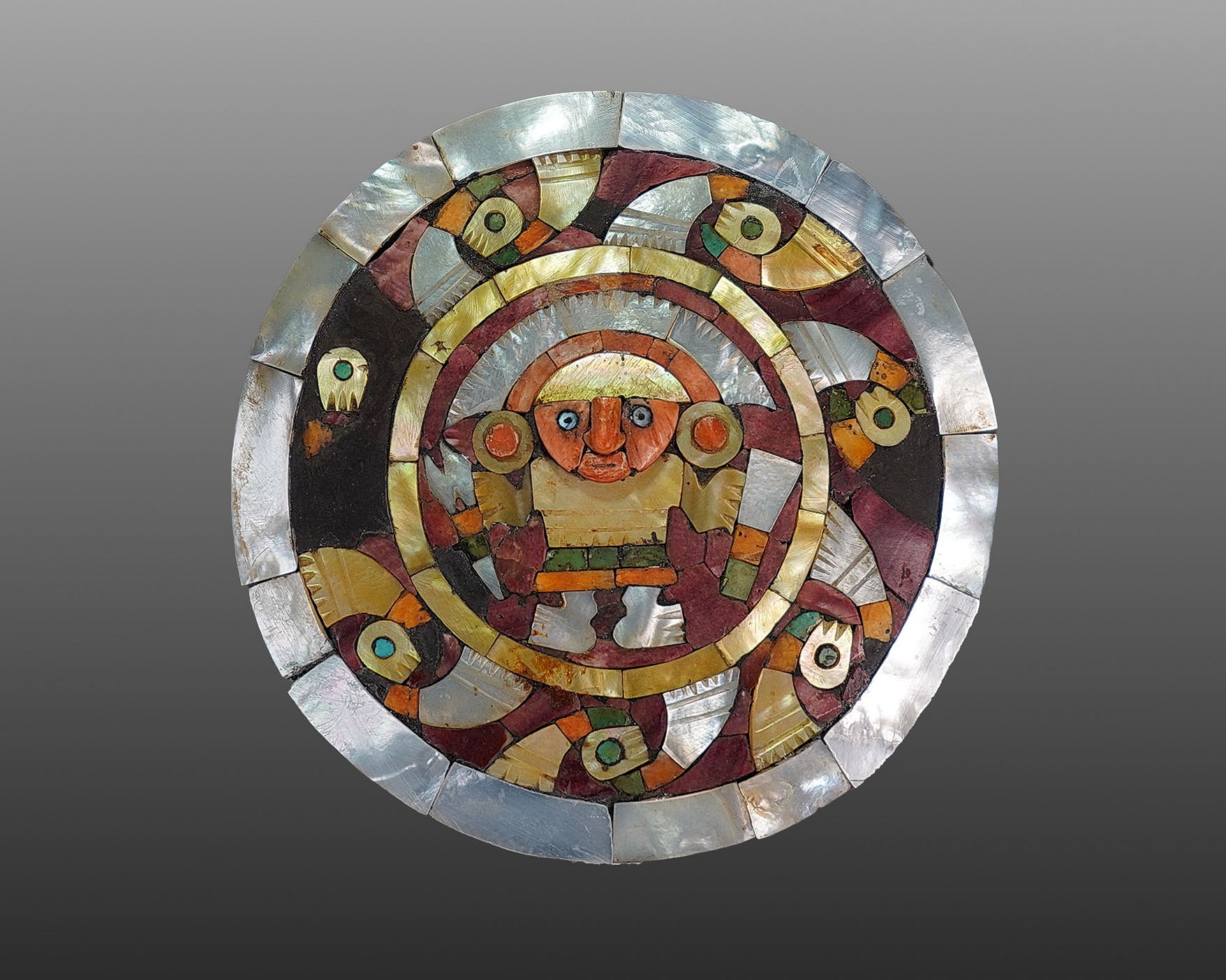



Peru, Chimú Wood Earspool with Inlaid Shell Deity
The Chimú were renowned for their sophisticated craftsmanship. This North coast Chimú earspool features a male ruler wearing an elaborate semi-circular headdress and holding a scepter in each hand, portraying power. The earspool is particularly large and decorated with cut inlays of varying shades of spondylus and mother-of- pearl shells. Highlights of turquoise and purple shells embellish the design. The mosaic is laid out of a thin layer of a dark resin material set on a circular wood back, which is attached to a tapering wood shaft. The outer edge of the mosaic is adorned with series of wave motifs, connecting representing the Chimú marine environment. The larger ear ornaments were worn by high-ranking personage. The more important the person, the larger the ear pool. This earspool likely belonged to a male nobleman with a high degree of power and authority. A very similar ear ornament is illustrated on the front cover of Alt-Peru: Auf den Spuren der Zivilisation (Old Peru: On the Trail of Civilization), published in 1986 by the Roemer Museum in Vienna.
Media: Shell
$15,000
p4200
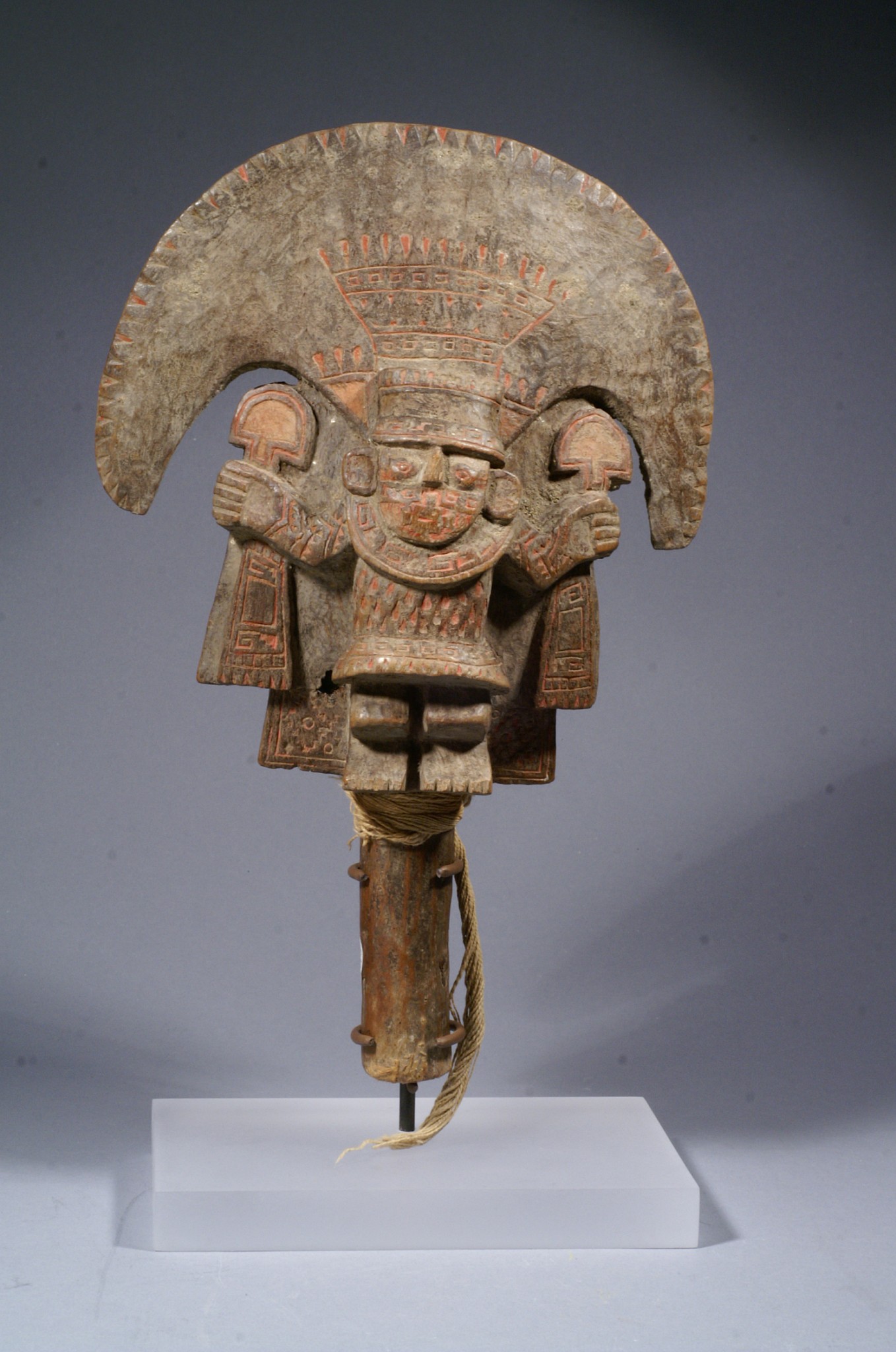



Peru, Chimu Wood Mirror Back depicting a lord
A large and well carved wood mirror back with a dignitary in full regaila wearing a nose ring and a large crescent shaped headdress. His face is also decorated with a tattoo. There is original cotton string bound to the handle. The pyrite mirror in the back is ancient but not original to the piece. A similar elaborate mirror back from the Chimu is illustrated in Alan Lapiner, "Pre-Columbian Art of South America" (1976: #625) That particular mirror was sold at Sotheby's auction May 19, 1993 for $30,000. My mirror was examined by Robert Sonin for authenticity May 25, 2006 Photo roll-out #3305 and #3306.
Period: Peru, Chimu, North Coast, circa AD900-1350
Media: Wood
Dimensions: Height 11"
Price Upon Request
98270
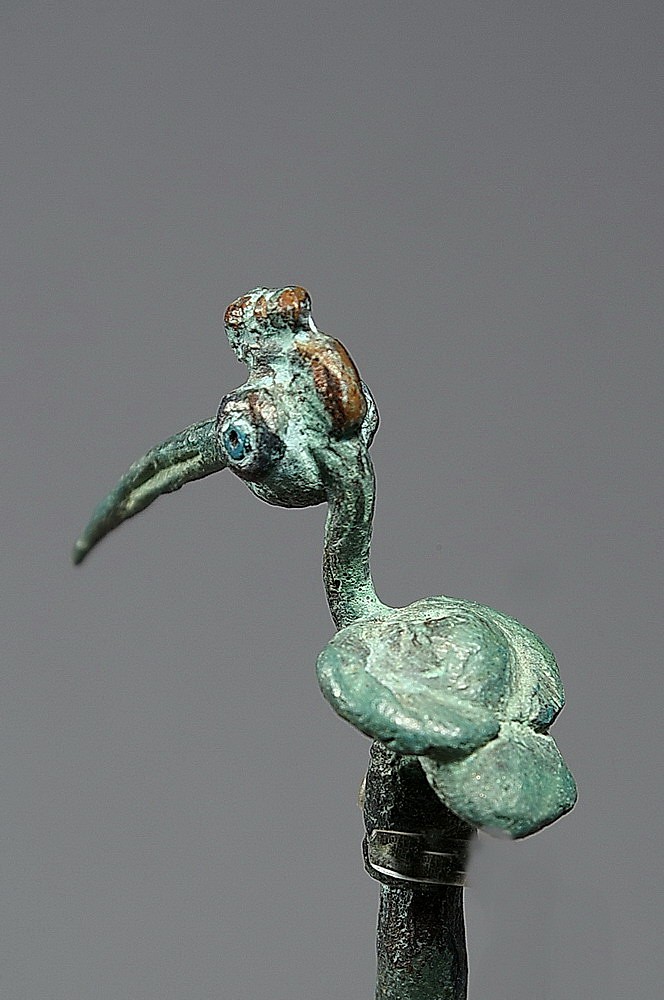



Peru, Chimu/Inca Copper Lime Spoon with Long-Billed Bird
An unusually large lime spoon decorated with a cast long-billed marine bird on top. The bird has turquoise beads for eyes. Lime spoons were used to extract powdered lime from containers for participants in coca rituals. The lime (powdered burned limestone or shell) was the catalyst that released the cocaine alkaloids from the coca leaves chewed during these ceremonies. Coca rituals were important to Andean cultures, but were restricted to elite, high-ranking lords. Birds represented souls flying to the otherworld to communicate with the supernatural. For similar examples, see Baessler (1906: pl. 13; Nordenskiold 1921: fig. 19, c; Carcedo de Mufarech 1985: fig. 89; and Schindler 2000: 202 and 203).
Period: Peru, Chimu, North Coast Peru, circa 1100-1350
Media: Metal
Dimensions: Height: 4 3/4"
Condition: Good. The tip of the spoon has been restored.
Price Upon Request
95102
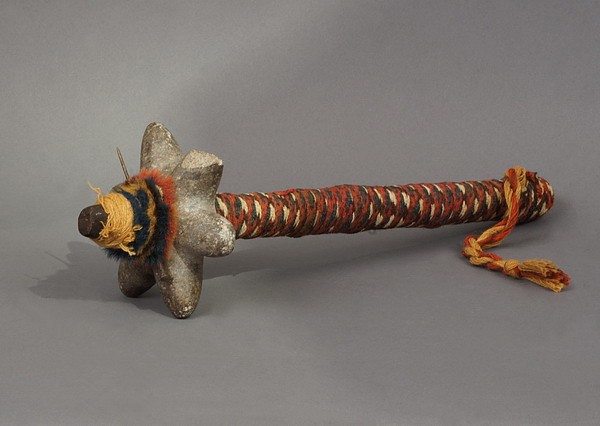


Peru, Club with Six-pointed Stone Mace
This wood handled club is decorated with a colorful alpaca band and topped by a six-pointed stone mace. The mace is secured to the shaft with a bronze needle and a colorful fur-like band. Clubs were favored in the Andes because the Andeans utilized a clobbering form of fighting and hunting as opposed to hunters in Europe, who preferred a piercing technique with hardened metals. There is an example illustrated on a Moche painted ceramic that depicts a deer hunt, in which hunters are using both clubs and darts. The illustration appears in "MOCHE: ART OF PERU" by Christopher Donnan, fig. 263.
Period: Peru, Ica/Chincha, South Coast, circa AD1000-1450
Media: Wood
Dimensions: Length: 16" Diameter of Macehead: 5"
Price Upon Request
n2046
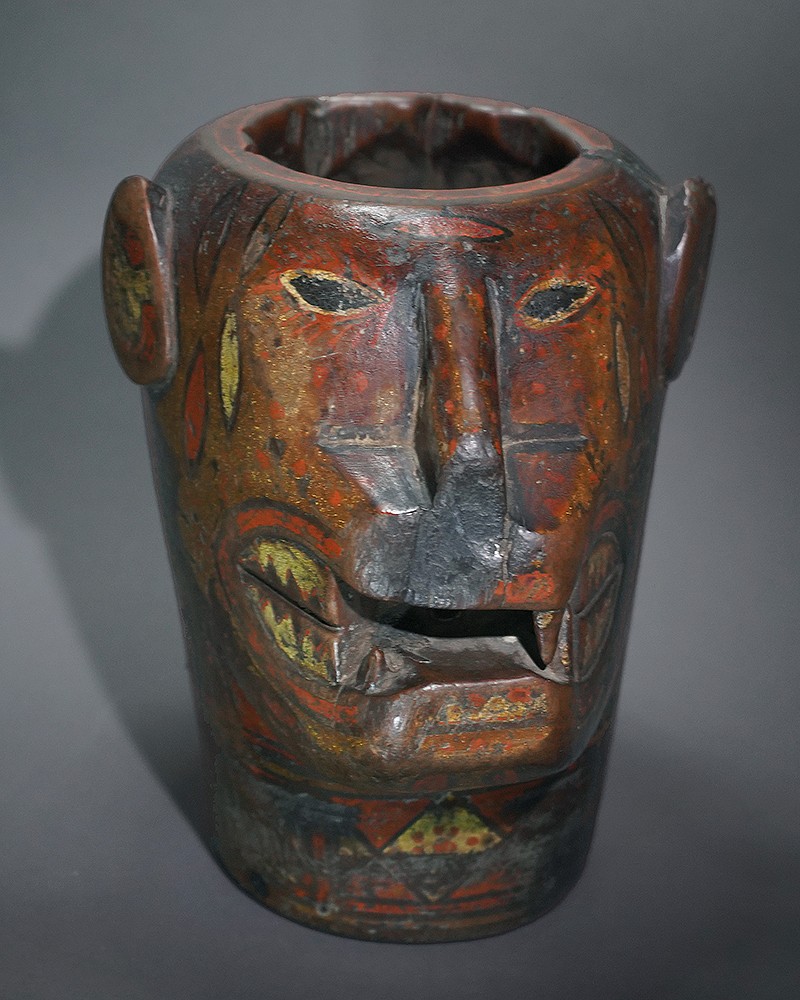













Peru, Colonial Kero in the Form of a Feline Head
Originally the Inca used these carved vessels for ceremonial and festive occasions. This tradition lasted through the late 18th Century. Shaped keros were introduced in the Colonial period and their design is limited to 3 specific types of animal motifs: alpaca, llama, feline. They were also made to resemble Inca lords. Keros were made in pairs; and the pair to this Kero is at the Yale Peabody Museum and is illustrated in “Machu Picchu: Unveiling the Mystery of the Incas†on p.212. The vessel may represent an ocelot rather than a jaguar or puma because of the pelage markings, which indicate that it represents a tropical forest feline. The back of the kero is carved and painted with a scene depicting a battle scene between Inca troops and tropical forest warriors known as the Chunchus - the last group that the Inca conquered. The waxy colored inlay pigments, known as mopa-mopa, came from Pasto, Colombia and the carved wood is mainly from the Escallonia genus of shrubs and trees. A similar kero is illustrated in “MACHU PICCHU: Unveiling the Mystery of the Incas,†on pg. 212. This kero was formerly in the collection of Nelson Rockefeller and was sold at Sotheby's on November 5, 1980, in lot 75.
Period: Peru, Colonial, c. Late 17th Century/Early 18th Century
Media: Wood
Dimensions: Height: 8 3/4" Widest point on top: 6".
Price Upon Request
n8014
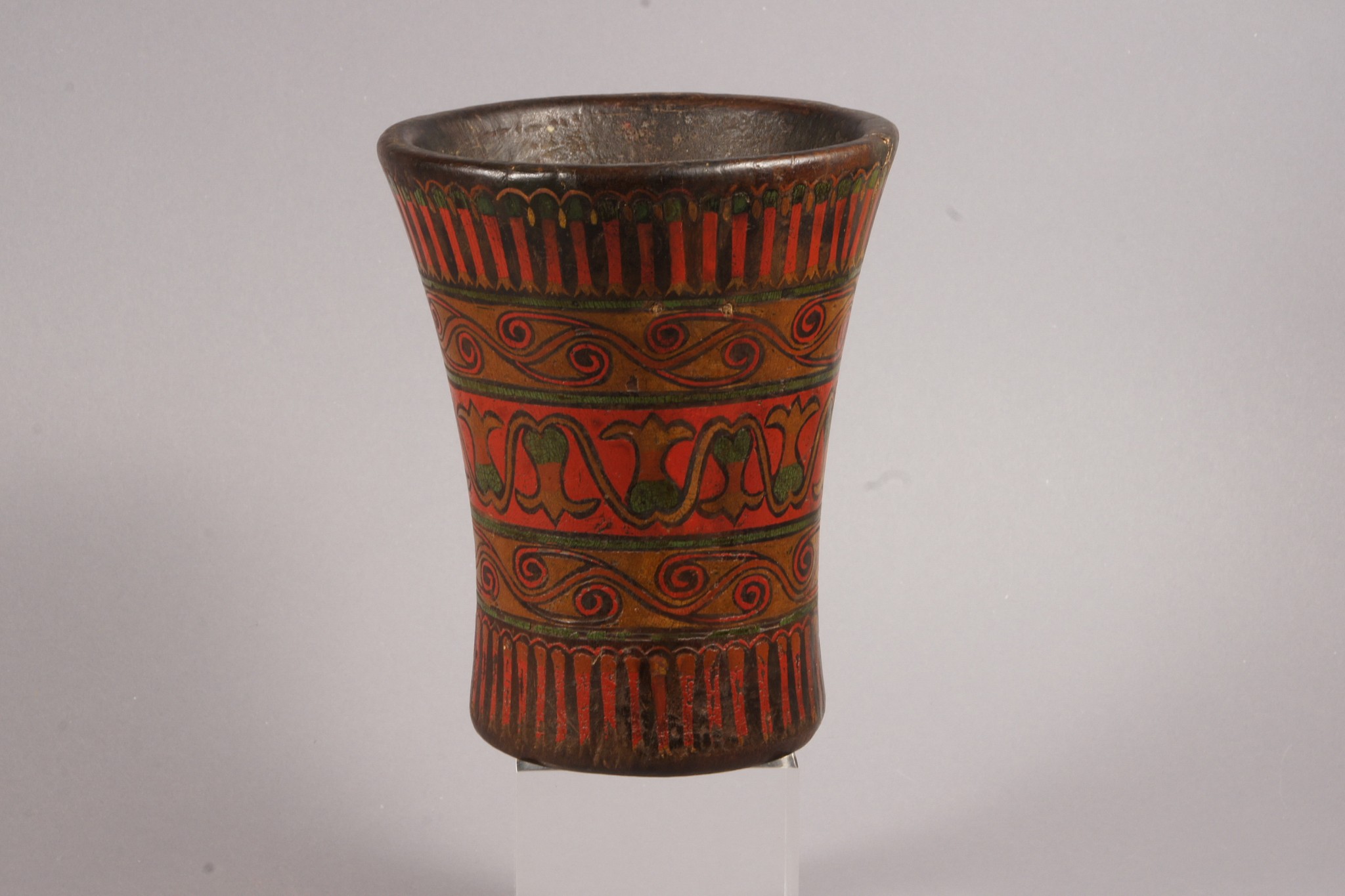



Peru, Colonial Qero with floral motifs in registers
Decorated in five registers with flowers, the pair to this vessel is in the Museo Inka, Universadid Nacional del Cuzco and illustrated in Ochoa et. al. "Qeros: Arte Inka en vasos ceremoniales" (1998: 267). Some were made in pairs, particularly in the Colonial period. Qeros were festive drinking cups that Inca rulers, governors and other state officials used in ceremonies, and they were often gifted from one lord to another. Hans Monheim collection - Aachen Germany since 1950's.
Period: Peru, Inca, Colonial Period, circa AD1600-1800
Media: Wood
Dimensions: Height 6 1/2: x Width: 5 " across the top
Price Upon Request
M4044
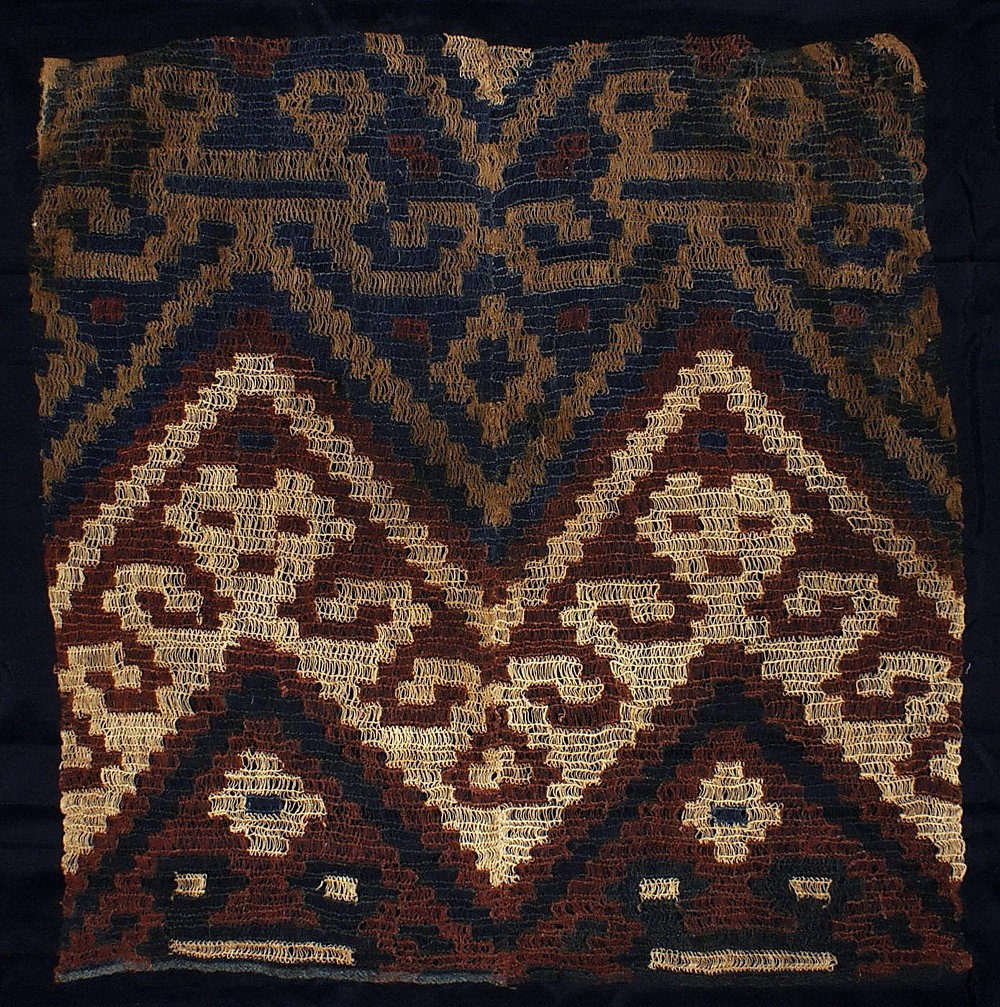





Peru, Colorful Chancay Gauze with Abstract Faces
This is a very unusual gauze in blue, red, and saffron colors. It is woven in two panels and depicts three bands of large abstract faces, bordered by step clefs. In the opposite orientation the faces appear as skates and frogs.
Period: Peru, Chancay, Central Coast, c. AD 1100 - 1430
Media: Textile
Dimensions: Length: 27" x Width: 26"
$8,000
n6053h
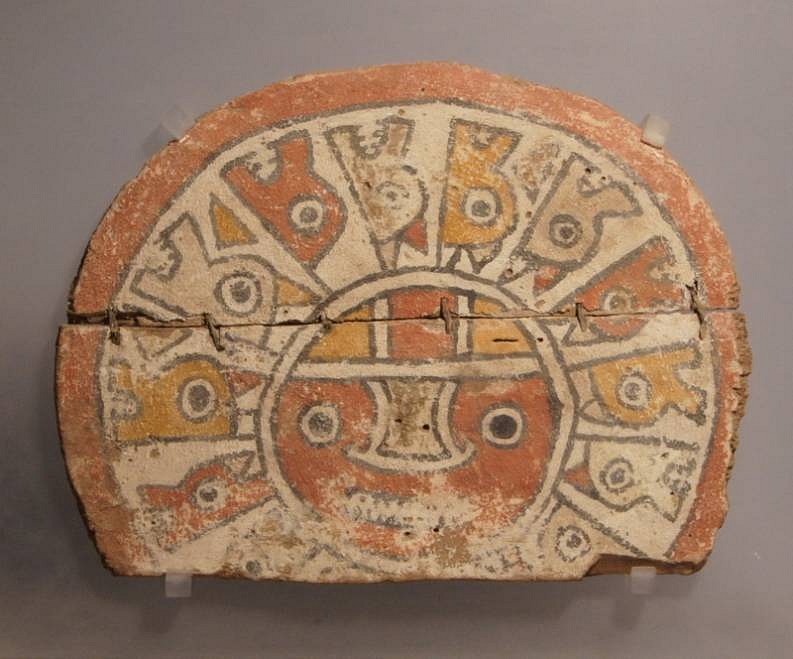




Peru, Early Chancay wood painted circular headdress ornament. with red sun face
A well painted wood disc depicting a sun with serpents heads emanating from the center circle. The painted surface is stucco-like and in excellent condition. The disc has an ancient repair of a clean horizontal break through the center. There are four attachment holes in the center as well, which implies that it was worn either as a headdress ornament or a pectoral. This is illustrated in CHANCAY. The Merrin Galleries have illustrated a painted textile with the same sun face motif and emanating serpents on a poster for an exhibition.
Period: Peru, Chancay, Central Coast, circa 1100 - 1430 AD
Media: Wood
Dimensions: Diameter 9"
Price Upon Request
98089
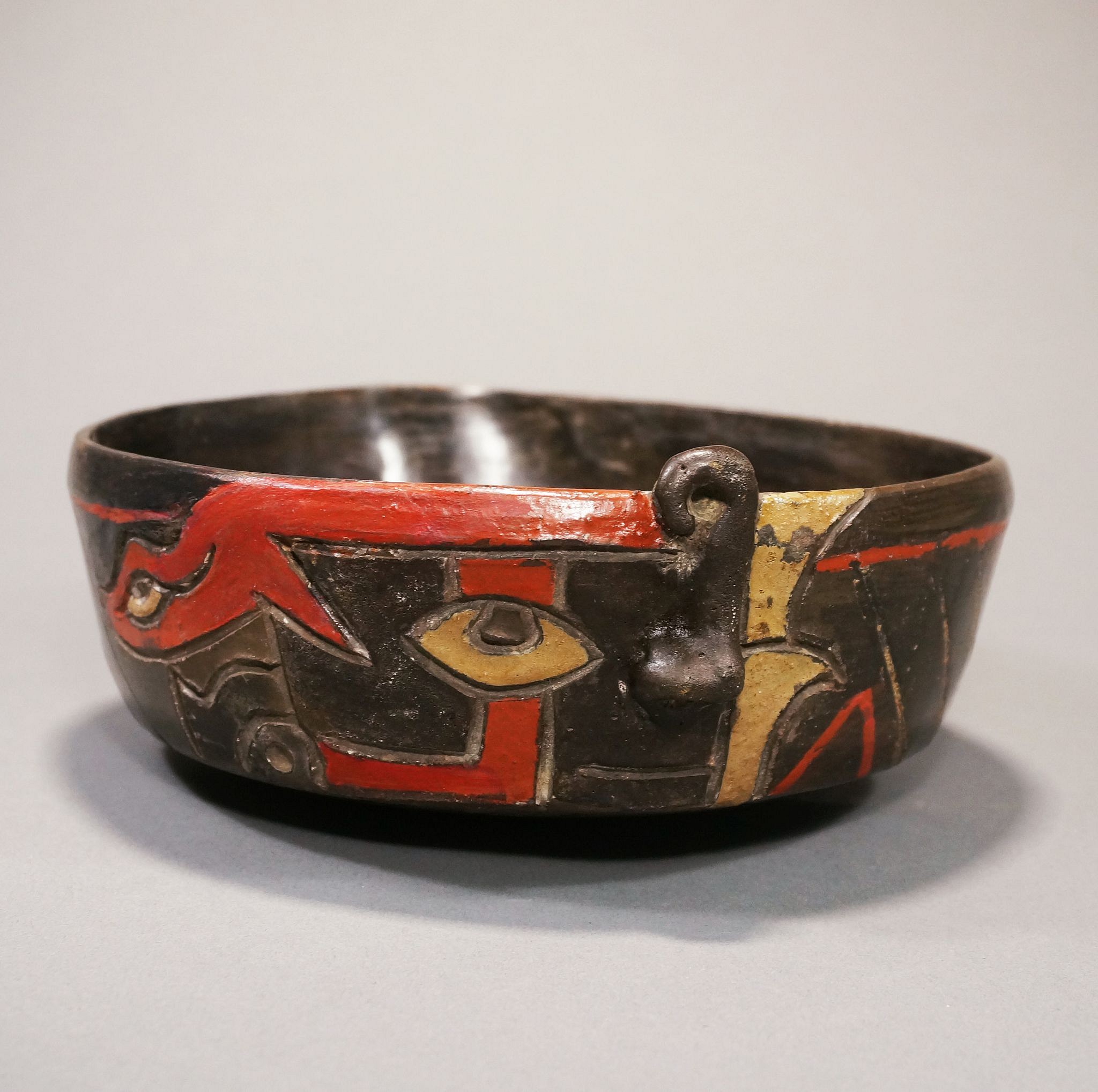




Peru, Early Chavin/Paracas Bowl with Transforming Cubist Face
This bowl demonstrates a human face with a distinct eye looking outward, transforming into the face of a feline entity. The red serpent above the eye suggests the presence of a supernatural demon or perhaps a knowledgeable serpent spirit guide offering wisdom. The incised designs are painted with polychrome resin pigments and has an extended lip on the rear upper edge, which was used to pour ritual libations - perhaps Ayahuasca or a similar psychedelic brew containing DMT from entheogenic plants found in the region. This bowl is also an excellent example of the geometric abstract style with bold blocks of color favored by the Paracas. It shares stylistic traits with the modern Surrealist and Cubist movements, featuring a morphing of narrative portraiture and purely abstract form. Ancient art objects with abstract and surrealist qualities were highly sought after by sophisticated collectors with excellent taste during the mid-20th Century. These collectors would combine ancient and modern artworks together, forming a unified gestalt aesthetic. Abstraction is quite rare among pre-modern societies, and one hypothesis as to why the Andeans had such a sophisticated understanding of abstract form and color is the entheogen theory. In his 2005 paper Psychoactive botanicals in ritual, religion and shamanism, Glenn H. Shepard discusses how Chavin de Huantar, the main Chavin temple, was located near a geologic unstable valley region in the Andes with a wealth of natural plant entheogens where two rivers merge. The Chavin people believed that the spirit could transcend the body and fuse with the spirit of the jaguar, a belief that was likely facilitated by entheogen use. This animistic belief system affected all subsequent Andean cultures, including the Paracas, whose would continue this belief. This bowl depicts a human face with a distinct eye, transforming into a jaguar spirit with a bright red serpent framing the eye. The red serpent suggests the presence of a sentient serpent demon or perhaps a knowledgeable spirit guide offering wisdom.
A very similar vessel is in the Oscar Landmann collection #119, Sao Paulo, Brazil. Ex-Collection Anton Roeckl, Germany.
Note: The bowl was painted within the incised designs with post-fired polychrome resin pigments and finished after firing with a second firing to melt the resin creating a glossy finish. This tradition began with the Chavin cult, a psychedelic cult that engaged in ritualistic jaguar worship. Using psychedelics, one could transcend the body and become the spirit of the feline. The Chavin influenced all subsequent Pre-Columbian cultures, including the Paracas, who would continue this belief. This bowl demonstrates a human face with a distinct eye looking outward, transforming into the face of a feline entity. The red serpent above the eye suggests the presents of a supernatural demon or perhaps a knowledgeable serpent spirit guide offering wisdom to the transforming shaman. This design demonstrates an animist belief in an interconnected network of souls and spirits.
Period: Peru, Paracas, Ocucaje, c. 500 BC - AD 100
Period: Peru, Paracas, Ocucaje, c. 500BC - 100AD BC
Media: Ceramic
Dimensions: Height: 2 1/2" x Diameter: 7"
$22,500
M7134
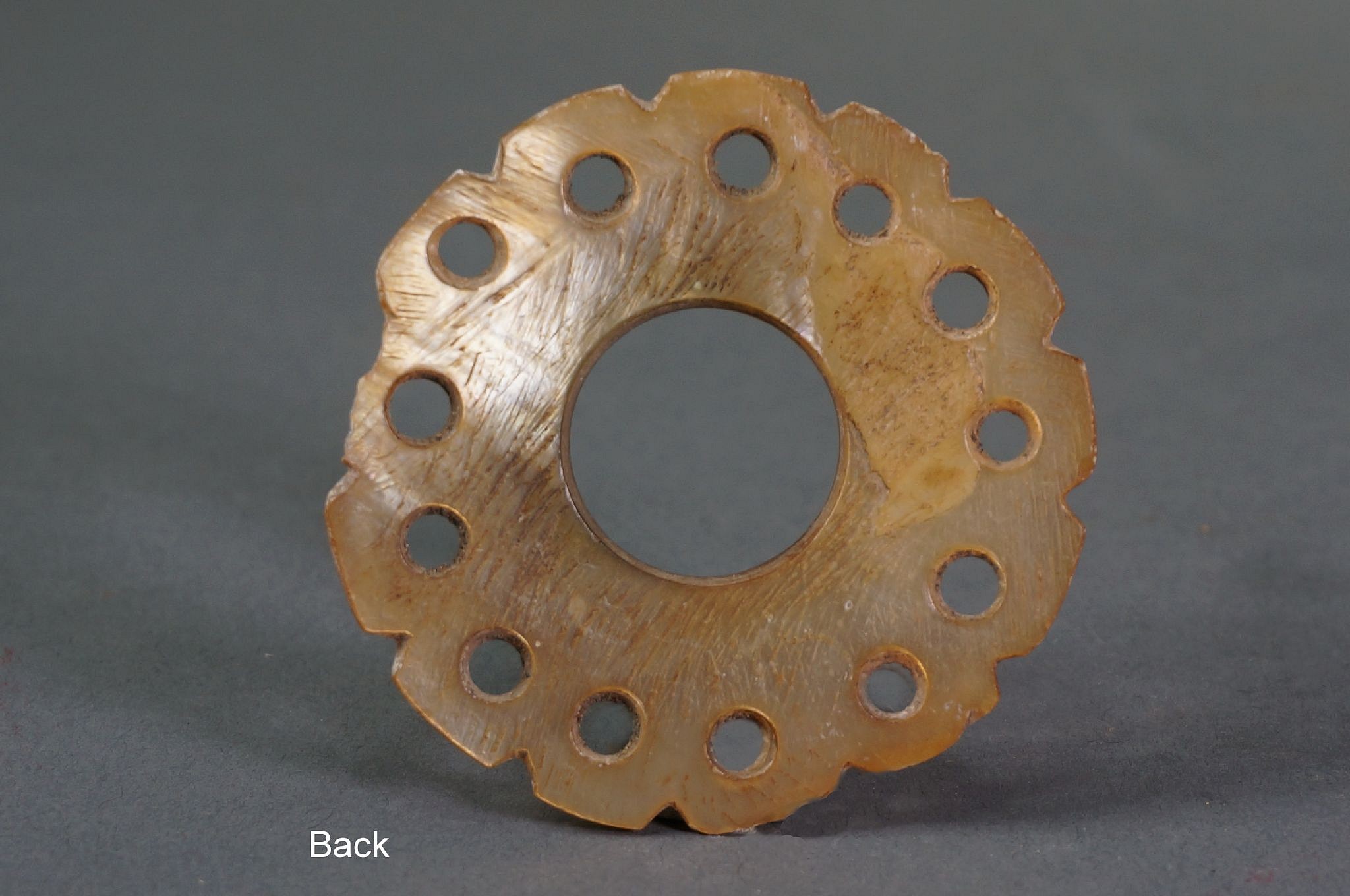


Peru, Early Middle Horizon Mother of Pearl Round Ear Spool Front with 13 Petals
This is a very large piece for a mother of pearl carving and must have come from a very large shell. The 13 petal incised design does not represent a specific flower, but instead is an abstract form depicting a floral shape. The center hole with incised ring is typical of Late Chavin/Early Moche iconography.
Period: Peru, Chavin, Late phase, North Coast, c. 600 - 400 BC
Media: Shell
Dimensions: Diameter: 2"
Price Upon Request
m7118
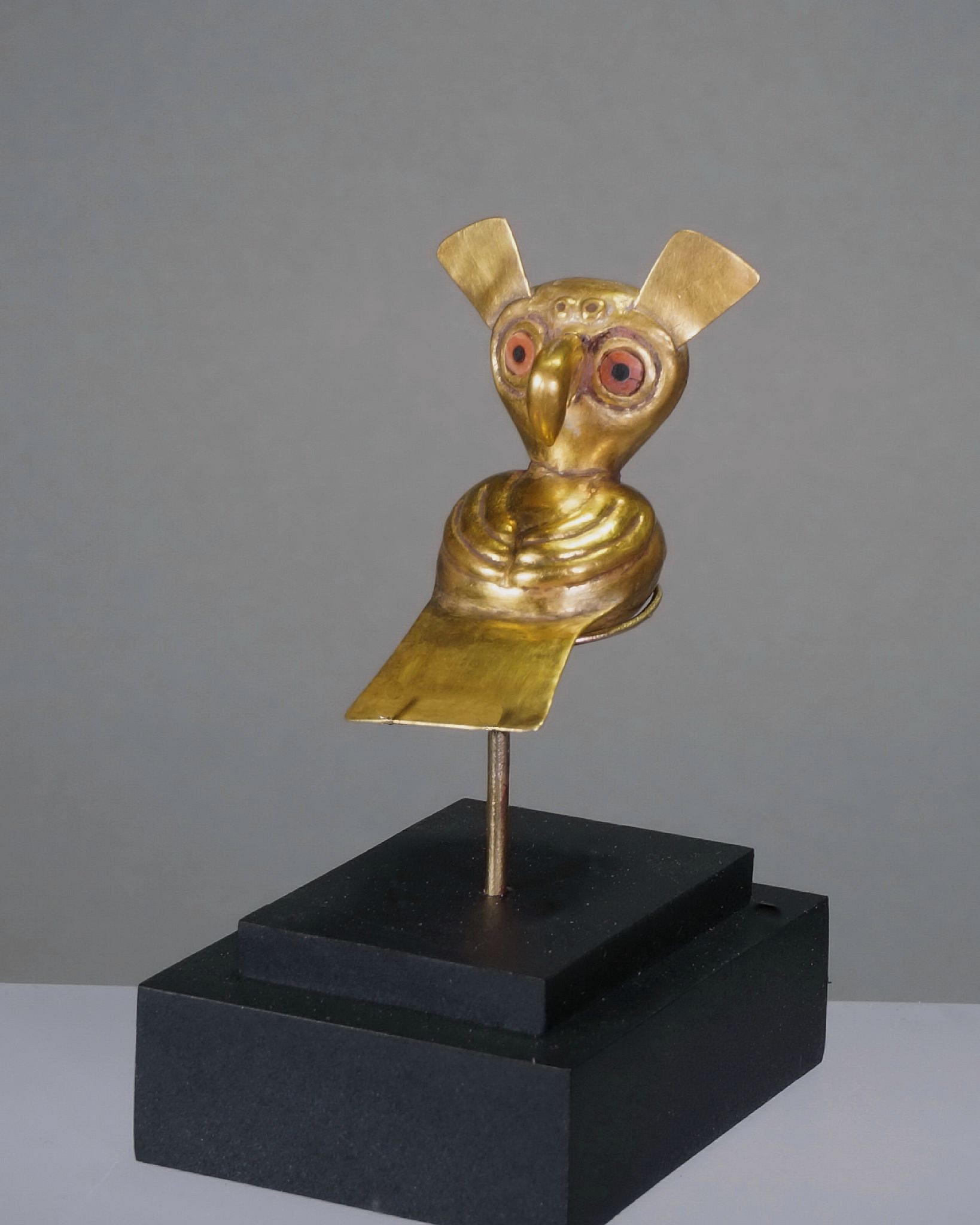



Peru, Early Moche Gold Owl Ornament or Necklace Element
This ornament portrays a stylized horned owl. The owl was revered by the ancient people for its special characteristics, such as silent flight, strong talons, and its ability to rotate its head 180 degrees. This gold owl has two suspension holes to the lower rear, which would have allowed it to hang looking downward. It is constructed from flat pieces of sheet gold that were hammered and beaten into repoussé parts, and then soldered together. Such three-dimensional forms were characteristic of the Transitional phase of gold work on the North Coast after the collapse of the ChavÃn culture. The eyes are made from Spondylus beads.
Period: Peru, Late Chavin/Early Moche, Transitional Phase, North Coast, c. 200 BC - AD 200
Media: Metal
Dimensions: Height: 1 1/4" X 1 1/4"/ Weight: 10 grams
Price Upon Request
M7015
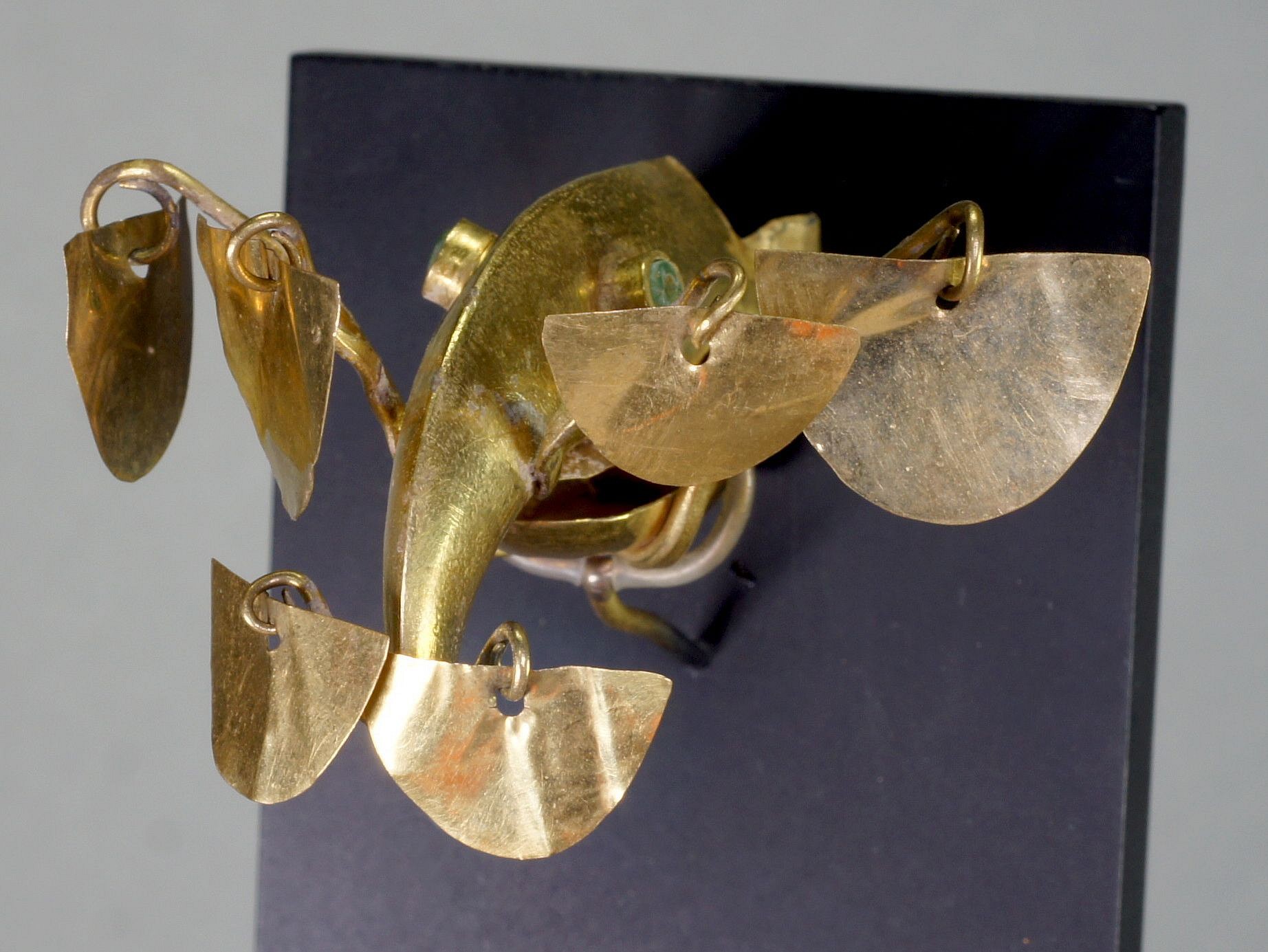



Peru, Early Moche/Vicus Head of a Tucan with Dangles
This object is quite rare and is from Northern Peru, by the Maranon river valley where other Vicus style objects have come from. It is fashioned from a heavy sheet, bent, soldered, and has dangles. It would have fit front and center onto a headdress, attached using the tabs at the back. The rods that hold the dangles are soldered, along with the bottom of the beak. The eyes are soldered rings with turquoise inlays. A similar object is illustrated in the GOLD OF PERU, Mujica Gaillo collection.
Period: Peru, Vicus, Far North Coast, c. 300 BC - AD 300
Media: Metal
Dimensions: Length 3 3/4" Weight 32.8 grams
$8,500
91055
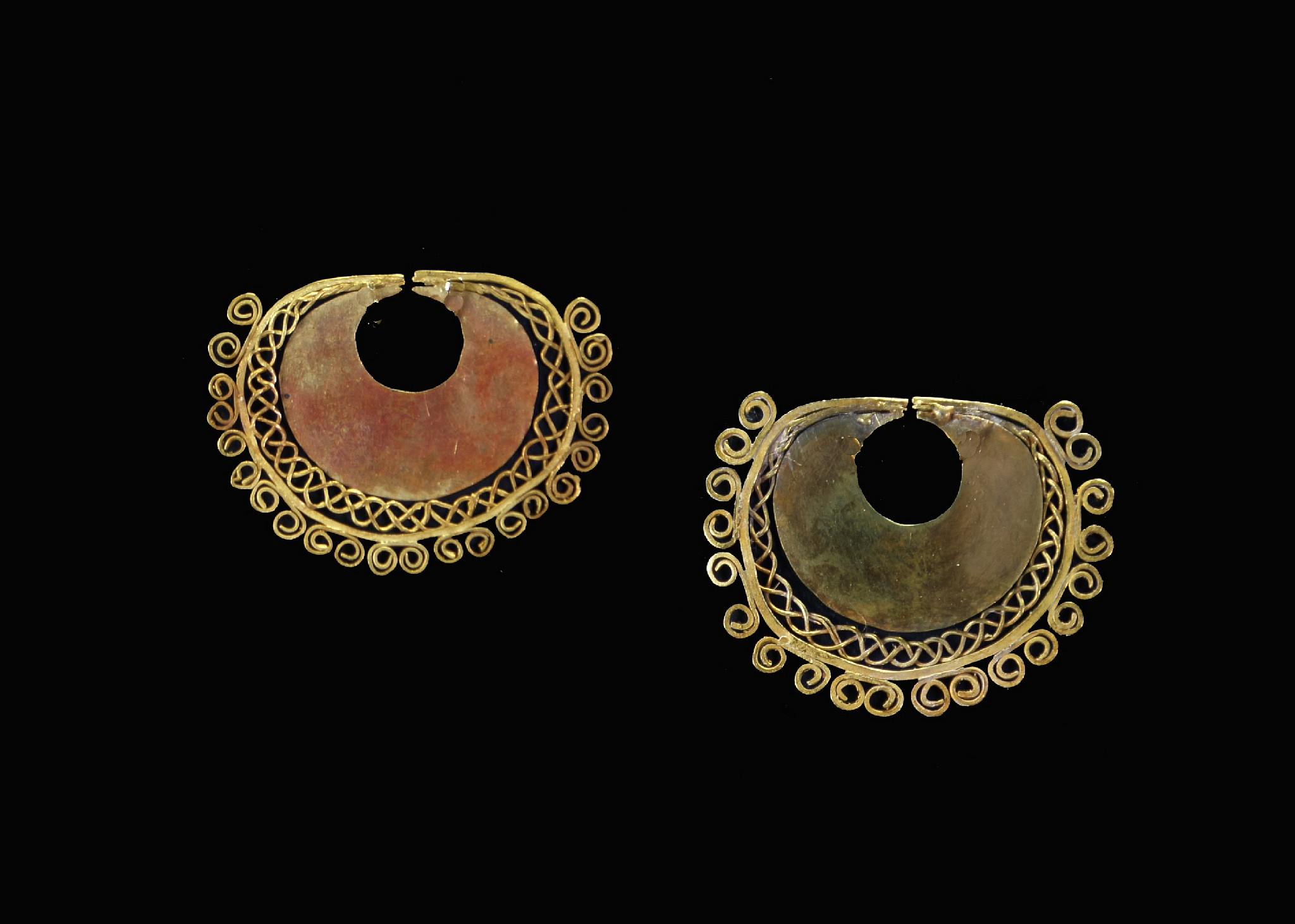
Peru, Early Nasca Gold Pair of Earrings with Filigree Decoration
A matched set of Nasca gold earrings with true filigree work and original archaeological patina. The wire is skillfully soldered to the central disc.
Period: Peru, Nasca, South Coast, c. AD 400 - 800
Media: Metal
Dimensions: Width 1 3/8" Weight: 3.8 grams
Price Upon Request
87044













Peru, Early Nazca/Late Wari Tie- Dye Patchwork Rectangular Bag
This tie dye rectangular bag with discontinuous interlocking patchwork was probably used for carrying feathers. The bag was made from surplus squares left over from a larger mantle, utilizing the scaffold technique. Collected by Gunnolf Bjorkman who worked in Lima in the 1960's and settled in Buenos Aires.
Period: Peru, Nasca, South Coast, c. AD 300 - 700
Media: Textile
Dimensions: Length: 26" x Width: 4 1/2 in.
$7,250
91265
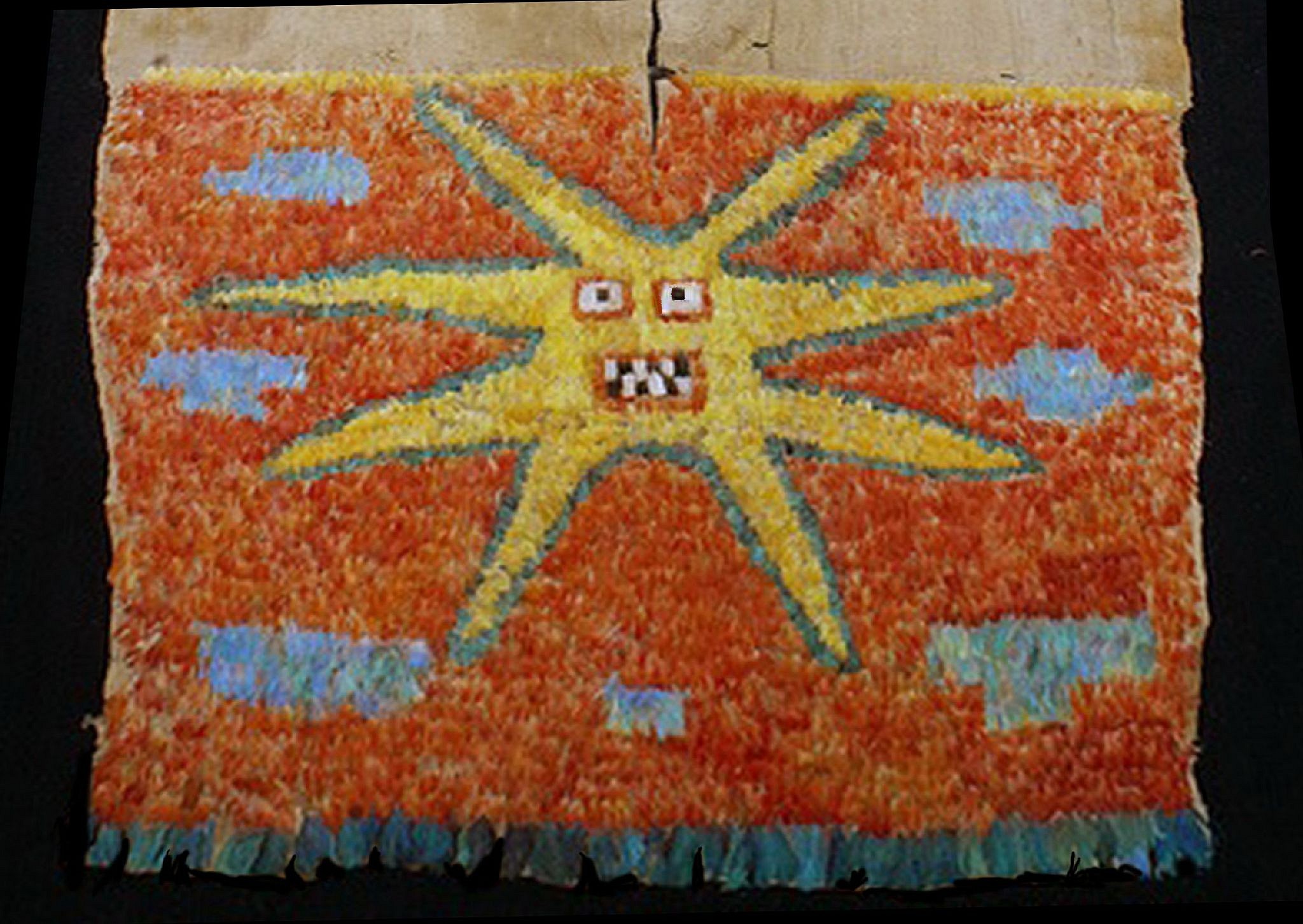






Peru, Early Nazca/Sihuas Feather Tunic With the Eight Pointed Star On an Orange Ground
This tunic with an eight-pointed star motif, also referred to as the Radiant Sun, is similar to other published tunics. The front part is a complete star with assorted color blocks of blue feathers. The back of the tunic has only two blue stripes on an orange ground with a fringe of turquoise macaw tail feathers. The blue feathers do not contain blue pigment, but instead are natural prisms which brightly reflect the color of the sky. I believe that all the feathers are from the Scarlet, Yellow, and Blue Macaws. Tunics with similar motifs are illustrated in TEXTILE ART OF PERU, 1989, L.L. Editores, Lima. pages145,-147 & 163. Usually tunics with an eight-pointed star motif are from the Nazca region, from the South coast of Peru. This tunic was found in the Sihuas region near the city of Arequipa and predates the Nazca by 500 years. The backing fabric is fragile and needs proper conservation.
Period: Peru, Sihuas II, Southern Andes, c. AD 100 - 300
Media: Textile
Dimensions: Length 56" x Width 35" (142cm X 88.9cm)
Price Upon Request
N1028
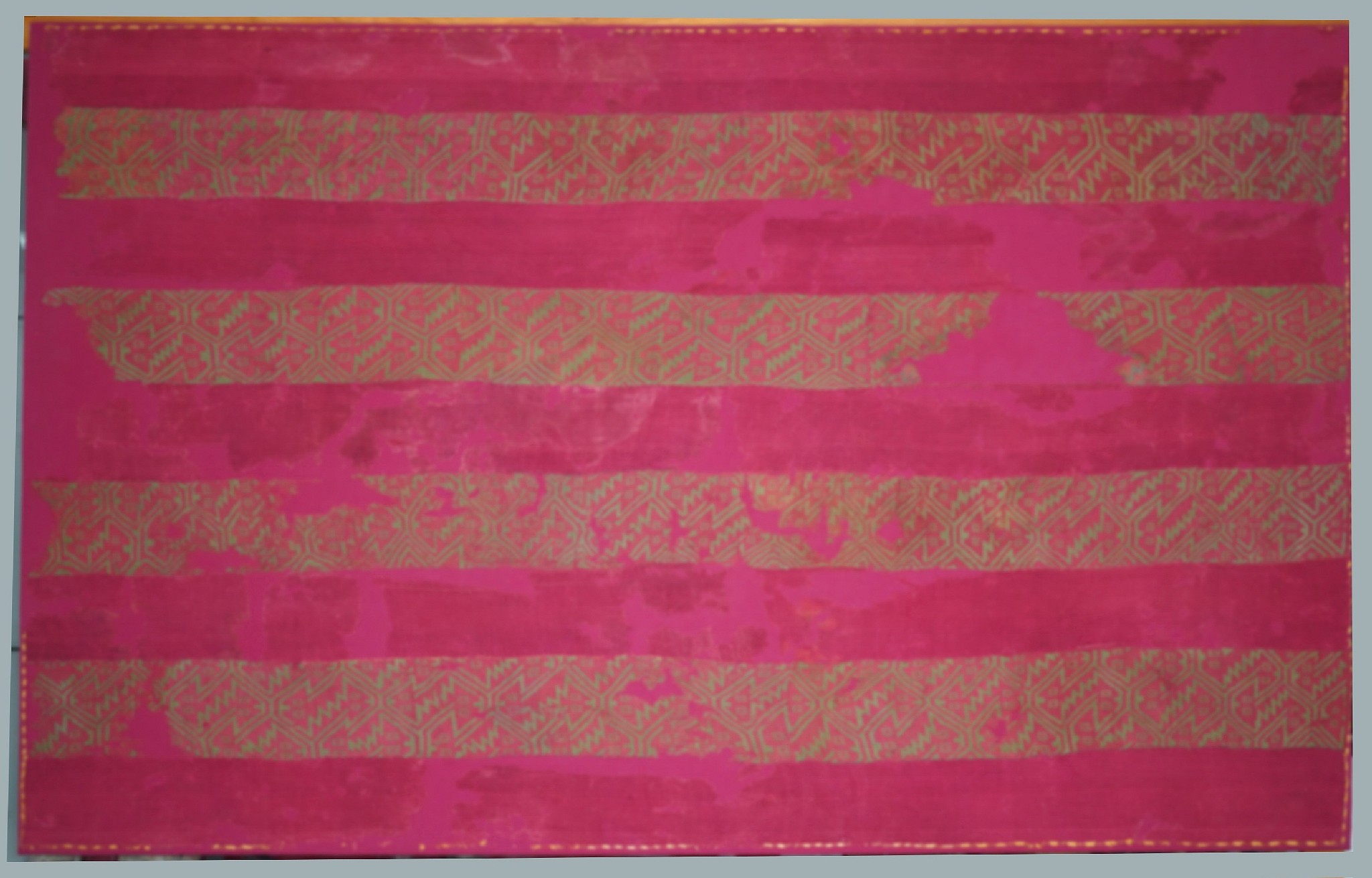


Peru, Early Paracas Double-Cloth Mantle with Bands of Interlocking Serpents on Strawberry Ground
This beautiful woven textile features lime green bands of interlocking geometric double-headed snakes on a red ground. The interlocking serpent motif is one of the oldest motifs in the Andes, dating prior to 1,500 BC. Snakes were an important part of Andean mythology; they emerge following a rain and are often portrayed in Pre-Columbian art together with imagery of water, rainbows, and energy. Double-headed snakes do exist in nature, although they are extremely rare, and it is likely that they were considered a powerful omen of abundance in Paracas animist cosmology. The double-headed snakes portrayed here also feature lightning strike designs on their torsos, which convey a sense of energy, motion, and power.
The contrasting combination of bright red and lime green fields create an optical illusion that the snakes are vibrating. These two carefully chosen hues of red and green are at opposite ends of the visual spectrum that the human eye can see, causing the brain to become overloaded, which translates into a sense of vibration. The Paracas’ knowledge of color with many of the great abstract color theorist artists of the 20th Century such as Albers, Malevich, and Kandinsky. Ancient works of art with abstract beauty such as this were highly sought after during the golden age of collecting in the Mid-20th century by wealthy collectors as well as artists such as Matisse and Picasso.
The mantle bands were woven using a complicated technique called double cloth in which the front side motifs are in opposite colors from the rear. This same motif appears in the frontispiece in Bird and Bellinger's catalog raisonne Paracas Textiles. Professionally restored and mounted on a stretcher. Acquired by David Bernstein in 2000.
Period: Peru, Paracas, South Coast Early Intermediate Period, Phase II, c. AD 100 - 200
Period: Peru, Paracas, South Coast Early Intermediate Period, Phase II, c. AD 100 - 200
Media: Textile
Dimensions: Length: 63 in. x Width: 39 in.
$38,000
MM318
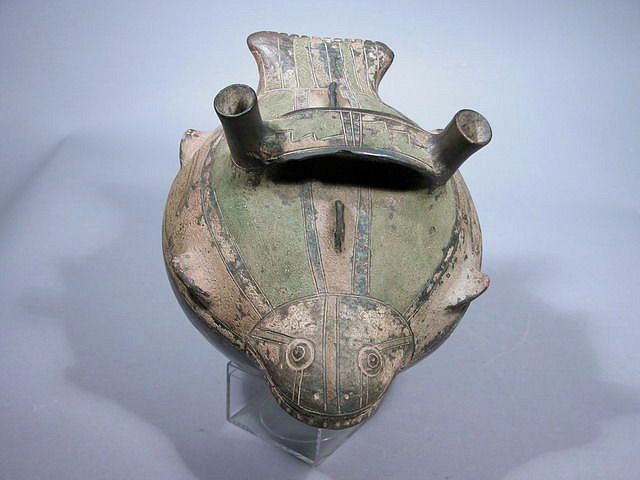




Peru, Effigy Vessel of a Patagonian Toothfish with Resin Pigment
This bridge-spout vessel depicts a toothfish decorated with longitudinal bands of buff and green pigment. The protruding head and fins resemble the Patagonian toothfish, popularly known as the Chilean sea bass. These fish were caught with a hook and line in ancient Pre-Columbia and are still caught this way in modern times. The Patagoninan toothfish, (Dissostichus eleginoides) has a long life span and is thought to live up to 50 years. The average toothfish weighs between 15 and 20 pounds, however they can grow as large as 220 pounds. The flaring spouts indicate that the ceramic was crafted in the Paracas Necropolis style, as opposed to the more common Cavernas style, which features blind bridge spouts. The harmonic balance between naturalism and abstraction is a unique stylistic trait in Andean art that attracted cubist and minimalist artists such as Pablo Picasso and Henry Moore to ancient Andean art. These famous artists were intrigued by Andean art and wanted to replicate this method of combining abstract forms and narrative imagery in their own paintings and sculpture. Alan Sawyer discusses the Necropolis style in his book Ancient Peruvian Ceramics: The Nathan Cummings collection on pages 96-97, fig. 135-138. The only other known Paracas toothfish vessel is in the Museum of the University Agraria, Lima, Peru. Acquired from the estate of British collector. London, prior to 1996.
Period: Peru, Paracas, South Coast, c. 500 - 200 BC
Period: Peru, Paracas, South Coast, c. 500 - 200 BC
Media: Ceramic
Dimensions: Height: 6 1/2" (14.2 cm.) X Length: 8" (18 cm.)
$35,000
96044
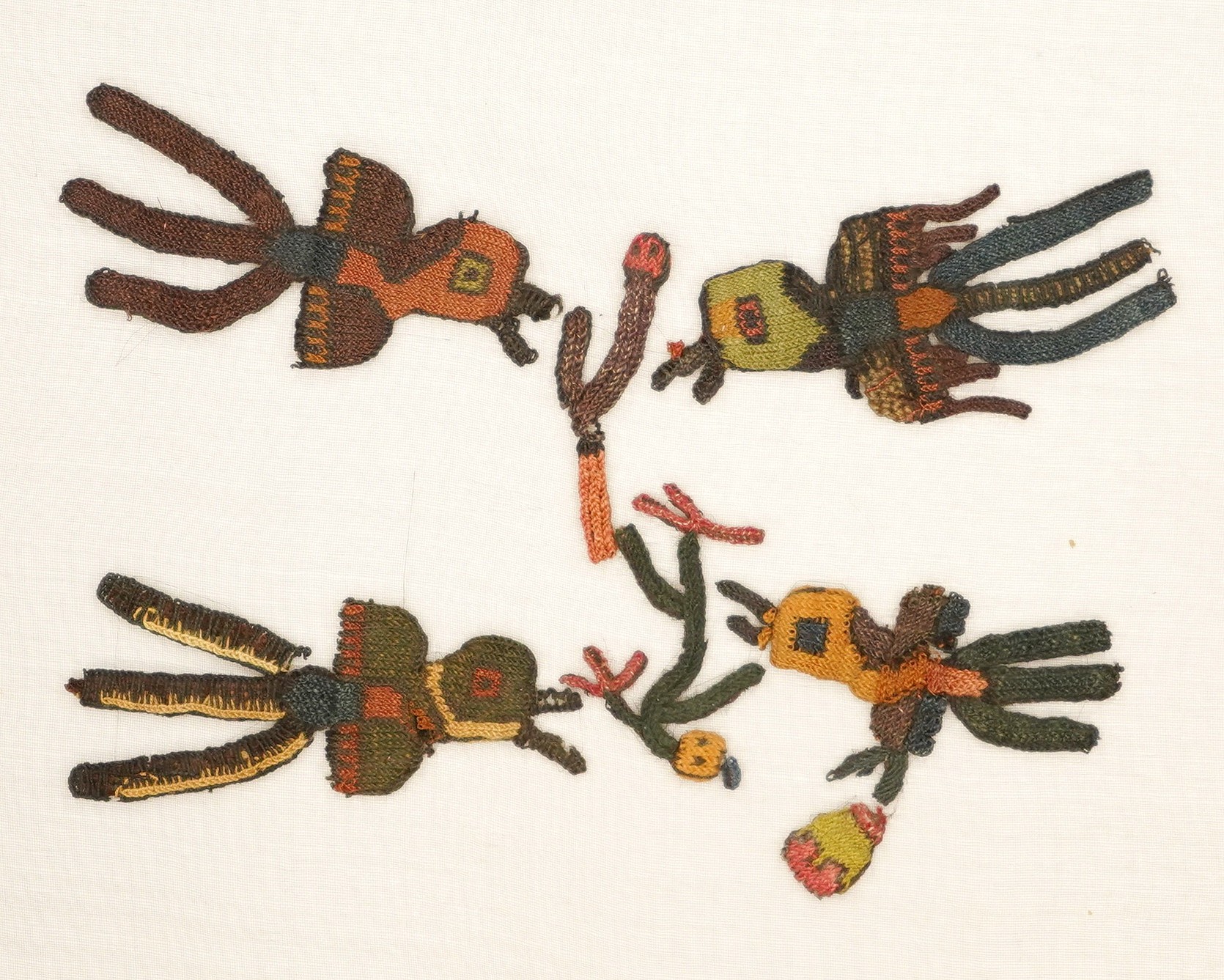
Peru, Four Paracas Embroidered Nightjars
This beautiful series of Nightjar birds is mounted on a fine netting with embroidery on both sides but is displayed on a white backing for ease of viewing. Nightjars are identifiable by the two extremely long feathers which extend down beyond their tails, possibly as a display to attract mates. The Nightjar, a nocturnal bird of prey, is a rare subject in Andean art; most birds depicted are picaflors or hummingbirds. These Nightjars are seen feasting on clusters of small snakes that resemble garter snakes. Excellent color. Ex. collection Ferdinand Anton, Germany, prior to 1980.
Peru, Paracas, Late Phase, South Coast, c. 200 BC - AD 100
Period: Peru, Paracas, Late Phase, South Coast, c. 200 BC - AD 100
Media: Textile
Dimensions: Width: 6" x Height: 4"
Mounted: W: 20" x H: 16"
$1,600
79042
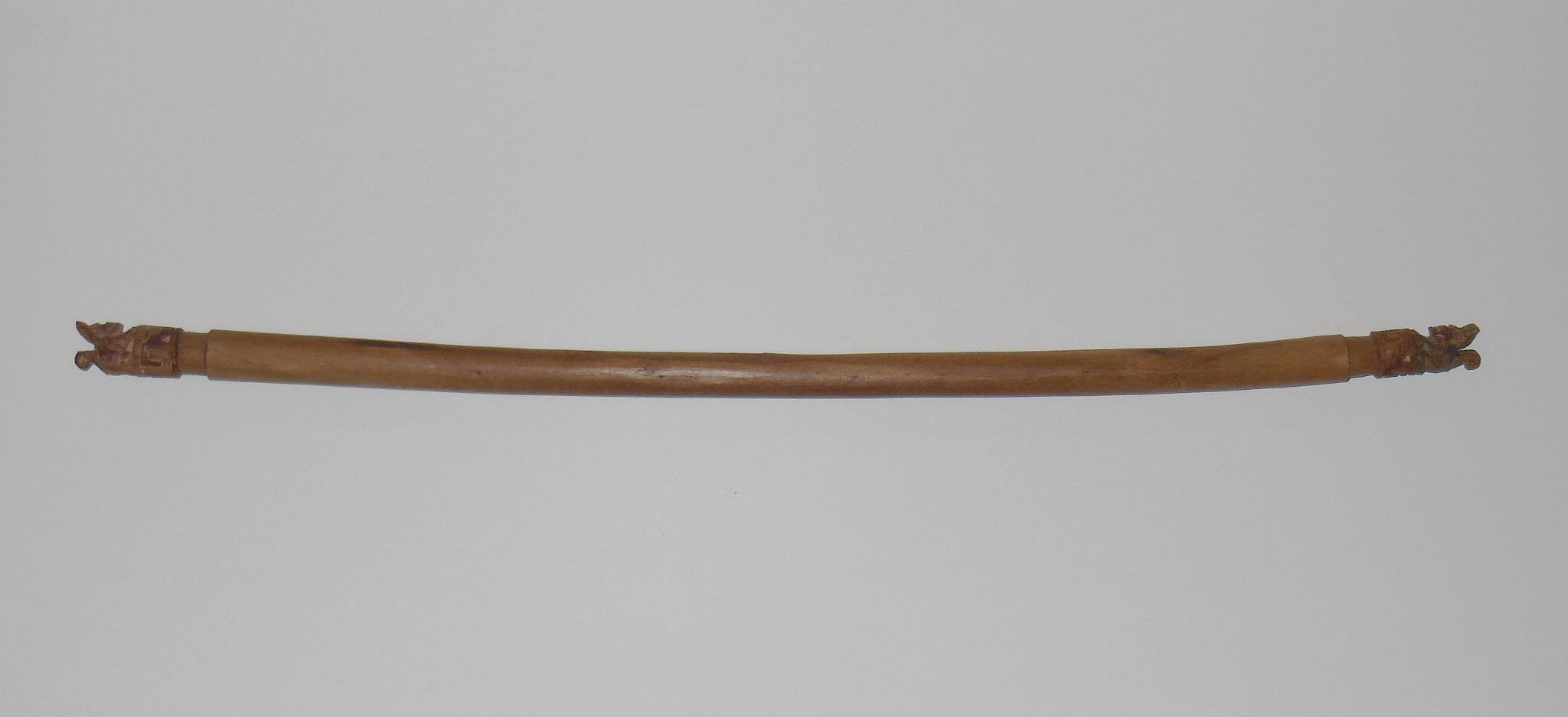




Peru, Huacho Carved Loom Bar with “Mooneater” Deities
This loom bar was once part of a backstrap loom - the most common loom type in the ancient Andes, dating back to the late Chavin Period. Andean backstrap looms are usually 22-28†in width. It would have been one of two bars needed to hold the warps together to the upper bar. This bar is elaborately decorated with an intricately carved “Mooneater†deity at each end.
Period: Peru, Huacho Valley, Late Intermediate Period, c. AD 700 - 1100
Media: Wood
Dimensions: Width: 24" x Diameter: 1/2"
$1,700
p2032H
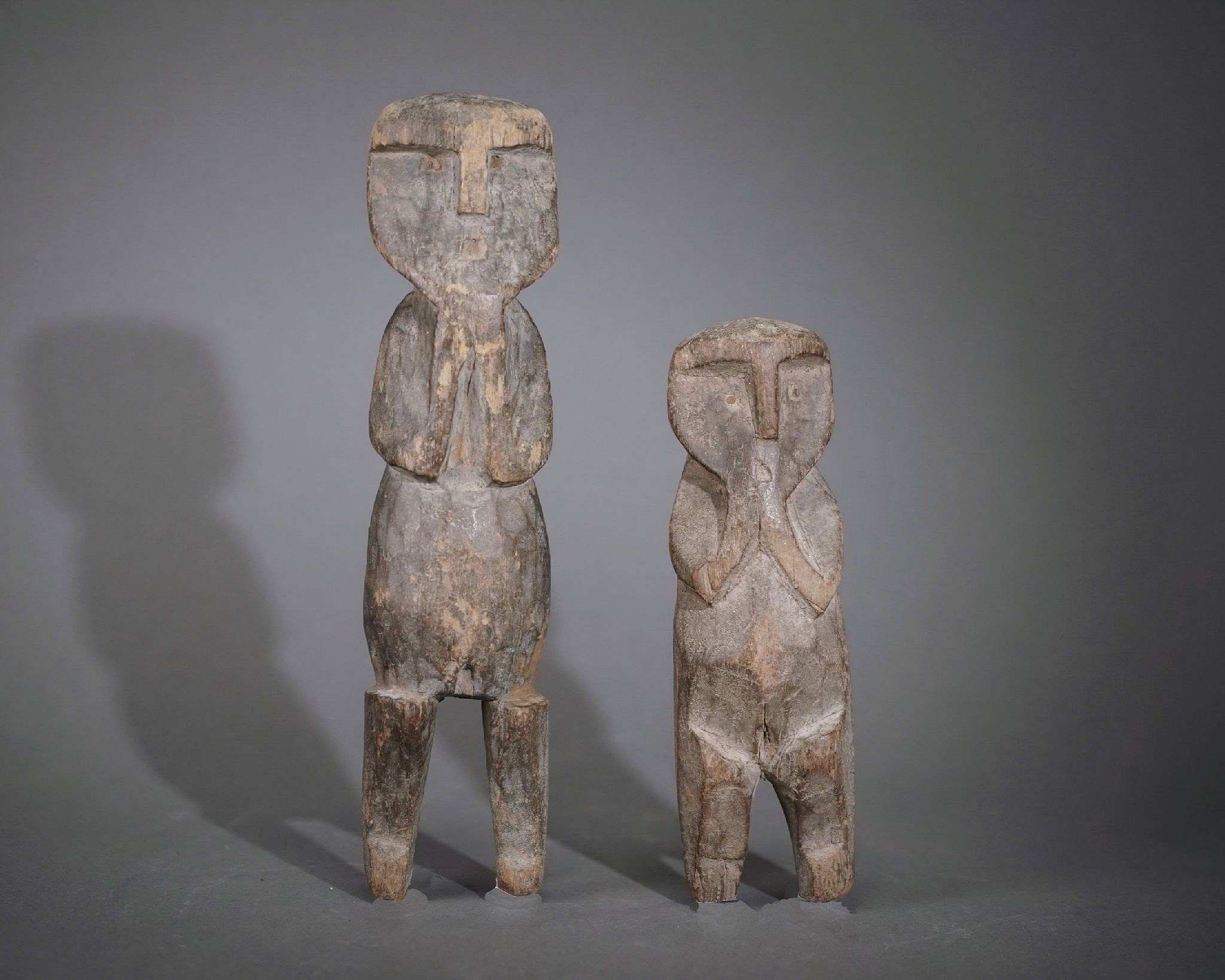
Peru, Huacho Carved Wooden Pair of Abstract Female Figures
These figures are unusual in form and share a similarity with 19th century Mapuche burial markers and are thought to be totems. Each figure holds its hands to the mouth have pronounced knees and display female genitalia. The backs of the figures are flat. Carved wooden figures are mostly found in burials during the Late Intermediate Period.
Period: Peru, Huacho Valley, Late Intermediate Period, c. AD 700 - 1100
Media: Wood
Dimensions: HeightA: 7 1/2" Height: B 5 1/4"
$1,950
p2042AB
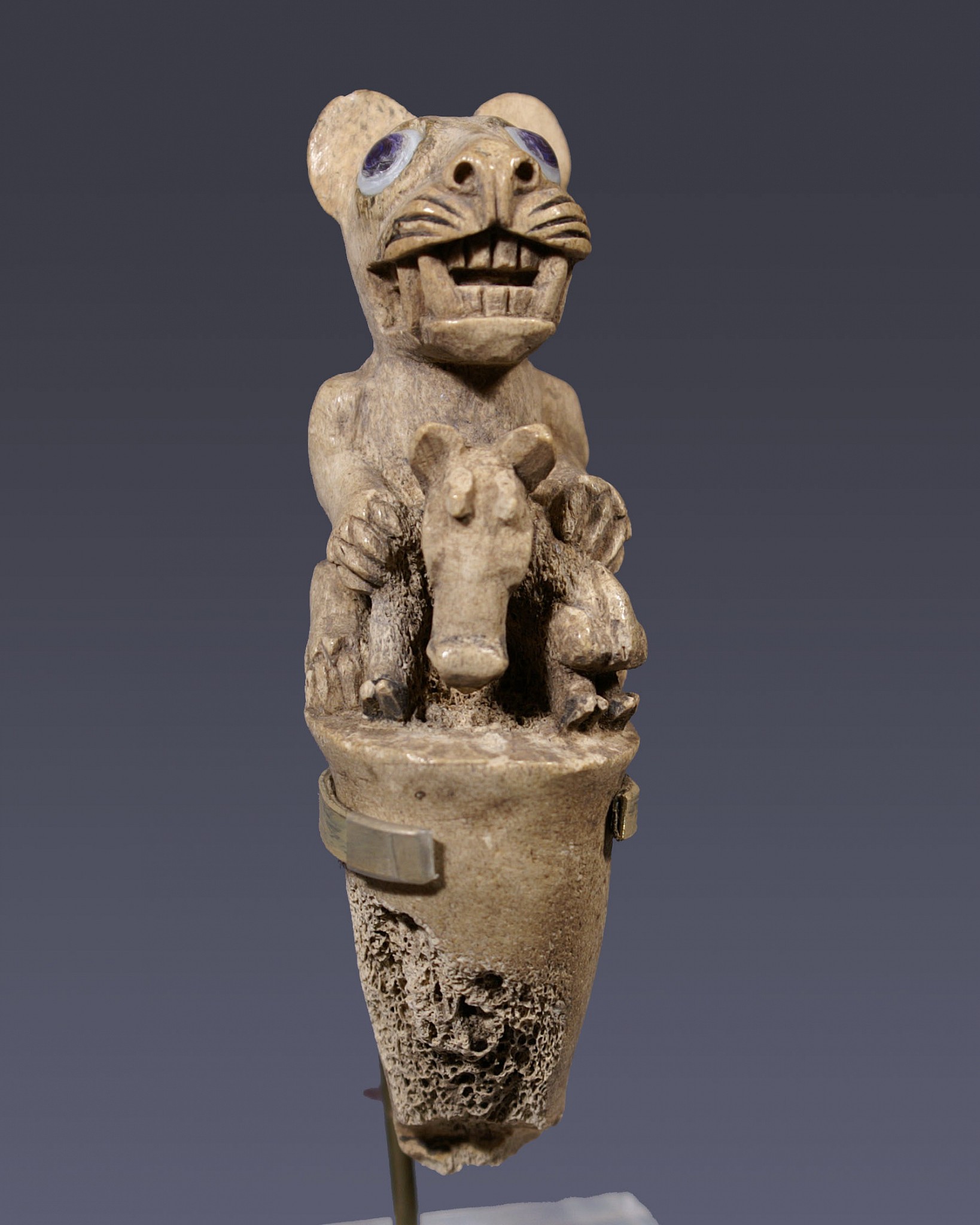




Peru, Huari bone carved "Attelatel" handle with seated feline and deer
This was the grip for a spear thrower, with its original tie hole attachement. On the base of the feline is a deer wtih its antlers. This is a common motif throughout antiquity starting with the Sythicans of Russia where a lion is always attacking deer.
Period: Huari, South Coast Peru, c. 700-900 A.D.
Media: Bone
Dimensions: H. 4 x W. 1 1/4 in.
$9,500
91181





Peru, Huarmay Tapestry Border to a Poncho with Three Warriors
This classic Huarmay style tapestry is crafted in the classic Huarmay colors of ivory, blue, and red with black outlines. Each warrior wears different colors, and each holds a tumi in his left hand and wears an elaborate headdress with two long, forward-tilting plumes. Separating the warriors are blocks of ivory with three abstract birds on a diagonal. Along the bottom edge is a repeating classic step volute line in blue with a white outline. The Huarmay culture thrived during the Late Moche Period on the most Southern of the fourteen Moche valleys, and were influenced by the Wari. Mounted, in a Plexiglas box. Minor losses to the ivory central panel. Formerly in a New York private collection prior to 1979.
Period: Peru, Huarmay, Central Coast, c. AD 650 - 800
Media: Textile
Dimensions: Width: 48" x Height: 6 1/2"
$8,500
n9040
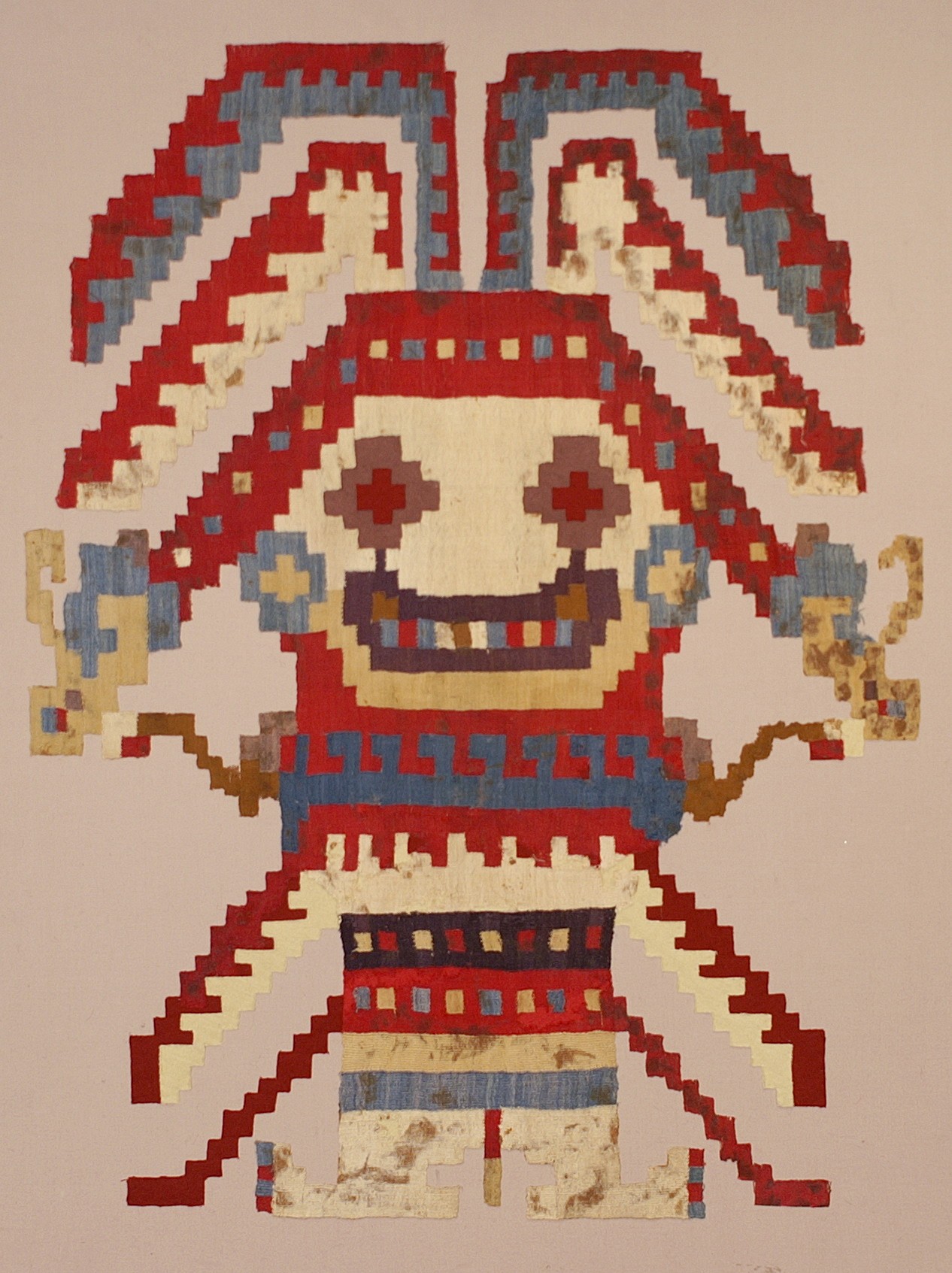



Peru, Huarmey Tapestry deity with rayed headdress
This is a very large single figure for any Peruvian weaving, and it was originally attached to a mantle of sheer cotton. The figure wears a headdress, ear spools, necklace, and tunic with a serpent belt in the red, blue and ivory colors typical of Huarmey textiles. The Huarmey Valley is the most southern in the Moche area and had, therefore, a lot of Wari influence in its art. This figure is stylistically more Wari than Moche in its abstract appearance.
Period: Peru, Moche, Huarmey Valley, circa AD700-900
Media: Textile
Dimensions: Length 32" x Width 24"
Price Upon Request
92305
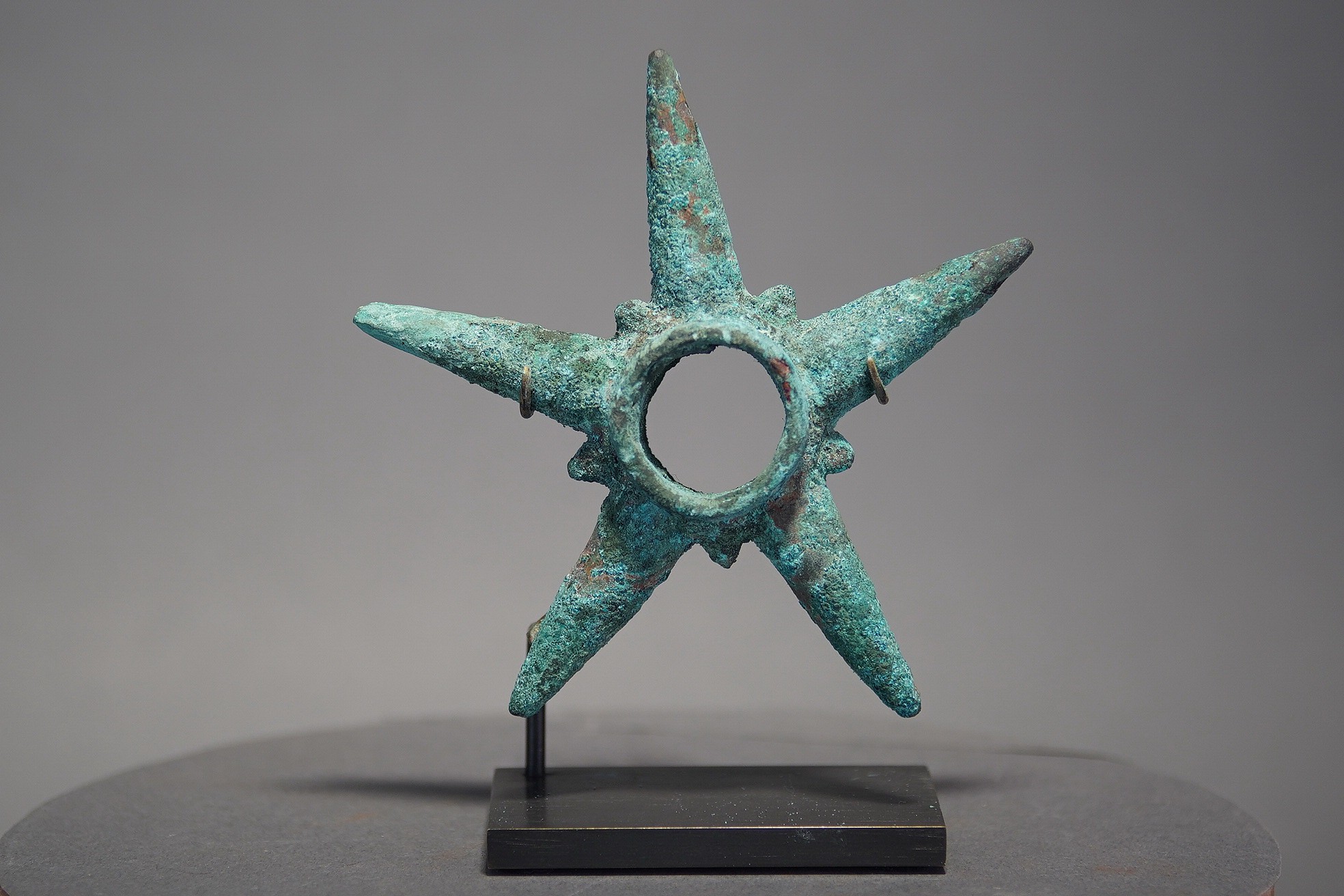



Peru, Inca Bronze Star Mace
This mace was well cast with a lost wax method. The Andean cultures utilized clobbering technology for their weapons, as opposed to swords and knives used in battle by their ancient European counterparts. The star motif was an Inca design and quite effective as a weapon. This mace was from the North Coast of Peru where they had arsenical bronze as opposed to Tin bronze found in the Southern highlands of Peru and Bolivia. Similar 5-pointed bronze maces are illustrated in Copper of Ancient Peru pg 425. Original patina, and intact in most places. Mounted on a custom-made base.
Period: Peru, North Coast, c. AD 1350 - 1530
Media: Metal
Dimensions: Height: 4 1/2" x Width: 4 1/2"
$1,350
96120
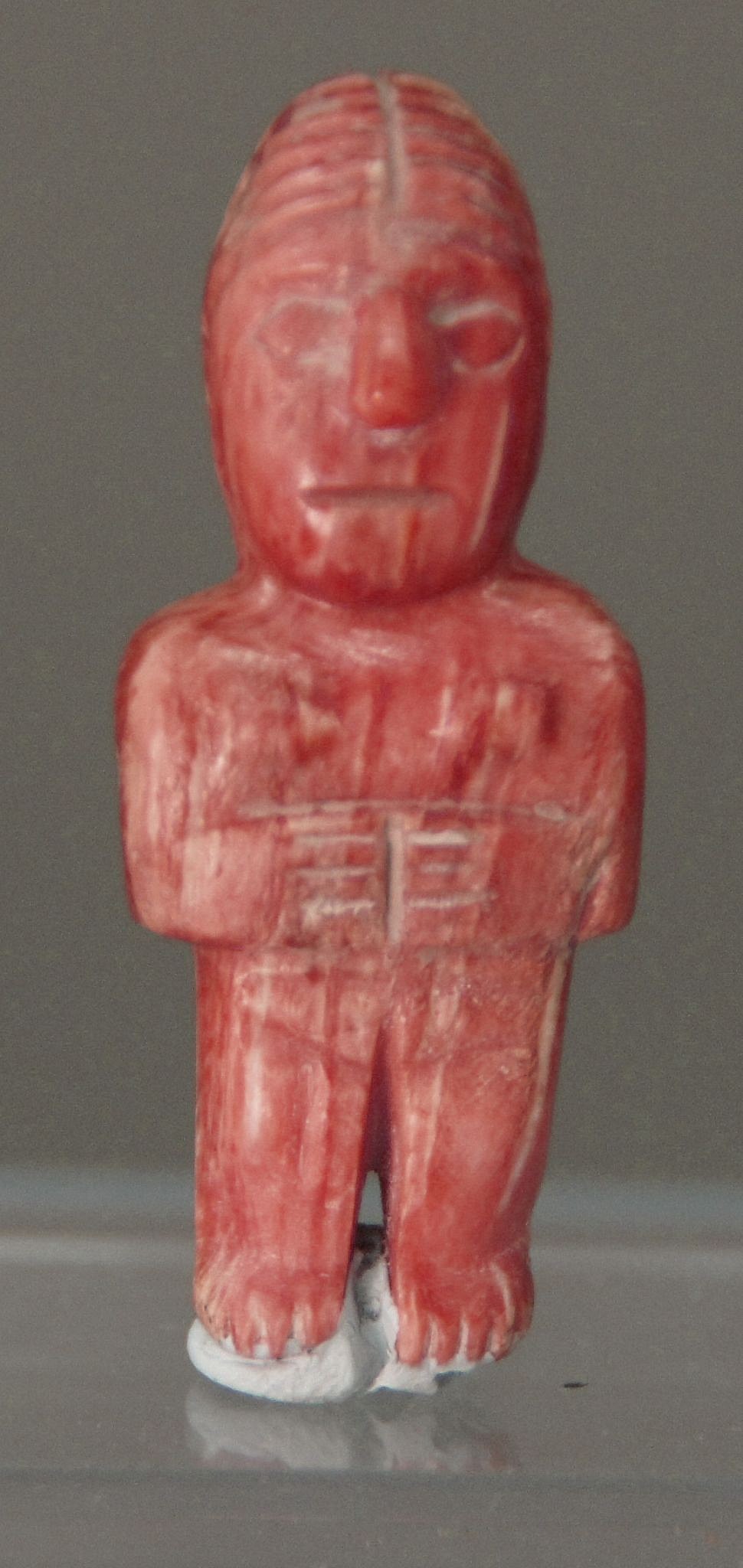


Peru, Inca Carved Spondylus Shell in the Form of a Female
The female is holding her hands to her belly. The shell was carved in such a way that the front of the doll is reddish-orange and the rear is the white part of the Spondylus shell. These carved dolls were placed in burials of young girls as a sacrifice.
Period: Peru, Inca, South Coast, circa AD1200 -1532
Media: Shell
Dimensions: Height 4cm
Price Upon Request
N5048
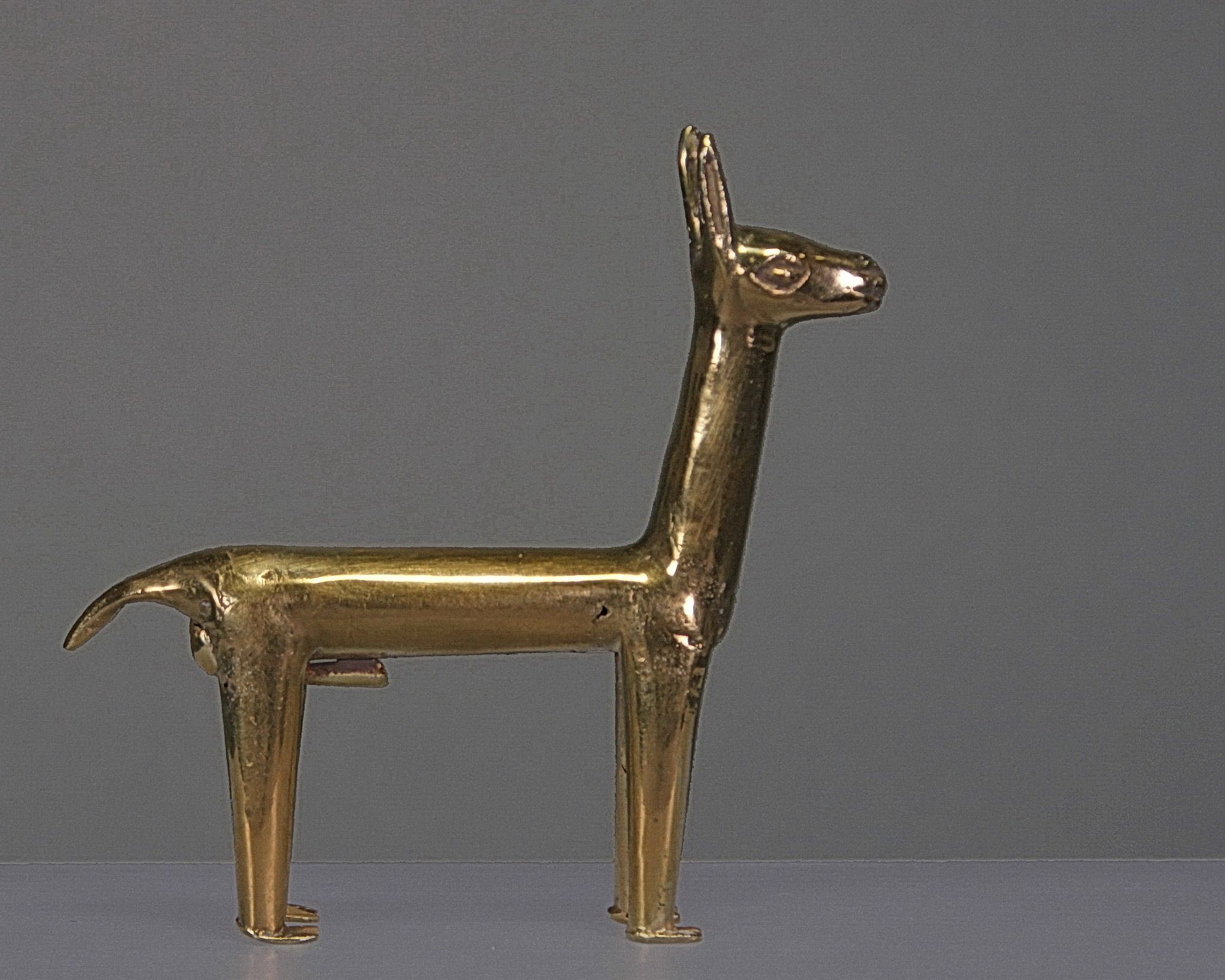




Peru, Inca Gold Hollow Llama
These Llamas, along with other miniatures in gold, silver and spondylus were found at high altitude sacrificial burials sites, used in a ceremony known as the Capac Hucha ceremony to praise the Inca. A similar llama is illustrated in ANCIENT AMERICANS, Art From Sacred Landscapes p. 362. This hollow llama was assembled from hammered gold sheets which were soldered together. One seam can be easily seen along the underside. Ex. New York collector, prior to 1970.
Period: Peru, Inca, Early Phase, South Highlands, c. AD 650 - 1250
Media: Metal
Dimensions: Height: 2.5" Weight: grams 9.6
XRF: Au. 66.4%, Ag. 24.6% , Cu8.8%
Price Upon Request
n7053
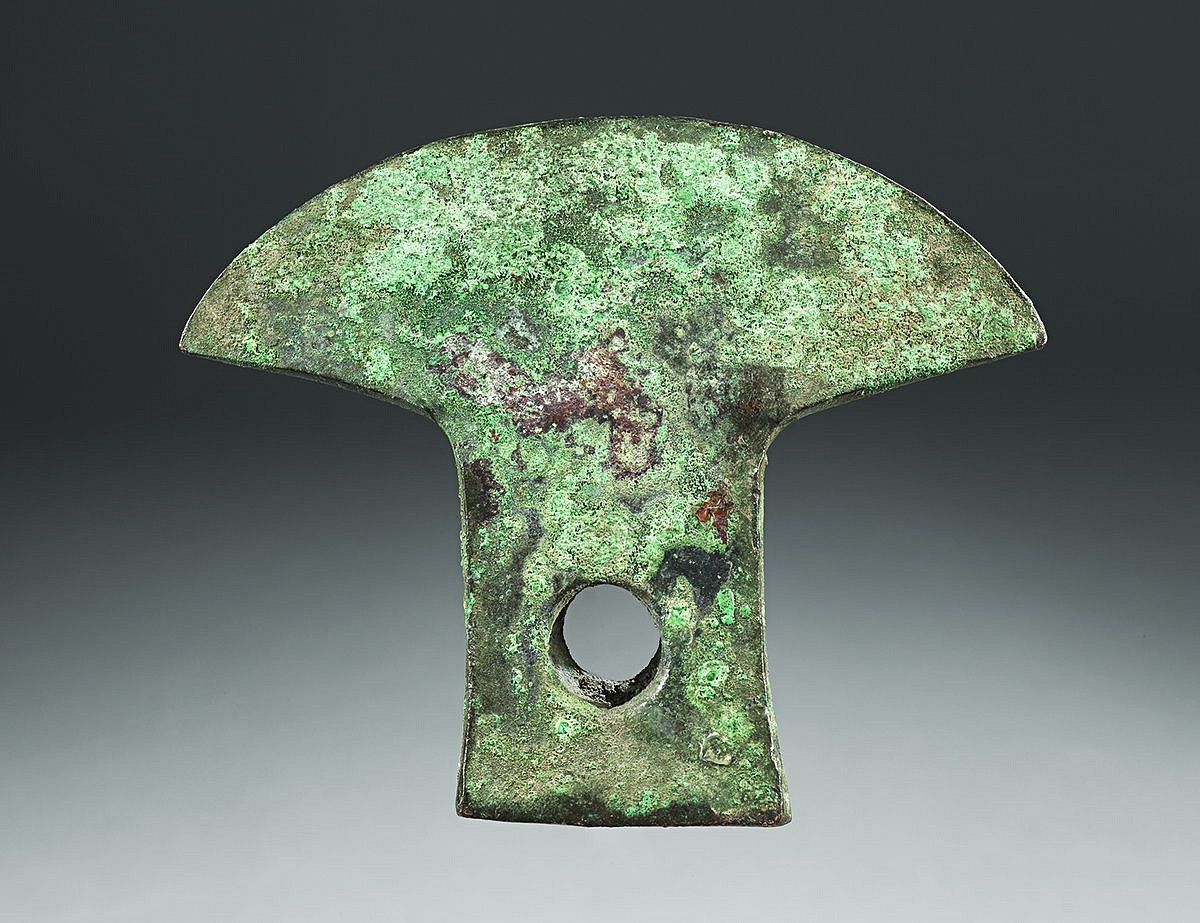


Peru, Inca Large Bronze Axe with Curved Blade
This blade exhibits classic Inca style, which employed crisp, clean, artistic lines, even for simple tools. It has a cast hole for attachment to the side of a shaft which it would have been lashed to. These axes were forged from tin bronze, the official metal of the Inca realm, in a process called slush casting. Molten bronze was poured into open molds. For more examples of lunate axes see Carcedo de Mufarech (1999: figs. 164 and 165).
Technical Features
The blade was annealed after casting to sharpen the cutting edge.
Period: Peru, Inca, North Coast, c. AD 1350 - 500
Media: Metal
Dimensions: Height 5" x Width: 5.75
XRF Data
Base: Ag 0.100 ,As 1.530 Cd 0.01, Cu 96.270, Mn 0.020, Ni 0.010, Pb 0.010, Sb 0.110, Se 0.100, Zn 0.01.
$1,200
MM228B
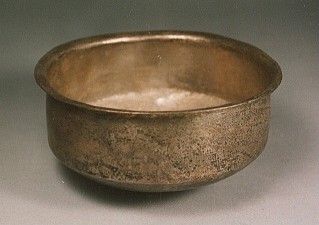
Peru, Inca Silver Bowl
An unusually high walled dish with flared edges, hammered from a single ingot of silver. It was repeatedly annealed and hammered to create a well-proportioned vessel.
Period: Peru, Inca, North Coast, c. AD 1350 - 500
Media: Metal
Dimensions: Diameter of bowl: 5 1/4 in., Height of flask:
$1,200
89400
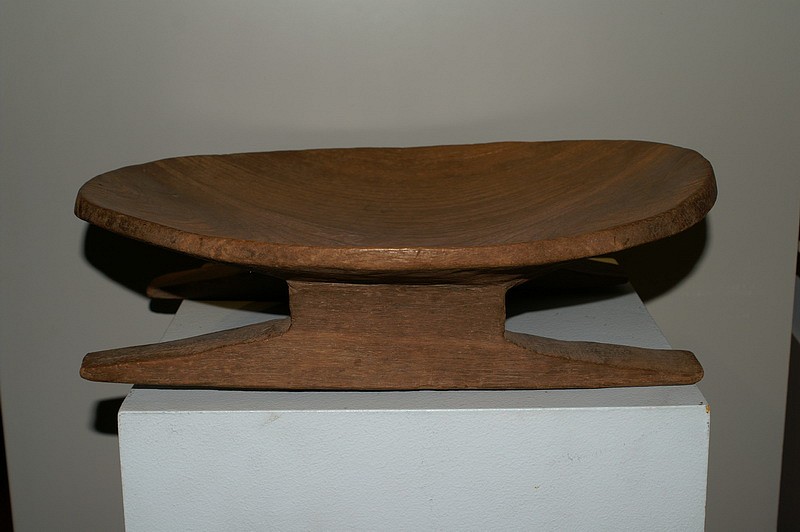





Peru, Inca Tiana Carved Wooden Seat
Tianas were originally made from a single block of wood during Inca times (1250-1500AD). These wooden seats and other specified goods were limited for use by the Inca class. Tianas continued to be used well after the Spanish conquest. A well known Tiana survives in the Berlin Museum.
Period: Peru, Inca, South Coast, circa AD1200 -1532
Media: Wood
Dimensions: Length 14' x Width 11" x Height 4"
$8,000
M7012
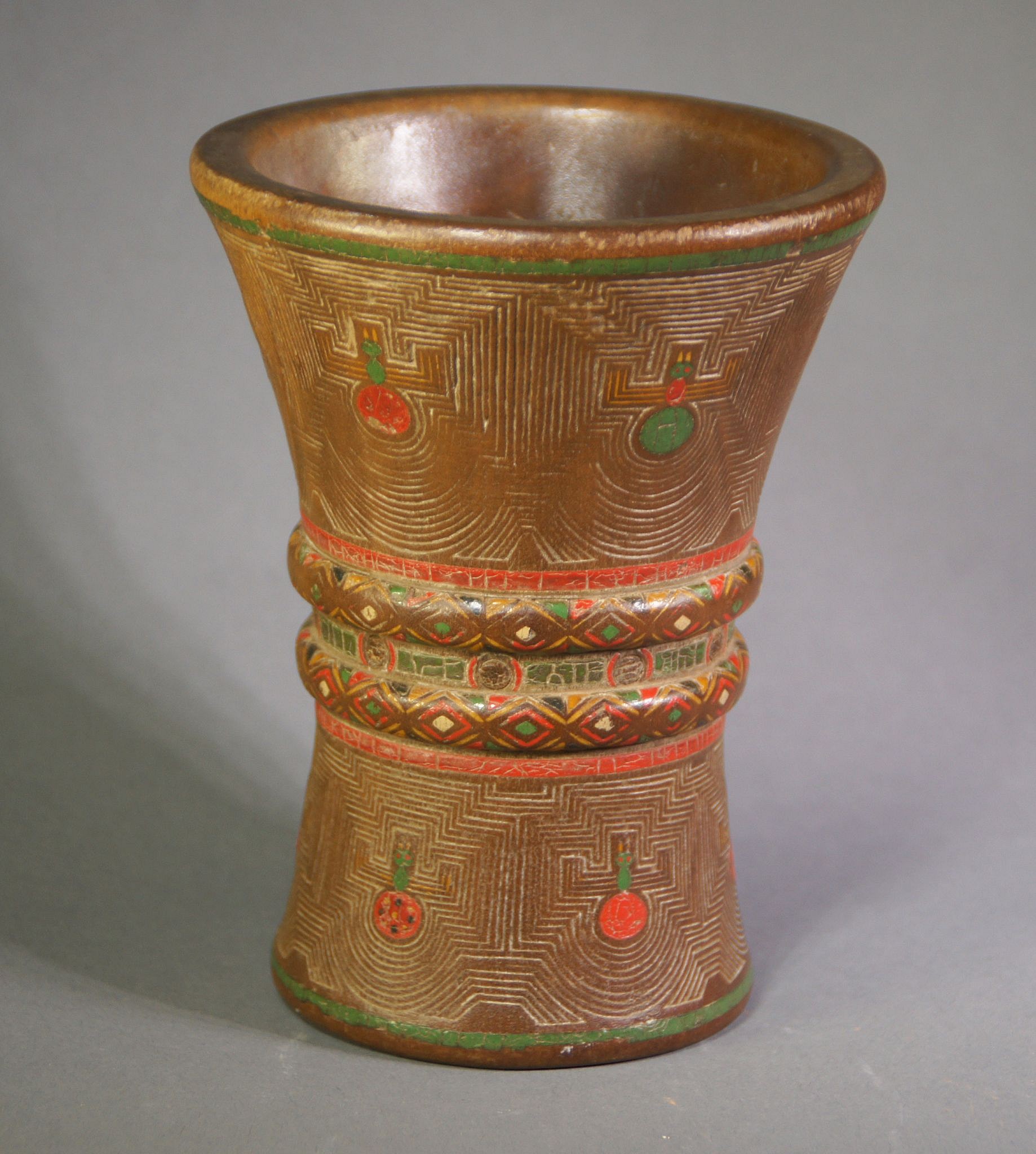




Peru, Inca Wood Polychrome Kero Incised with Spider and Geometric Designs
This kero is an extremely fine example of incising technique. The overall surface is incredibly intricate. The incision lines mimic the natural geometry imposed by the repeated motif of an abstract spider moving vertically on the upper and lower portions of the vase. The creature's body is highlighted with red, yellow and green paint. The central band is accented with patterned bands of diamonds and circles and squares in red, yellow, green, black and white. The rim and base are accented with simple green bands. Such great attention to linear detail and mastery of the incising technique suggests that this is an earlier kero (possibly 16th century). Examples illustrating the incising technique can be seen on p.54 of 'QEROS: Arte Inka en Vasos Ceremoniales', by Jorge Flores Ochoa. This book is part of the Coleccion Arte Y Tesoros Del Peru.
Period: Peru, Inka, Colonial Period, 1600-1800AD
Media: Wood
Dimensions: Height: 5 1/4"
$12,500
MM110
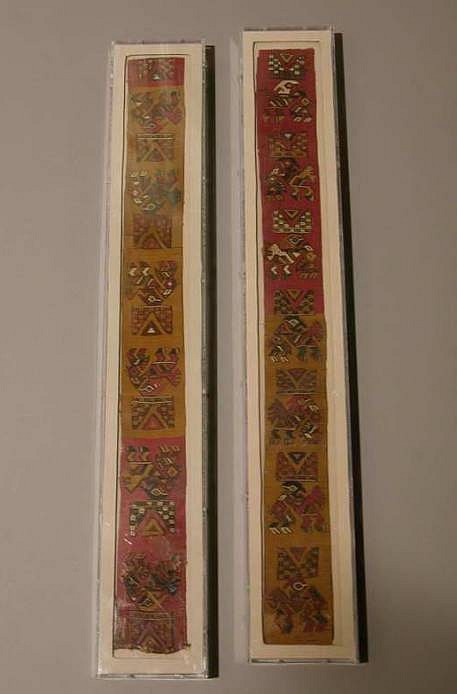




Peru, Inca/Ica Tapestry Borders to a Tunic depicting creatures in profile holding a bird
A very finely woven tapestry work in alternating color arrangements on tan and red grounds. The creature is wearing an upside down tunic on his head with a early Inca motif of checkerboard pattern. Color is used to create hidden images.
Period: Peru, Ica/Chincha, Moquega Valley, South Coast, circa AD1000-1450
Media: Textile
Dimensions: Length 24 1/2" x Width 3 1/4" framed / 23" x 2 1/4" unmounted
$4,850
M3136
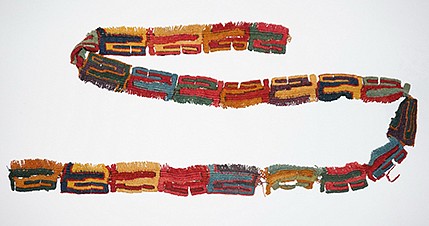





Peru, Knotted Textile Fringe with Colorful Abstract Motif
This knotted fringe is distinguished by its brilliant colors and abstract "z" motif repeated along the band. It was not woven on a loom but instead was created by a method referred to as "tubular looping." Looping is a single-element technique in which the free end and full length of the yarn are pulled through previous work at the edge of the fabric to form each new loop. Looping predates the domestication of fiber-bearing plants and animals and the invention of weaving in the Americas and possibly Eurasia. The choice of color combinations creates a vibrating impact.
Period: Peru, Nazca-Early phase, South Coast, circa AD200-400
Media: Textile
Dimensions: Length: 61 inches; Width: 2 inches
$3,000
91105
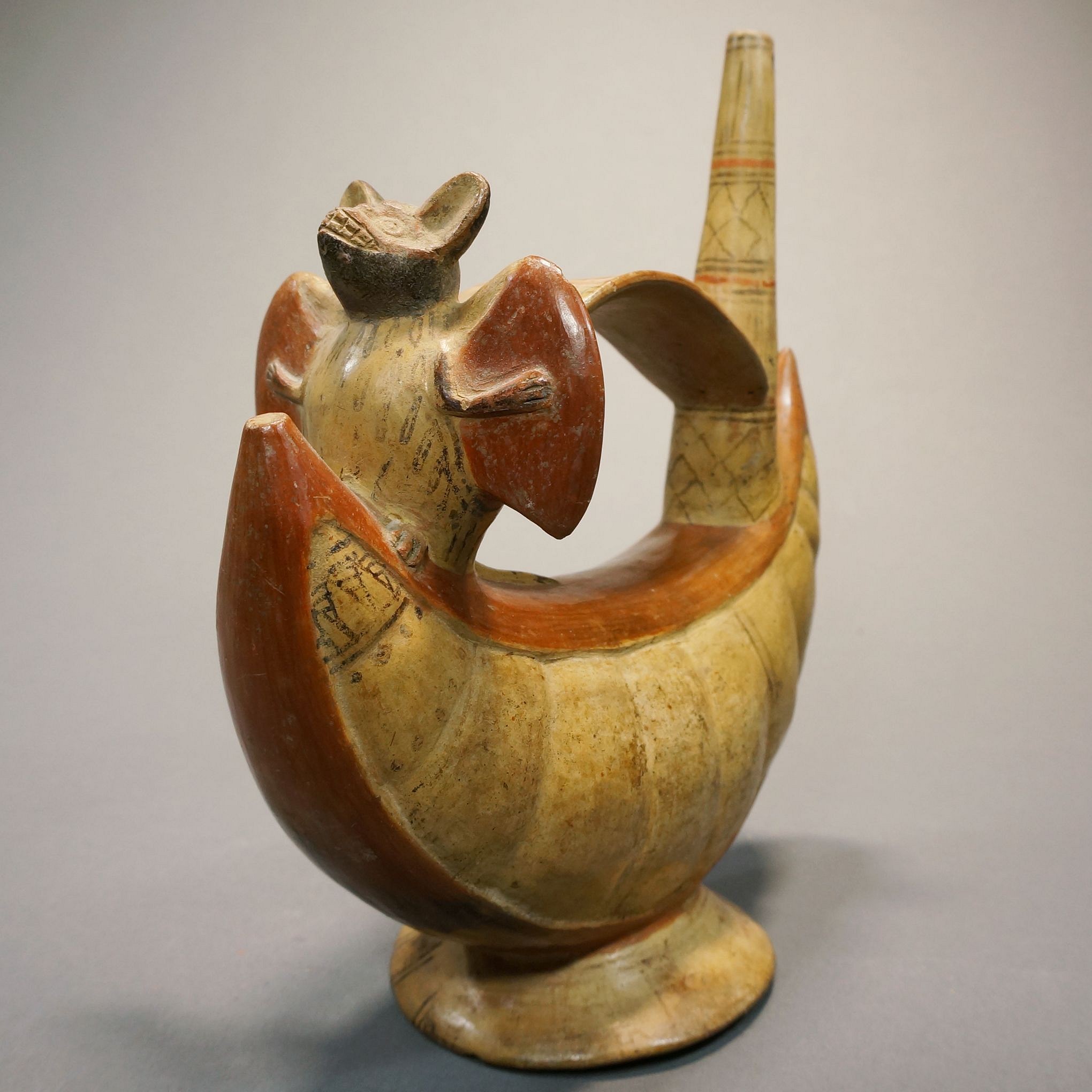
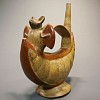
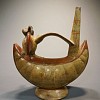
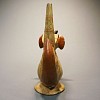
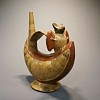
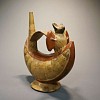
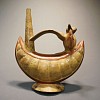
Peru, Lambayeque Whistling Vessel with Bat Atop Pacay Fruit
This ceramic bridge-spout whistling effigy vessel was crafted in the shape of fruit bat resting atop a Pacay. The Pacay fruit, found in the Amazon, is related to mangoes and guavas. Fruit bats have an extremely good sense of smell and sharp teeth with which to open the tough skins of fruits. The whistle built into the vessel, customary for Lambayeque vessels, is seen just behind the bat. Bats are a rare motif and quite meaningful in ancient Andean mythology as they are associated with transport to other worlds. The vessel was painted with orange slip and black octopus ink on a buff ceramic ground. There are only two other known Lambayeque vessels with sculptures of bats, one is illustrated in "Ceramics of Ancient Peru" by Christopher Donnan, 1992, p.89, and the other is the property of The American Museum of Natural History.
Period: Peru, Sican, c. AD 800 - 1100
Media: Ceramic
Dimensions: Height 8" x Length 6 1/2"
Price Upon Request
mm145




Peru, Large fragment to a Wari tunic in Unusual Colors with Abstract Monkey Faces
The fragment consists of two large sections that join, making it almost 60 inches in length. The design is of opposing monkeys in profile. Both profile monkey faces also combine to create a third, larger monkey face in two colors. The monkey’s tail turns into a step fret motif, typical of Wari tunics. The thread count is high, at around 120 per inch. The warps are of cotton and the wefts are of fine alpaca. Cotton warps suggests that the tunic was woven on the coast.
Period: Peru, Wari, South Coast, c. AD 600 - 900
Media: Textile
Dimensions: Overall length is 60" x Width of 20"
Section A Length: 30" x Width: 20"
Section B Length: 30" x Width: 20'
$6,950
n7018
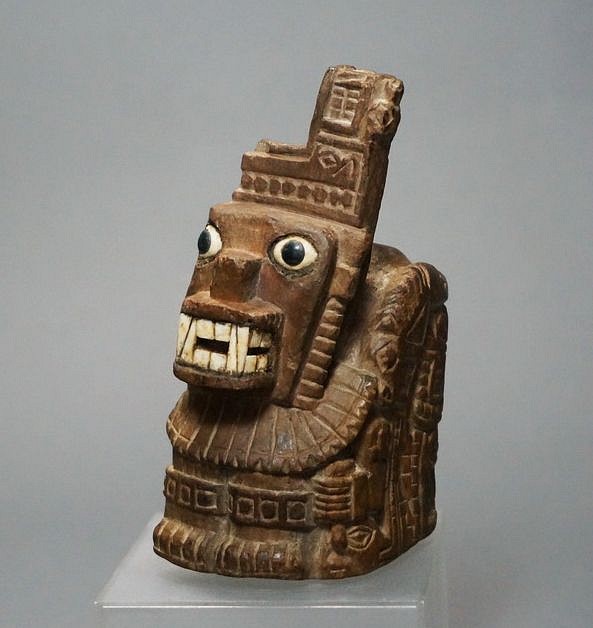




Peru, Large Wari Carved Wood Lime Container Representing a Decapitator
This large wood lime container is carved in the form of a classic Wari decapitator holding a trophy head in his right hand. These containers were used to store lime, which assists the body in metabolizing cocaine alkaloids from ground coca leaves. The opposite side would have had him holding a tumi knife. The decapitator is wearing an elaborate costume with a puma mask and a tapestried tunic with feline profile faces. Below the mask is an elaborate pectoral of trapezoidal plaques. One half of the container is missing, and the inside reveals a storage chamber. The puma is elaborately decorated with classic Tiahuanaco motifs from the Gateway of the Sun. Evidence of inlays in the eye sockets exist. The container portrays a major sculpture in wood for this period. Another lime container in the National Museum of Copenhagen of the same height, 5.75" is illustrated in "Art of Empire, Museum of Primitive Art" - fig. 80.m. There is a chapter in the Peruvian publication Los Dios del Antiguo Peru - Dioses De Pachacamac El Idolo Y el Templo, pages 159-175, which discusses a carved wood idol on a staff. This staff in the book has many elements that are similar to this lime container, specifically the arched serpent and profile face.
Period: Peru, Huari South Highlands/Coast, circa 650-900A.D.
Media: Wood
Dimensions: Height: 4 1/2"
$8,000
97158
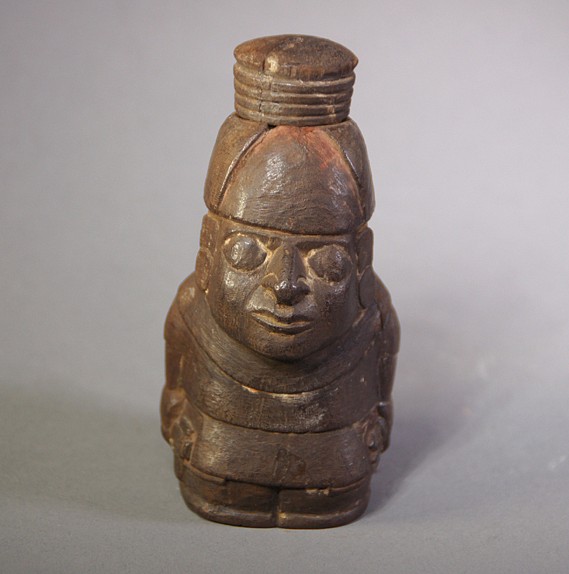




Peru, Large Wari wooden lime container in the form of a seated man
This large Wari wooden lime container is in the form of a kneeling figure carrying an axe in one hand and a group of darts in the other. He wears a circular hat which is also the lid of the container and a pair of earspools.
Period: Peru, Wari South Coast, circa AD650-900
Media: Wood
Dimensions: Height 4 3/4 in.
Price Upon Request
93123
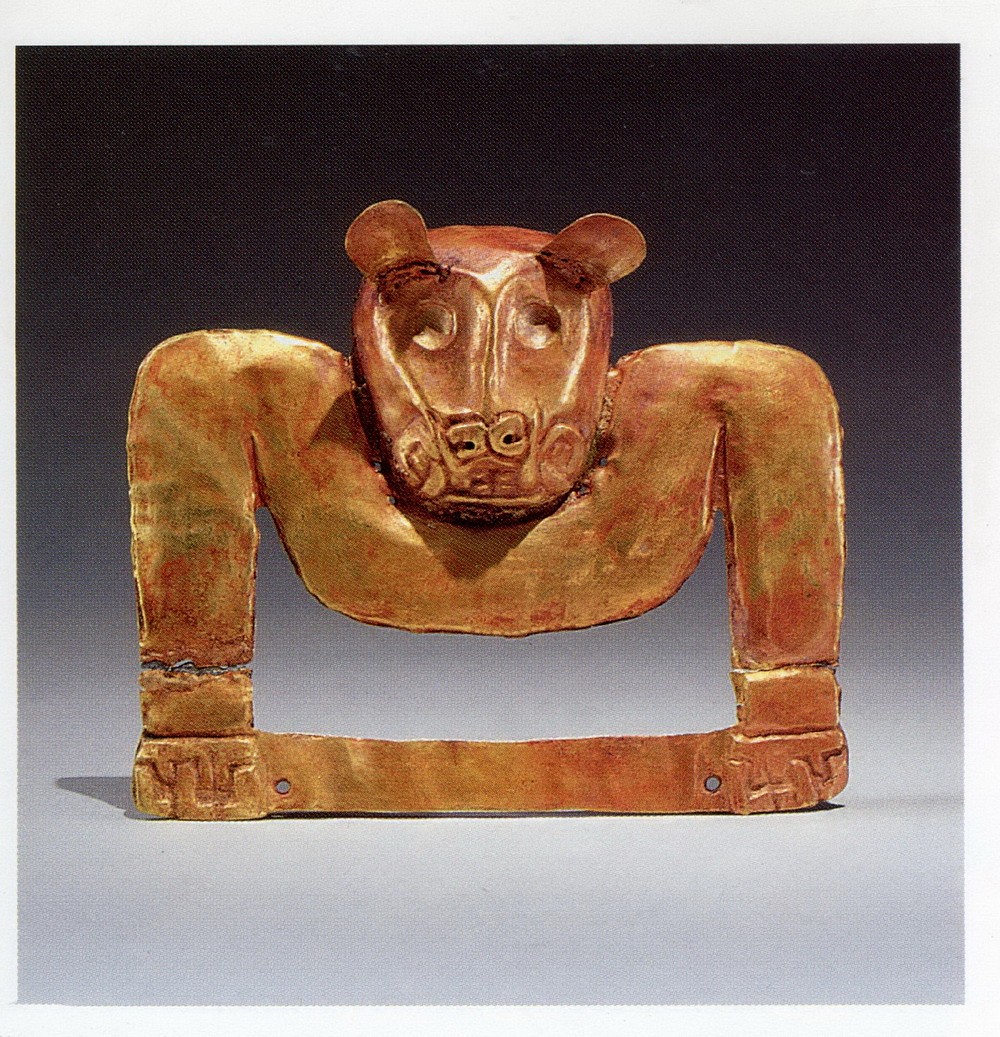



Peru, Late Chavin Hammered and Soldered Gold pendant with a Feline Head
This is a rare Chavin gold work that has been soldered - the ears to the head and the head to the body. There are two sets of suspension holes on each side of the mouth. There are two more suspension holes for danglers by each paw. There is repousse depicting the mouth and nose and on each paw. Estate of Bill Simmons, acquired at Sotheby's Sale # 7996, May 2004, lot 107.
Period: Africa, Cameroon
Media: Metal
Dimensions: Height: 7cm x Width: 8.3cm Wt. 24.3 grams.
XRF Au 85%, Ag 13.3%, Cu 1.08%.
Price Upon Request
n8011
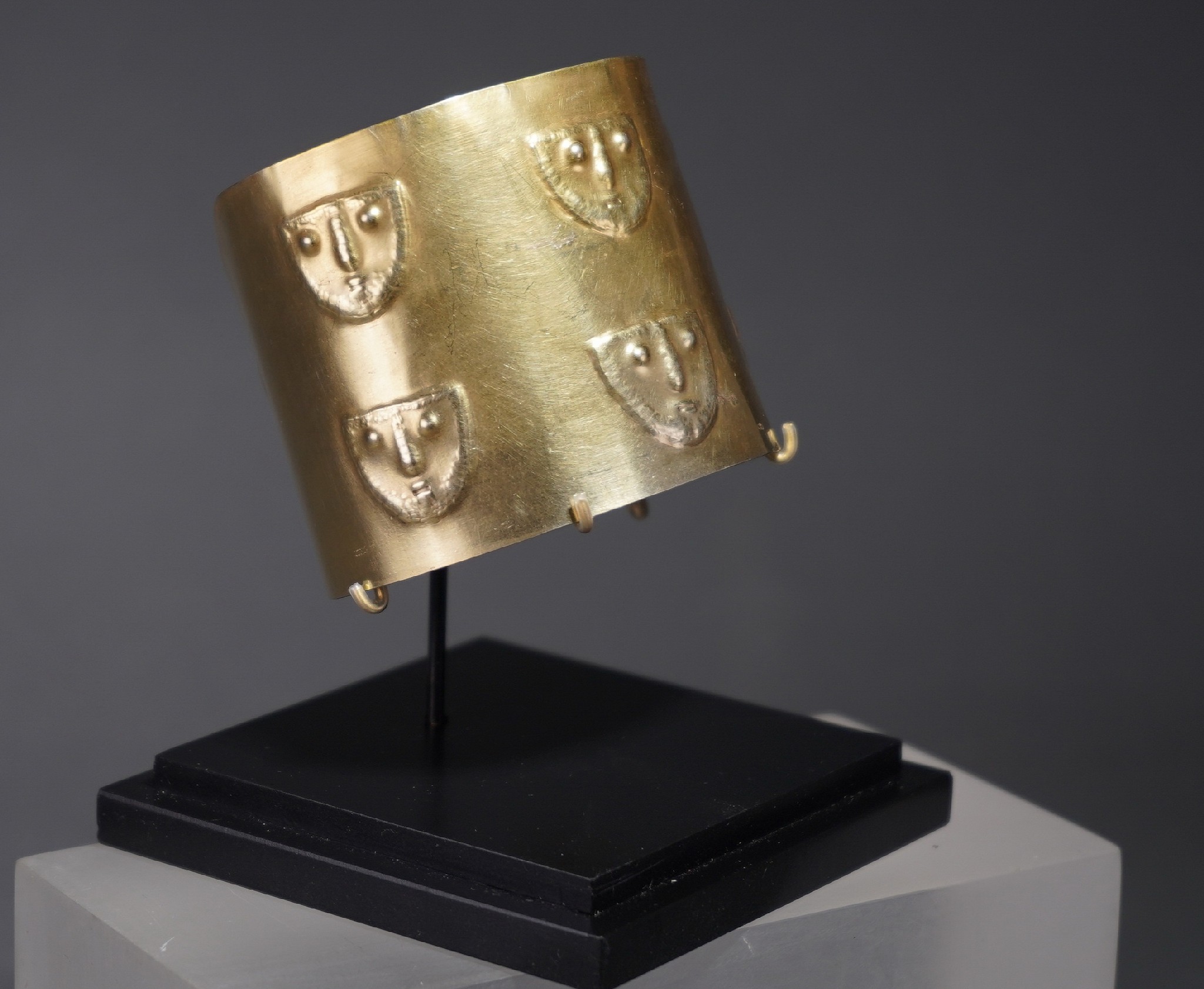





Peru, Late Nasca Gold Cuff with Embossed Faces
A hammered and repousse gold cuff decorated with two rows of faces, probably representing masks. I have not seen many cuffs embossed, as most Late Nasca art consists of simple wrought gold, occasionally with a geometric pattern. These embossed masks are quite rare. There are two tie holes on each edge of the cuff. Similar Nasca gold cuffs are illustrated in the THE GOLD OF PERU, MUJICA GAILLO COLLECTION. Ex-Collection Jean Eugene Lions, St. Tropez, since 1970.
Period: Peru, Nasca, South Coast, c. AD 400 - 800
Media: Metal
Dimensions: Height 2 1/4' Weight 40 grams
Alloy: Au.32.7, Ag. 55.3 & Cu.11.6 = 99.6%
$6,750
M5078
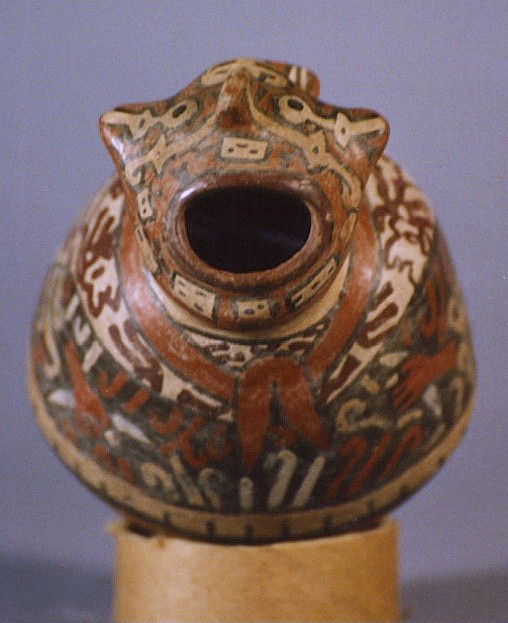







Peru, Late Nazca Ceramic Vessel in the form of a Howling Man
A very delicately modeled and painted miniature vessel of a howling man. The face can be read upside-down as well. Seen from right-side up, the figure appears to be wearing a tunic and cape decorated with abstract heads. From upside-down the tunic turns into a scarf, and the cape becomes the tunic. The face also changes according to the direction the object is seen from. The howling image is associated with decapitation and the trophy head ritual.
Period: Peru, Late Nasca drainage, South Coast, c. AD 600 - 800
Media: Ceramic
Dimensions: Height: 4 1/4"
Price Upon Request
92037













Peru, Late Paracas Needlework Border with Hummingbirds and Cactus Flowers
The border is composed of cross loop needle-knitted hummingbirds sucking the nectar from flowering cacti in alternating color arrangements. There are ten basic colors with additional tones to include blues, grays, greens, gold, pinks, purples, reds, tans and whites. Each bird's head has a long beak, different colored eyes, a slender body, and a wide tail. The cacti are made in five parts, from the upper flower to the lower flower’s broad cactus leaves. The Nasca people are considered to have the most colorful costumes in all antiquity. Their richly colored weavings are often perfectly preserved, having been buried in the driest dessert in the world. Nasca borders and fringes would surround an entire mantle or tunic, which could be many yards in length. The Metropolitan Museum of Art has only two short segments depicting hummingbirds. The Textile Museum in Washington, D.C. has a similar border that is only 21†in length, which is illustrated in EARLY NASCA NEEDLEWORK by Alan Sawyer, image 116. Other early Nasca needle knit birds are in the Met Museum. Formerly in the collection of Justin Kerr, New York, prior to 1970.
Period: Peru, Paracas, South Coast, c. 200 - 100 BC
Media: Textile
Dimensions: Length 40" x Height 3"
Frame dimensions: Length 42" x Height: 9"
Price Upon Request
n7035
![Peru, Late Paracas/Early Nasca Embroidered Section with Four Colorful Monkey Deities in Alternating Colors on a Gold Ground
This textile portrays a series of ecstatic shamans as Animal Impersonators. The main figures, depicted with flying wings, are referred to as monkey deities because they have opposing toes. The bright, abstract color combinations not normally found in nature and the dense shamanic imagery such as double-headed serpents, flint knives, and trophy heads, could easily have been the result of a psychedelic journey. Note: Psychiatrist Oscar Janiger’s studies in the 1950s revealed that that LSD “not only radically changed the [artist’s] style but also gave them new depths to understand the use of color, form, light, or the way these things are viewed in a frame of reference.†(Dobkin/Janiger, 2003, p.80]. The beautifully contrasting colors, and the fluidity of the figure-ground relationship of this Paracas textile connotes a psychedelic influence on the ancient Paracas and Nasca people -possibly that of psilocybin. Shamanic animal transformation in Andean art represents the journey to the afterlife by way of psychic flight.
From top to bottom: The top figure wears a grey puma headdress with Chile peppers, a white nose ornament, and a tunic with a step volute border. Serpents with suspended kidney beans flank him on both sides, and another serpent emanates from his mouth. The second wears a diadem on his forehead, a cloak, and a loin cloth, and is surrounded by three animal heads. He wears a gold mask with a serpent emanating from his mouth and holds a trophy head in one hand and a flint knife in the other. The following figure repeats the compositional structure of the first figure but has a completely different color arrangement. The last figure repeats the structure of the second figure, also in completely different colors. No two figures are the same, and the curvature of the snakes created in alternating colors conveys a sense of motion. Another section from the same textile is in the Israel Museum, Jerusalem. Period: Peru, Paracas-Ocucaje 10, or Nasca 1, South Coast, c. BC 100 - AD 100
Period: Peru, Paracas-Ocucaje 10, or Nasca 1, South Coast, c. BC 100 - AD 100
Media: Textile
Dimensions: Textile, Length: 24" x Width: 2 3/4" Plexiglas frame, Length: 27"x Width: 5 1/2"
Price Upon Request
pp008](/images/16081_h2048w2048gt.5.jpg)
![Peru, Late Paracas/Early Nasca Embroidered Section with Four Colorful Monkey Deities in Alternating Colors on a Gold Ground
This textile portrays a series of ecstatic shamans as Animal Impersonators. The main figures, depicted with flying wings, are referred to as monkey deities because they have opposing toes. The bright, abstract color combinations not normally found in nature and the dense shamanic imagery such as double-headed serpents, flint knives, and trophy heads, could easily have been the result of a psychedelic journey. Note: Psychiatrist Oscar Janiger’s studies in the 1950s revealed that that LSD “not only radically changed the [artist’s] style but also gave them new depths to understand the use of color, form, light, or the way these things are viewed in a frame of reference.†(Dobkin/Janiger, 2003, p.80]. The beautifully contrasting colors, and the fluidity of the figure-ground relationship of this Paracas textile connotes a psychedelic influence on the ancient Paracas and Nasca people -possibly that of psilocybin. Shamanic animal transformation in Andean art represents the journey to the afterlife by way of psychic flight.
From top to bottom: The top figure wears a grey puma headdress with Chile peppers, a white nose ornament, and a tunic with a step volute border. Serpents with suspended kidney beans flank him on both sides, and another serpent emanates from his mouth. The second wears a diadem on his forehead, a cloak, and a loin cloth, and is surrounded by three animal heads. He wears a gold mask with a serpent emanating from his mouth and holds a trophy head in one hand and a flint knife in the other. The following figure repeats the compositional structure of the first figure but has a completely different color arrangement. The last figure repeats the structure of the second figure, also in completely different colors. No two figures are the same, and the curvature of the snakes created in alternating colors conveys a sense of motion. Another section from the same textile is in the Israel Museum, Jerusalem. Period: Peru, Paracas-Ocucaje 10, or Nasca 1, South Coast, c. BC 100 - AD 100
Period: Peru, Paracas-Ocucaje 10, or Nasca 1, South Coast, c. BC 100 - AD 100
Media: Textile
Dimensions: Textile, Length: 24" x Width: 2 3/4" Plexiglas frame, Length: 27"x Width: 5 1/2"
Price Upon Request
pp008](/images/16081_h100w100gt.5.jpg)
![Peru, Late Paracas/Early Nasca Embroidered Section with Four Colorful Monkey Deities in Alternating Colors on a Gold Ground
This textile portrays a series of ecstatic shamans as Animal Impersonators. The main figures, depicted with flying wings, are referred to as monkey deities because they have opposing toes. The bright, abstract color combinations not normally found in nature and the dense shamanic imagery such as double-headed serpents, flint knives, and trophy heads, could easily have been the result of a psychedelic journey. Note: Psychiatrist Oscar Janiger’s studies in the 1950s revealed that that LSD “not only radically changed the [artist’s] style but also gave them new depths to understand the use of color, form, light, or the way these things are viewed in a frame of reference.†(Dobkin/Janiger, 2003, p.80]. The beautifully contrasting colors, and the fluidity of the figure-ground relationship of this Paracas textile connotes a psychedelic influence on the ancient Paracas and Nasca people -possibly that of psilocybin. Shamanic animal transformation in Andean art represents the journey to the afterlife by way of psychic flight.
From top to bottom: The top figure wears a grey puma headdress with Chile peppers, a white nose ornament, and a tunic with a step volute border. Serpents with suspended kidney beans flank him on both sides, and another serpent emanates from his mouth. The second wears a diadem on his forehead, a cloak, and a loin cloth, and is surrounded by three animal heads. He wears a gold mask with a serpent emanating from his mouth and holds a trophy head in one hand and a flint knife in the other. The following figure repeats the compositional structure of the first figure but has a completely different color arrangement. The last figure repeats the structure of the second figure, also in completely different colors. No two figures are the same, and the curvature of the snakes created in alternating colors conveys a sense of motion. Another section from the same textile is in the Israel Museum, Jerusalem. Period: Peru, Paracas-Ocucaje 10, or Nasca 1, South Coast, c. BC 100 - AD 100
Period: Peru, Paracas-Ocucaje 10, or Nasca 1, South Coast, c. BC 100 - AD 100
Media: Textile
Dimensions: Textile, Length: 24" x Width: 2 3/4" Plexiglas frame, Length: 27"x Width: 5 1/2"
Price Upon Request
pp008](/images/16082_h100w100gt.5.jpg)
![Peru, Late Paracas/Early Nasca Embroidered Section with Four Colorful Monkey Deities in Alternating Colors on a Gold Ground
This textile portrays a series of ecstatic shamans as Animal Impersonators. The main figures, depicted with flying wings, are referred to as monkey deities because they have opposing toes. The bright, abstract color combinations not normally found in nature and the dense shamanic imagery such as double-headed serpents, flint knives, and trophy heads, could easily have been the result of a psychedelic journey. Note: Psychiatrist Oscar Janiger’s studies in the 1950s revealed that that LSD “not only radically changed the [artist’s] style but also gave them new depths to understand the use of color, form, light, or the way these things are viewed in a frame of reference.†(Dobkin/Janiger, 2003, p.80]. The beautifully contrasting colors, and the fluidity of the figure-ground relationship of this Paracas textile connotes a psychedelic influence on the ancient Paracas and Nasca people -possibly that of psilocybin. Shamanic animal transformation in Andean art represents the journey to the afterlife by way of psychic flight.
From top to bottom: The top figure wears a grey puma headdress with Chile peppers, a white nose ornament, and a tunic with a step volute border. Serpents with suspended kidney beans flank him on both sides, and another serpent emanates from his mouth. The second wears a diadem on his forehead, a cloak, and a loin cloth, and is surrounded by three animal heads. He wears a gold mask with a serpent emanating from his mouth and holds a trophy head in one hand and a flint knife in the other. The following figure repeats the compositional structure of the first figure but has a completely different color arrangement. The last figure repeats the structure of the second figure, also in completely different colors. No two figures are the same, and the curvature of the snakes created in alternating colors conveys a sense of motion. Another section from the same textile is in the Israel Museum, Jerusalem. Period: Peru, Paracas-Ocucaje 10, or Nasca 1, South Coast, c. BC 100 - AD 100
Period: Peru, Paracas-Ocucaje 10, or Nasca 1, South Coast, c. BC 100 - AD 100
Media: Textile
Dimensions: Textile, Length: 24" x Width: 2 3/4" Plexiglas frame, Length: 27"x Width: 5 1/2"
Price Upon Request
pp008](/images/16085_h100w100gt.5.jpg)
![Peru, Late Paracas/Early Nasca Embroidered Section with Four Colorful Monkey Deities in Alternating Colors on a Gold Ground
This textile portrays a series of ecstatic shamans as Animal Impersonators. The main figures, depicted with flying wings, are referred to as monkey deities because they have opposing toes. The bright, abstract color combinations not normally found in nature and the dense shamanic imagery such as double-headed serpents, flint knives, and trophy heads, could easily have been the result of a psychedelic journey. Note: Psychiatrist Oscar Janiger’s studies in the 1950s revealed that that LSD “not only radically changed the [artist’s] style but also gave them new depths to understand the use of color, form, light, or the way these things are viewed in a frame of reference.†(Dobkin/Janiger, 2003, p.80]. The beautifully contrasting colors, and the fluidity of the figure-ground relationship of this Paracas textile connotes a psychedelic influence on the ancient Paracas and Nasca people -possibly that of psilocybin. Shamanic animal transformation in Andean art represents the journey to the afterlife by way of psychic flight.
From top to bottom: The top figure wears a grey puma headdress with Chile peppers, a white nose ornament, and a tunic with a step volute border. Serpents with suspended kidney beans flank him on both sides, and another serpent emanates from his mouth. The second wears a diadem on his forehead, a cloak, and a loin cloth, and is surrounded by three animal heads. He wears a gold mask with a serpent emanating from his mouth and holds a trophy head in one hand and a flint knife in the other. The following figure repeats the compositional structure of the first figure but has a completely different color arrangement. The last figure repeats the structure of the second figure, also in completely different colors. No two figures are the same, and the curvature of the snakes created in alternating colors conveys a sense of motion. Another section from the same textile is in the Israel Museum, Jerusalem. Period: Peru, Paracas-Ocucaje 10, or Nasca 1, South Coast, c. BC 100 - AD 100
Period: Peru, Paracas-Ocucaje 10, or Nasca 1, South Coast, c. BC 100 - AD 100
Media: Textile
Dimensions: Textile, Length: 24" x Width: 2 3/4" Plexiglas frame, Length: 27"x Width: 5 1/2"
Price Upon Request
pp008](/images/15195_h100w100gt.5.jpg)
![Peru, Late Paracas/Early Nasca Embroidered Section with Four Colorful Monkey Deities in Alternating Colors on a Gold Ground
This textile portrays a series of ecstatic shamans as Animal Impersonators. The main figures, depicted with flying wings, are referred to as monkey deities because they have opposing toes. The bright, abstract color combinations not normally found in nature and the dense shamanic imagery such as double-headed serpents, flint knives, and trophy heads, could easily have been the result of a psychedelic journey. Note: Psychiatrist Oscar Janiger’s studies in the 1950s revealed that that LSD “not only radically changed the [artist’s] style but also gave them new depths to understand the use of color, form, light, or the way these things are viewed in a frame of reference.†(Dobkin/Janiger, 2003, p.80]. The beautifully contrasting colors, and the fluidity of the figure-ground relationship of this Paracas textile connotes a psychedelic influence on the ancient Paracas and Nasca people -possibly that of psilocybin. Shamanic animal transformation in Andean art represents the journey to the afterlife by way of psychic flight.
From top to bottom: The top figure wears a grey puma headdress with Chile peppers, a white nose ornament, and a tunic with a step volute border. Serpents with suspended kidney beans flank him on both sides, and another serpent emanates from his mouth. The second wears a diadem on his forehead, a cloak, and a loin cloth, and is surrounded by three animal heads. He wears a gold mask with a serpent emanating from his mouth and holds a trophy head in one hand and a flint knife in the other. The following figure repeats the compositional structure of the first figure but has a completely different color arrangement. The last figure repeats the structure of the second figure, also in completely different colors. No two figures are the same, and the curvature of the snakes created in alternating colors conveys a sense of motion. Another section from the same textile is in the Israel Museum, Jerusalem. Period: Peru, Paracas-Ocucaje 10, or Nasca 1, South Coast, c. BC 100 - AD 100
Period: Peru, Paracas-Ocucaje 10, or Nasca 1, South Coast, c. BC 100 - AD 100
Media: Textile
Dimensions: Textile, Length: 24" x Width: 2 3/4" Plexiglas frame, Length: 27"x Width: 5 1/2"
Price Upon Request
pp008](/images/15197_h100w100gt.5.jpg)
![Peru, Late Paracas/Early Nasca Embroidered Section with Four Colorful Monkey Deities in Alternating Colors on a Gold Ground
This textile portrays a series of ecstatic shamans as Animal Impersonators. The main figures, depicted with flying wings, are referred to as monkey deities because they have opposing toes. The bright, abstract color combinations not normally found in nature and the dense shamanic imagery such as double-headed serpents, flint knives, and trophy heads, could easily have been the result of a psychedelic journey. Note: Psychiatrist Oscar Janiger’s studies in the 1950s revealed that that LSD “not only radically changed the [artist’s] style but also gave them new depths to understand the use of color, form, light, or the way these things are viewed in a frame of reference.†(Dobkin/Janiger, 2003, p.80]. The beautifully contrasting colors, and the fluidity of the figure-ground relationship of this Paracas textile connotes a psychedelic influence on the ancient Paracas and Nasca people -possibly that of psilocybin. Shamanic animal transformation in Andean art represents the journey to the afterlife by way of psychic flight.
From top to bottom: The top figure wears a grey puma headdress with Chile peppers, a white nose ornament, and a tunic with a step volute border. Serpents with suspended kidney beans flank him on both sides, and another serpent emanates from his mouth. The second wears a diadem on his forehead, a cloak, and a loin cloth, and is surrounded by three animal heads. He wears a gold mask with a serpent emanating from his mouth and holds a trophy head in one hand and a flint knife in the other. The following figure repeats the compositional structure of the first figure but has a completely different color arrangement. The last figure repeats the structure of the second figure, also in completely different colors. No two figures are the same, and the curvature of the snakes created in alternating colors conveys a sense of motion. Another section from the same textile is in the Israel Museum, Jerusalem. Period: Peru, Paracas-Ocucaje 10, or Nasca 1, South Coast, c. BC 100 - AD 100
Period: Peru, Paracas-Ocucaje 10, or Nasca 1, South Coast, c. BC 100 - AD 100
Media: Textile
Dimensions: Textile, Length: 24" x Width: 2 3/4" Plexiglas frame, Length: 27"x Width: 5 1/2"
Price Upon Request
pp008](/images/16084_h100w100gt.5.jpg)
![Peru, Late Paracas/Early Nasca Embroidered Section with Four Colorful Monkey Deities in Alternating Colors on a Gold Ground
This textile portrays a series of ecstatic shamans as Animal Impersonators. The main figures, depicted with flying wings, are referred to as monkey deities because they have opposing toes. The bright, abstract color combinations not normally found in nature and the dense shamanic imagery such as double-headed serpents, flint knives, and trophy heads, could easily have been the result of a psychedelic journey. Note: Psychiatrist Oscar Janiger’s studies in the 1950s revealed that that LSD “not only radically changed the [artist’s] style but also gave them new depths to understand the use of color, form, light, or the way these things are viewed in a frame of reference.†(Dobkin/Janiger, 2003, p.80]. The beautifully contrasting colors, and the fluidity of the figure-ground relationship of this Paracas textile connotes a psychedelic influence on the ancient Paracas and Nasca people -possibly that of psilocybin. Shamanic animal transformation in Andean art represents the journey to the afterlife by way of psychic flight.
From top to bottom: The top figure wears a grey puma headdress with Chile peppers, a white nose ornament, and a tunic with a step volute border. Serpents with suspended kidney beans flank him on both sides, and another serpent emanates from his mouth. The second wears a diadem on his forehead, a cloak, and a loin cloth, and is surrounded by three animal heads. He wears a gold mask with a serpent emanating from his mouth and holds a trophy head in one hand and a flint knife in the other. The following figure repeats the compositional structure of the first figure but has a completely different color arrangement. The last figure repeats the structure of the second figure, also in completely different colors. No two figures are the same, and the curvature of the snakes created in alternating colors conveys a sense of motion. Another section from the same textile is in the Israel Museum, Jerusalem. Period: Peru, Paracas-Ocucaje 10, or Nasca 1, South Coast, c. BC 100 - AD 100
Period: Peru, Paracas-Ocucaje 10, or Nasca 1, South Coast, c. BC 100 - AD 100
Media: Textile
Dimensions: Textile, Length: 24" x Width: 2 3/4" Plexiglas frame, Length: 27"x Width: 5 1/2"
Price Upon Request
pp008](/images/15198_h100w100gt.5.jpg)
![Peru, Late Paracas/Early Nasca Embroidered Section with Four Colorful Monkey Deities in Alternating Colors on a Gold Ground
This textile portrays a series of ecstatic shamans as Animal Impersonators. The main figures, depicted with flying wings, are referred to as monkey deities because they have opposing toes. The bright, abstract color combinations not normally found in nature and the dense shamanic imagery such as double-headed serpents, flint knives, and trophy heads, could easily have been the result of a psychedelic journey. Note: Psychiatrist Oscar Janiger’s studies in the 1950s revealed that that LSD “not only radically changed the [artist’s] style but also gave them new depths to understand the use of color, form, light, or the way these things are viewed in a frame of reference.†(Dobkin/Janiger, 2003, p.80]. The beautifully contrasting colors, and the fluidity of the figure-ground relationship of this Paracas textile connotes a psychedelic influence on the ancient Paracas and Nasca people -possibly that of psilocybin. Shamanic animal transformation in Andean art represents the journey to the afterlife by way of psychic flight.
From top to bottom: The top figure wears a grey puma headdress with Chile peppers, a white nose ornament, and a tunic with a step volute border. Serpents with suspended kidney beans flank him on both sides, and another serpent emanates from his mouth. The second wears a diadem on his forehead, a cloak, and a loin cloth, and is surrounded by three animal heads. He wears a gold mask with a serpent emanating from his mouth and holds a trophy head in one hand and a flint knife in the other. The following figure repeats the compositional structure of the first figure but has a completely different color arrangement. The last figure repeats the structure of the second figure, also in completely different colors. No two figures are the same, and the curvature of the snakes created in alternating colors conveys a sense of motion. Another section from the same textile is in the Israel Museum, Jerusalem. Period: Peru, Paracas-Ocucaje 10, or Nasca 1, South Coast, c. BC 100 - AD 100
Period: Peru, Paracas-Ocucaje 10, or Nasca 1, South Coast, c. BC 100 - AD 100
Media: Textile
Dimensions: Textile, Length: 24" x Width: 2 3/4" Plexiglas frame, Length: 27"x Width: 5 1/2"
Price Upon Request
pp008](/images/16086_h100w100gt.5.jpg)
![Peru, Late Paracas/Early Nasca Embroidered Section with Four Colorful Monkey Deities in Alternating Colors on a Gold Ground
This textile portrays a series of ecstatic shamans as Animal Impersonators. The main figures, depicted with flying wings, are referred to as monkey deities because they have opposing toes. The bright, abstract color combinations not normally found in nature and the dense shamanic imagery such as double-headed serpents, flint knives, and trophy heads, could easily have been the result of a psychedelic journey. Note: Psychiatrist Oscar Janiger’s studies in the 1950s revealed that that LSD “not only radically changed the [artist’s] style but also gave them new depths to understand the use of color, form, light, or the way these things are viewed in a frame of reference.†(Dobkin/Janiger, 2003, p.80]. The beautifully contrasting colors, and the fluidity of the figure-ground relationship of this Paracas textile connotes a psychedelic influence on the ancient Paracas and Nasca people -possibly that of psilocybin. Shamanic animal transformation in Andean art represents the journey to the afterlife by way of psychic flight.
From top to bottom: The top figure wears a grey puma headdress with Chile peppers, a white nose ornament, and a tunic with a step volute border. Serpents with suspended kidney beans flank him on both sides, and another serpent emanates from his mouth. The second wears a diadem on his forehead, a cloak, and a loin cloth, and is surrounded by three animal heads. He wears a gold mask with a serpent emanating from his mouth and holds a trophy head in one hand and a flint knife in the other. The following figure repeats the compositional structure of the first figure but has a completely different color arrangement. The last figure repeats the structure of the second figure, also in completely different colors. No two figures are the same, and the curvature of the snakes created in alternating colors conveys a sense of motion. Another section from the same textile is in the Israel Museum, Jerusalem. Period: Peru, Paracas-Ocucaje 10, or Nasca 1, South Coast, c. BC 100 - AD 100
Period: Peru, Paracas-Ocucaje 10, or Nasca 1, South Coast, c. BC 100 - AD 100
Media: Textile
Dimensions: Textile, Length: 24" x Width: 2 3/4" Plexiglas frame, Length: 27"x Width: 5 1/2"
Price Upon Request
pp008](/images/15200_h100w100gt.5.jpg)
![Peru, Late Paracas/Early Nasca Embroidered Section with Four Colorful Monkey Deities in Alternating Colors on a Gold Ground
This textile portrays a series of ecstatic shamans as Animal Impersonators. The main figures, depicted with flying wings, are referred to as monkey deities because they have opposing toes. The bright, abstract color combinations not normally found in nature and the dense shamanic imagery such as double-headed serpents, flint knives, and trophy heads, could easily have been the result of a psychedelic journey. Note: Psychiatrist Oscar Janiger’s studies in the 1950s revealed that that LSD “not only radically changed the [artist’s] style but also gave them new depths to understand the use of color, form, light, or the way these things are viewed in a frame of reference.†(Dobkin/Janiger, 2003, p.80]. The beautifully contrasting colors, and the fluidity of the figure-ground relationship of this Paracas textile connotes a psychedelic influence on the ancient Paracas and Nasca people -possibly that of psilocybin. Shamanic animal transformation in Andean art represents the journey to the afterlife by way of psychic flight.
From top to bottom: The top figure wears a grey puma headdress with Chile peppers, a white nose ornament, and a tunic with a step volute border. Serpents with suspended kidney beans flank him on both sides, and another serpent emanates from his mouth. The second wears a diadem on his forehead, a cloak, and a loin cloth, and is surrounded by three animal heads. He wears a gold mask with a serpent emanating from his mouth and holds a trophy head in one hand and a flint knife in the other. The following figure repeats the compositional structure of the first figure but has a completely different color arrangement. The last figure repeats the structure of the second figure, also in completely different colors. No two figures are the same, and the curvature of the snakes created in alternating colors conveys a sense of motion. Another section from the same textile is in the Israel Museum, Jerusalem. Period: Peru, Paracas-Ocucaje 10, or Nasca 1, South Coast, c. BC 100 - AD 100
Period: Peru, Paracas-Ocucaje 10, or Nasca 1, South Coast, c. BC 100 - AD 100
Media: Textile
Dimensions: Textile, Length: 24" x Width: 2 3/4" Plexiglas frame, Length: 27"x Width: 5 1/2"
Price Upon Request
pp008](/images/15199_h100w100gt.5.jpg)
![Peru, Late Paracas/Early Nasca Embroidered Section with Four Colorful Monkey Deities in Alternating Colors on a Gold Ground
This textile portrays a series of ecstatic shamans as Animal Impersonators. The main figures, depicted with flying wings, are referred to as monkey deities because they have opposing toes. The bright, abstract color combinations not normally found in nature and the dense shamanic imagery such as double-headed serpents, flint knives, and trophy heads, could easily have been the result of a psychedelic journey. Note: Psychiatrist Oscar Janiger’s studies in the 1950s revealed that that LSD “not only radically changed the [artist’s] style but also gave them new depths to understand the use of color, form, light, or the way these things are viewed in a frame of reference.†(Dobkin/Janiger, 2003, p.80]. The beautifully contrasting colors, and the fluidity of the figure-ground relationship of this Paracas textile connotes a psychedelic influence on the ancient Paracas and Nasca people -possibly that of psilocybin. Shamanic animal transformation in Andean art represents the journey to the afterlife by way of psychic flight.
From top to bottom: The top figure wears a grey puma headdress with Chile peppers, a white nose ornament, and a tunic with a step volute border. Serpents with suspended kidney beans flank him on both sides, and another serpent emanates from his mouth. The second wears a diadem on his forehead, a cloak, and a loin cloth, and is surrounded by three animal heads. He wears a gold mask with a serpent emanating from his mouth and holds a trophy head in one hand and a flint knife in the other. The following figure repeats the compositional structure of the first figure but has a completely different color arrangement. The last figure repeats the structure of the second figure, also in completely different colors. No two figures are the same, and the curvature of the snakes created in alternating colors conveys a sense of motion. Another section from the same textile is in the Israel Museum, Jerusalem. Period: Peru, Paracas-Ocucaje 10, or Nasca 1, South Coast, c. BC 100 - AD 100
Period: Peru, Paracas-Ocucaje 10, or Nasca 1, South Coast, c. BC 100 - AD 100
Media: Textile
Dimensions: Textile, Length: 24" x Width: 2 3/4" Plexiglas frame, Length: 27"x Width: 5 1/2"
Price Upon Request
pp008](/images/16083_h100w100gt.5.jpg)
![Peru, Late Paracas/Early Nasca Embroidered Section with Four Colorful Monkey Deities in Alternating Colors on a Gold Ground
This textile portrays a series of ecstatic shamans as Animal Impersonators. The main figures, depicted with flying wings, are referred to as monkey deities because they have opposing toes. The bright, abstract color combinations not normally found in nature and the dense shamanic imagery such as double-headed serpents, flint knives, and trophy heads, could easily have been the result of a psychedelic journey. Note: Psychiatrist Oscar Janiger’s studies in the 1950s revealed that that LSD “not only radically changed the [artist’s] style but also gave them new depths to understand the use of color, form, light, or the way these things are viewed in a frame of reference.†(Dobkin/Janiger, 2003, p.80]. The beautifully contrasting colors, and the fluidity of the figure-ground relationship of this Paracas textile connotes a psychedelic influence on the ancient Paracas and Nasca people -possibly that of psilocybin. Shamanic animal transformation in Andean art represents the journey to the afterlife by way of psychic flight.
From top to bottom: The top figure wears a grey puma headdress with Chile peppers, a white nose ornament, and a tunic with a step volute border. Serpents with suspended kidney beans flank him on both sides, and another serpent emanates from his mouth. The second wears a diadem on his forehead, a cloak, and a loin cloth, and is surrounded by three animal heads. He wears a gold mask with a serpent emanating from his mouth and holds a trophy head in one hand and a flint knife in the other. The following figure repeats the compositional structure of the first figure but has a completely different color arrangement. The last figure repeats the structure of the second figure, also in completely different colors. No two figures are the same, and the curvature of the snakes created in alternating colors conveys a sense of motion. Another section from the same textile is in the Israel Museum, Jerusalem. Period: Peru, Paracas-Ocucaje 10, or Nasca 1, South Coast, c. BC 100 - AD 100
Period: Peru, Paracas-Ocucaje 10, or Nasca 1, South Coast, c. BC 100 - AD 100
Media: Textile
Dimensions: Textile, Length: 24" x Width: 2 3/4" Plexiglas frame, Length: 27"x Width: 5 1/2"
Price Upon Request
pp008](/images/15201_h100w100gt.5.jpg)
Peru, Late Paracas/Early Nasca Embroidered Section with Four Colorful Monkey Deities in Alternating Colors on a Gold Ground
This textile portrays a series of ecstatic shamans as Animal Impersonators. The main figures, depicted with flying wings, are referred to as monkey deities because they have opposing toes. The bright, abstract color combinations not normally found in nature and the dense shamanic imagery such as double-headed serpents, flint knives, and trophy heads, could easily have been the result of a psychedelic journey. Note: Psychiatrist Oscar Janiger’s studies in the 1950s revealed that that LSD “not only radically changed the [artist’s] style but also gave them new depths to understand the use of color, form, light, or the way these things are viewed in a frame of reference.†(Dobkin/Janiger, 2003, p.80]. The beautifully contrasting colors, and the fluidity of the figure-ground relationship of this Paracas textile connotes a psychedelic influence on the ancient Paracas and Nasca people -possibly that of psilocybin. Shamanic animal transformation in Andean art represents the journey to the afterlife by way of psychic flight.
From top to bottom: The top figure wears a grey puma headdress with Chile peppers, a white nose ornament, and a tunic with a step volute border. Serpents with suspended kidney beans flank him on both sides, and another serpent emanates from his mouth. The second wears a diadem on his forehead, a cloak, and a loin cloth, and is surrounded by three animal heads. He wears a gold mask with a serpent emanating from his mouth and holds a trophy head in one hand and a flint knife in the other. The following figure repeats the compositional structure of the first figure but has a completely different color arrangement. The last figure repeats the structure of the second figure, also in completely different colors. No two figures are the same, and the curvature of the snakes created in alternating colors conveys a sense of motion. Another section from the same textile is in the Israel Museum, Jerusalem.
Period: Peru, Paracas-Ocucaje 10, or Nasca 1, South Coast, c. BC 100 - AD 100
Period: Peru, Paracas-Ocucaje 10, or Nasca 1, South Coast, c. BC 100 - AD 100
Media: Textile
Dimensions: Textile, Length: 24" x Width: 2 3/4"
Plexiglas frame, Length: 27"x Width: 5 1/2"
Price Upon Request
pp008
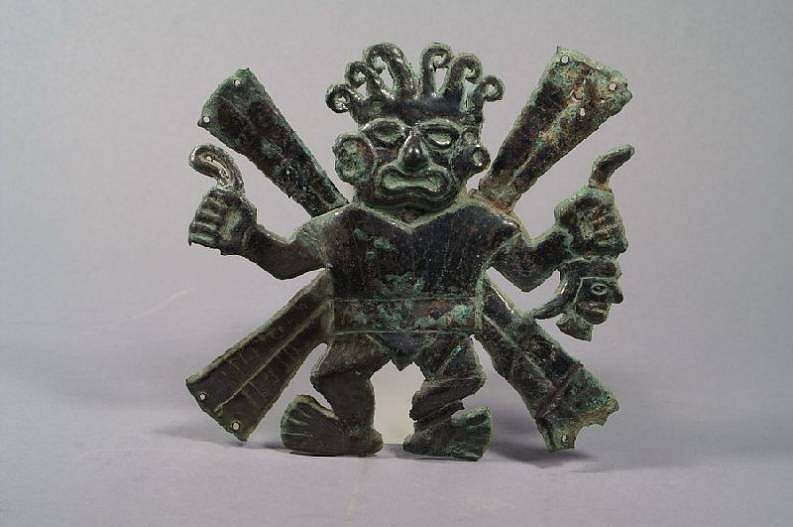



Peru, Loma Negra Copper Applique of the Decapitator
Appliques of this supernatural were sewn in series on woven textiles such as tunics and banners. The figure is known as the Decapitator, who has a distinctive mouth and often fangs, and whose right hand holds a tumi knife (blade lost) and a trophy head in the left. There are two holes in each diagonal of the ornament for attachment to a garment. A similar example is on display at the Metropolitan Museum of Art (New York, NY); more are illustrated in Lapiner (1976: figs. 350 and 382) and Carcedo de Mufarech (1999: 364). Loma Negra was a royal cemetery discovered about 1968 near the modern day city of Piura on the far north coast of Peru. From the tombs came exquisite Moche works in metal, mostly copper, with silver and gold objects as well, in sets of different sizes. The Decapitator is also called Ai Apec, the god who took off the heads of captives with his crescent bladed tumi knife. In another guise, he is Wrinkle Face, an aged deity with the same open mouth and fangs. The plaques seem to have been specific to the Loma Negra region, although the theme of the Decapitator dates back to the Chav�n period (Bawden 1999: 150-151). Scholarly research indicates that the overall form of the Decapitator on Loma Negra plaques was based on the body of an outstretched spider.
Period: Peru, Moche, Loma Negra, North Coast, circa AD100-300
Media: Metal
Dimensions: Height: 5 1/2" x Width: 6"
Price Upon Request
98249
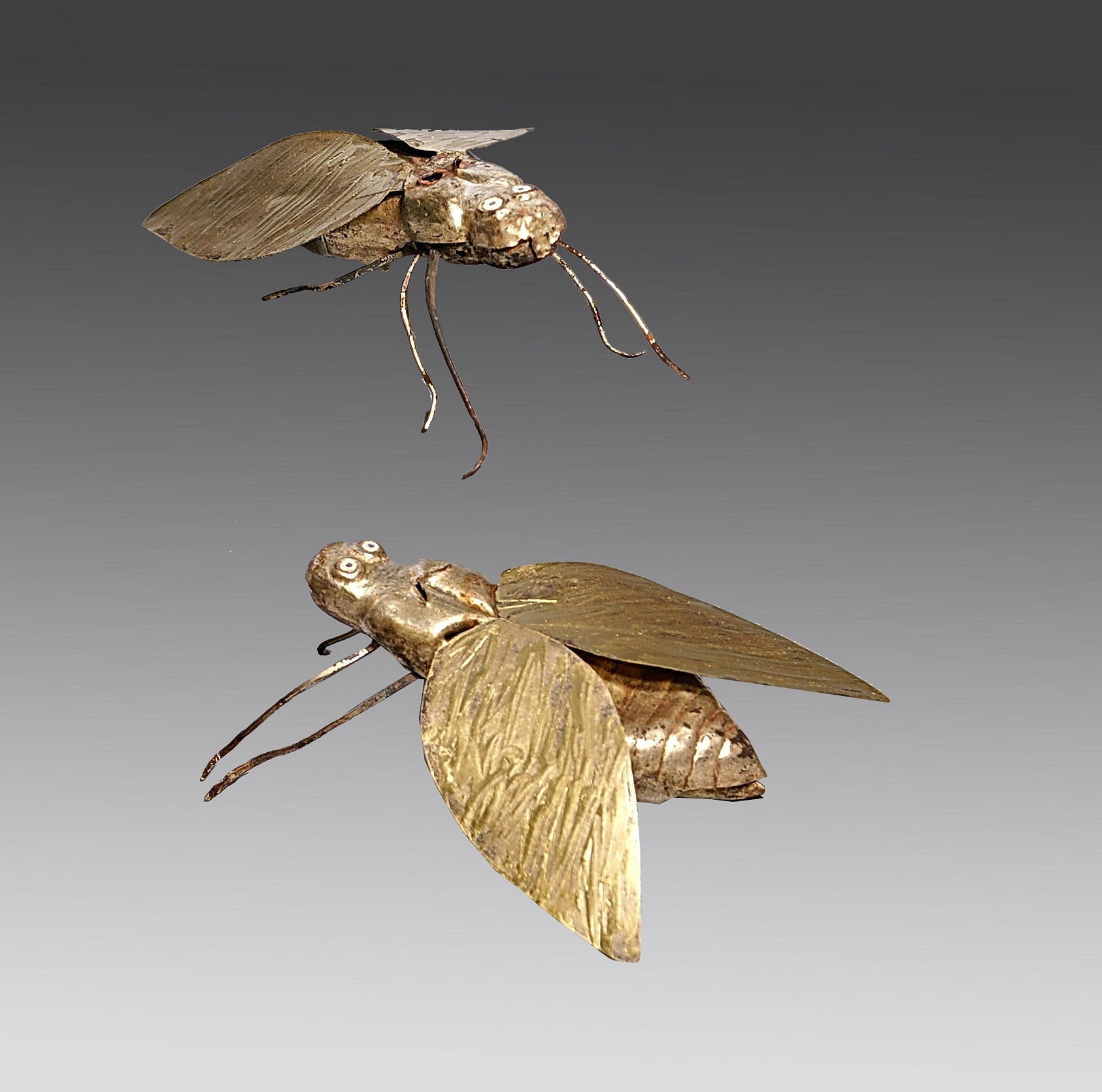




Peru, Loma Negra Gilt Copper Pair of Hoverflies
The flies are examples of a highly skilled gilding technique over copper. The construction is of tab and hammered and shaped parts to create a three-dimensional body. This was preferred in Peru over lost wax casting. Loma Negra Royal tombs were found in Northern Peru in the 1960's. The largest holdings of this material are in the Metropolitan Museum of Art. Other examples of critters are illustrated in PRE-COLUMBIAN ART of South America by Alan Lapiner, fig 376. There is a Loma Negra fly in the Met Museum ref 1981.459.28 in poor condition. Hoverflies are among the largest flies and have colorful bodies and are harmless. They often imitate bees or wasps as a survival technique to appear dangerous to their predators. The Peruvian favored animals that metamorphose, (eggs, large, maggots to flies) as proof that humans can transcend into spirits. Since hoverflies have colorful yellow and black bodies they connect with gold of the sun. These flies are considered large for Loma Negra creatures and have no apparent function.
Period: Peru, Moche, Loma Negra, North Coast, c. AD 100 - 400
Media: Metal
Dimensions: Length 4 1/2" x Width with wings 4" Height :1 1/2"
$15,000
M9067




Peru, Loma Negra Gold Crescent-Shaped Headdress Frontis Piece
The headdress ornament has two sets of attachment points which would have been used to attach it to an elaborate headdress for an important personage. The Loma Negra archaeological site was discovered in the early 1960s and was later understood to be an early royal Moche tomb complex. Acquired by descent from Jan Mitchell to his sons, prior to the 1980s.
Period: Peru, Moche, Loma Negra, North Coast, c. AD 100 - 400
Media: Metal
Dimensions: Height: 7 1/8 " x Width: 9 " Gram Weight: 50.8
$7,500
p3064
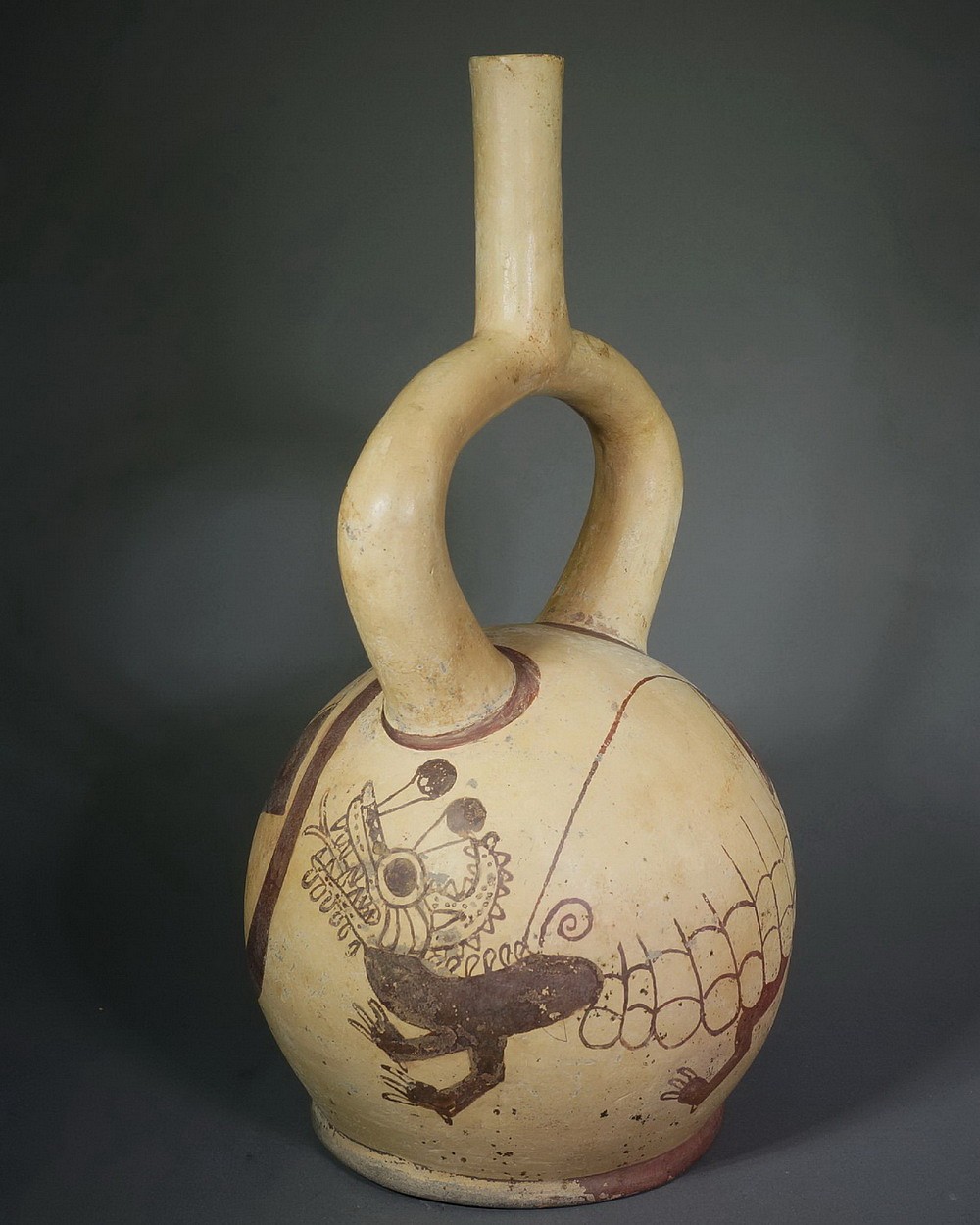





Peru, Moche 4 Stirrup Spout Vessel painted with a Strombus Monster
The vessel is finely drawn with reddish brown slip on a cream ground and depicts a Strombus galeatus monster coming out of its shell on both sides. The monster has a long curving tail and an exposed a front leg. Christopher Donnan describes this monster in MOCHE ART OF PERU, pg. 64. From the estate of Philip L. Herman prior to 1970.
Period: Peru, Moche IV/V, North Coast, c. AD 400 - 700
Media: Ceramic
Dimensions: Height: 12 1/4"
$6,500
n6048
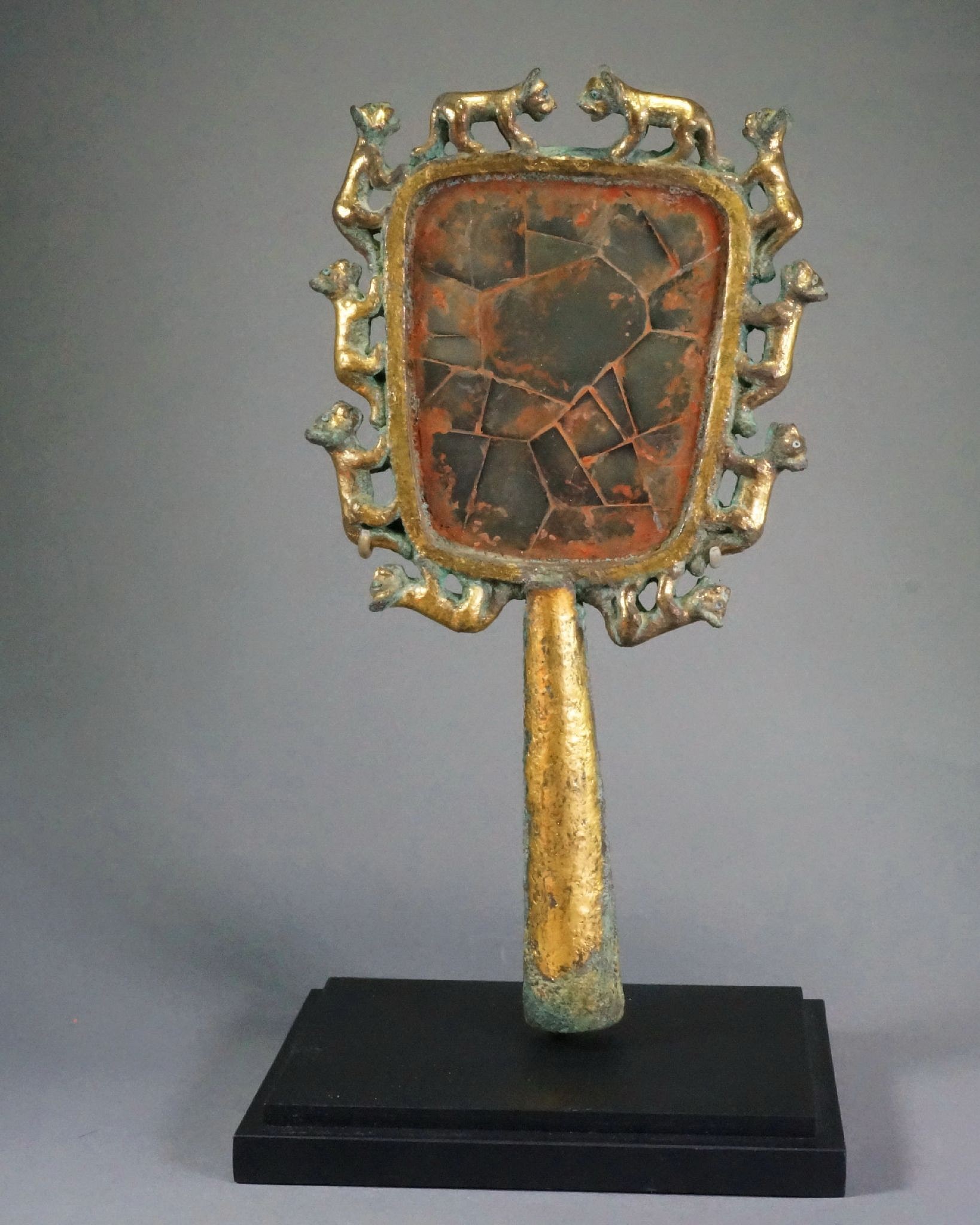




Peru, Moche Cast Copper Gilt Handled Mirror Surrounded by Ten Pumas
Hand-held mirrors are rare from any Peruvian cultures, and those few that are known are carved from wood, except one other gilt copper one that is in the Metropolitan Museum of Art. Mirrors were important objects for high status individuals and symbolized the power of the sun. Both mirrors were found at the Loma Negra site of far North Peru, excavated in the 1960’s, and were made by the same workshop. The mirrors have different themes: the Met’s with birds, and this one with felines.
Both mirrors were constructed in the same manner - cast frames are mechanically attached to the handle with a separate sheet of copper backing to hold pyrite mirror fragments in place. The Met’s mirror has lost most of its original gilding. This mirror has more of the original gilt surface intact and has a reconstructed mirror of ancient pyrite, whereas the Met’s mirror was restored with wax and coated with silver foil. The felines surrounding the frame were individually modeled and cast as one with the frame, an extremely difficult technical accomplishment. Each puma has carved turquoise eyes. The few other known mirrors with handles which have been found were carved from wood. There are no other known mirrors with metal frames according to Dr. Christopher Donnan formerly at UCLA and the world expert on Moche Art.
To read an essay about this mirror, click here.
Period: Peru, Loma Negra, North Coast, c. AD 100 - P300
Media: Metal
Dimensions: Height: 9 1/4"(23.5cm) x Width: 5"(12.6cm)
Price Upon Request
n7005
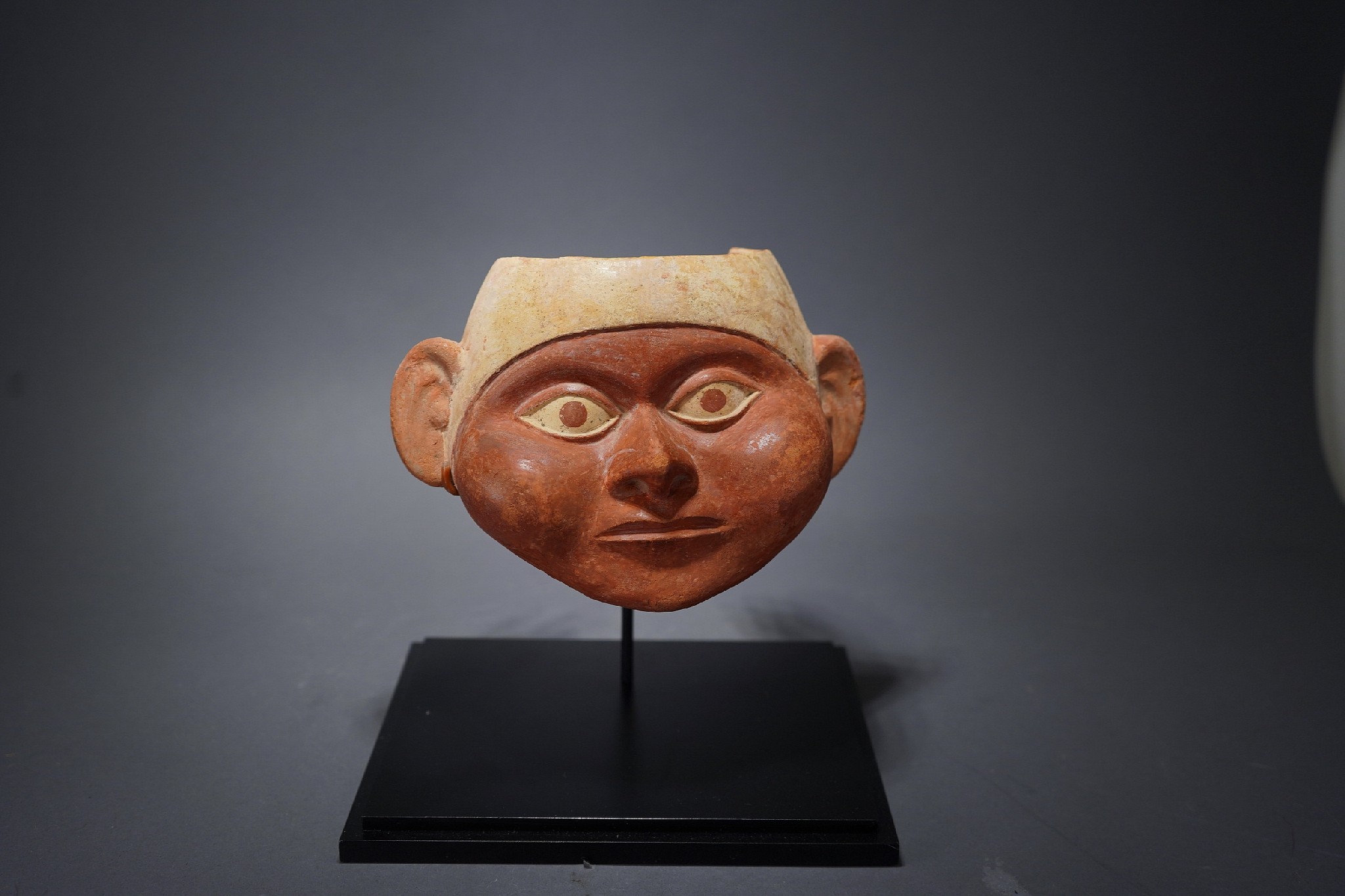




Peru, Moche Ceramic Section to a Portrait Vessel
The portrait masks of the represents the same individual that is illustrated in MOCHE PORTRAITS OF ANCIENT PERU by Christopher Donnan on page 92. The published version has the exact same facial features, but is older in age. The Moche are known to have made portraits of the same person throughout different life stages. Ex. collection of Mark Moore, by descent from his father Lee Moore. Prior to 1970.
Period: Peru, Moche IV, Huaca La Luna, North Coast, c. AD 300 - 450
Media: Ceramic
Dimensions: Height: 5 1/2" x Width: 7 1/4"
Price Upon Request
p2045
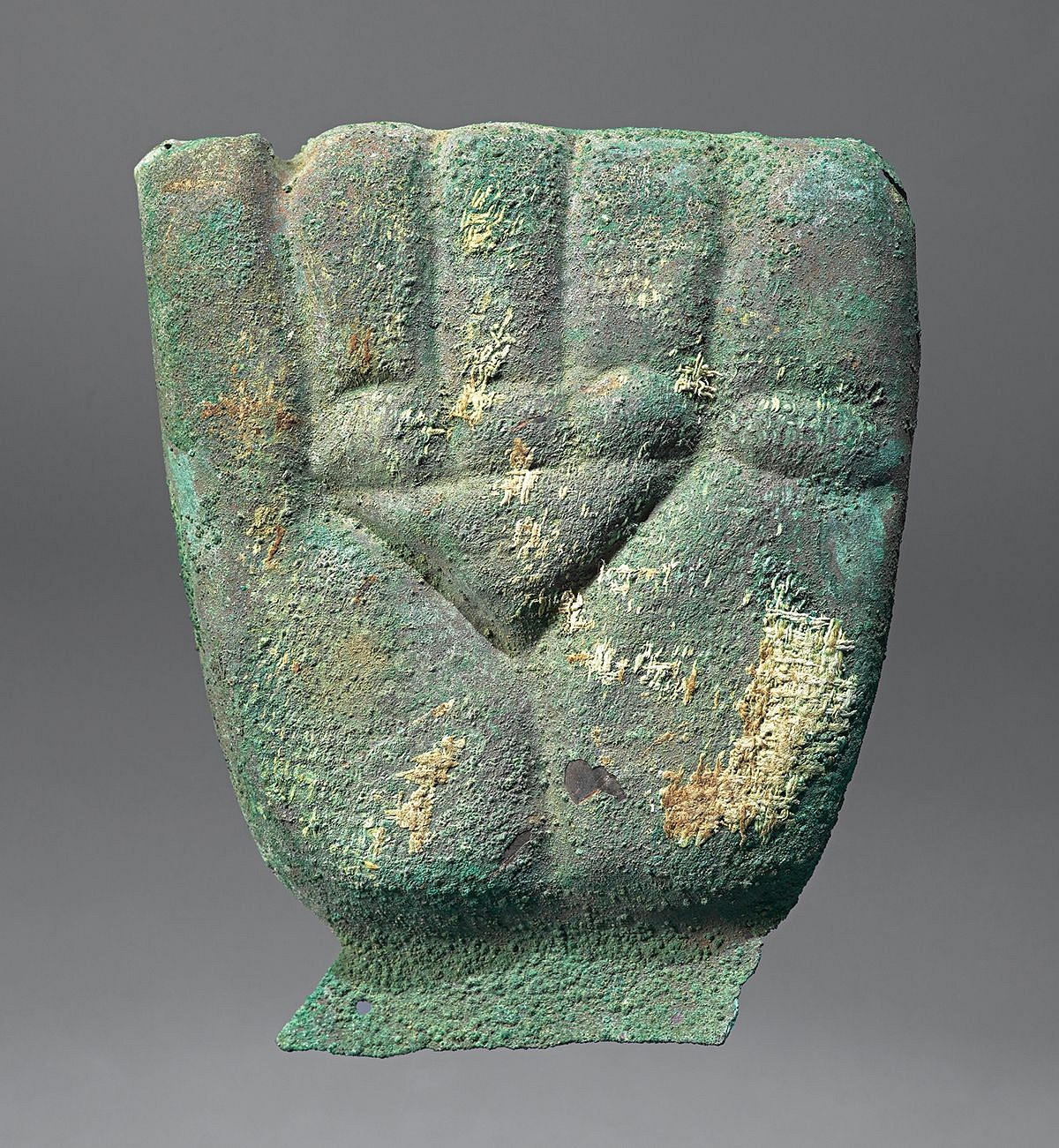
Peru, Moche Copper Hand
This hand was hammered and raised over a wooden model. It is a clenched fist with fingernails to the palm. The right hand belonged to a set of separate pieces, including face mask, torso, feet and hands that were sewn onto a cloth banner and placed over the deceased, such as found in a tomb at Sipán (Alva and Donnan 1993: 65-66). The authors also illustrate a Moche vessel with two figures holding banners. A similar set of face mask, feet and hands is illustrated in Carcedo de Mufarech (1999: fig. 39).
Period: Peru, Moche, Loma Negra, North Coast, c. AD 100 - 400
Media: Metal
Dimensions: Height: 12.5 cm; Width: 9.7 cm
$1,500
97107 B
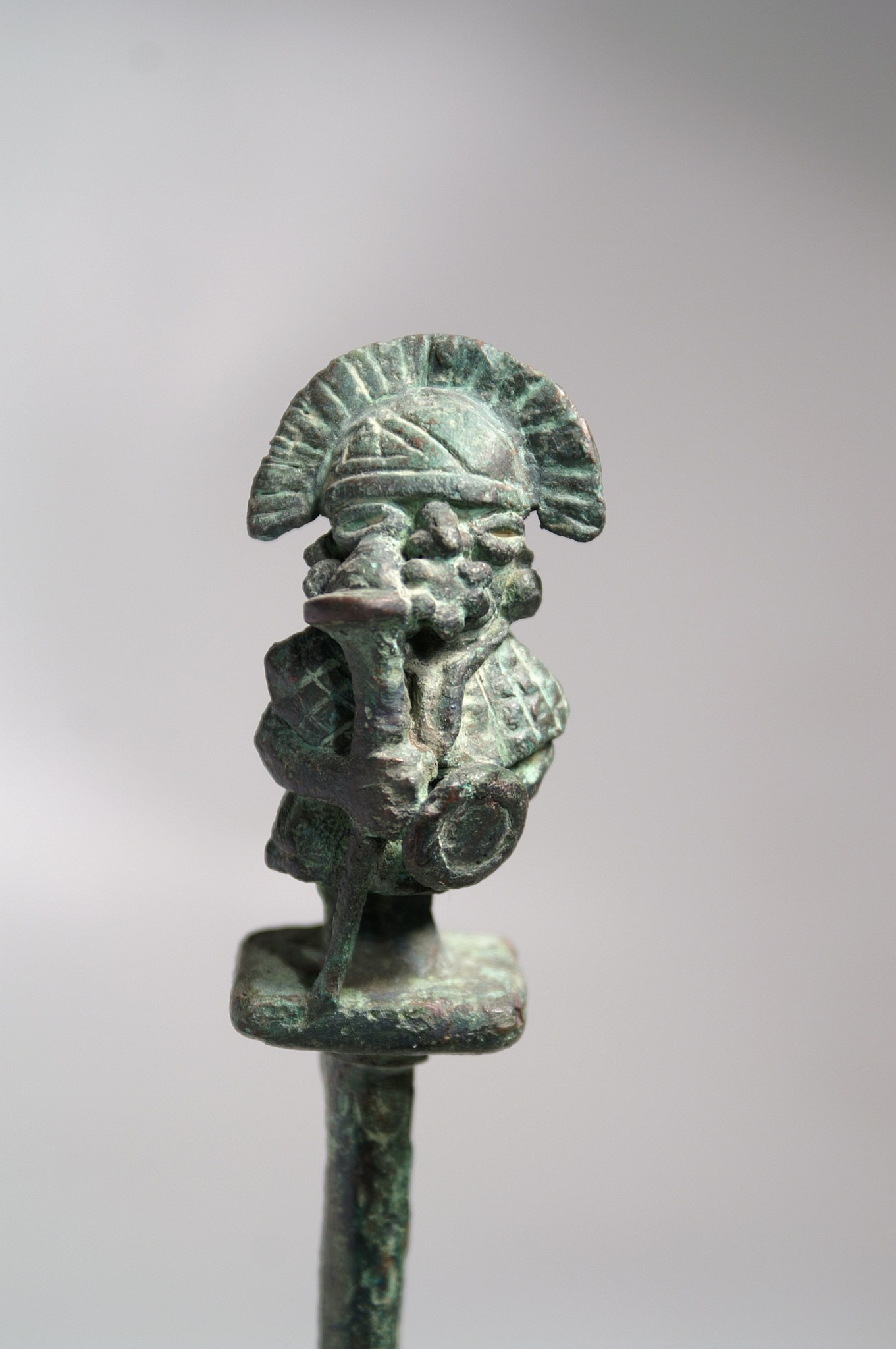







Peru, Moche Copper Spatula of a Warrior-lord with staff and shield
A warrior lord is spledidly dressed in full regalia wearing a helmet with feather crescent headdress, woven tunic, semi-circular nose ring and ear ornaments. He holds the standard long war club and round shield, such as appear in scenes of battle on fineline painted vessels. A small feline is splayed across the figure's back, wearing a necklace or belt of small owl heads. This work was cast in one piece in the lost-wax process. Spatulas were symbols of power for the high status Moche and were used in coca rituals to communicate with the ancestors and spirits of the otherworld. There is a suspension loop under the upper platform to be hung from a belt or the neck.
Period: Peru, Moche, North Coast, circa AD100- 600
Media: Metal
Dimensions: Height 8 1/2"
$5,500
98343
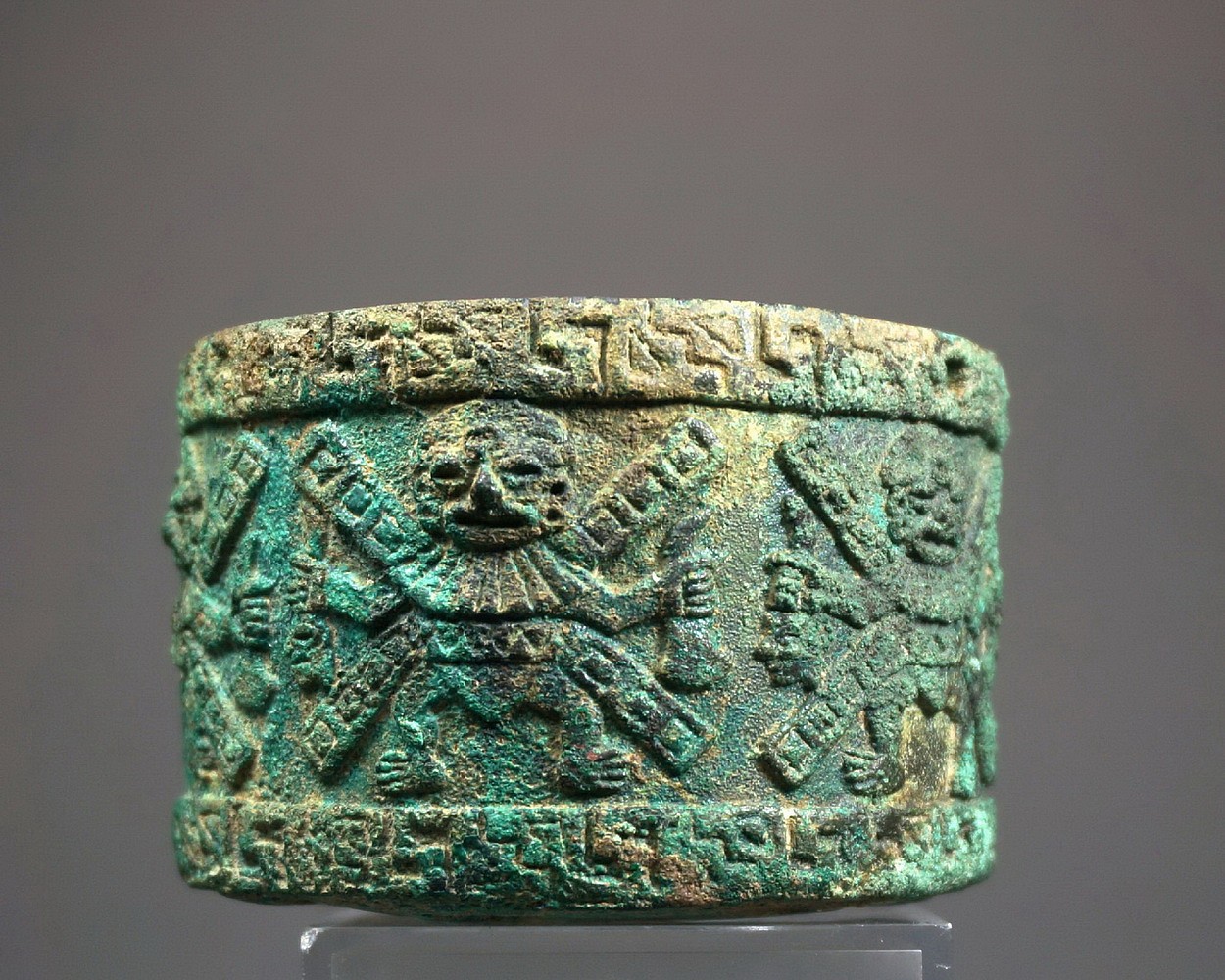









Peru, Moche Cylindrical Container with 6 Decapitators in High Relief
The container has a cover with an incised drawing of a weapons bundle. It’s a very rare object and is constructed with a complicated double wall technique. The outer wall was embossed by hammering the thin copper sheet against a wooden form carved with the figures. The inner wall is a plane sheet and annealed to the outer sheet and hammered around a form in the shape of bottom disc.
Period: Peru, Moche IV/V, North Coast, c. AD 400 - 700
Media: Metal
Dimensions: Height: 2 1/4" x Diamerter: 3" Circumfrence: : 10"
$12,000
n4013







Peru, Moche Gold Bead in the Form of a Tree Snail
The emergence of snails signals the start of the rainy season, indicating prosperity and abundance. The tree snail, Strophoceheilus, is featured in fineline drawings on the sides of Moche ceramic vessels depicting "snail hunters" in the foothills of the Andes. This bead is made in two parts, with the bottom expertly soldered to the spiral cone-shaped shell. The snail's foot is exposed inside the shell. The shell also functions as a bell, with two copper beads inside that rattle when worn. Originally from a larger necklace of snail beads, each with two sets of suspension holes on the bottom. Illustrated in Oro del Antiguo Peru, lam.183. Ex. collection Benno Mattel, by descent to his daughter Karin Ashburn.
Period: Peru, Moche, Loma Negra, North Coast, c. AD 100 - 400
Media: Metal
Dimensions: Height: 2" x Width: 2 1/2" Weight: 36.4 gm.
$27,500
n8018
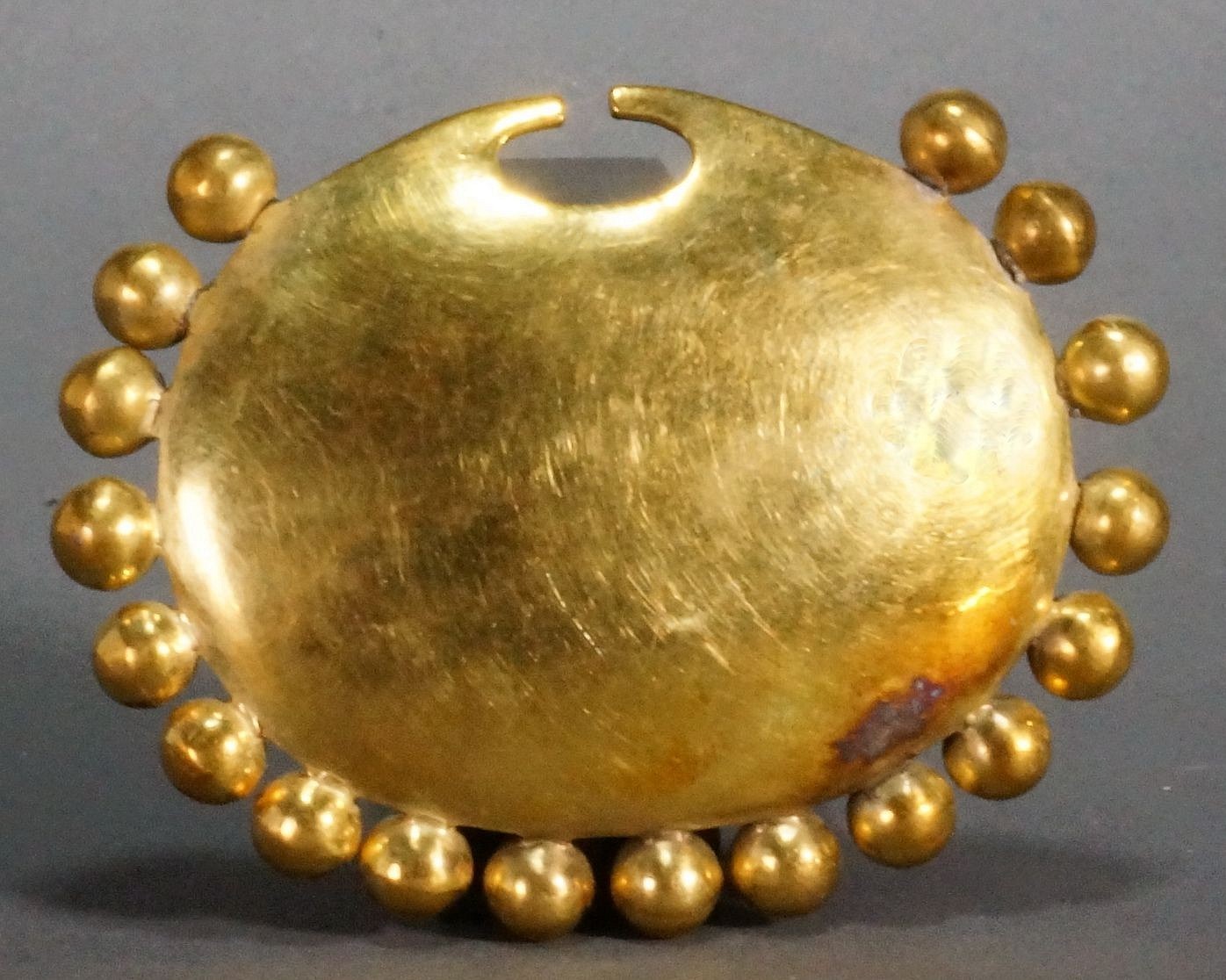



Peru, Moche Gold Nose Ornament Surrounded with 18 Spheres
Each of the spheres are individually soldered to the base. Illustrated in Oro del Antiguo Peru, plate 134. From a Texas collector, acquired prior to the 1970s.
Period: Peru, Moche, Loma Negra, North Coast, c. AD 100 - 400
Media: Metal
Dimensions: Height: 2 1/4" x Width: 2 3/4" Weight: 27.3 grams.
$18,000
n8020
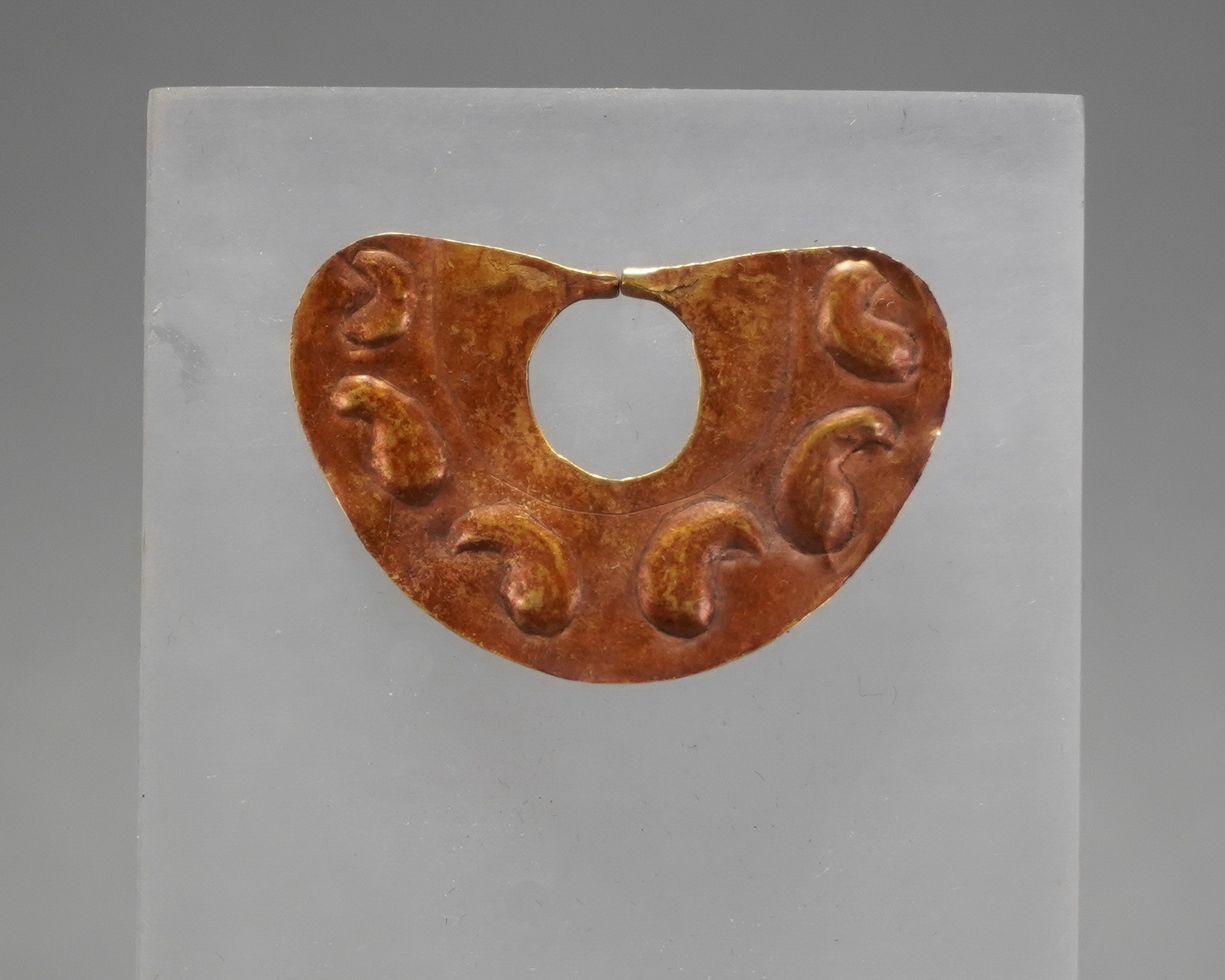
Peru, Moche Gold Nose Ornament with 6 Embossed Uculla Fruit
The Uculla fruit was an anti-coagulant to thin prisoners' blood for ritual ceremonies. The patina contains ferric oxide from the soil in the vicinity of the burial site, which gives the gold ornament its beautiful red patina. This piece was hammered from a soft sheet of pure gold. Small gold ornaments such as this required excellent craftsmanship to execute.
n9056




Peru, Moche Gold Nose Ornament with Hummingbird in a Tree
This delicately crafted hummingbird figure features inlaid turquoise eyes and geometric danglers. This is an excellent example of Moche soldering and filigree workmanship
Period: Peru, Moche, North Coast, c. AD 100 - 300
Media: Metal
Dimensions: Width: 1 1/2" x Depth: 1 1/2" Weight; 8 grams.
•SOLD
90166



Peru, Moche Gold Pincer with Embossed Large-Eared Bat Face
Pincers have been found from as early as the Vicus period (pre-Moche), circa 300 BC and were thought to be used to pluck facial hair. Few are known from the Moche period and most of the pincers that have been found were from the Chimu and Inca periods. This pincer has an embossed face of a bat with fanged teeth. The bottom of the pincher features a beautiful, flared design, representing a Moche back-flap. It was made from one single hammered sheet of high carat gold and then embossed twice on a carved wood form, then bent at the middle to create an identical front and back. There is a suspension hole in the middle. Ex. collection Magret Brenner, Zurich.
Period: Peru, Moche, North Coast, c. AD 200 - 700
Media: Metal
Dimensions: Height: 2 1/4" x Width: 1 1/4" Weight: 16.5 grams.
$9,750
n7012
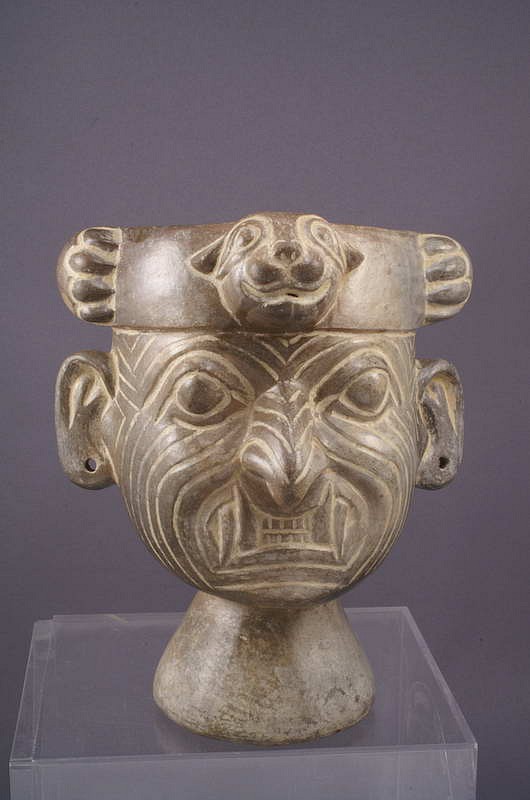
Peru, Moche Grayware Rattle Cup with the Decapitator
A well modeled portrait of Ai Apaec wearing his characteristic puma ring headdress with its tail incised on the back of the vessel. The perforated base of the cup contains clay beads which make the vessel rattle with movement. Ai Apaec was an old wrinkled god associated with war and sacrifice, hence his other titles as the Decapitator and Wrinkle Face.
Period: Peru, Moche III, North Coast, c. AD 200 - 500
Media: Ceramic
Dimensions: Height: 5 1/4" x Width: 4 1/2"
$5,200
M3147
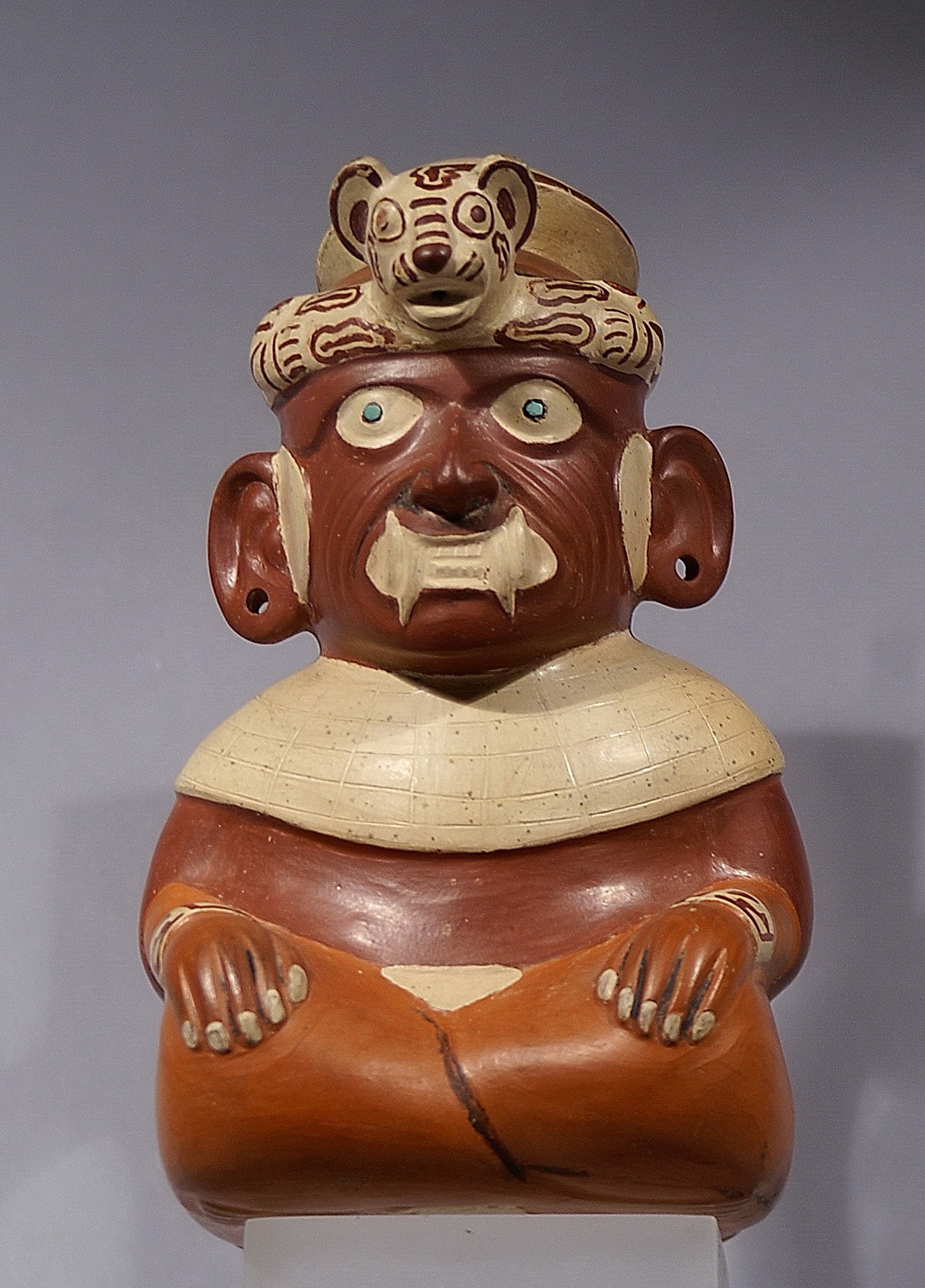






Peru, Moche I - II Effigy Vessel of the Decapitator Ai Apaec
This is an early version of the Decapitator deity known as Ai Apaec. The deity always wears a feline headdress, but early versions also show him with a turban. This headdress not only has a puma skin but also a Plume of feathers represented by the conical form ontop of his head. He also wears a lovely Pectoral with individual plaques sewn onto a leather backing. The Decapitator is one of the earliest supernaturals in the Moche ceramic sequence, and he frequently carries a tumi knife and a decapitated head. The Decapitator continued into later cultures, notably the Wari and the Chimu. Formerly in a European collection since the 1970s.
Period: Peru, Moche I, North Coast, circa AD100-300
Media: Ceramic
Dimensions: Height: 7 1/2"
$29,000
M7073
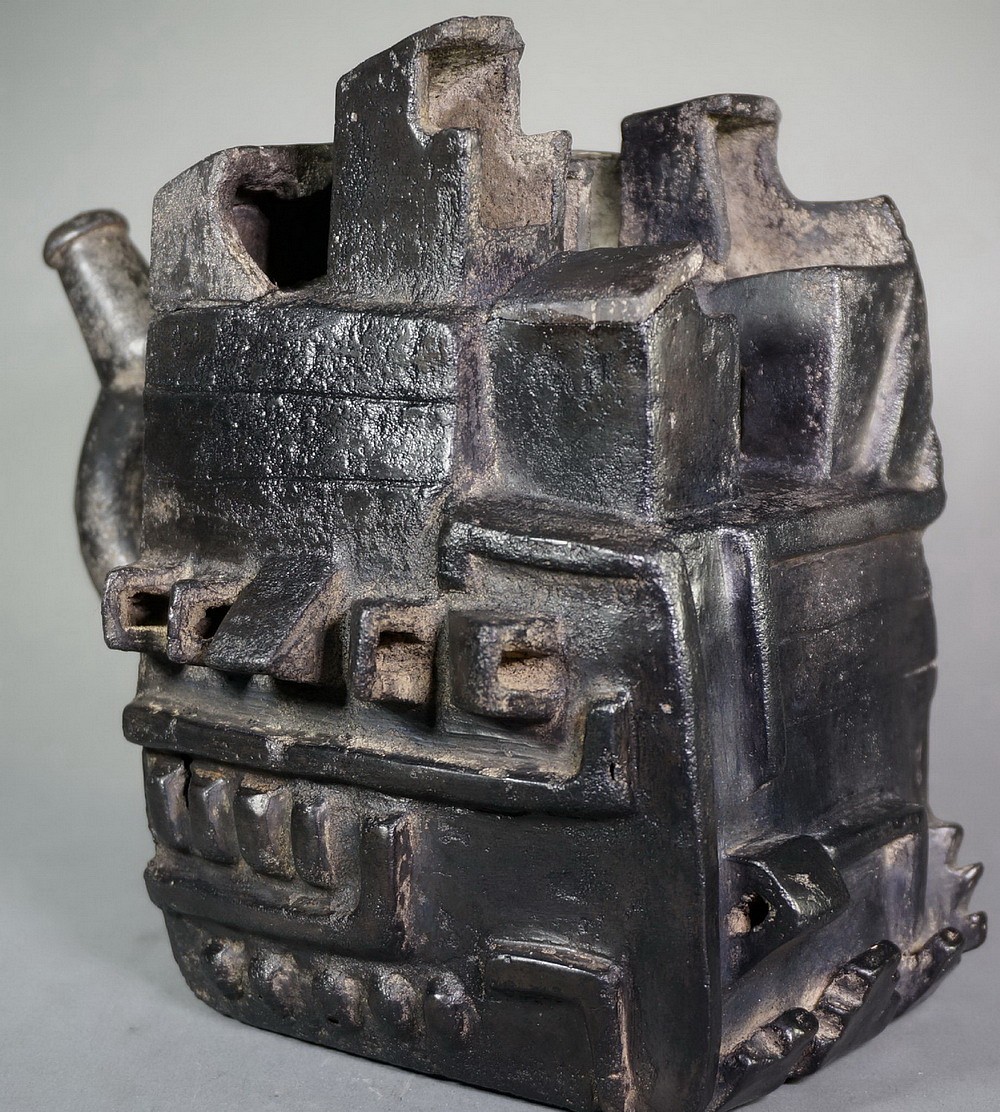








Peru, Moche I Blackware Architectural Model Depicting An Adobe Temple Site
This model is like one now in the National Museum of Archaeology in Lima, Peru (#c-54613). It was originally drawn as it might have been seen in ancient times by artist Alejandro Gonzales in 1936. This drawing is published in ARCHITECTURAL VESSELS OF THE Moche, by Juliet Wiersema, p.3, University of Austin Press. According to Dr. Christopher Donnan, a Moche scholar, the Moche often produced nearly identical ceramics with the same theme. From the estate of Philip L. Herman and collected in the 1950's -1960's.
Period: Peru, Moche I, North Coast, c. AD 1 - 250
Media: Ceramic
Dimensions: Width: 6" x Length 4 1/2" x Height: 8"
$12,000
n6047
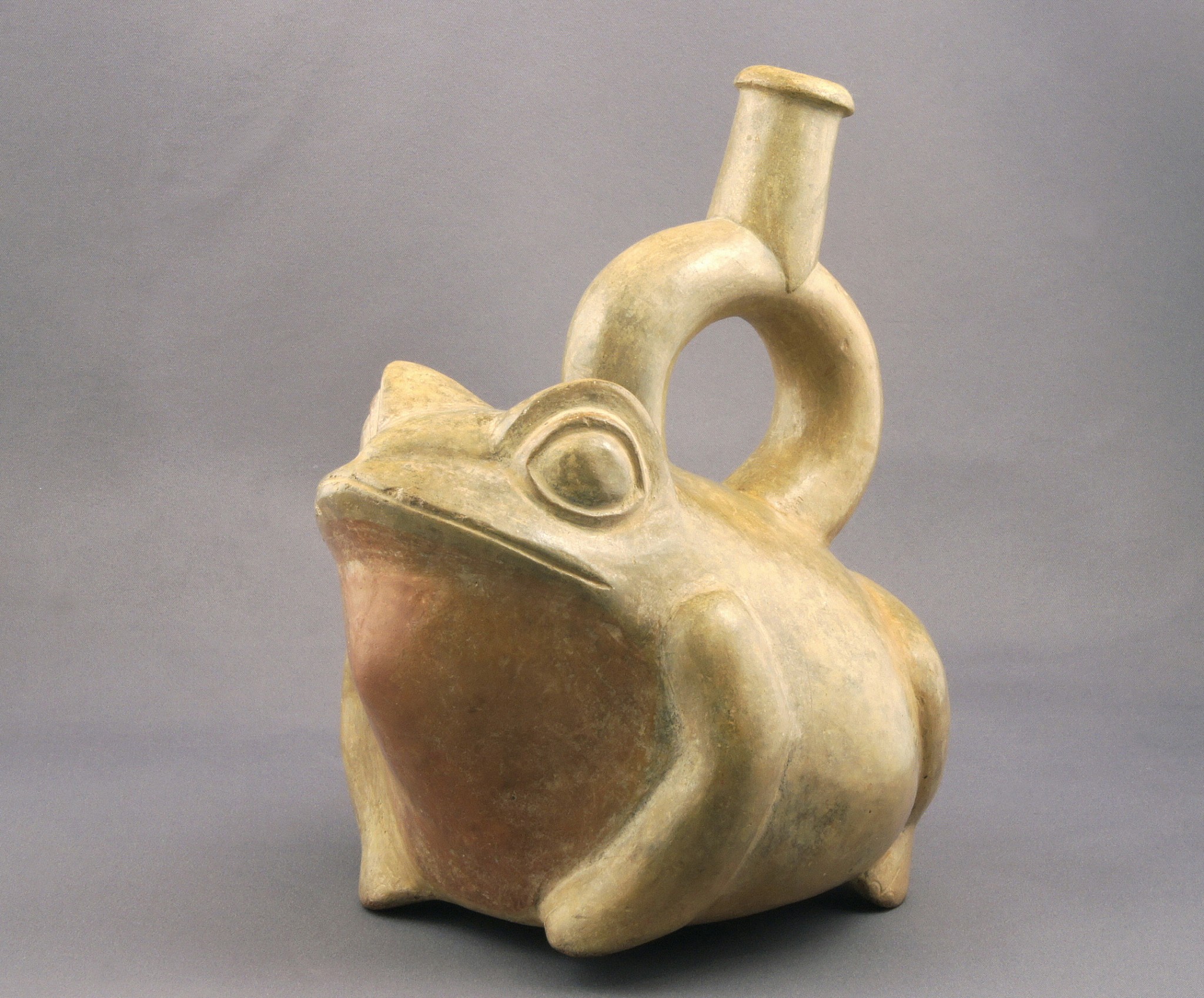




Peru, Moche I Ceramic stirrup-spout effigy of a seated toad in buff with red throat
This stirrup spout vessel depicting a life-like frog/toad attests to the Moche artist's fond awareness of the natural world. Such careful attention and adeptness at naturalistic portrayals of animal images is common of Early Moche ceramics. Frogs have bulbous eyes, strong, long webbed feet, and slimy skin, while toads have stubby bodies, warty, dry skin, different chest cartliage and paratoid glands behind the eyes. Their large eyes are defined with a ridge. Also, toads do not have teeth, while frogs have upper teeth. This rotund fellow with his alert wide-eyed gaze and attentive posture seems all too ready to ambush an unsuspecting fly. It is slip painted in cream and the head tilts upward, exposing a rosy orange gullet beneath the determined, down-turned mouth. Images of frogs and toads (anurans) are commonly interpreted in the art of many Pre-Columbian cultures. Because of their musical croaking performances after heavy rains, frogs and toads are associated with water, vegetation , fertility, and in some cases (usually toads), toxicity. The cyclic quality of their development --the change from the fish-like tadpole to adult frog, allude to a natural affiliation with mythical concepts of transformation. Similar examples are illustrated in "Pre-Columbian Art of South America", by Alan Lapiner, fig. 281, p129, and in "Moche Art of Peru", by Christopher B. Donnan, fig. 81, p.57. as well as in Ceramics of Ancient Peru by Donnan, 1992, UCLA, p. 128.
Period: Peru, Moche I, North Coast, circa AD100-300
Media: Ceramic
Dimensions: Height: 7" x Width: 5"
$5,400
98439
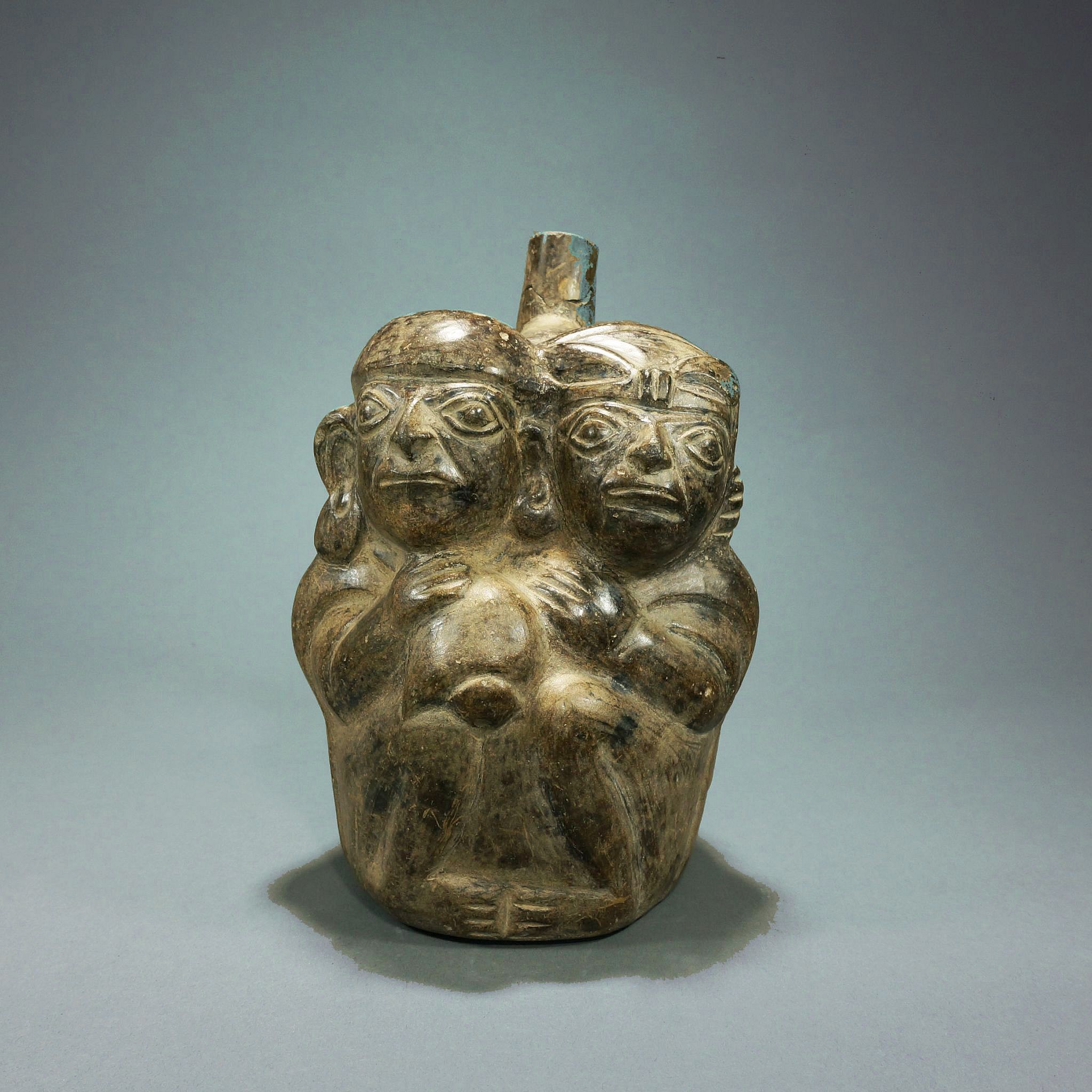
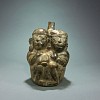
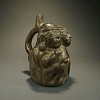


Peru, Moche II Grayware Vessel with Embracing Couple
An embracing couple is an extremely rare subject for Andean art from any culture. Although ancient Andean art features many human characters such as hunters and shamans, as well as semi-human deities with a wide range themes and emotions, romantic couples are not a common theme. In this sculptural depiction of a Moche couple, the male wears large ear ornaments, and holds a conch trumpet, and the female wears a feather plume in her hair, all signs of wealth and status.
Period: Peru, Moche II, North Coast, c. AD 200 - 350
Media: Ceramic
Dimensions: Height 8"
Price Upon Request
M9015H
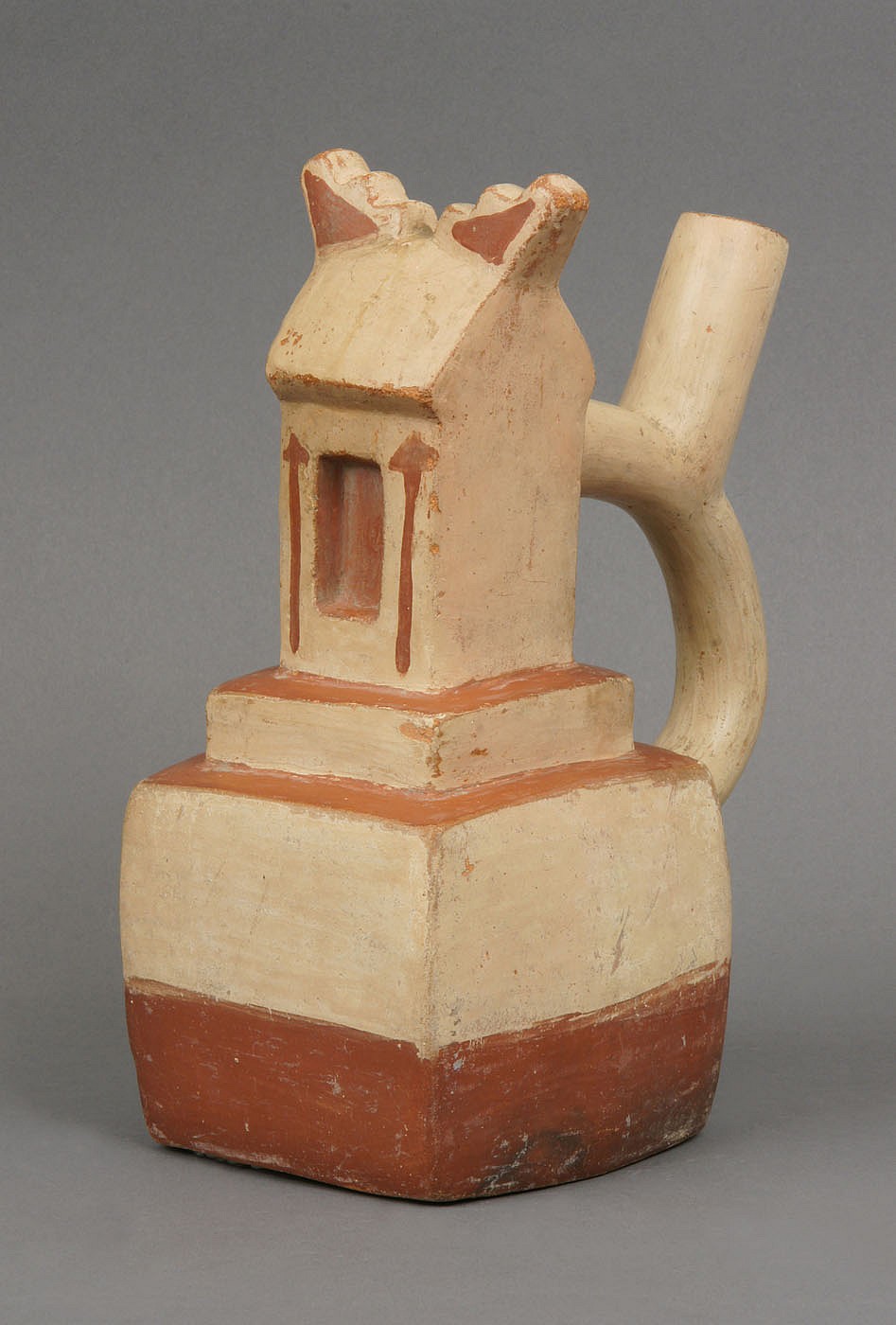



Peru, Moche III Ceramic Vessel in the Form of a Gabled House
This house or religious center is detailed with a gabled roof and stucco decoration with painted spears. A priest is portrayed in the doorway in full regalia. Ex Collection Of Sue Tishman, prior to 1970.
Period: Peru, Moche III, North Coast, circa AD300-500
Media: Ceramic
Dimensions: Height 9"
$7,000
M7019
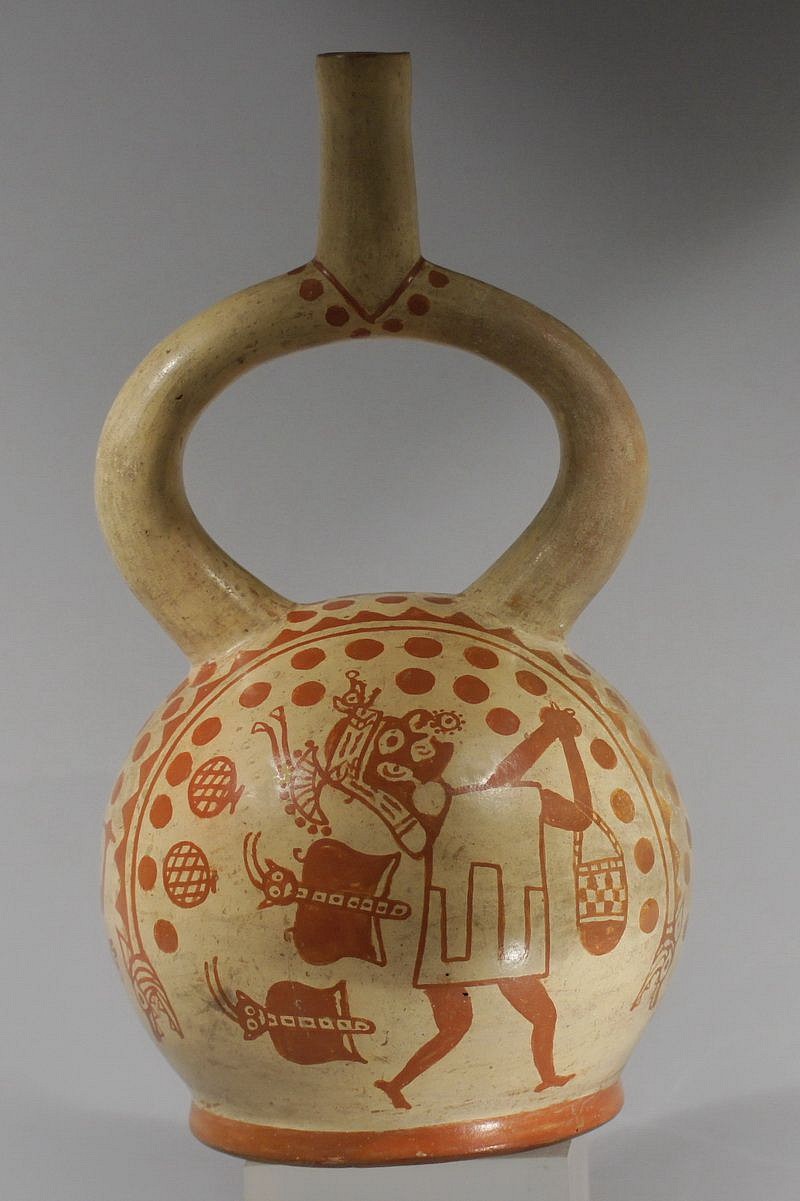
Peru, Moche III Fineline Vessel Depicting a Coca Ceremony
A fine example depicting the coca ritual. On one side we see 4 seated men holding the traditional gourd lime containers and administrating lime to extract the coca from the leaf. On the other side we see a figure with hands clasped holding a coca leaf bag and surrounded by bats, dark balls, and the Bicephalus Arc (double-headed serpent) which symbolize psychic flight and the praying for rain. There are three other known examples of the Coca-ritual under the Bicephalus Arc in Pre-Colombian art. One is in the Linden Museum in Stuttgardt and two others are in the collection of the Museo Arqueologico Raphfael Larco Herrera, Lima. All three are discussed in an article THE PRIESTS OF THE BICEPHALUS ARC by Santiago Uceda and published in THE ART AND ARCHAEOLOGY OF THE MOCHE, pg. 153-178, University of Texas Press 2008 . Formerly in the collection of Benno Mattel and exhibited at the British Consulate in Punta Del Este. Subsequently sold to a US collector in the US where it remained for ten years. Rollout drawing in Moche Archive #157.
Period: Peru, Moche III, North Coast, c. AD 200 - 500
Media: Ceramic
Dimensions: Height 10" x Diameter 5 3/4"
Price Upon Request
n2002
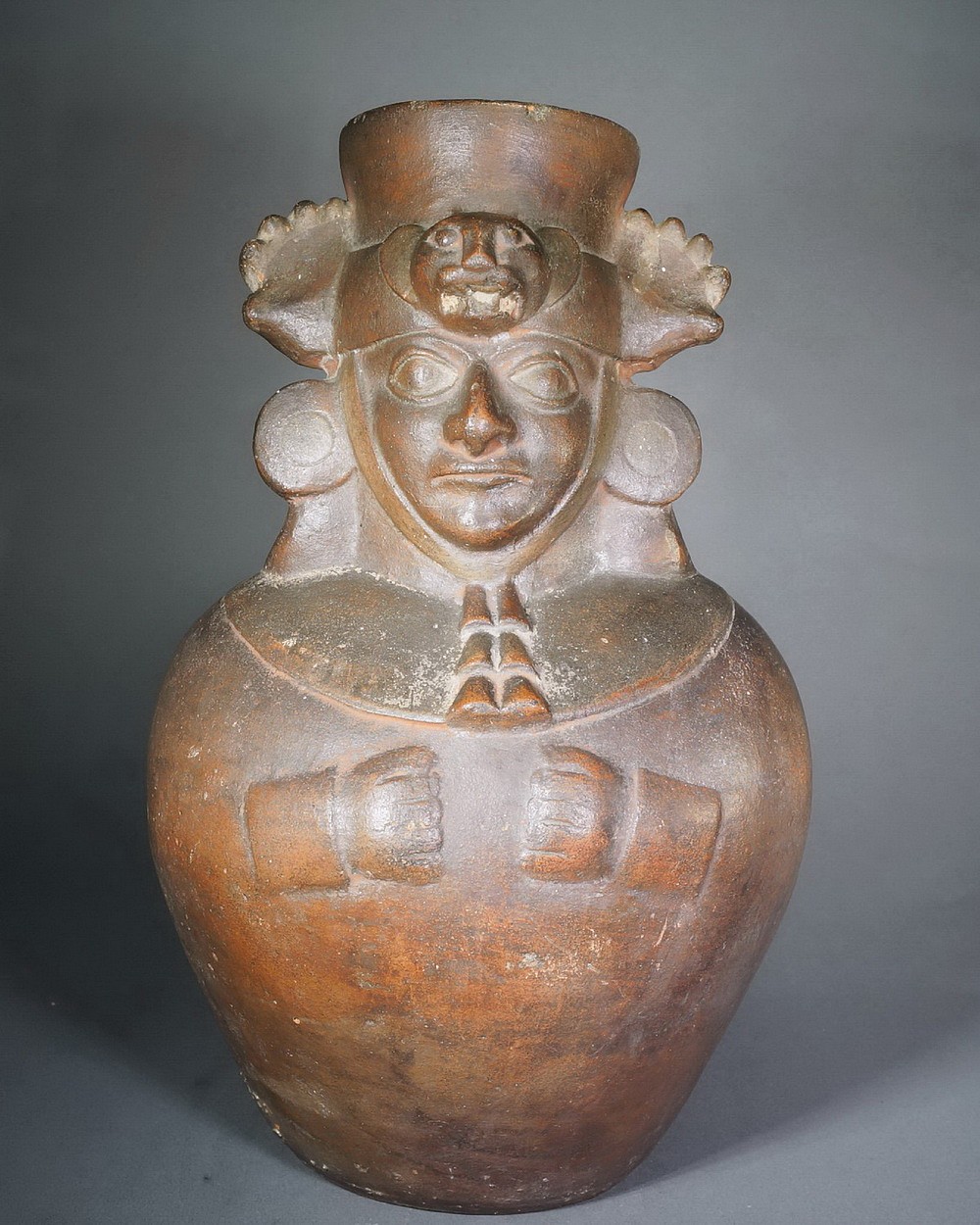






Peru, Moche III/IV Redware Mold Made Jar Depicting a Dignitary
The figure is wearing a head cloth underneath a Puma head ring with straps ending in tassels and large paws, with its polka-dot tail down his back. He also wears large ear spools which denote his status. He holds his hands to his chest below a semi-circular breast ornament. These vessels were made in a two-part mold, one for the front and the other for the back.
Period: Peru, Moche IV, North Coast, c. AD 400 - 550
Media: Ceramic
Dimensions: Height: 12 1/2"
Price Upon Request
n6049
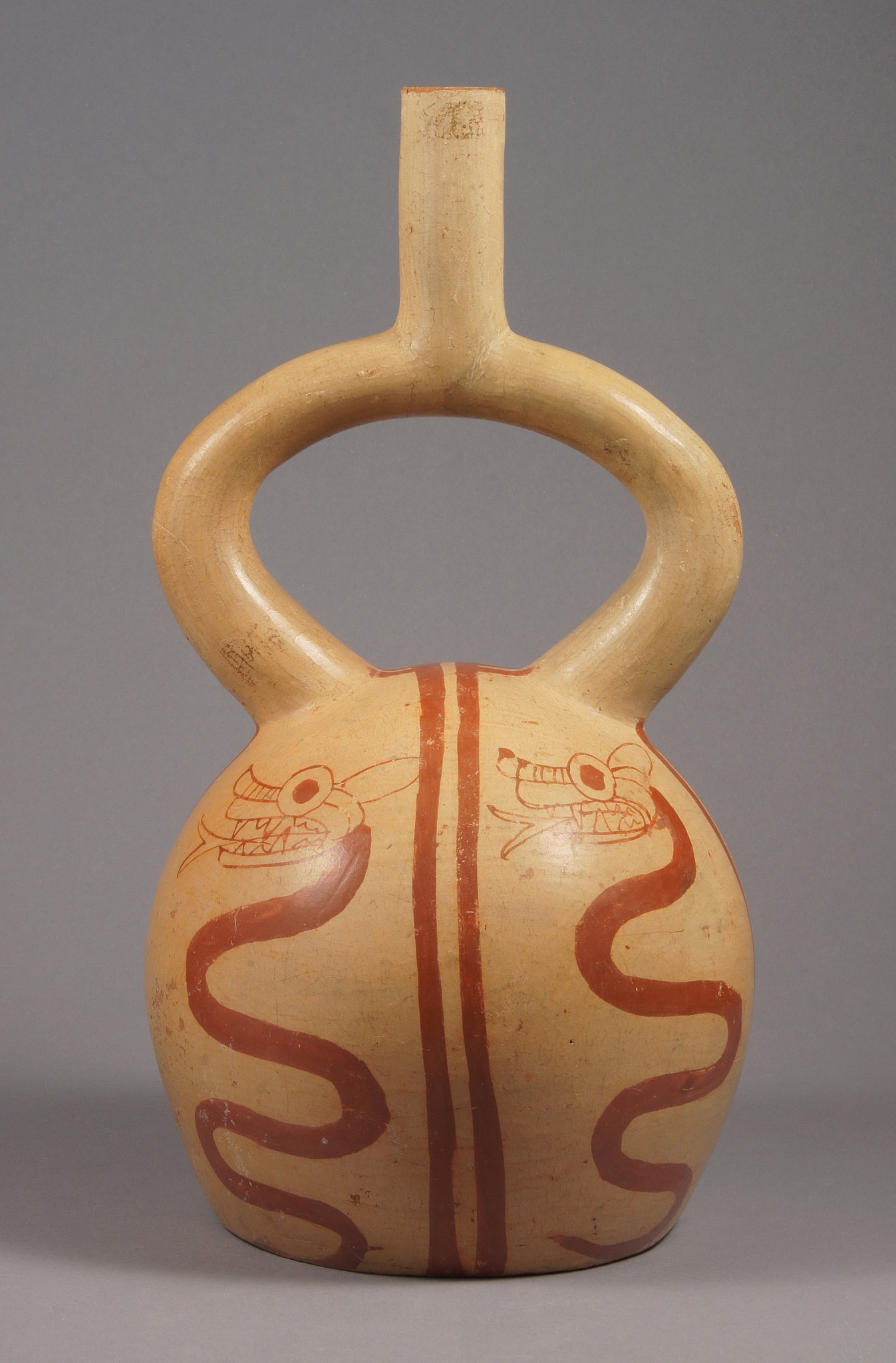


Peru, Moche IV fine line ceramic stirrup spout vessel of Serpents
A large stirrup spout vessel painted with four undulating serpents facing upwards, one in each quadrant in red/brown on a beige ground. The serpent represents rebirth, the shedding of its skin repeating as much as four times, perhaps for each season. Stirrup spout vessels were used to hold ceremonial corn beer and the spout allowed the air to enter one channel while the liquid was able to pour through the other channel.
Period: Moche, North Coast Peru, circa. 450-550 A.D.
Media: Ceramic
Dimensions: Height 11 1/2"
$4,500
90078
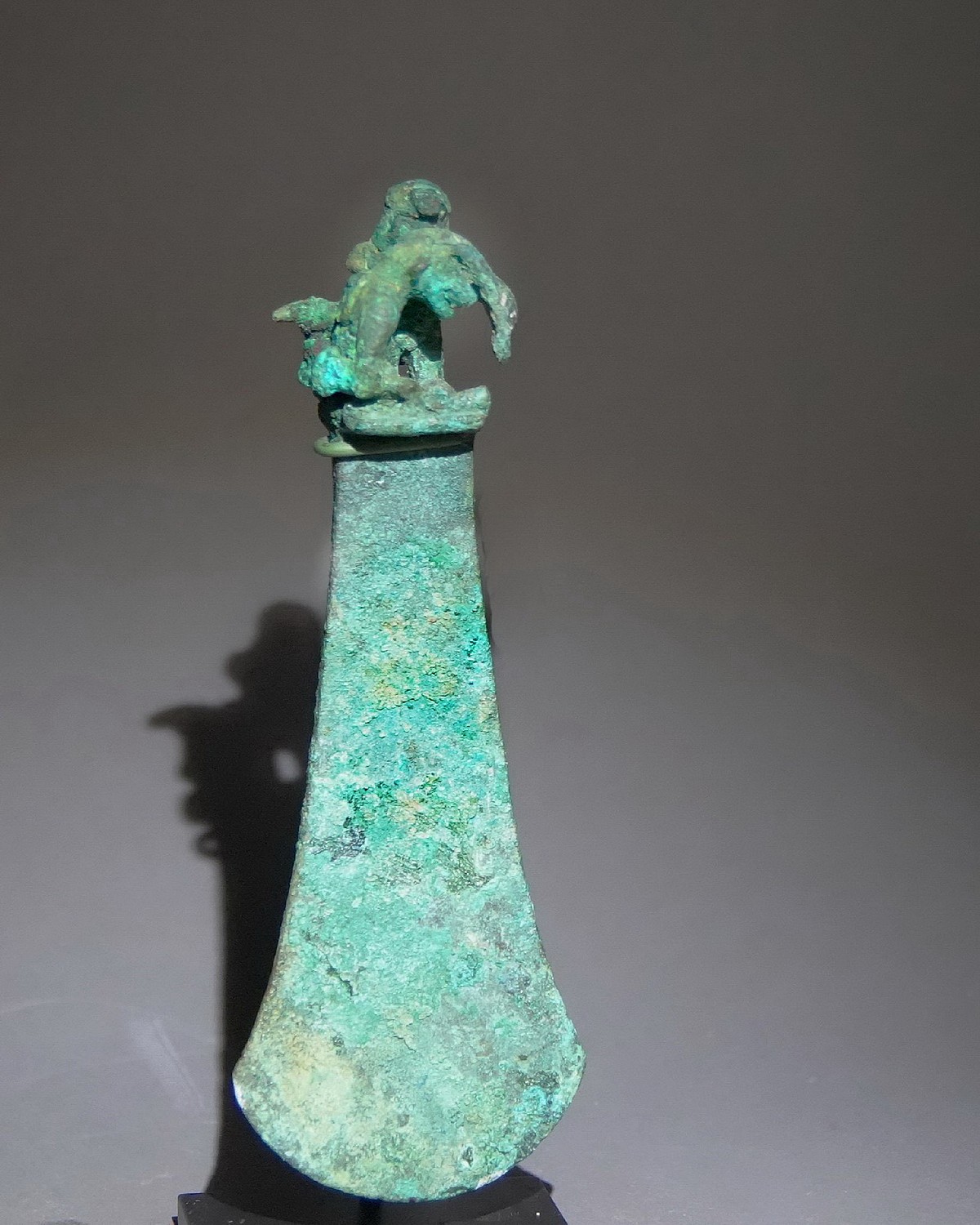





Peru, Moche Lost Wax Cast Bronze Tumi of a Warrior Capturing a Feline Deity
This classic tumi was lost wax cast using a single mold. There are two figures: a warrior and his victim, whom he holds by the hair. The victim, a feline deity, holds a tumi in one hand and a trophy head in the other.
Period: Peru, Moche IV, North Coast, c. AD 200 - 500
Media: Metal
Dimensions: Height: 7 1/4" x Width: 2 1/2"
$6,000
P1037
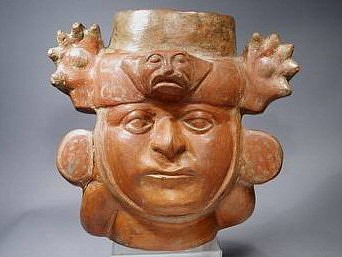
Peru, Moche Portrait Vessel of a Lord
Reddish brown ceramic, open top, portrait vessel of a man wearing ear spools and a headdress with a puma head motif and two enormous front paws emerging from the sides. There are traces of spotted, beige slip decoration on the ear spools and spots on the headdress. This vessel is significantly larger than most portrait heads which average slightly more than half life-size, and it is in good condition. Portrait vessels play a significant role in Moche art as forerunners of a period of realism that followed them. It is believed that portraits were of powerful leaders, and that their presence in a grave signified an honor bestowed upon the deceased. A very similar portrait vessel is illustrated in "Ancient Peruvian Ceramics: The Nathan Cummings Collection," by Alan Sawyer (1996: pl: 37). Another, perhaps of the same person, is illustrated in "Moche Portraits from Ancient Peru" by Christopher Donnan (2004: fig.: 4.27).
Period: Peru, Moche IV, North Coast, c. AD 200 - 500
Media: Ceramic
Dimensions: Height: 9 3/4"
Price Upon Request
96077
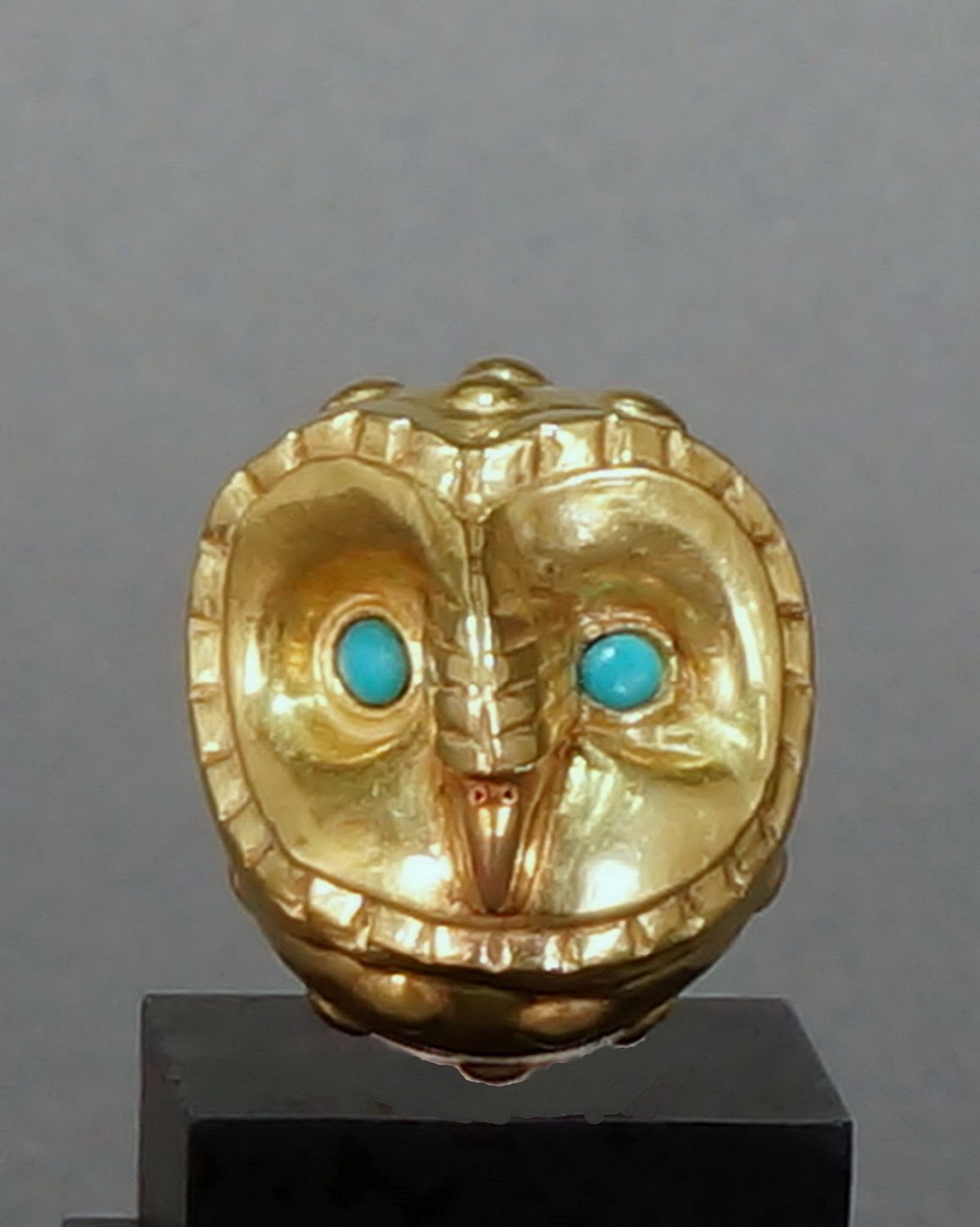





Peru, Moche Small Gold Male Condor Bead with Turquoise Eyes
This gold bead is identifiable as a male eagle by the caruncle on the beak. The beak itself is crated in a slightly reddish colored gold. It is made in two parts, expertly soldered. There are four suspension holes that allow for the bead to be hung upright. Ex Collection Benno Mattel, prior to 1970, by decent to his daughter Karin Ashburn.
Period: Peru, Moche, North Coast, c. AD 450 - 550
Media: Metal
Dimensions: Height: 3.3cm x Depth: 3.2cm x Weight:10.2 grams
$5,000
n8021
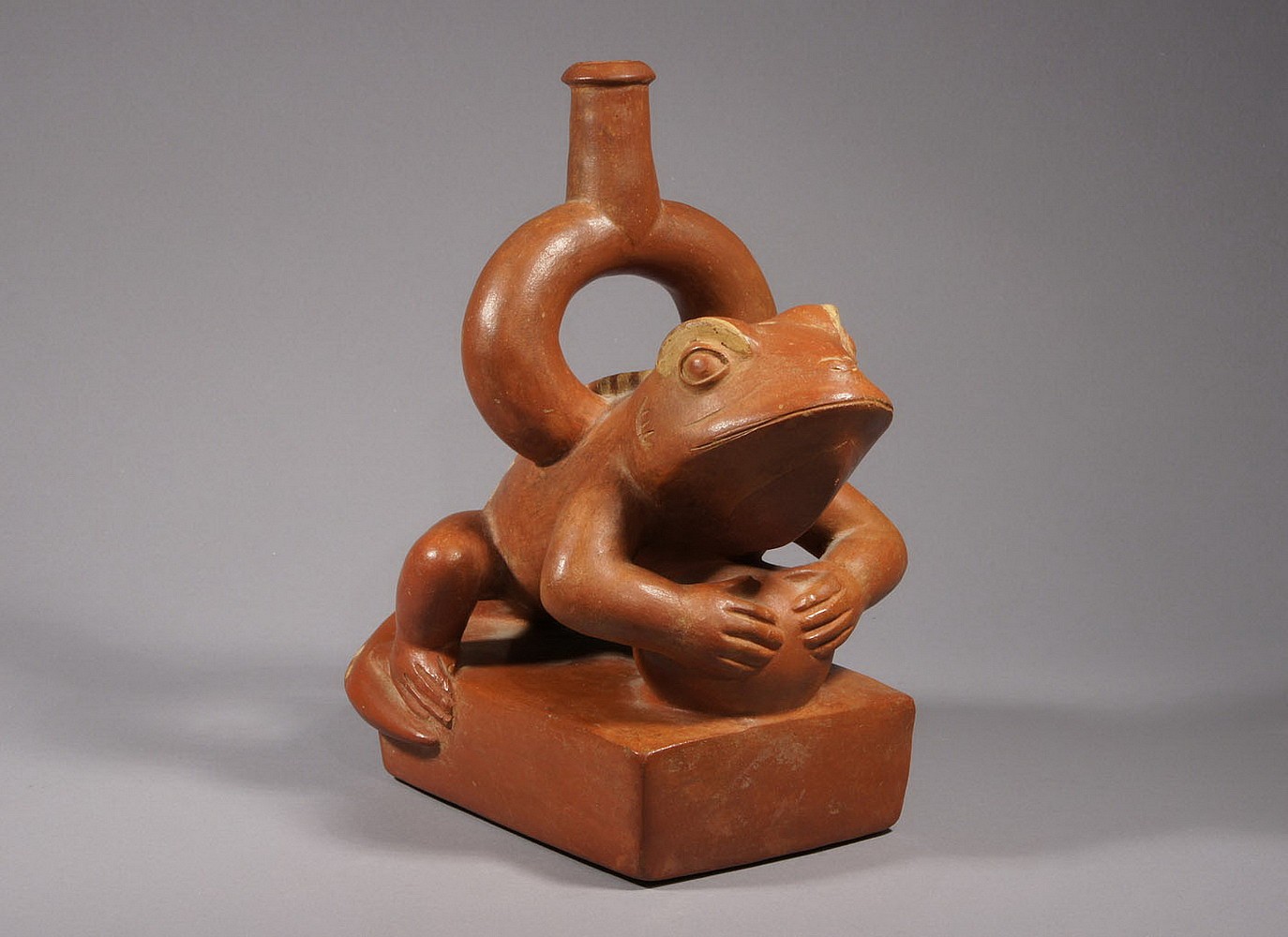
Peru, Moche Stirrup Spout Redware Vessel effigy vessel of a Tadpole
The tadpole is identified by the gullet under the mouth and long tail. This tadpole has highlights in buff slip over the eyes, on the gills on each side behind the eyes, on the nostrils, and under the mouth. The tadpole has human fingers and toes. This effigy is holds a large sphere to the chest and is crouches on a rectangular vessel. Very good condition. Cracks repaired at elbows.
Period: Peru, Moche I, North Coast, c. AD 100 - 300
Media: Ceramic
Dimensions: Length: 10" x Height: 8"
Price Upon Request
n2018
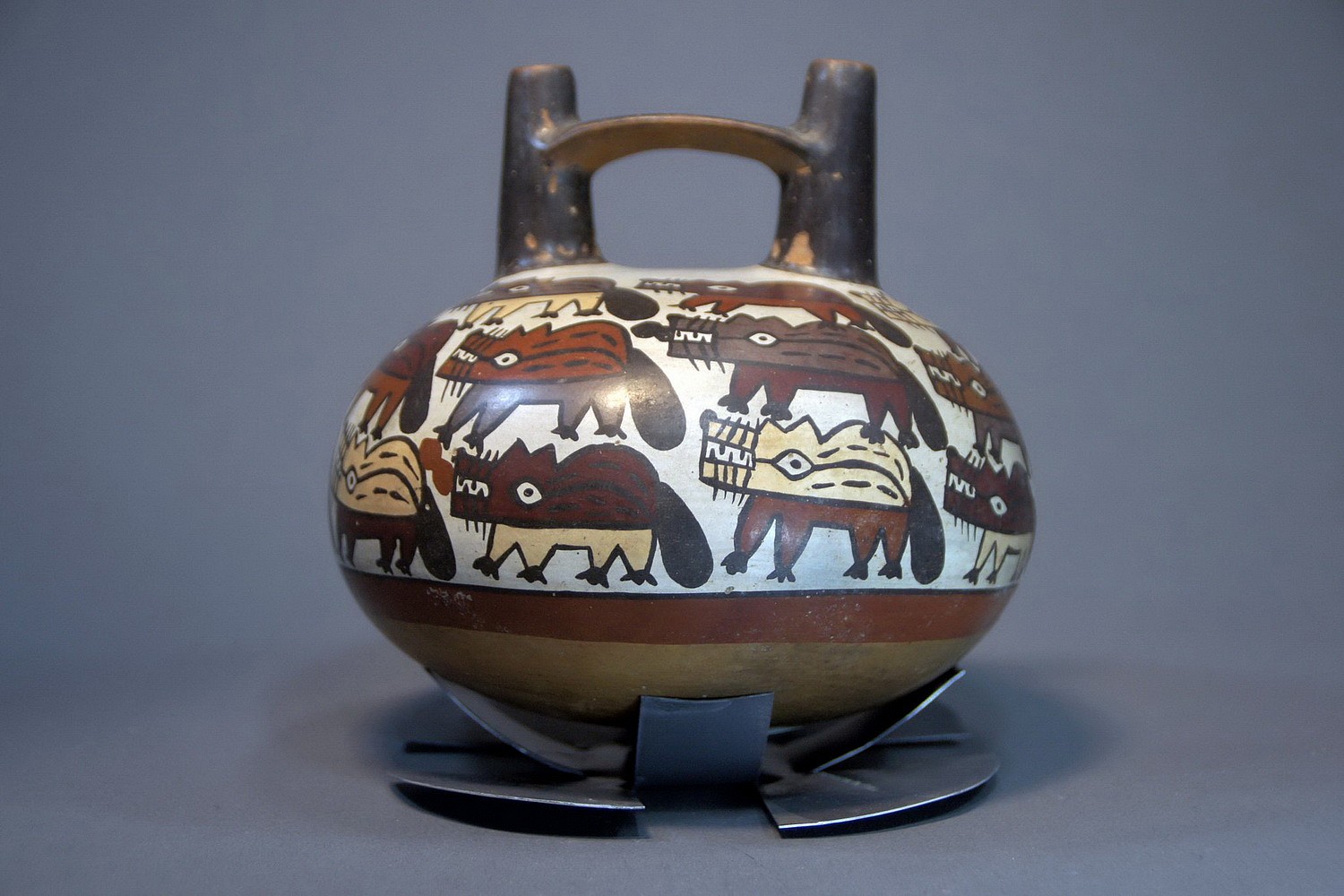
Peru, Nasca Bridgespout Vessel Painted with 23 Foxes On White Ground
A late Nasca period vessel, T/L tested, verified as 1650 years old by CIRAM Labs. Prof. Donald Proulx in his Sourcebook of Nasca Ceramic Iconography (pg. 141) describes the Andean Fox with the following characteristics, drawn in profile with elongated snout, pointed ears, whiskers and thick black tail. Deiter Eislab Illustrated 5 ceramics with similar painted foxes in ALTPERUANISCHE KULTUREN NAZCAII, plate 6-9.
Period: Peru, Nasca, South Coast, c. AD 400 - 800
Media: Ceramic
Dimensions: Height; 5 1/2" x Diameter: 6"
Price Upon Request
n4052
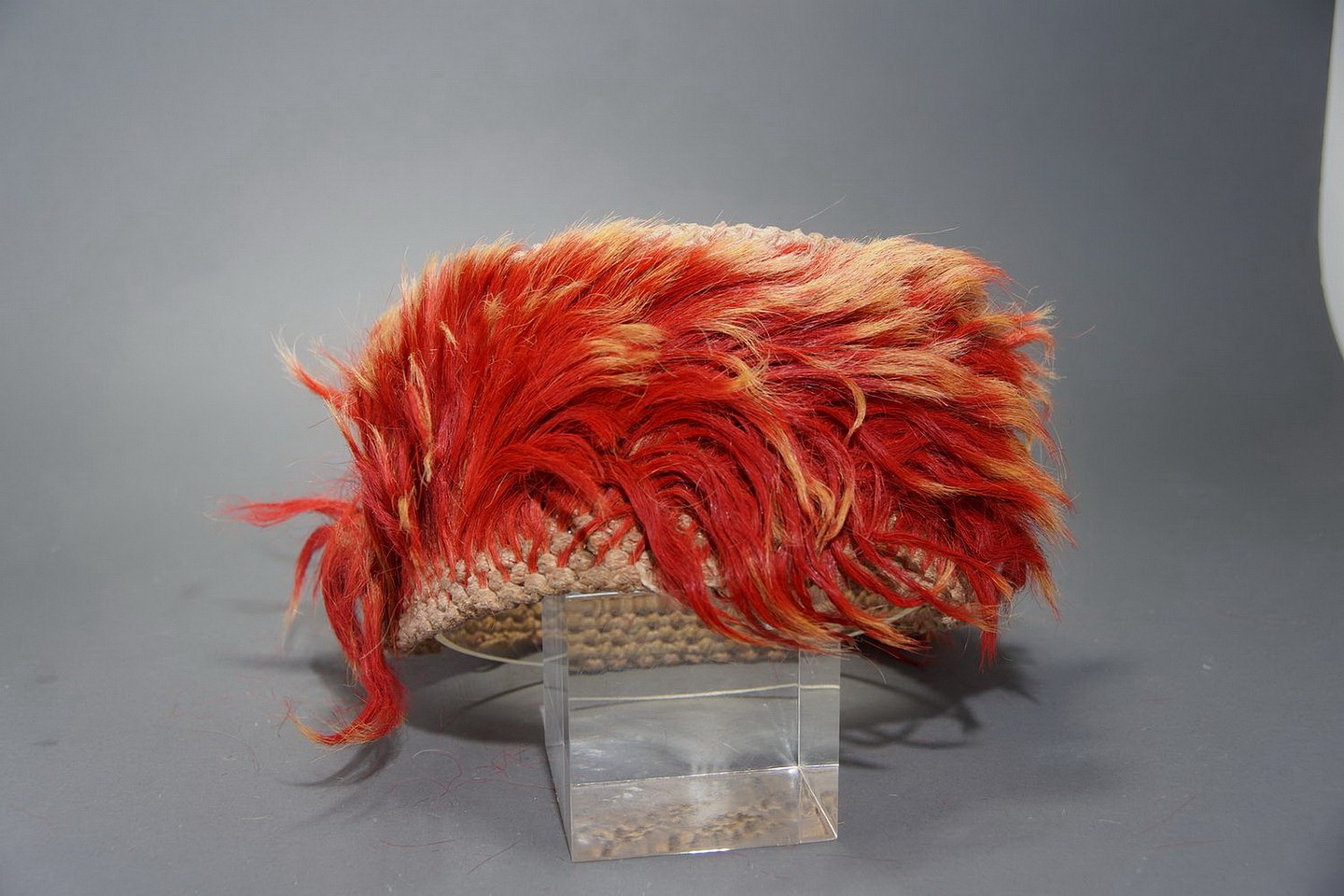




Peru, Nasca Headband with Orange Tie-dye Llama Hair
These unusual headbands are made of a cotton knotted mesh with shanks of llama hair tied into the knots. The inside does not show any of the shanks of hair.
Period: Peru, Nasca valley, South Coast, c. AD 400 - 800
Media: Textile
Dimensions: Diameter 7.5" x Height 4"
Condition: The colors are true without any fade.
Price Upon Request
p1040
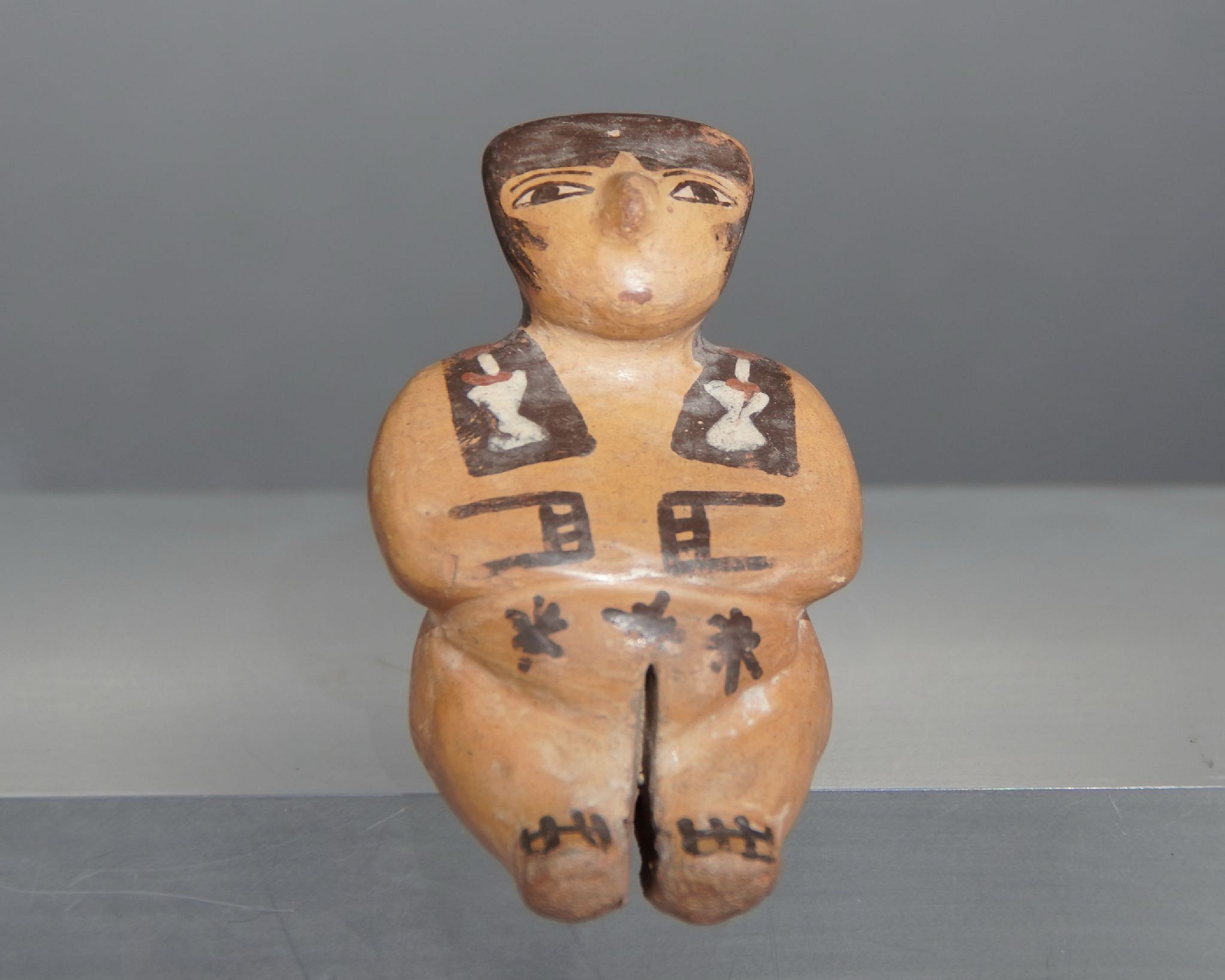





Peru, Nasca Miniature Female Seated Figurine
This seated ceramic female has hands painted on her belly, black hair painted falling over the shoulders, white hair ornaments, and tattoos painted on each buttock. The intricate tattoos depict the San Pedro cactus, which is known to have psychoactive properties. The archaeological record indicates that San Pedro cactus was likely used by the ancient Andeans as a libation during shamanic ceremonies. This figurine would originally have been dressed in a miniature woven garment, which was eroded or lost over time. A similar figure is illustrated in A Sourcebook of Nasca Ceramic Iconography, p. 146. Ex. collection Jean Lions, France.
Period: Peru, Nasca, South Coast, c. AD 400 - 800
Media: Ceramic
Dimensions: Length: 7.1cm
$1,800
M4049






Peru, Nasca Slit Tapestry Band with 8 Faces of The Proliferous Being on Red Ground
All eight faces are in the same orientation and alternate between two color arrangements: those with burgundy faces and those with red-orange faces. Each of the faces has a headdress with extensions, a mouth mask with extensions, and fingers holding a horizontal staff. One of the few Nasca tunics which depicts similar face bands and is same width is illustrated in TEIDOS MILENARIOS - ANCIENT PERUVIAN TEXTILES by Jose De Lavalle, page 264-5, ISBN# 9972-717-01-1.
Period: Peru, Nasca, South Coast, c. AD 400 - 800
Media: Textile
Dimensions: Lengtht: 45 1/2" x Width 6"
Price Upon Request
M6039
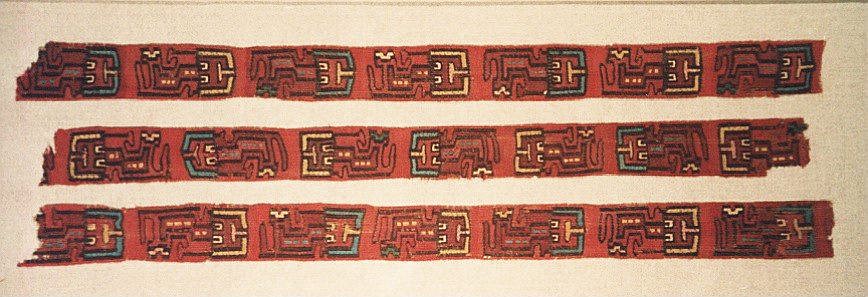


Peru, Nazca Border with 21 Abstract Feline Deities
A Nazca band decorated with seven abstract feline deities alternating in colors blue, yellow and maroon on red ground. The deities face upward, with hind legs and tails outlined in black. When the felines are rotates 90 degrees, they appear to be worms. A similar image is illustrated in Ancient Peruvian Textiles from the Collection of the Textile Museum, plate 17.
Period: Peru, Proto-Nasca, South Coast, c. 100 BC - AD 200
Media: Textile
Dimensions: Length: 20" x Width: 7"
$1,800
94178a
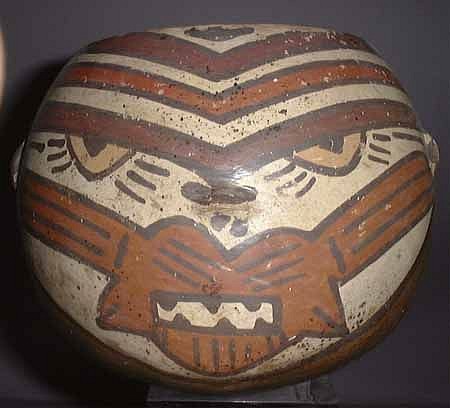
Peru, Nazca Ceramic Bowl with puma head wearing a mouth mask
This large and colorful bowl is decorated with a feline type face wearing a fanged mouth mask with flaring whiskers. The nose, ears and chin are subtly raised. The forehead is decorated with a succession of chevron stripes and the back of the vessel is decorated with two series of semi-circular motifs floating on a band of warm dark brown. The shape of the vessel is globular and the color scheme is maroon, sienna, cream, tan and black. Trophy heads are represented with the most frequency on these vessels. With the exception of foxes, animal portrait masks are seldom represented on this type of vessel. Ceramic vessels with similar masked iconography are featured in "Nasca Geheimnisvolle Zeichen im Alten Peru," Museum Reitberg Zurich, 1999 (exhibition catalog).
Period: Peru, Nasca, South Coast, c. AD 400 - 800
Media: Ceramic
Dimensions: Height 6 1/2" x Diameter 6 1/2"
Price Upon Request
97130






Peru, Nazca kilim-style border to tunic with alternating zig zags
The zig-zags on this border are separated by bold triangular fields with ivory, blue and orange on brown ground. This weaving is one of the vertical side borders to the tunic.
Period: Peru, Sihuas II, Southern Andes, circa 100-AD300AD
Media: Textile
Dimensions: Length 83" x Width 14 1/2"
$11,500
91091
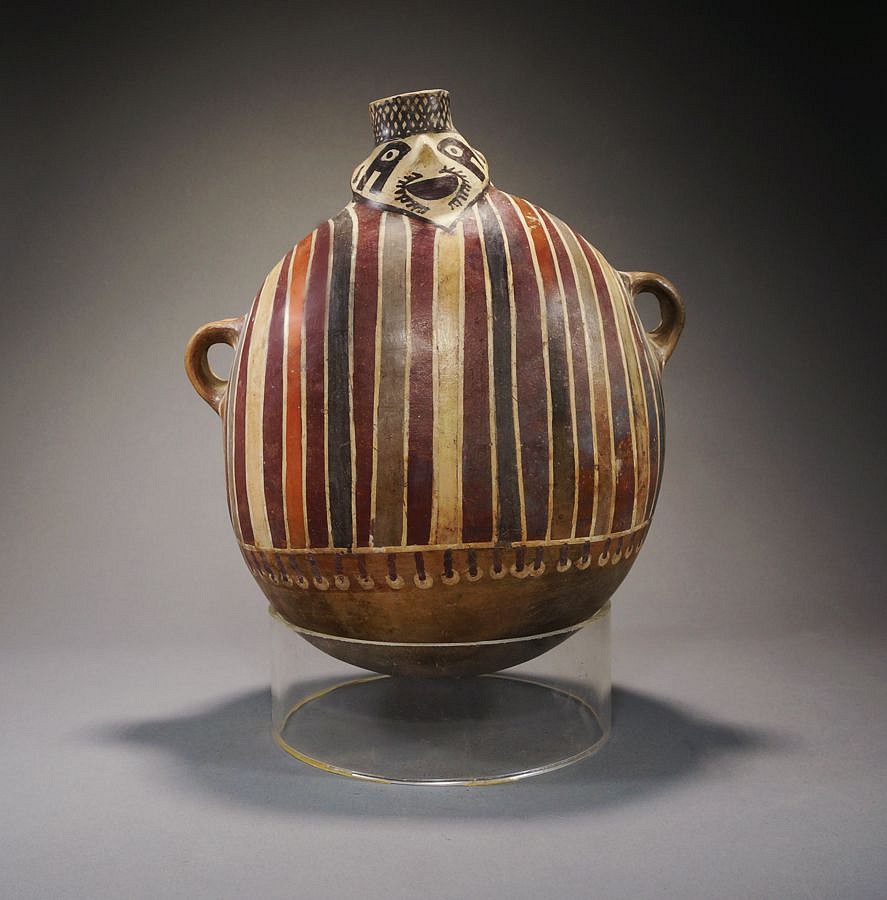


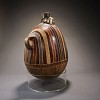

Peru, Nazca lug handled vessel wearing a striped tunic
The figure is wearing a woven read headband and has a painted mustache with bird head decoration for his eyes. He is wearing a colorful stripped tunic with fringe, which is typical for Nazca weaving. This lug handle vessel was made for carrying Chicha or corn beer with a temp line passing through the lug handles so that it could be carried on a person's back.
A similar vessel wearing a tunic is illustrated in CATA PGP DE A CERA OCA MAZCA, by Concepcion Blasco Busqued, 1991, Madrid, pg 94.
Period: Peru, Nasca, c. AD 400 - 800
Media: Ceramic
Dimensions: Height 11" x Width 10"
Price Upon Request
n3042
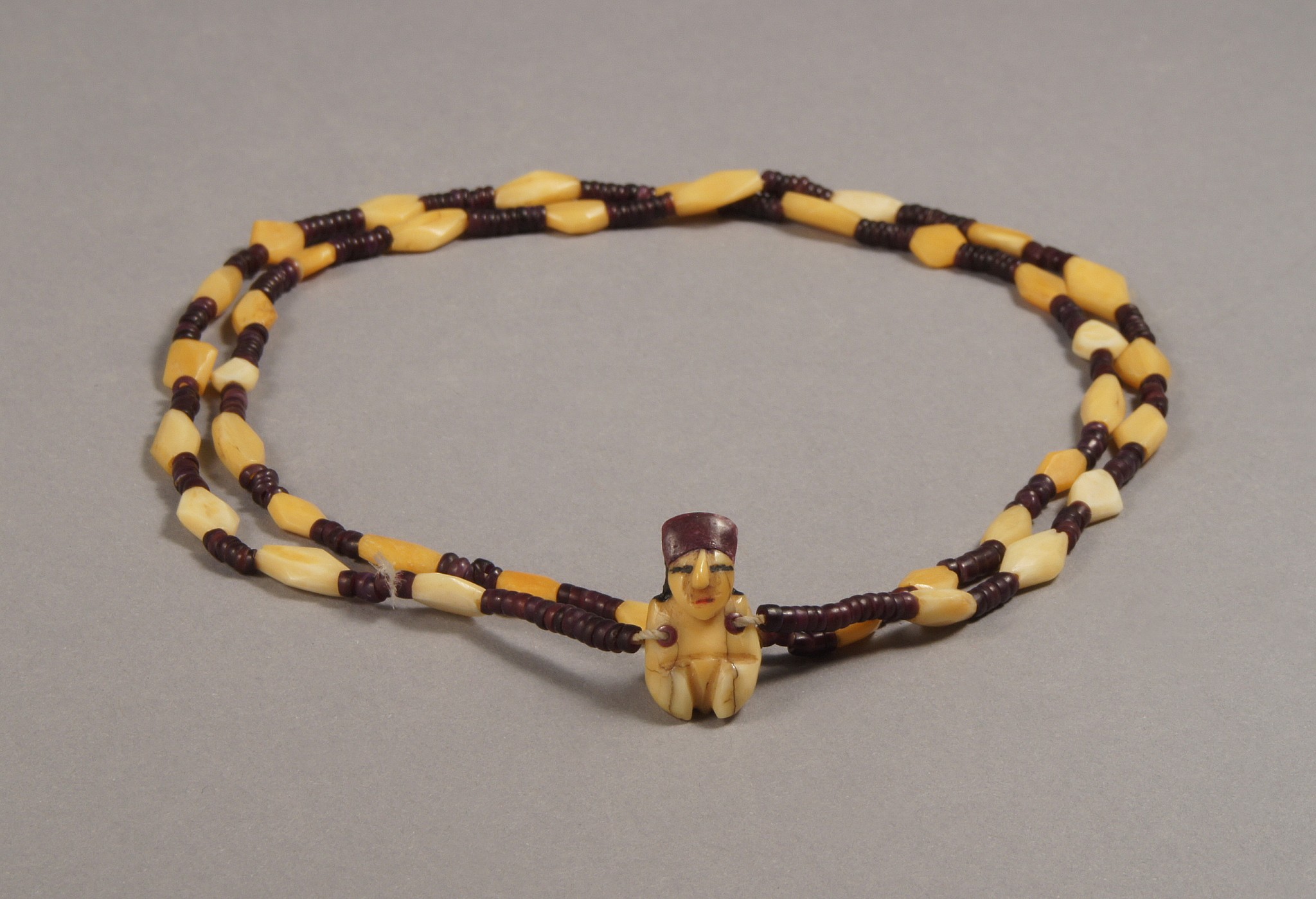





Peru, Nazca necklace with bone and syondylus beads and a minature female pendant
The necklace is made of 32 carved bone beads separated by 6 dark purple circular beads. The pendant is a classic Nazca miniature carved female with traces of painted eyes and mouth. The head piece of purple shell is missing. It's possible that the pendant is made up of Whale tooth ivory. A similar type of figurine is illustrated in 'Miniature Size, Magical Quality - Nasca Art from the Glassell Collection', Marzio, pg 59; and in 'The Inka Empire And Its Andean Origins', Morris and Von Hagen, p.87.
Period: Peru, Nazca, South Coast, circa AD400-700
Media: Bone
Dimensions: Length 68 cm. size of pendant H.1.4cm W. 5cm
$6,500
N1010
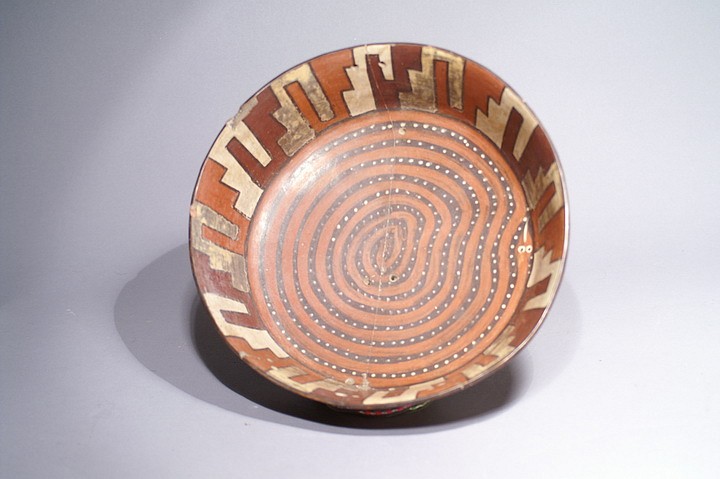
Peru, Nazca Polychrome Dish with Serpent Motif
This wonderful Nazca ceramic dish is painted with a spiral serpent motif at the bottom. The serpent is painted with a pattern of white dots. The inner edge of the dish’s high wall is painted with a step-fret pattern in alternating in colors of maroon, white and orange. The step-fret motif likely represents stairs to a temple or stepped agricultural plains, both of which were important to the Nazca. On the outside rim of the dish are 10 painted zoomorphic faces with long noses. The bottom of the dish is painted black. There is evidence of ancient repairs made to the dish, which can be seen via small drill holes made on each side of a crack and binding applied to the crack. Benno Mattel collection, Punta del Este, Uruguay.
Period: Peru, Nasca, Proto Phase, South Coast, c. 100 BC - AD 200
Media: Ceramic
Dimensions: Diameter 9 1/2" x height 2 1/2"
Price Upon Request
N1032
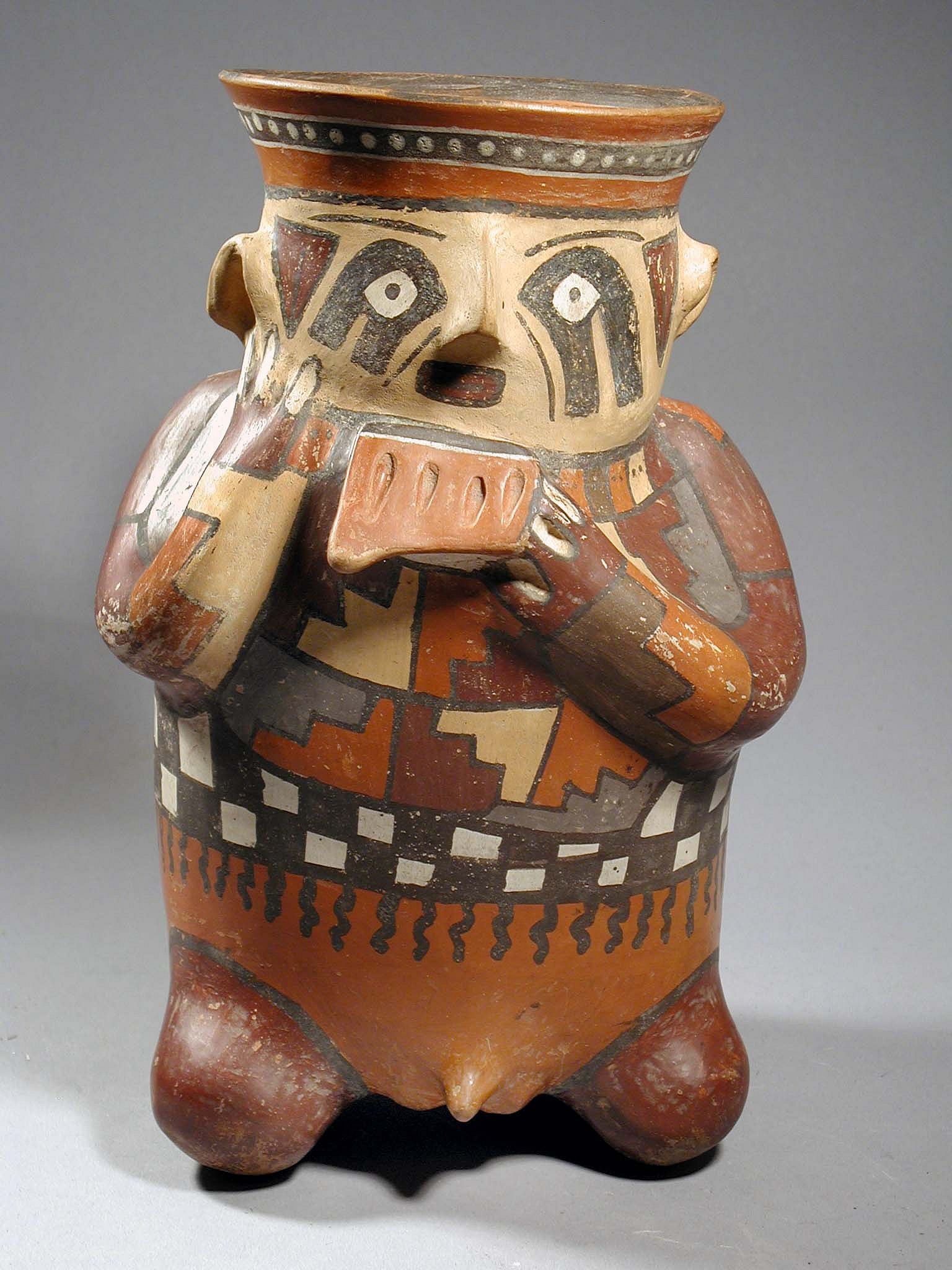




Peru, Nazca Polychrome Effigy Jar with Flute Player
This is one of the few effigy figures in the Nazca ceramic sequence that portrays a musician. The figure is holding a five chambered panpipe in his right hand and has his left hand to his cheek. He is elaborately dressed in patchwork tunic, with a black and white checkered undergarment. Around his neck is a series of plaques in alternating colors of beige, brown and gray. On top of his head is a polka dot band in grey. Below he is wearing a red/brown loin cloth covering prominent genitals. The musician has facial decoration, including black condor profile heads around the eyes and red triangles in front of his ears. This figure is illustrated by Lavalle "Nazca" (1986: 132).
Period: Peru, Nazca Valley, South Coast, circa AD 600 - 800
Media: Ceramic
Dimensions: Height 9 1/2"
Price Upon Request
M3015
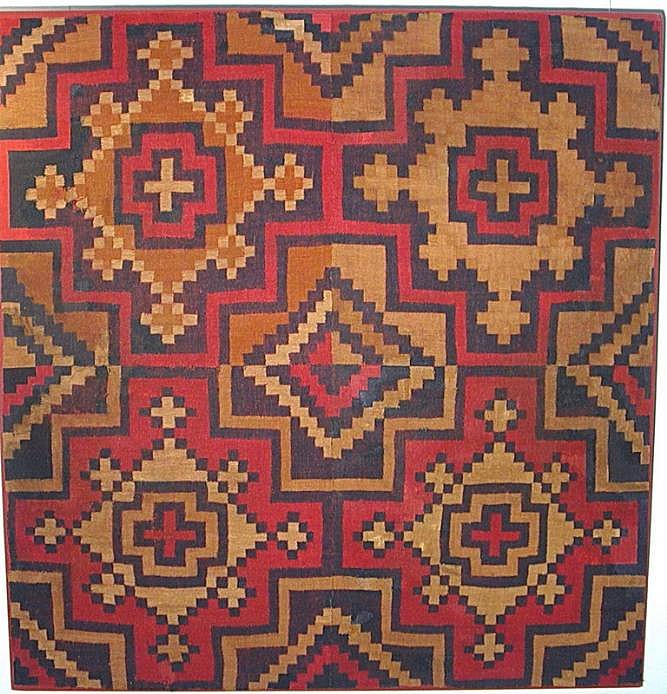
Peru, Nazca Scaffold Weave Panel with five diamonds in red and brown
This is a complete panel woven in scaffold weave with fine yarn, a technique also known as warp-interlock tapestry. Instead of the usual weft construction, the warp is interlocked with another of a different color. Here, the design consists of five diamonds with crosses inside, on alternating colored grounds of gold and red. This panel is illustrated in Mary Schoeser "World Textiles: A Concise History (2003: #62). A very similar example is shown in "Nazca: Arte y Tesoros del Peru (1986: 67).
Period: Nazca, South Coast, Peru, circa AD 400-800
Media: Textile
Dimensions: Length 42-1/2" x Width 40-1/2"
Price Upon Request
93176
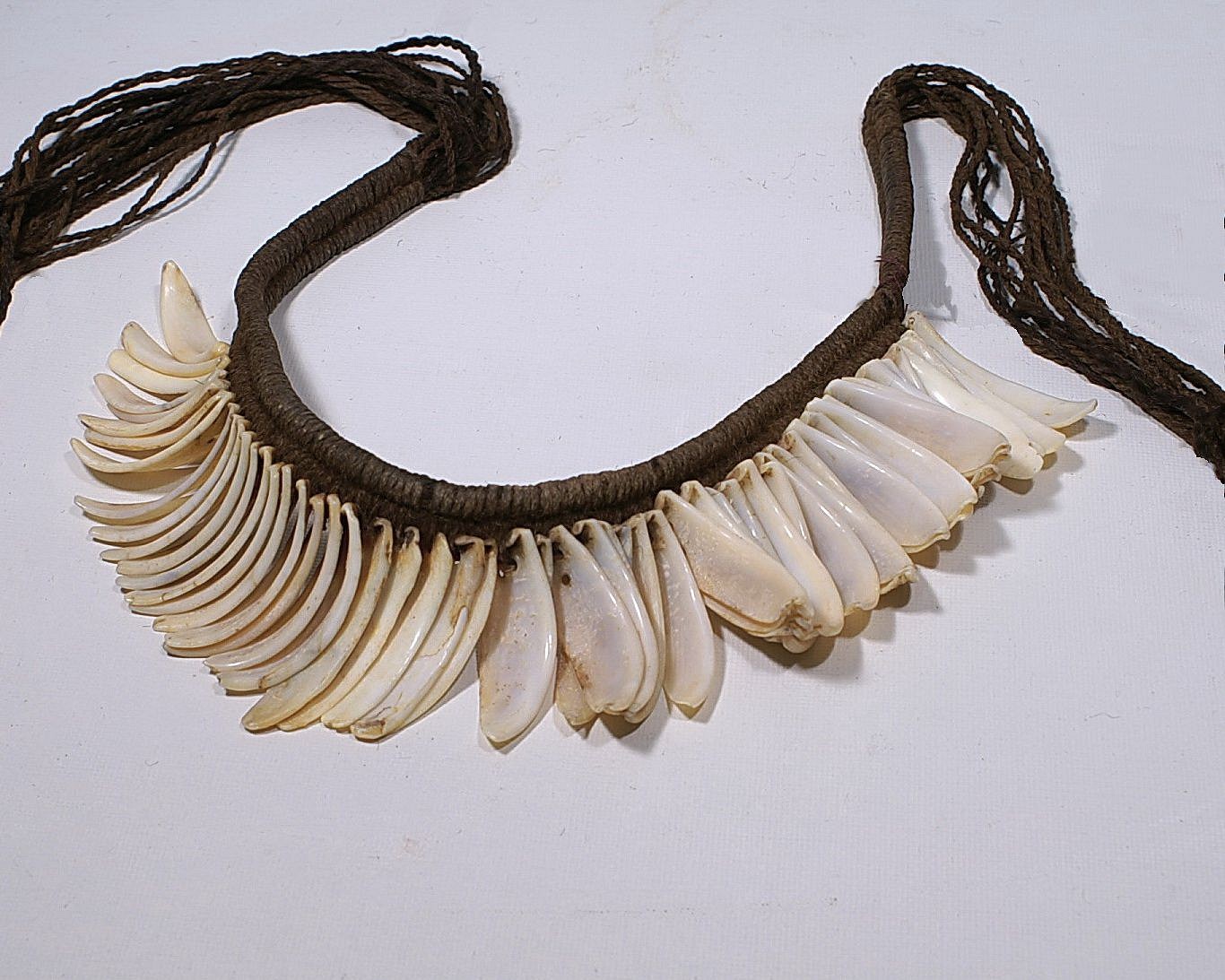




Peru, Nazca shell Necklace on Original Alpaca Cord
It is very rare to find a shell necklace with original stringing intact. This necklace is an excellent example of the Nasca culture's ingenuity in using the local marine resources. Each of the 55 shells is intricately tied to an elaborately knotted foundation cord. The shell appears to be a mussel or razor clam. A similar necklace is in the American Museum of Natural History.
Period: Peru, Nasca, South Coast, c. AD 400 - 800
Media: Shell
$3,200
99177
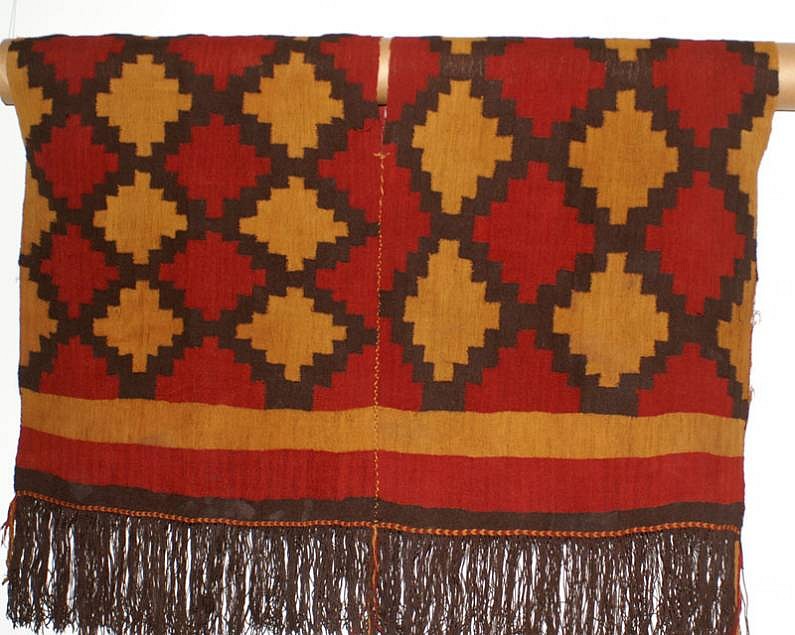
Peru, Nazca Tunic with bold stepped/diamond motif in red, brown and gold.
This scaffold-woven poncho is decorated with a series of complete stepped diamonds alternating in red and gold, outlined in brown. The bottom is bordered by gold, red and brown horizontal bands, with a narrow braid of twisted gold on top of a brown fringe. This tunic was made by two different weavers in the same workshop as seen by the slightly different sizes of diamonds. It's very rare to find a complete tunic intact and unopened.
Period: Peru, Nazca, Late phase, South Coast, circa AD600-800
Media: Textile
Dimensions: Height 34" x Length 42"
$30,000
93076
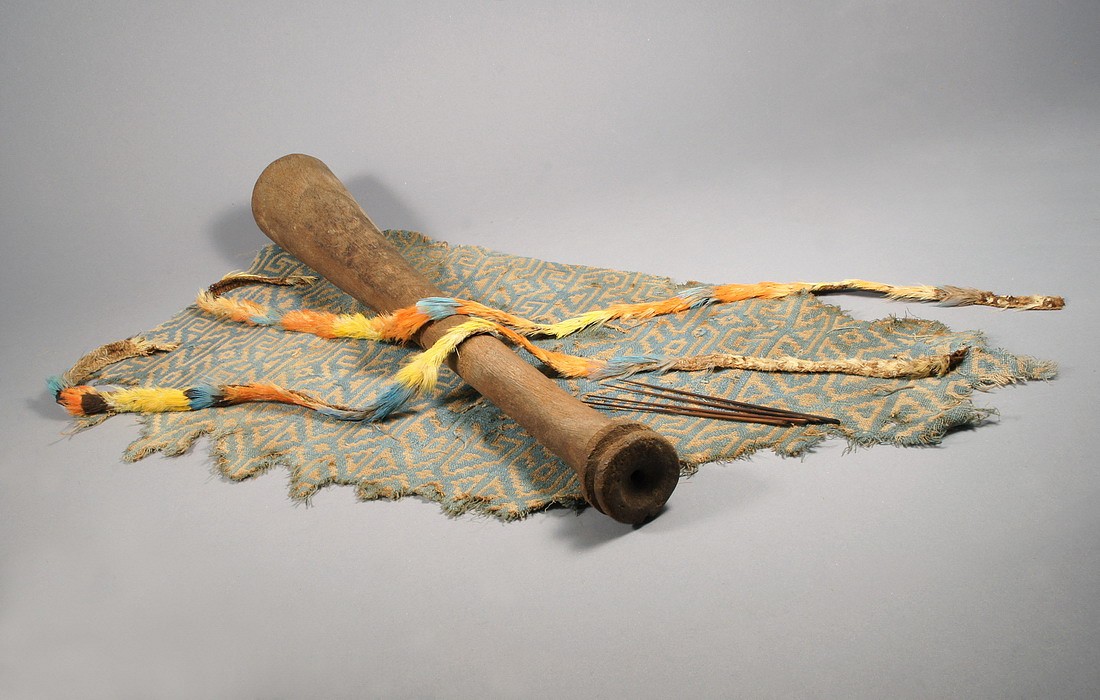



Peru, Nazca Wooden Blow Gun with Wrappings
The blow gun is made from one solid piece of wood. It is stone-carved on the inside, and drilled from the narrow center section to the mouth piece. There are very few examples illustrated in the material culture of ancient people using blow guns for hunting, except for one famous example on a Moche mouth ornament, illustrated in the Dora and Paul Janssen collection catalog "MASTERS OF THE AMERICAS" on page 254. In this example, two hunters are using short blow guns to kill birds on tree branches with cactus thorn darts. This particular blow gun was found with a fancy double weave cloth fragment and fine yellow feathers strung together - perhaps to decorate the blow gun or used for camouflage. Tree thorns were also found at the site, probably for use as darts.
Period: Peru, Nazca, Late phase, South Coast, circa AD600-800
Media: Wood
Dimensions: Length: 18 1/4" Diameter at End: 2 1/2"
Tapers to: 1 1/4"
Price Upon Request
n2045
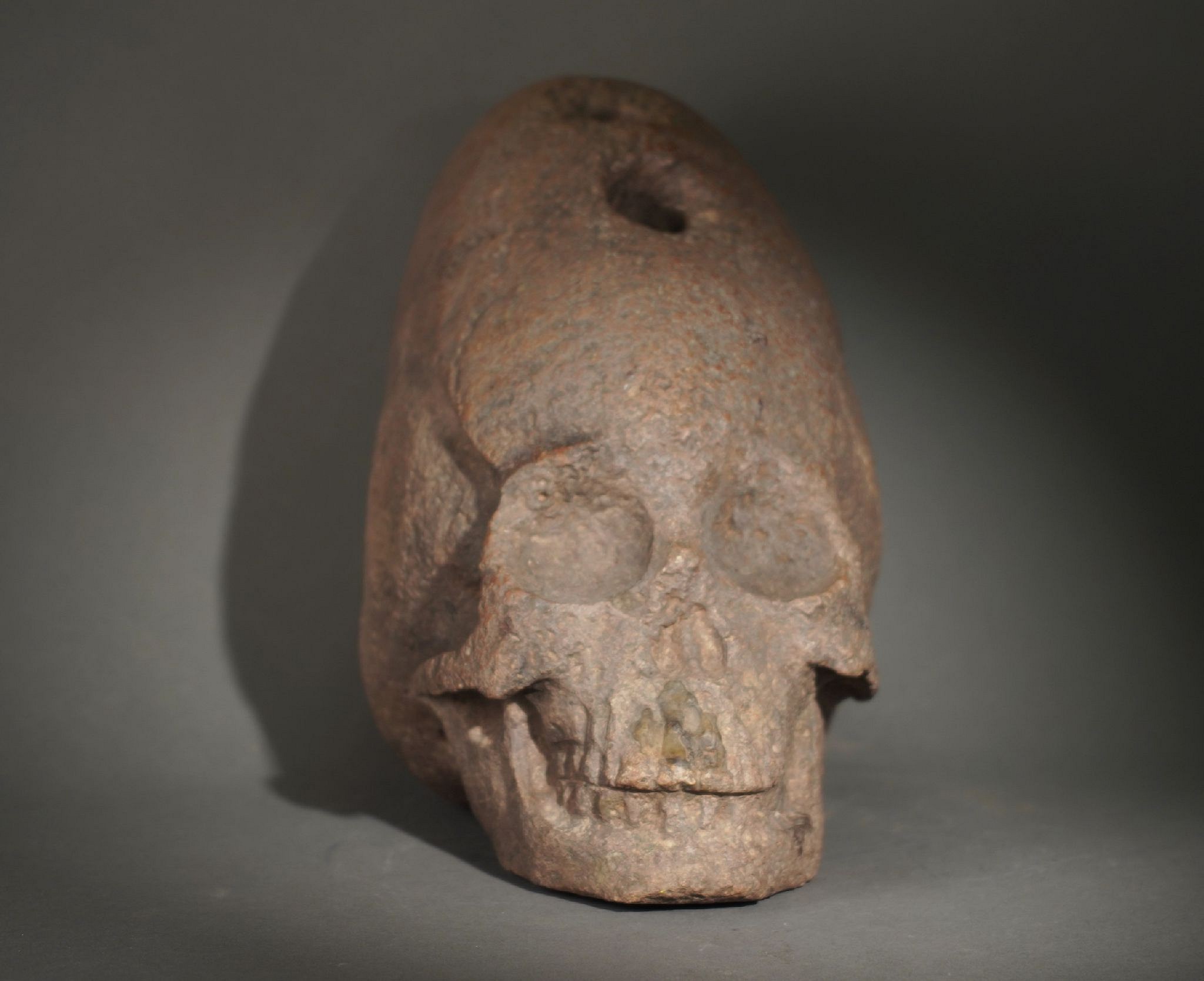
Peru, Official Archaeological Replica of Nasca Elongated Trophy Head
Some Andean cultures including the Paracas and Nasca would keep the skulls of enemy tribal leaders killed in battle as trophies of war. This late 19th century model is an exact replica of an elongated Paracas style trophy head which was dated circa 300 B.C. In keeping with the Paracas style, this trophy head has a set of suspensions holes on top. These holes would have allowed the victorious party to suspend a cord through the two holes for the purpose of displaying the trophy head as a sign of military and spiritual power. The ancient Andeans believed that the victor in battle acquired the spiritual properties of the enemies he killed. Authorized for export by the Peruvian government in 2011, with an official sticker at the base.
Period: Peru, South Coast, Late 19th Century
Media: Stone
Dimensions: Length: 11-1/2" x Height 7- 1/2"
$3,500
p1058
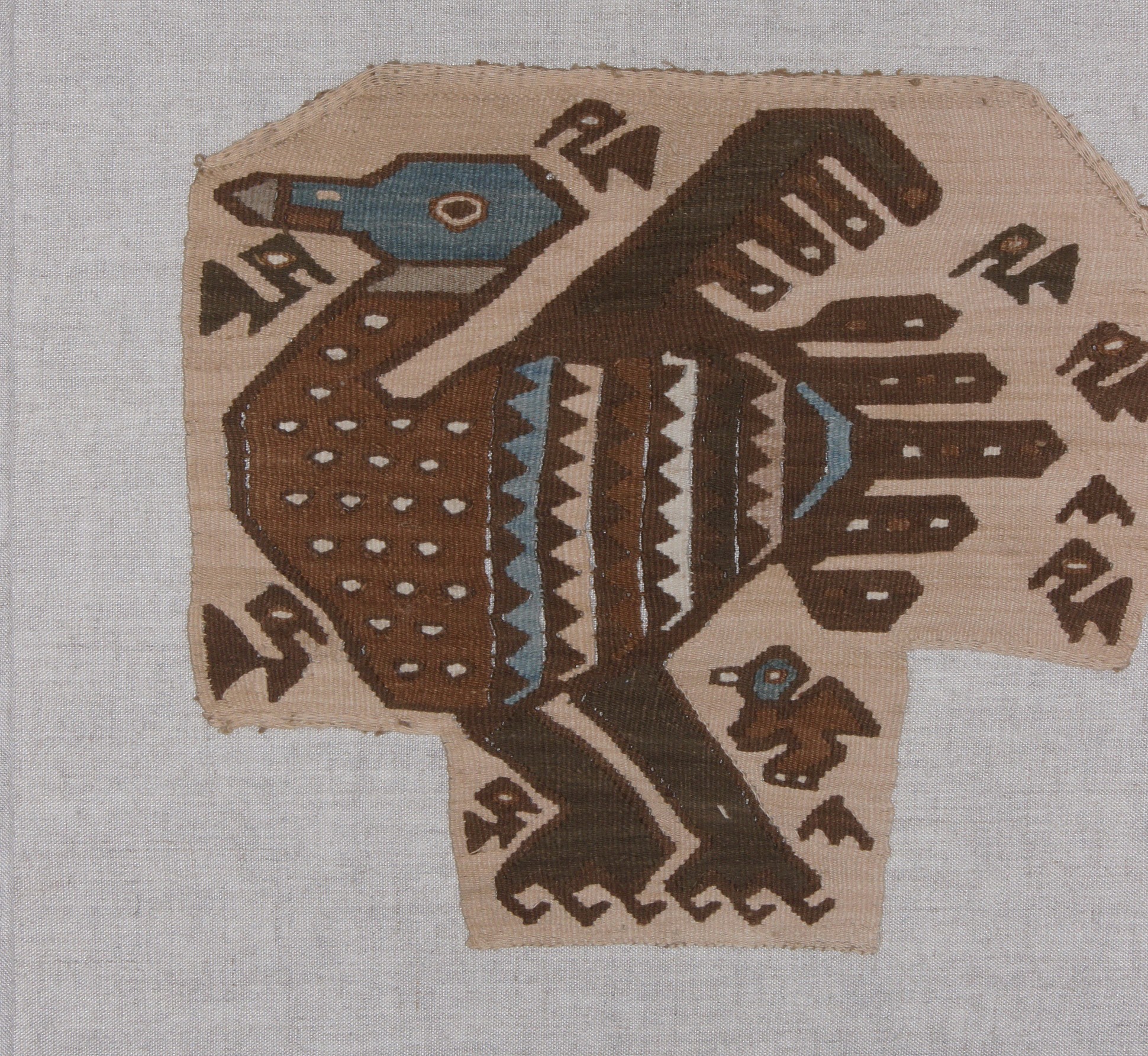
Peru, Pachacamac woven bird
This woven bird is brown, blue and white on a light brown ground, and has a smaller brown bird with a blue head behind it. There are a series of smaller, more stylized birds around the edge of the textile. It was originally woven to be an emblem for tunic and was part of a large cache which was woven for tribute. A similar bird is illustrated in TEXTILE ART OF PERU pg. 276. This is a good example of a woven shaped tapestry as it is not cut.
Period: Chimu, Pachacamac central Coast Peru circa 1100-1300A.D.
Media: Textile
Dimensions: Width 17" x Length 20" mounted / length 10 x width 9 in.
$7,500
93127
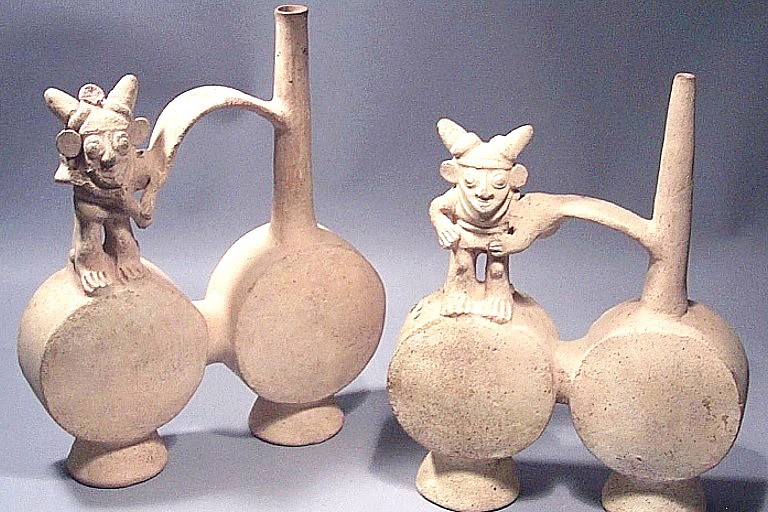
Peru, Pair of Chancay White, Double-chambered Whistling Vessels with figures
It is a rarity to find ceramic vessels in pairs that provide such excellent examples of the elegantly restrained aesthetics of the classic Chancay style. The presence of the musician figures atop one of the chambers on each vessel attests to the Chancay artist's stylish wit that cleverly enforces the sibilant properties of the vessels. Each is comprised of two circular chambers that connect at the sides. Each chamber sets on its individual pedestal, and a bridge handle links a tall conical spout on one of the chambers to a decorative musician figure identified by his double cone headdress and large earspools. When liquid is poured from one chamber to another the air between them is displaced, resulting in a whistling sound made through a fipple under the figure. Ceramic vessels in the Chancay style are illustrated and discussed in "Contemporaneidad del Arte Chancay," Museo de Arte de Lima (1998).
Period: Peru, Chancay, Central Coast, c. AD 1100 - 1430
Media: Ceramic
Dimensions: Height: 10" & 10 1/2"'
Price Upon Request
97000
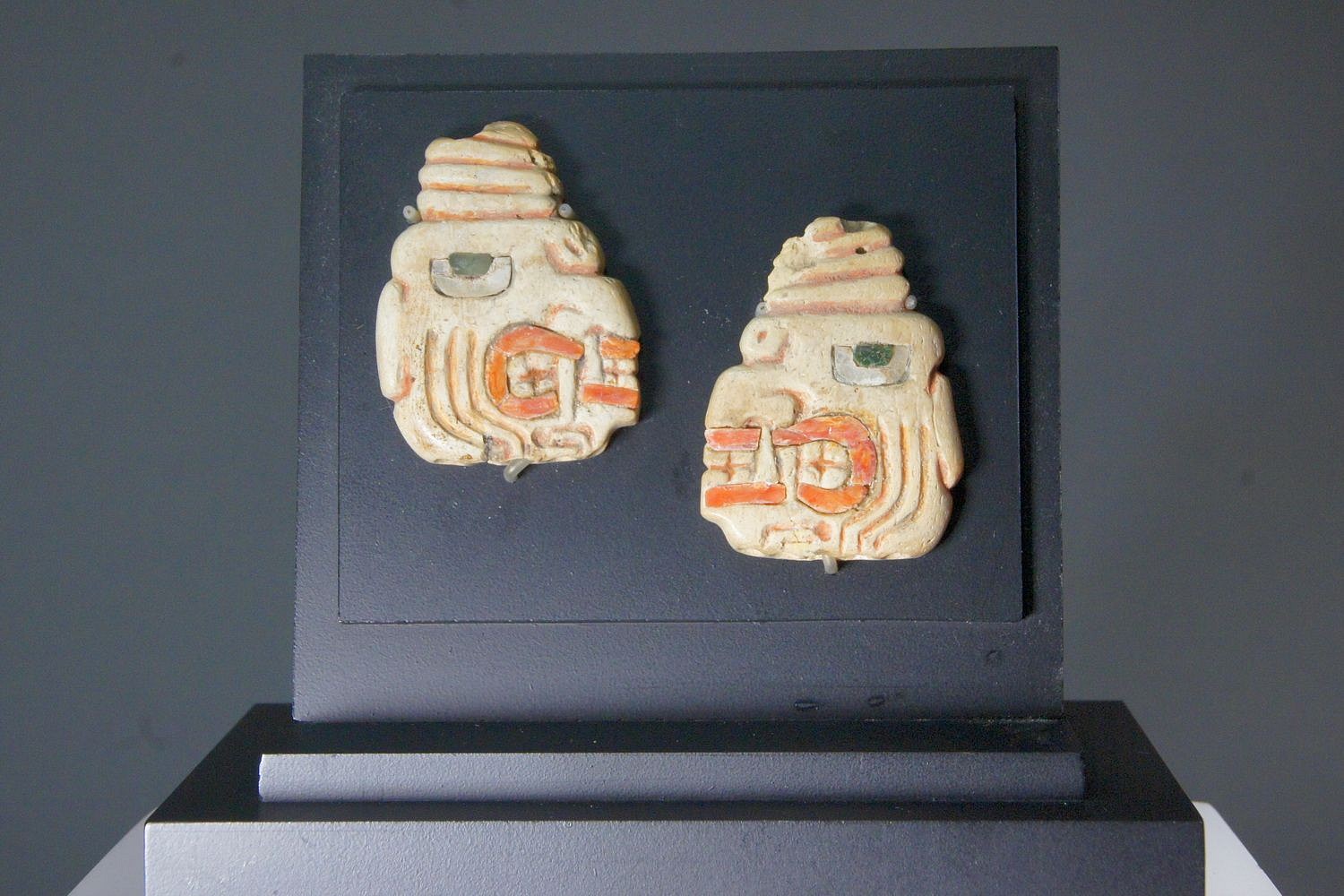


Peru, Pair of Chavi n Shell Ear Pendants with Fanged Deity Heads Wearing Turbans
This pair of ear pendants inlaid eyes with shell and turquoise pupils. The teeth are also inlaid with shell. Both profiles wear knotted turbans. The faces are similar to the large stone tenoned heads found at ChavÃn de Huantar. A similar pair can be found in the "Handbook of South American Indians," Volume II, Julian H. Steward, ed. (1963: pl. 62).
Period: Peru, Chavïn, Cupisnique, Middle Phase, North Coast, circa 1200-800BC
Media: Shell
Dimensions: Height 1 3/4" x Width 1 1/2"
$7,500
97137
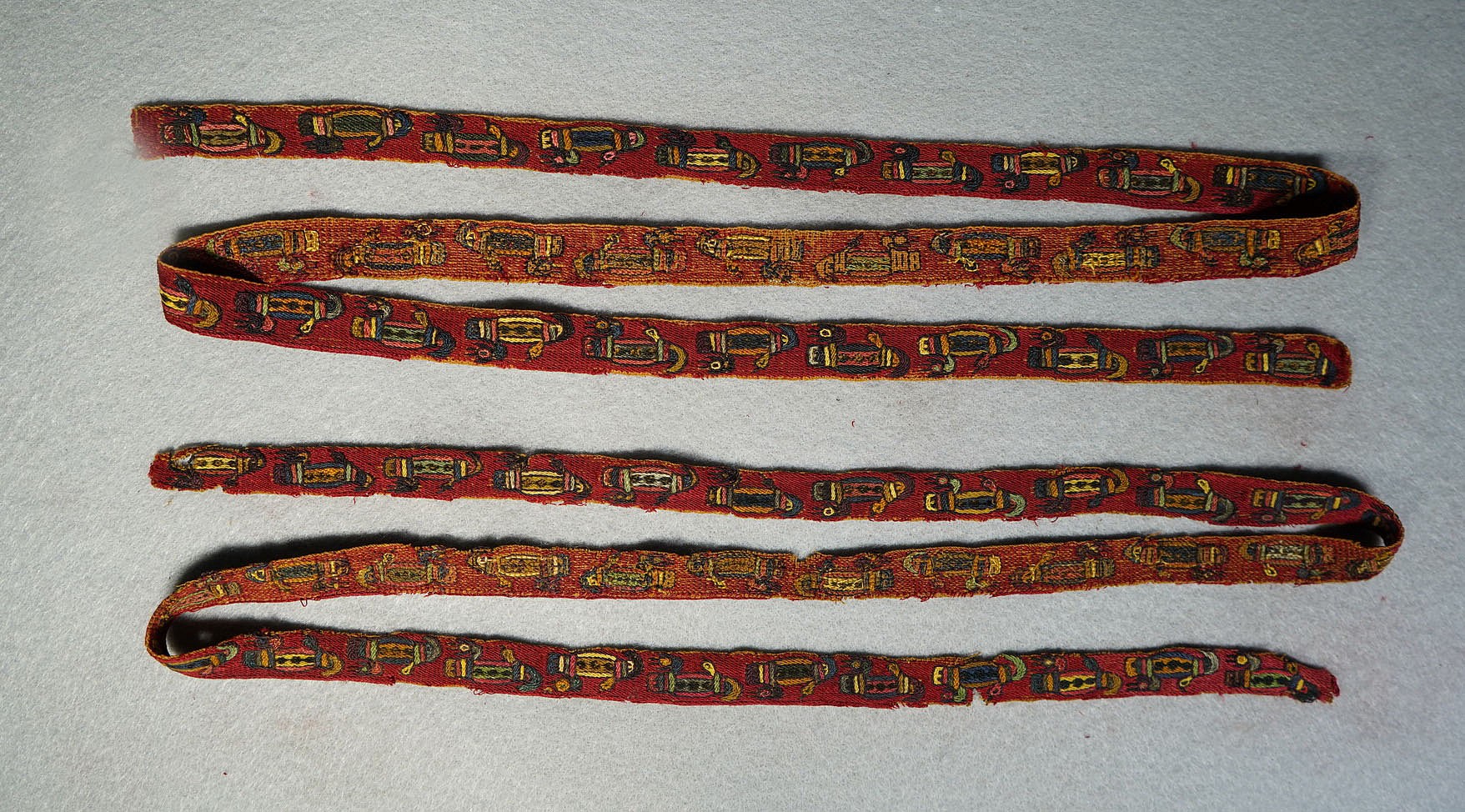




Peru, Pair of Proto Nazca Embroidered Borders with Duck Motif
Weaving technique: embroidery.
These colorful borders to a headpiece were woven with a continuous duck motif in alternating colors on a red ground. When held vertically, the images of ducks appear to be monkeys with faces turned forward, hands held up, and tails curving outward. The weavers used elemental plied wool embroidery, woven with colorful threads through a plain weave of undyed cotton ground fabric. Acquired in 1991 from a California collector prior to the 1980s. Unmounted.
Period: Peru, Proto-Nasca, South Coast, c. 300 - 100 BC
Media: Textile
Dimensions: Lenght: 40" x Width: 12 1/2" each
$2,000
91263
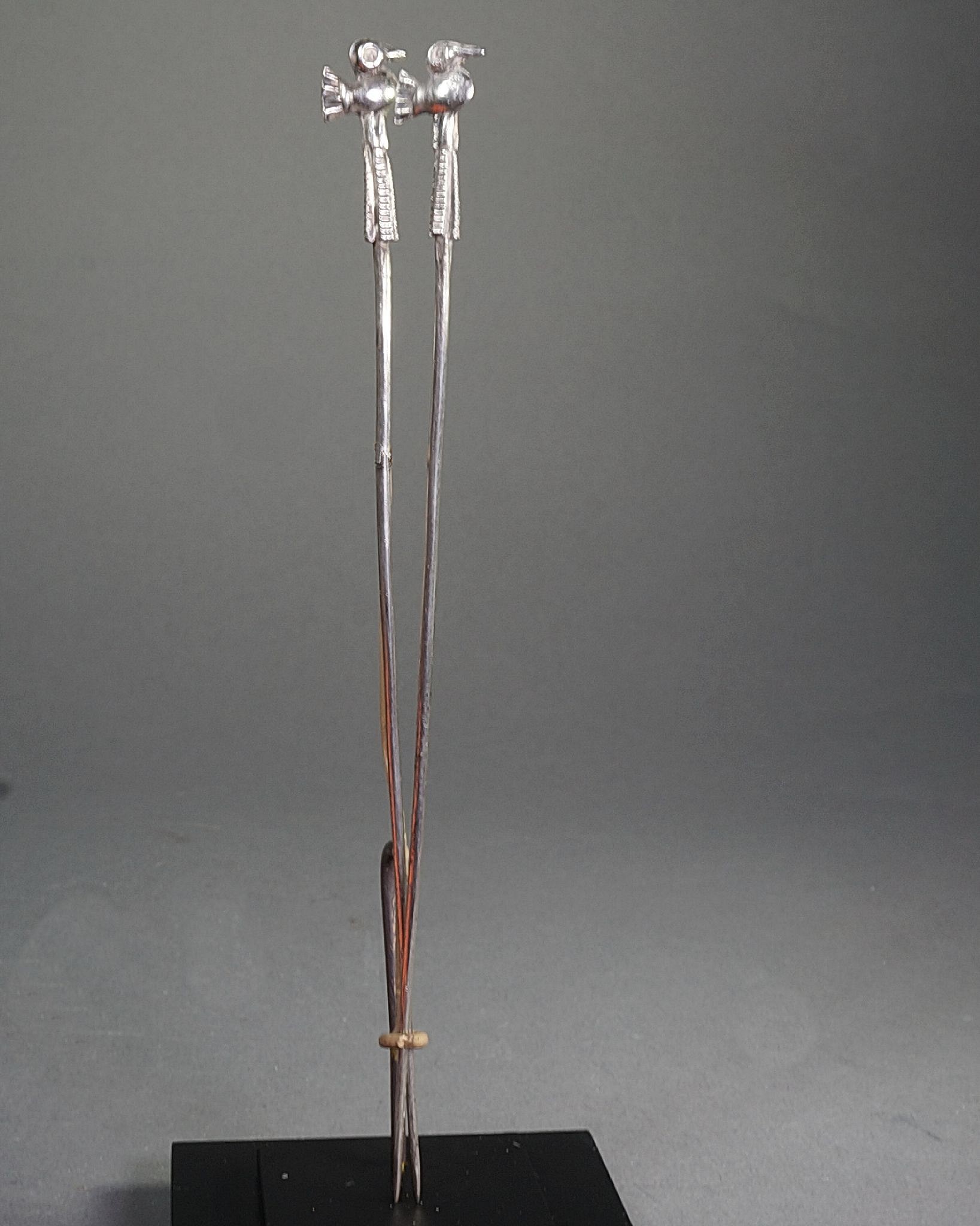


Peru, Pair of Silver Tupus with Identical Birds
Both silver birds created for this pair of tupus (garment fasters) are identical in structure and weight, which would have required great skill to execute. Each bird was made from a single flat sheet of silver, first cut out as a silhouette, then bent and rounded to create a three-dimensional form. The birds sit atop of corn stalks, which are in turn soldiered to the shafts of the tupus. The tupus shafts are made of solid silver.
Period: Peru, Chimu, North Coast, c. AD 900 - 1350
Media: Metal
Dimensions: Length: 5 3/4" x Weight: 4.4 grams each
$2,000
MM612
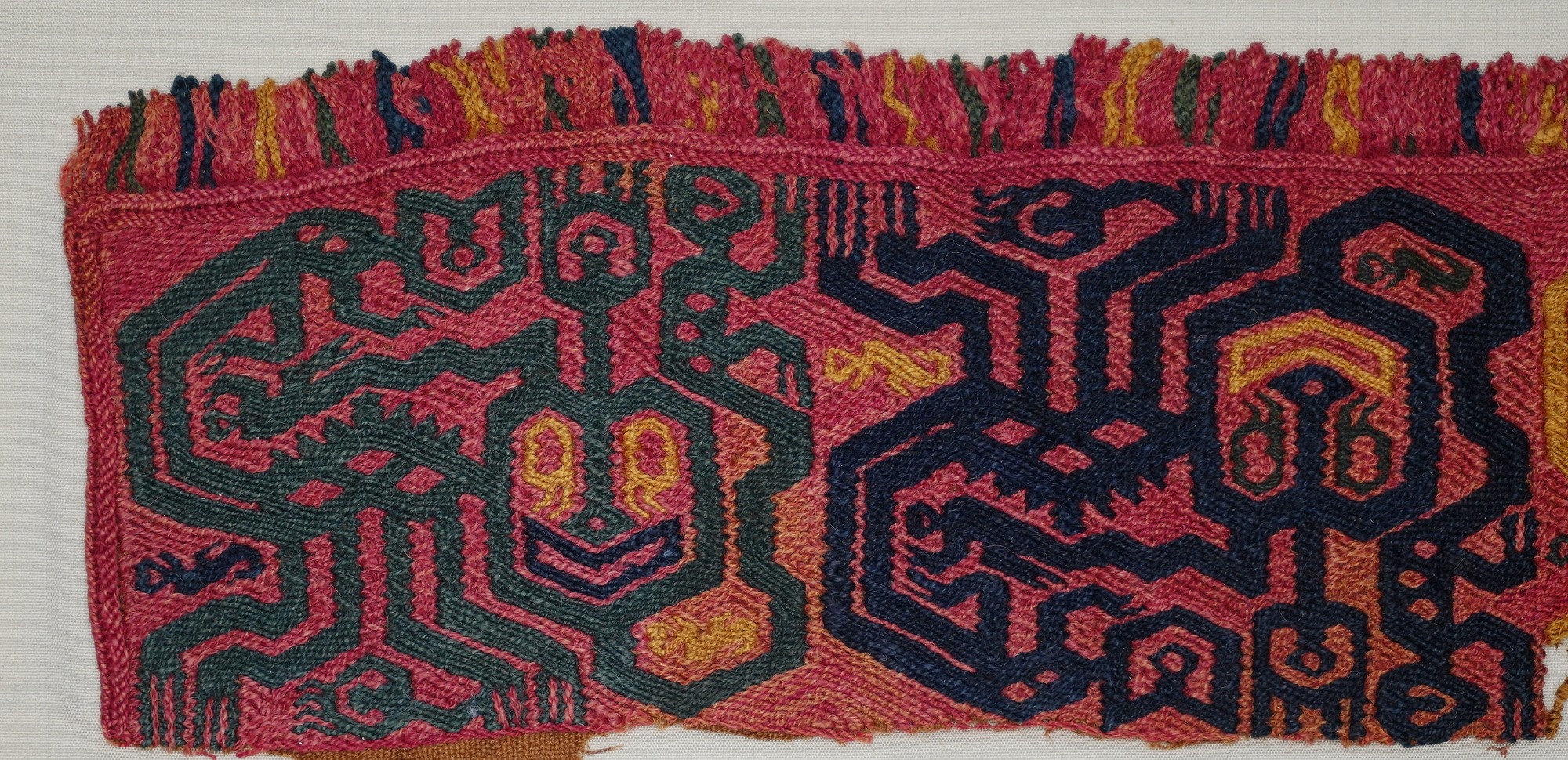
Peru, Paracas Border Section with Three Colorful Felines on Red Gound
Paracas textiles served as a medium of communication between the realms of the living and the dead. This Linear style border section features three embroidered feline figures in alternating colors and positions. One edge has its original fringe intact. The feline figures represent the "Oculate Being," a prevalent theme occurring throughout the Paracas period. Here the feline motif is presented with an oversized, characteristically heart-shaped head with a wide smiling mouth and hexagonal eyes. Another geometricized form springs from the center of each of the feline heads. Long slender appendages forming the legs of the creatures end in forked claws or transform into smaller feline creatures. The plain weave red background and embroidered Oculate Being motifs are woven in green, blue, and yellow, creating a beautifully vivid contrast. This style is characteristic of the textiles that were found at the Necropolis at Wari Kayan. This textile is from the Early Horizon, Epoch 10. It is also illustrated in ANCIENT PERUVIAN TEXTILES by Ferdinand Anton, London, 1984, fig. 47. Ferdinand Anton collection prior to 1980. Good color and pressure mounted in a frame.
Period: Peru, Late Paracas, South Coast, c. 300 - 200 BC
Period: Peru, Late Paracas, South Coast, c. 300 - 200 BC
Media: Textile
Dimensions: Height: 3" x Length: 12"
Price Upon Request
92016
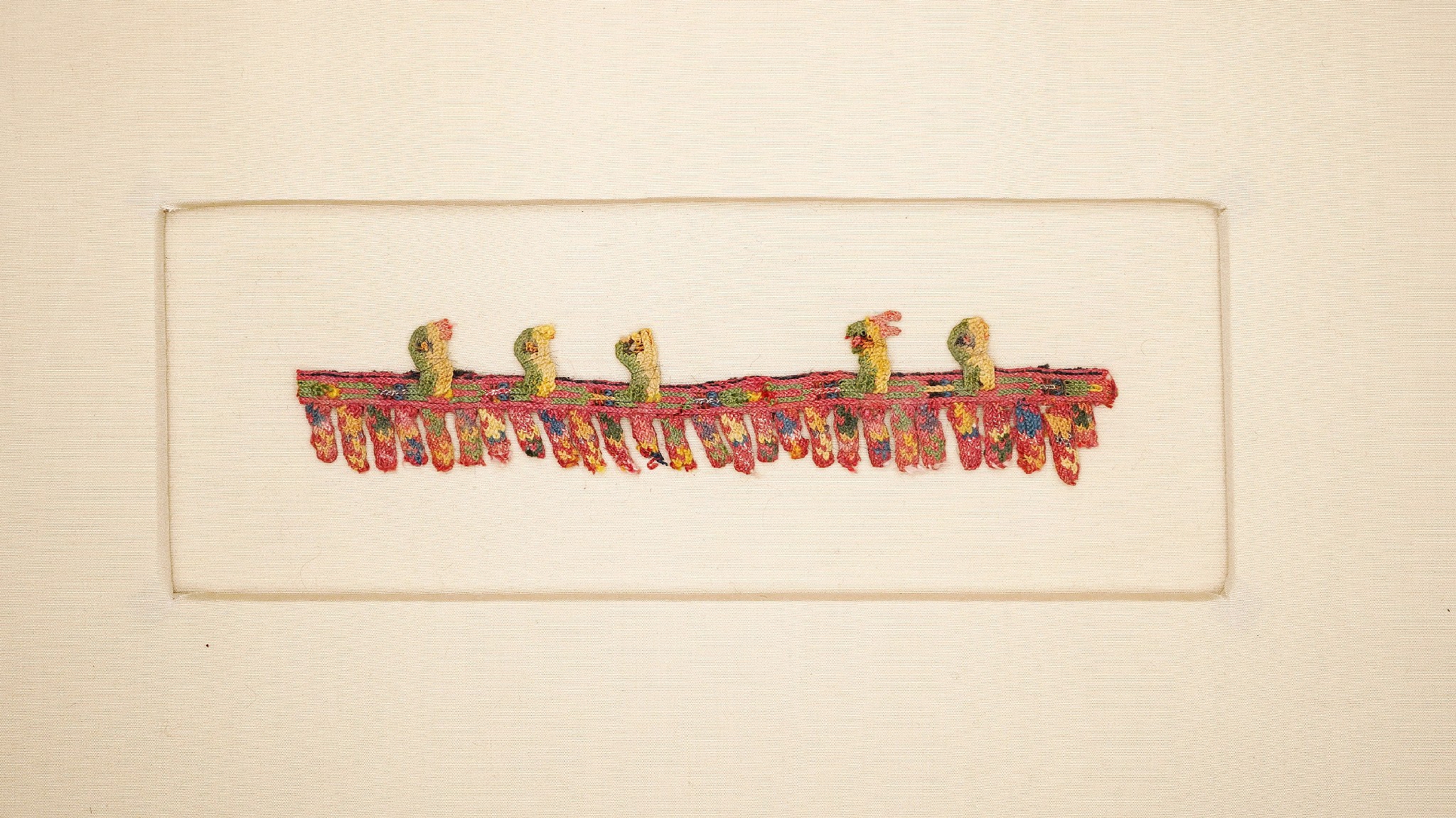



Peru, Paracas Border Fringe with Five Colorful Birds
This intricate border fringe was needle-knitted with a variety of colored threads made from natural plant and mineral dyes of the Andes. The border fringe depicts 5 baby birds waiting in a nest with heads craned upwards, eagerly waiting to be fed some worms. The fringe originally had six birds - one is missing to the right of center. Excellent color. Ex. collection Ferdinand Anton, Germany, prior to 1980. Mounted on neutral cream-colored mat.
Peru, Paracas, Late Phase, South Coast, c. 200 BC - AD 100
Period: Peru, Paracas, Late Phase, South Coast, c. 200 BC - AD 100
Media: Textile
Dimensions: Width: 6 1/2" x Height: 1 1/2"
Frame : 16" x 10"
$500
79040
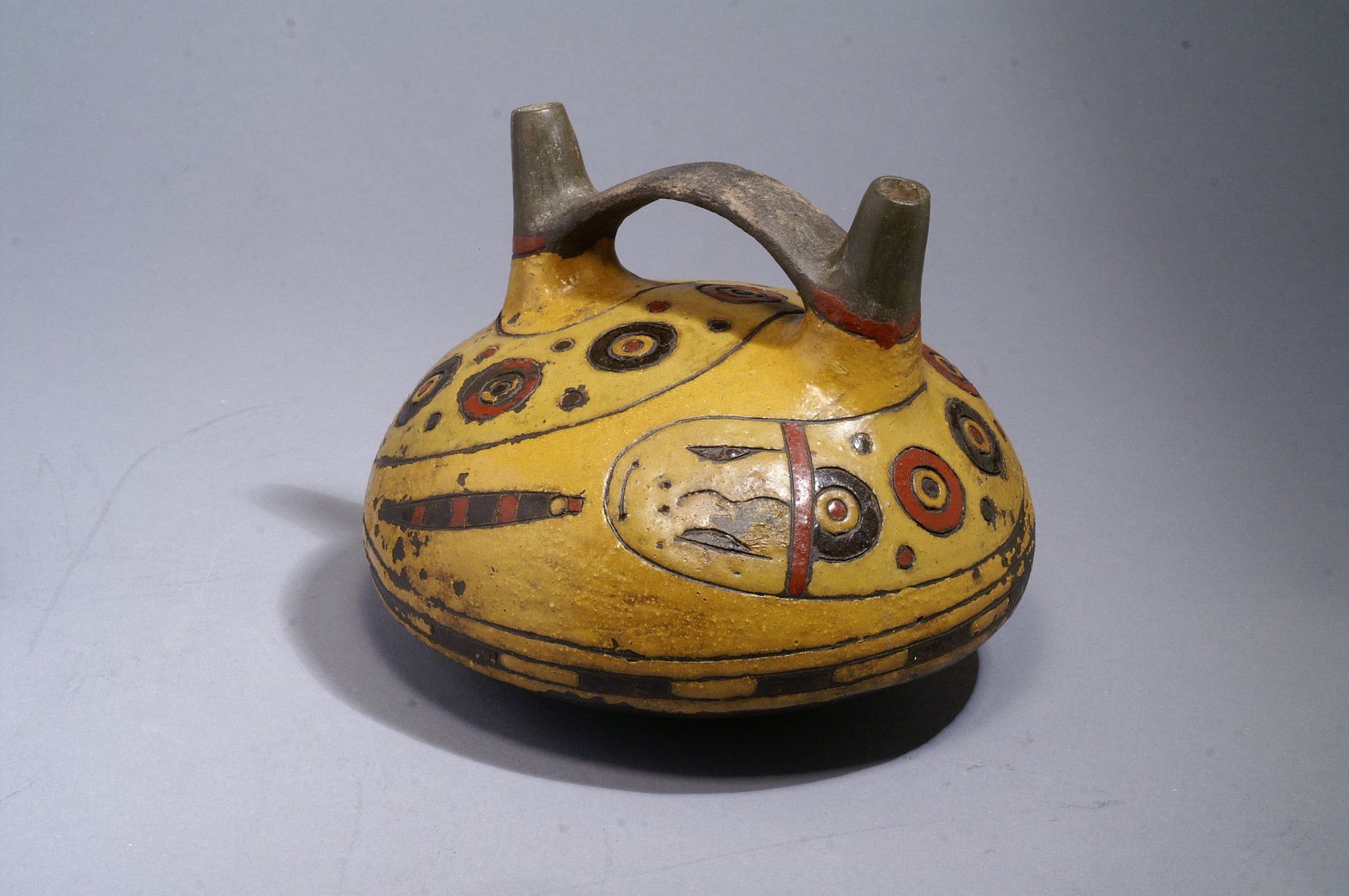



Peru, Paracas Bridge Spout Vessel Painted with Double-headed Undulating Eel
This vessel was painted with two neighboring hues of neutral yellow resinous paint, one for the ground and the other for the double-headed serpent. The rare color palette of this vessel departs from that of most Paracas vessels, which generally employ starkly contrasting colors. The animal depicted in the painting is probably an Amphisbaena, a species of worm-like snakes whose tails resemble heads as an evolutionary adaptation to fool predators. Acquired from a Miami collector in 2006.
Period: Peru, Paracas, Ocucaje Phase 9, Ica valley, South Coast, c. 300 - 200 BC
Period: Peru, Paracas, Ocucaje Phase 9, Ica valley, South Coast, c. 300 - 200 BC
Media: Ceramic
Dimensions: Diameter: 6 1/4" x Height: 5"
$8,750
M6088
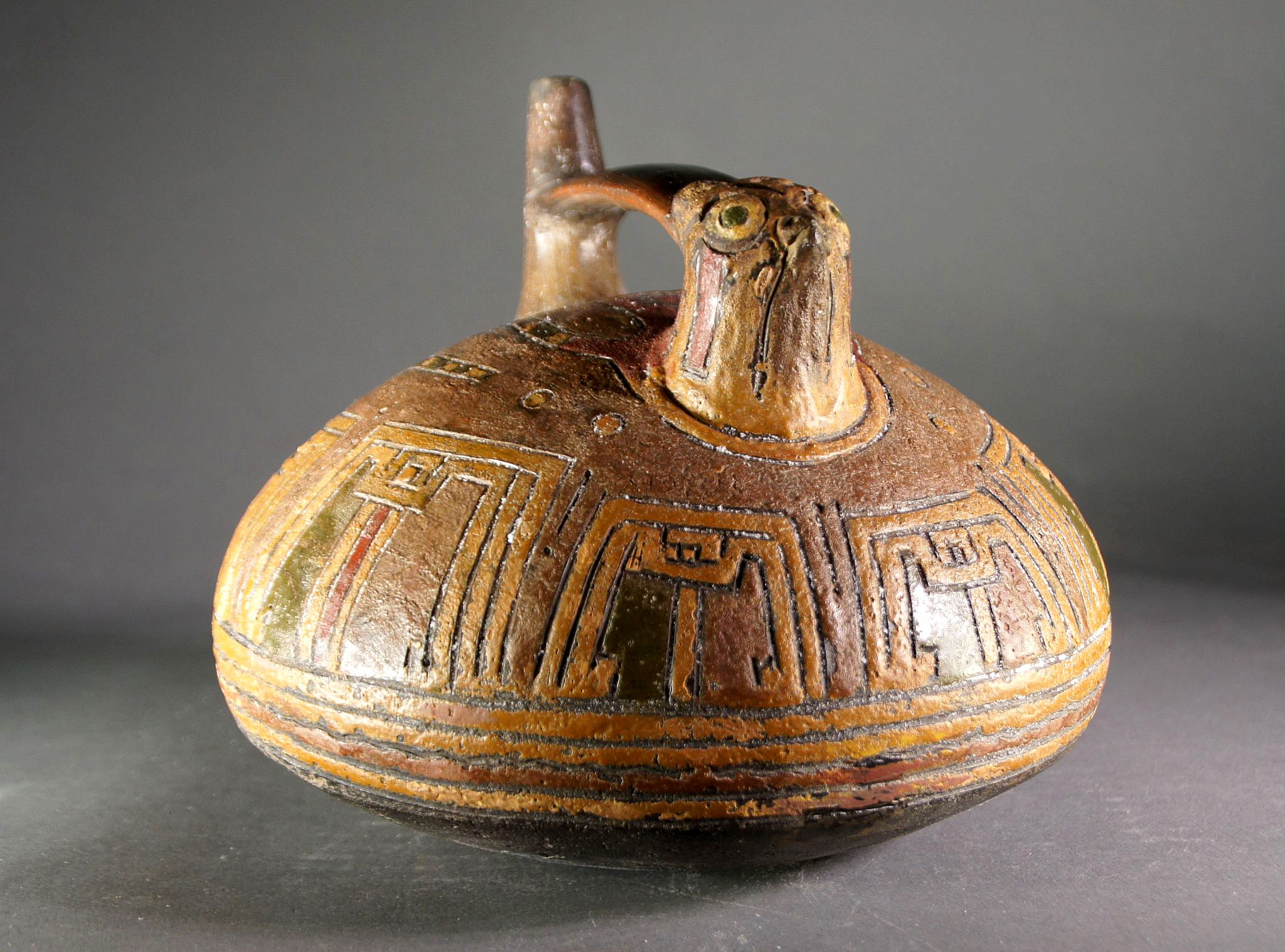







Peru, Paracas Bridge Spout Vessel with Falcon's Head
Peru, Paracas, Upper Callango basin phase 8, South Coast, c. 700 - 200 BC
This beautiful ceramic blind bridge spout vessel is crafted in the shape of a falcon with a sculpted head and incised drawings to create the falcon’s body and wings. The chamber was enhanced with a series of squarish "U" shapes, accented with a single Chavinoid eye in profile. The vessel is decorated with post-firing slip colors of red, green, brown, and tan. A similar vessel is illustrated ANCIENT PERUVIAN CERAMICS: THE NATHAN CUMMINGS COLLECTION, pages 116 & 117. A detailed discussion regarding these vessels can be found in THE PARACAS POTTERY OF ICA - A STUDY IN STYLE AND TIME on page 333.
Period: Peru, Paracas, Upper Callango basin phase 8, South Coast, c. 700 - 200 BC
Period: Peru, Paracas, Upper Callango basin phase 8, South Coast, c. 700 - 200 BC
Media: Ceramic
Dimensions: Height: 5 in. Diameter: 6 in.
Price Upon Request
n2044C
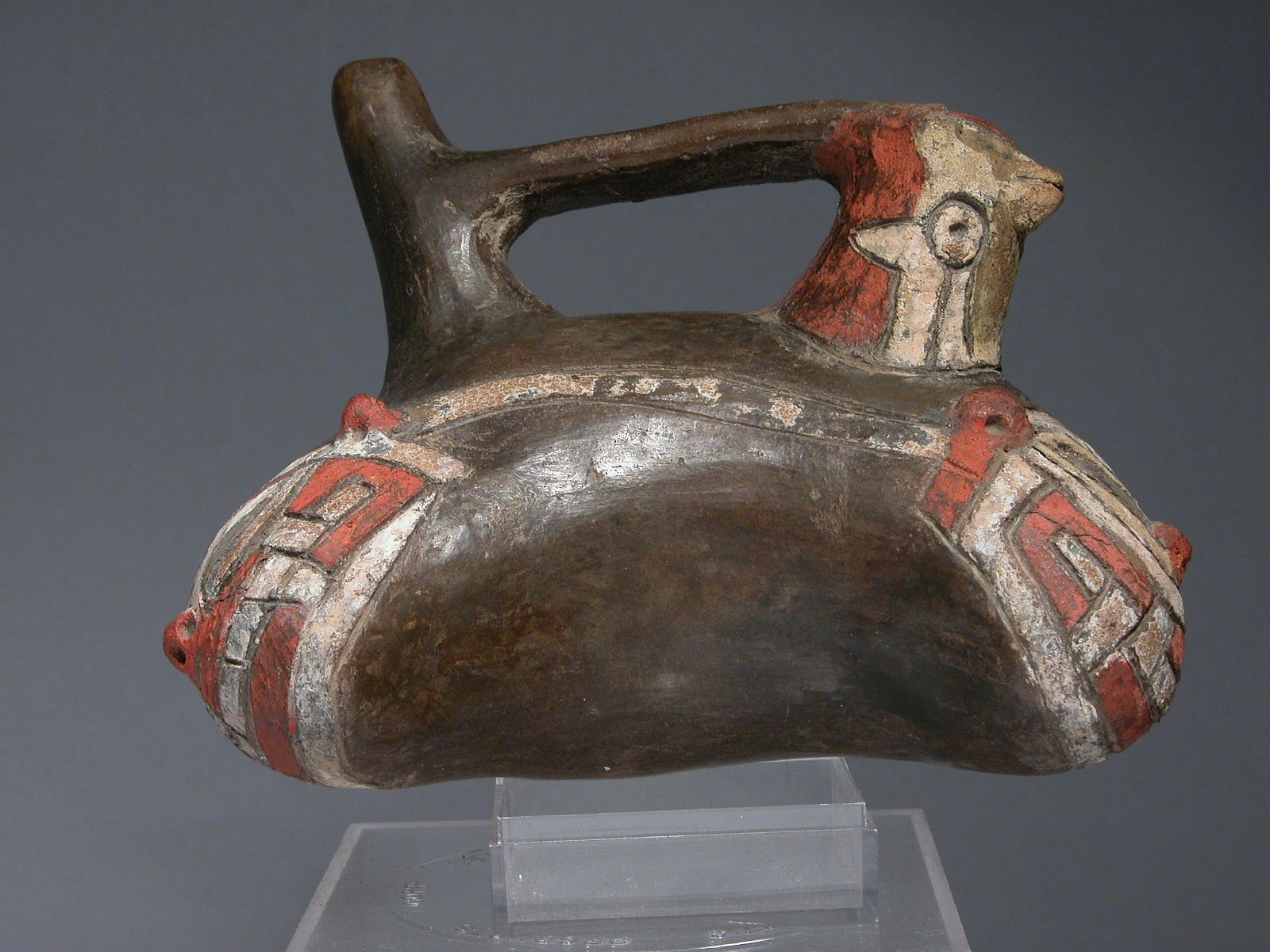
Peru, Paracas Callango Bridge Spout Effigy Vessel
This early "Callango" style vessel was painted with post-fire red and white pigments. This vessel combines two classic Andean elements: the eared falcon and the double-headed serpent. The bridge has a blind spout decorated with an eared falcon, while the body represents the double-headed Rainbow Serpent, a key figure in Andean cosmology. The double-head serpent motif originated during the Chavin period, and likely represents the Amphisbaena fuligoninos – a snake that appears to have two heads to intimidate predators. Both the eared falcon ad the double-headed snake motifs are illustrated in Christopher Donnan’s, "Ancient Peruvian Ceramics" in plates 51 and 2. Acquired from Christie’s in 1998, previously in an old estate prior to 1970.
Period: Peru, Paracas, Early Phase, South Coast, c. 900 - 600 BC
Period: Peru, Paracas, Early Phase, South Coast, c. 900 - 600 BC
Media: Ceramic
Dimensions: Length: 5 1/2 x Height: 4"
$4,750
98429b
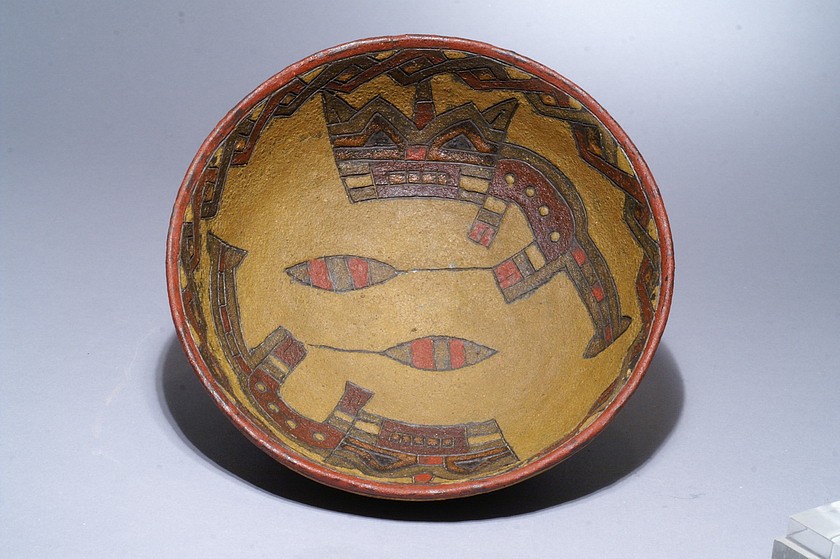
Peru, Paracas Ceramic Dish with Two Cats
Paracas ceramicists decorated much of their pottery with incised designs painted with post-fire fugitive pigments. In this example, two reclining felines adorn the interior sides of the bowl each holding a fruit or vegetable. Because of its relatively large size it suggests that it is Manioc, which is highly nutritious. Feline motifs and geometric images were common in early Paracas pottery. (Sawyer 1966: 108-109). On the outside of the bowl is a wide band in dark green with diamonds in alternating colors. Dawson identifies this design as Middle Phase Ocucaje 8 due to the facial details on the felines and the flared tail tips.
Very similar cats are illustrated in THE PARACAS POTTERY OF ICA, PAGE 359 & 360 figures 41 b& 42b.
Acquired by David Bernstein in 2006.
Period: Peru, Paracas, Ocucaje Phase 7, Ica valley, South Coast, c. 300 - 200 BC
Period: Peru, Paracas, Ocucaje Phase 7, Ica valley, South Coast, c. 300 - 200 BC
Media: Ceramic
Dimensions: Diameter: 6 1/4" x Height: 2 3/4"
Price Upon Request
M6086
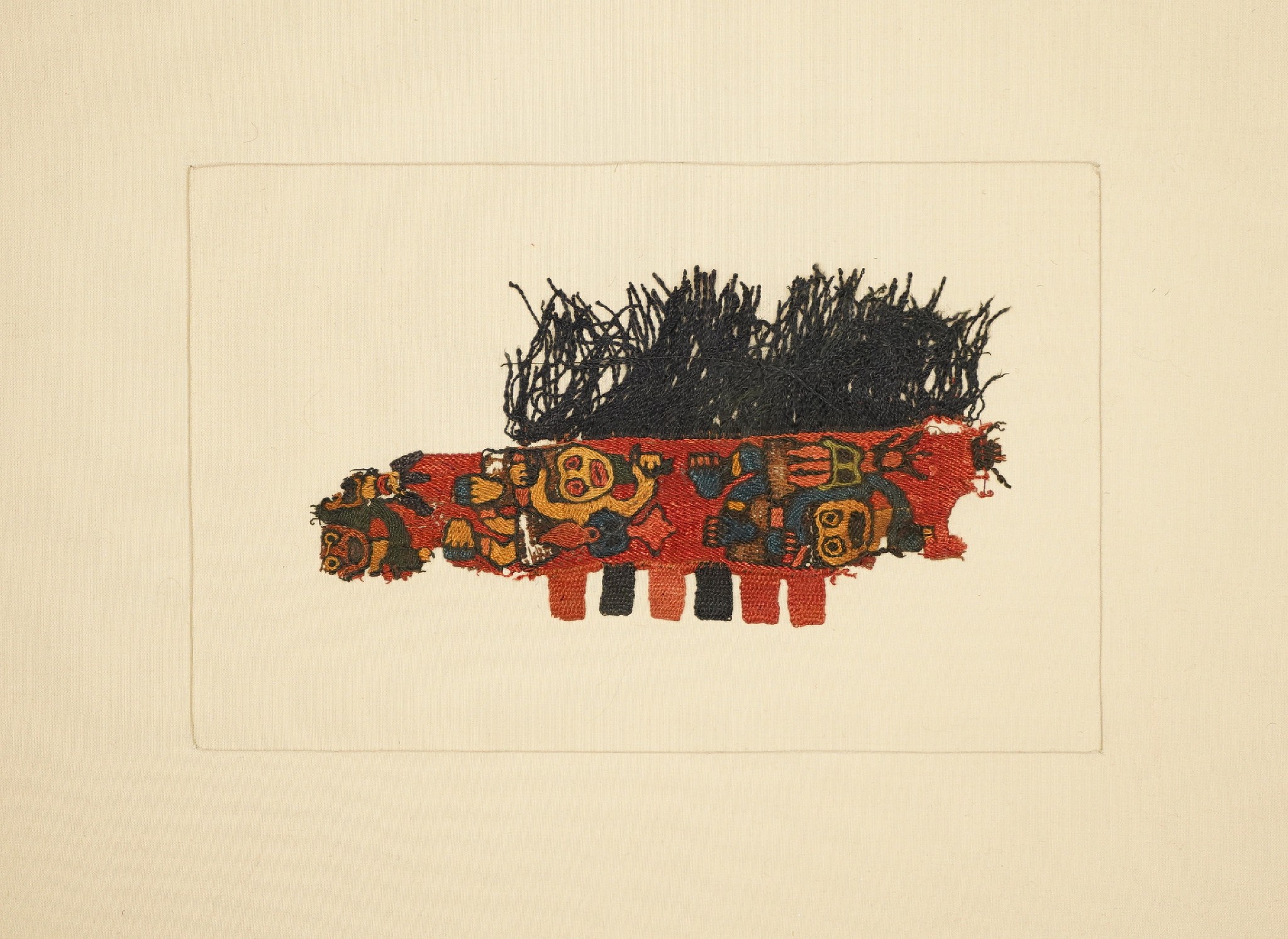


Peru, Paracas Color Block Border Section with Flying Shamans
This Paracas Color Block border section features two flying shamans, both depicted in the same position but reversed (one is upside down) to enhance the perception that they are flying or floating. Each shaman is depicted with a different color palette of bold, contrasting colors including vivid reds, oranges, yellows, and teal, which is characteristic of the Color Block style.Ex. collection Ferdinand Anton, Germany, prior to 1980.
Peru, Paracas, Late Phase, South Coast, c. 200 BC - AD 100
Period: Peru, Paracas, Late Phase, South Coast, c. 200 BC - AD 100
Media: Textile
Dimensions: Border: W. 6 1/4 in. x H. 3 1/4 in. with fringe.
Frame: W. 20 in x H. 16 in.
$600
79143
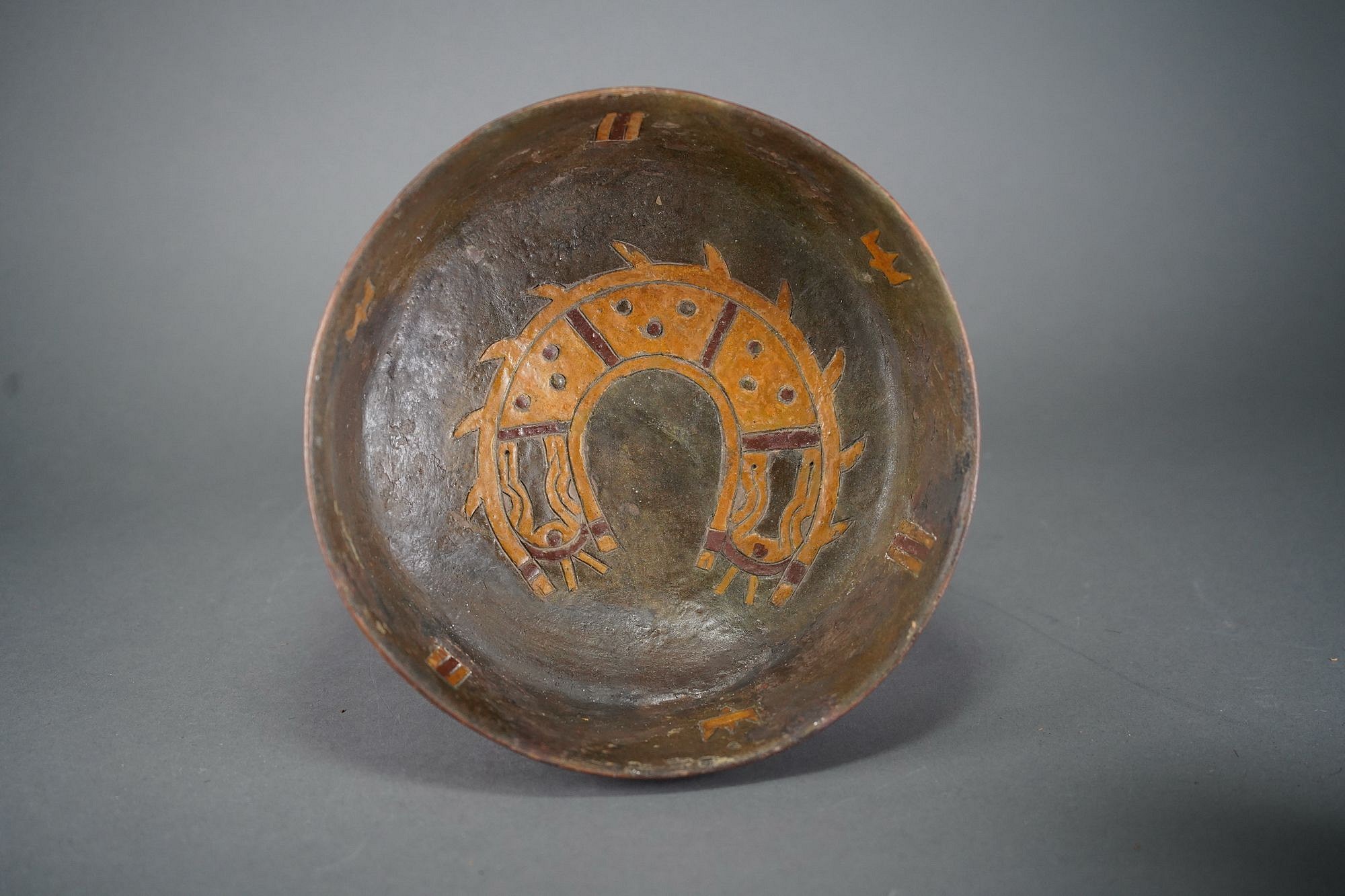
Peru, Paracas Dish with Double-headed Serpent
This painted dish is illustrated with a curved double-headed serpent, painted on the inside of the bowl as is characteristic of the later Callango phases. The double- headed serpent is a primal, animistic motif that originated early in Andean art history, during the Chavin period and is believed to depict an actual reptilian species known as Amphisbaena fuligoninos. This strange nocturnal species, which can currently be found in Ecuador down to Chile, possesses genetic traits of both snakes and worms. Although the amphisbaena snakes do not actually possess two heads, they evolved a tail that closely resembles their head as a defense mechanism against potential predators. When threatened, the amphisbaena species displays confusing behavior, acting as if its tail is a second head. The element of surprise diverts the attention of predators, creating confusion. While the predators are deliberating about which head to attack, the Amphisbaena snake buys itself time to escape. If attacked, there is a 50/50 chance the snake’s real head will be struck, allowing for an increased chance of survival. Ancient shamans likely revered the snakes for their deceptive qualities and used their non-lethal, paralytic venom for medicinal properties.
New York private collection prior to 1980.
Cracks professionally restored with some inpainting; all parts original.
Period: Peru, Paracas, Callango, Phase 8, c. 300 - 200 BC
Period: Peru, Paracas, Callango, Phase 8, c. 300 - 200 BC
Media: Ceramic
Dimensions: Diameter: 7" x Height: 2 7/8"
$5,500
M9029
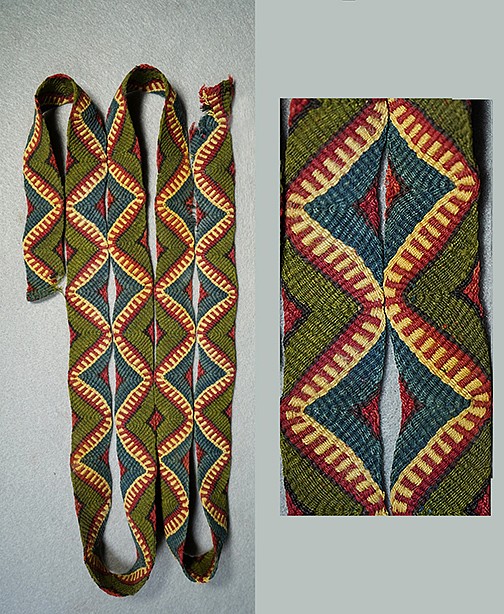





Peru, Paracas Double-woven Plaited Sash
This plaited colorful cloth turban sash is woven with vibrant shades of green, blue, yellow, pink, red, and brown. The triangle pattern when set next to a corresponding triangle creates a rectangle. Acquired in 1999 from a California collector prior to 1980's
Period: Peru, Nasca, Proto Phase, South Coast, c. 100 BC - AD 200
Period: Peru, Nasca, Proto Phase, South Coast, c. 100 BC - AD 200
Media: Textile
Dimensions: Length: 55 inches x Width: 1 inch
$6,500
99511
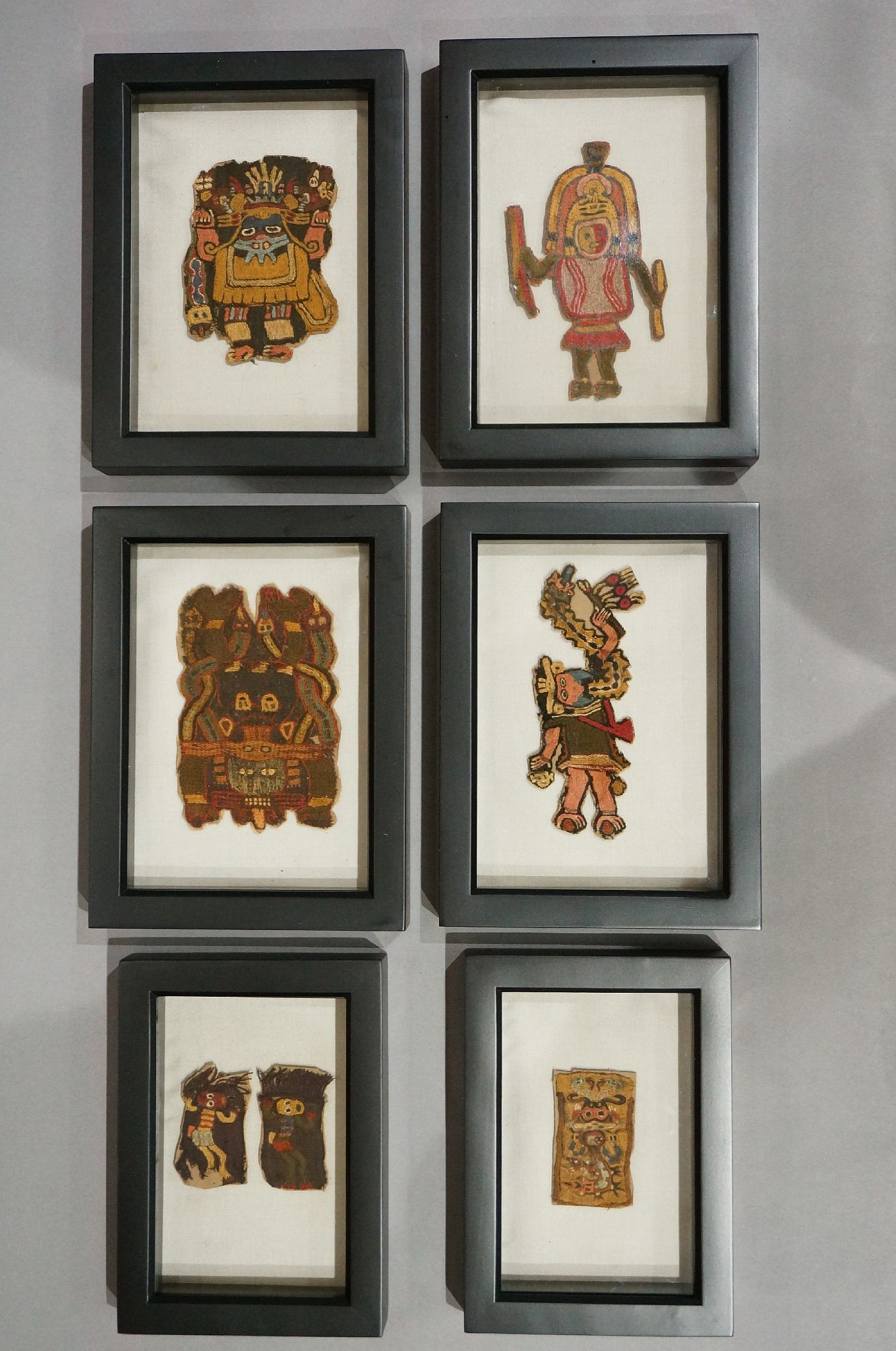
Peru, Paracas Embroidered Group of 6 Textile Sections
These figures represent different shamans in different states of transformation. The same subjects are illustrated in Alfredo Taullard’s Tejidos y Ponchos Indigenas de Sudamérica, Buenos Aires: Editorial Guillermo Kraft Limitada, 1949. These Paracas sections were excavated in the 1920s and were sent to various museum collections in Europe and the US.
Mounted on cardboard backing and reframed.
Acquired by David Bernstein in 2019.
Period: Peru, Paracas, South Coast, c. 200 - 100 BC
Period: Peru, Paracas, South Coast, c. 200 - 100 BC
Media: Textile
Dimensions: Length varies from 3 to 4 inches.
$12,000
n9048
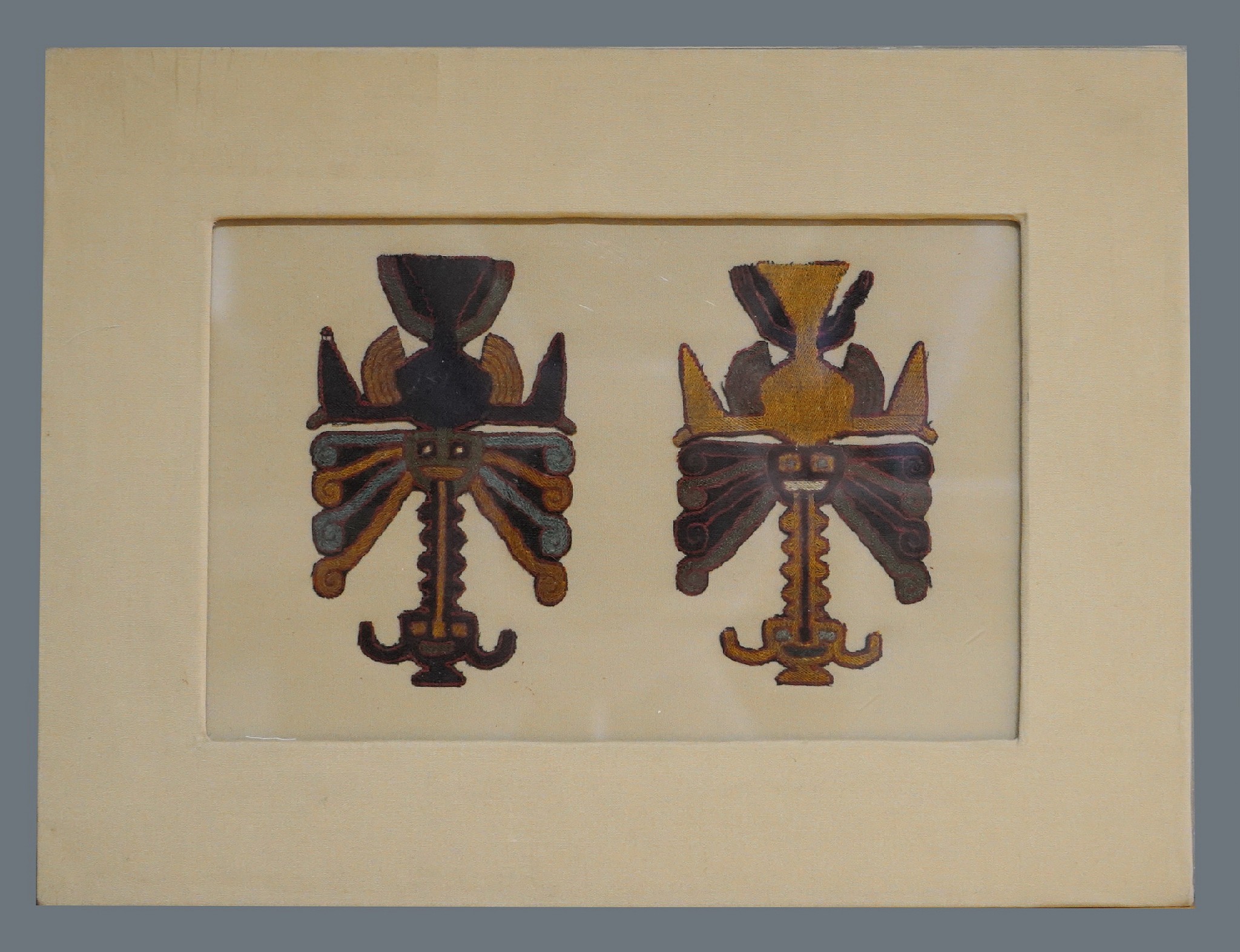






Peru, Paracas Embroidered Nightjar Birds
Paracas cross knit needle stitched embroideries are considered the finest in all antiquity. This pair of birds with outstretched wings are crafted in opposing colors inverse of one another, representing duality in nature. Each bird has a long proboscis with a trophy head at the end. This fragment belonged to an original larger mantle, which contained many birds arranged in alternating colors on a grid. This species of bird is possibly a Nightjar, also known as “goatsuckers.†Some Nightjars feature long feathers hanging down that look like a proboscis, and are identified in Pre-Columbian Art of South America, by Alan Lapiner in figure 206. These birds are also illustrated in Tejidos y Ponchos Indigenas de Sudamerica by Alfredo Taullard, 1949, plate 132 and in ALTPERUANISCHE KULTUREN Vol.1, pg.177. These embroidered nightjar birds have excellent provenance. Excellent color, professionally mounted in a Plexiglas frame. Acquired at Christie's Auctions in 2006, from an old estate.
Period: Peru, Paracas, Ocucaje Phase 8, South Coast, c. 700 - 200 BC
Period: Peru, Paracas, Late Phase, South Coast, c. 300 - 200 BC
Media: Textile
Dimensions: Mounted: 12" x 9" x Length 4 1/2" each
$15,000
M6076
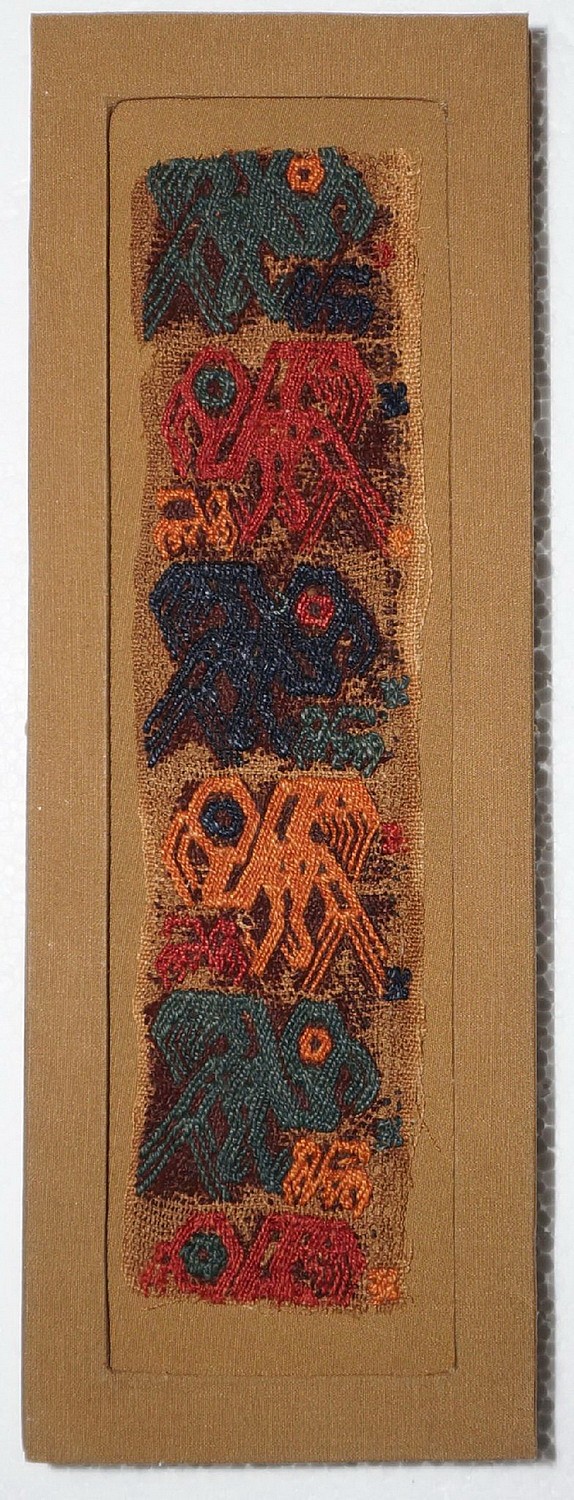





Peru, Paracas Embroidered Section with 5 Condors
This embroidery textile is decorated with five mythical birds of prey in red, green, orange, and dark blue on plain cotton. In front of each large bird is a miniature bird in a contrasting color. This textile is illustrated in ANCIENT PERUVIAN TEXTILES by Ferdinand Anton, 1984, in plate 52. Ferdinand Anton Collection prior to 1980. Excellent color, with slight unraveling at the edges.
Pressure mounted in a Plexiglas frame.
Period: Peru, Paracas, South Coast, c. 500 - 200 BC
Period: Peru, Paracas, South Coast, c. 500 - 200 BC
Media: Textile
Dimensions: Length:2 1/4" x Height: 7 1/2 "
Price Upon Request
92071
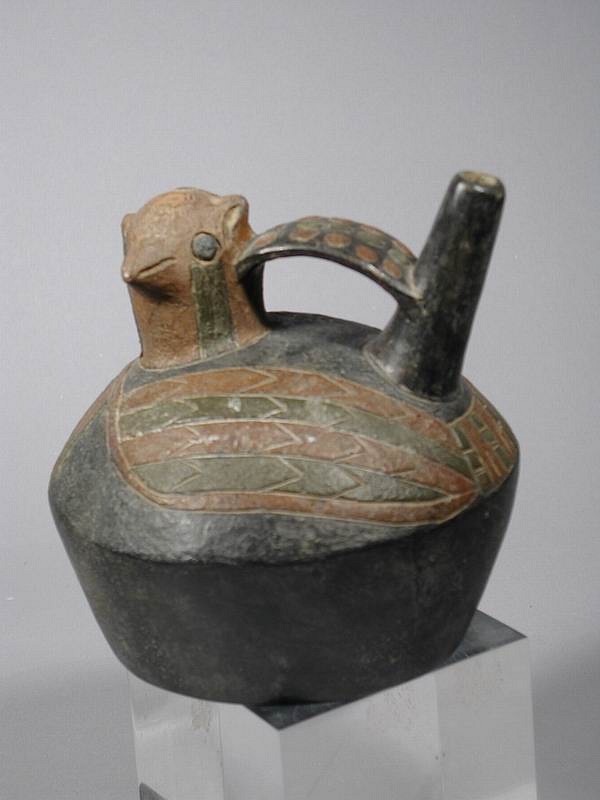





Peru, Paracas Falcon Effigy Vessel
This Paracas vessel has a blind-spout in the form of a falcon with pointed ears. The compressed, ovoid-shaped body was decorated with resin, painted, and incised, directly below the bridge spout handle. The chamber was enhanced with a series of squarish "U" shapes, accented with a central red stripe flanked by blocks of dark olive green and yellow ochre. These geometric configurations could be interpreted as highly abstracted bird forms and their presence is consistent within the development of the Phase 8 ceramic style. The use of resin painted designs outlined by incisions, referred to as "zoned" design, can also be assigned to Phase 8. Excellent literature and illustrations of the various phases of Paracas style ceramics are provided in Menzel, Rowe and Dawson's "The Paracas Pottery of Ica: A Study in Style and Time," 1969. Acquired by David Bernstein in 1994.
Period: Peru, Callango style, Paracas, South Coast, c. 700 - 500 BC
Period: Peru, Callango style, Paracas, South Coast, c. 700 - 500 BC
Media: Ceramic
Dimensions: Height 4 5/8"
$2,800
94131
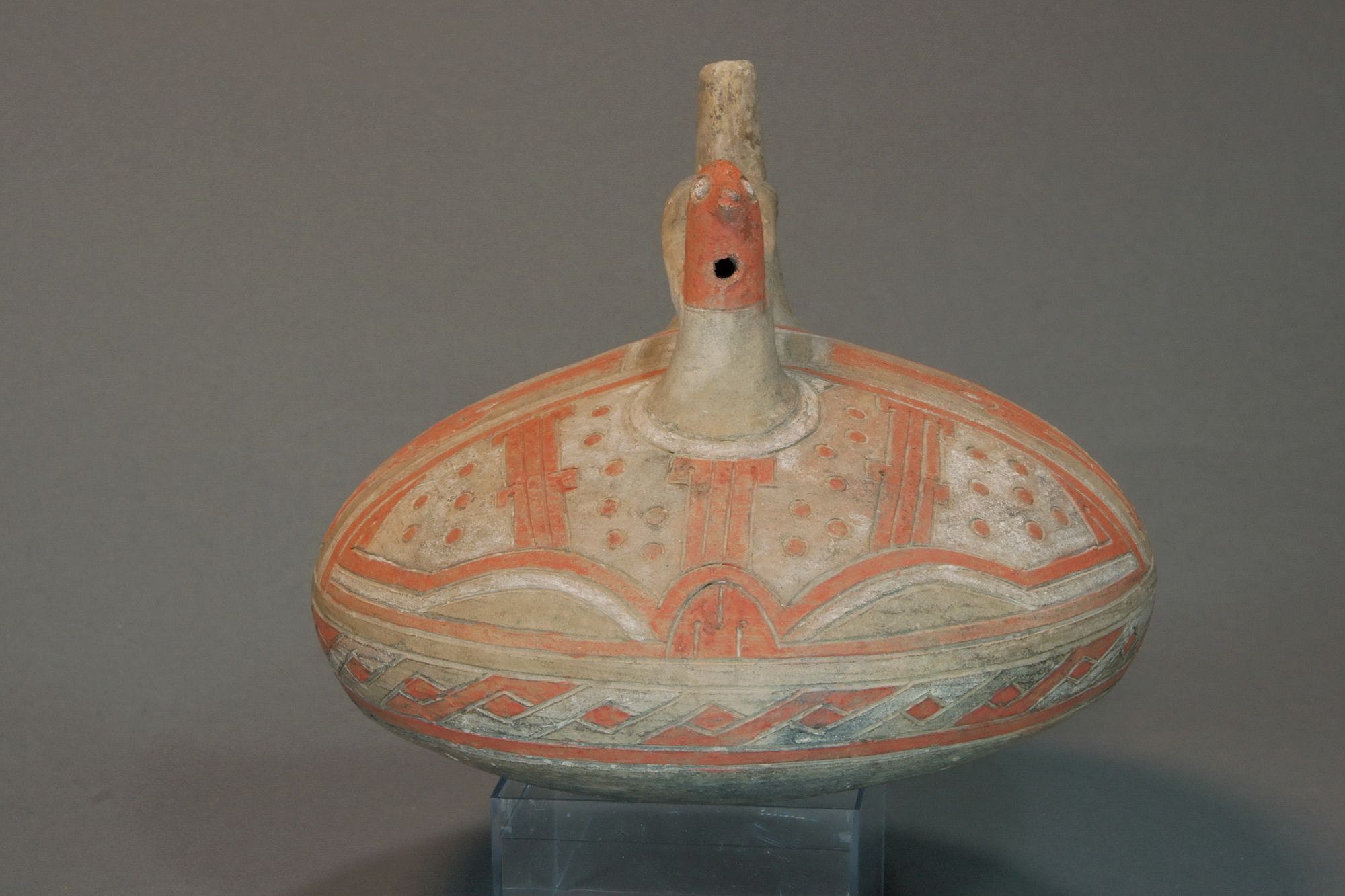








Peru, Paracas Late Phase 7 Ceramic Bridge-Spout Vessel with Hawk Head and Incised Feline Face
Paracas Iconography has been described in detail in THE PARACAS POTTERY OF ICA: A Study in Style and Time, by D. Menzel, J. Rowe and L. Dawson, U.C Press Berkley, 1964, pages 75 - 100. The hawk 's head is at the top of the blind spout, with its wings incised on the body of the vessel. The feline face on the front of the vessel has a distinct nose with 3 vertical lines representing its nostrils, each ending in small holes. These features, along with the slender arching eyes and brow terminating with a closed triangle and an incised circle around the base of the spout indicate that this is a Paracas Phase 7 vessel. See pages 232 and 325 of The Paracas Pottery of the Ica for similar illustrated vessels. The incised lines are filled in with cinnabar pigment. From the estate of Dr. Ernst Barash, prior to 1969. Acquired by David Bernstein in 2014.
Period: Peru, Paracas, Upper Callango Basin, Phase 8, South Coast, c. 700 - 200 BC
Period: Peru, Paracas, Upper Callango basin phase 6, South Coast, c. 700 - 200 BC
Dimensions: Height: 4" x Diameter: 5"
$8,500
n4046
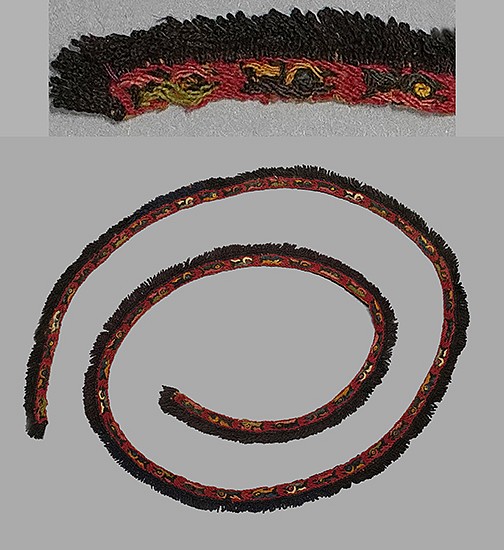



Peru, Paracas Miniature Embroidered Fringe with 59 Killer Whales
Weaving technique: embroidery with looped fringe.
This small-scale fringe was a border to a miniature garment. The whales repeat in alternating colors in sets of sections of seven whales. There is a solid dark blue-black outer fringe in excellent condition, which is finished at both ends. Traditionally, young children in the Andes do this type of embroidery, as they are the only ones who can work with such small detail. Acquired in 1998 from a California collector prior to the 1980s. Both ends are finished to make a complete fringe. Unmounted.
Period: Peru, Paracas, South Coast, c. 100 BC - AD 100
Media: Textile
Dimensions: Length: 35” x Width: 3/16”
$1,900
T-19



Peru, Paracas Miniature Knitted Fringe or Neck Opening with Double-Headed Worms
Eleven finely knitted colorful segments depicting double-headed worms with curled tails in alternating colors. Below each worm is a small tab with an even smaller creature nested within. Acquired from the estate of Anton Roeckl in Germany prior to 1970.
Period: Peru, Paracas, Late Phase, South Coast, c. 300 - 200 BC
Media: Textile
Dimensions: Length: 6 3/4 inches
$2,800
96165






Peru, Paracas Necropolis Embroidered Corner Border with Eight Large Feline Figures and 100 Secondary Figures
This symbolically rich Linear style Paracas mantle border features a group of magnificent animal deities, ranging from ferocious to benevolent. The eight main deities are feline Oculate Beings with exaggerated eyes, alternating in orientation, each with a tongue terminating in a serpent's head. Oculate Beings in Andean art often resemble the Pampas cat, Leopardus pajeros - a distinctive species of wild cat with unusually large eyes found along the Pacific coast of South America. Inside each of the Oculate Beings' torso is a double-headed condor, and a variety of small, colorful, attendant felines are embroidered around the perimeter of the design.
The Oculate Being with a smaller animal nested inside of it is a classic Andean shamanic trope that signifies death, rebirth, and transformation. Rather than representing the literal birth of an individual animal, these chimeric creatures, skeletal in form, nested inside the abdomens of the larger Oculate Beings represent a mythical cosmology of reverence rebirth and transformation.
The Paracas cosmology is also present in the abstract structure of the composition, which suggests the ambiguous boundaries between the earthly realm and the spiritual world. South American shamans are known to fast and chant in preparation for a voyage into the spiritual world. The lack of perspective and the absence of recognizable landscape features in the design of this textile signifies an intermediary zone outside the normal bounds of space and time, accessible only to shamans and spirit animals who can traverse the boundaries between worlds.
Red and pink threads of extremely similar hue were intentionally selected by the Paracas artisans to create an optical illusion that causes the smaller figures to appear to be emerging from the composition over time. This type of optical illusion using color only to create the sensation of forms emerging over time was also used in the abstract paintings of Modernist Ad Reinhardt.
Expert knowledge of color theory was used to select perfectly contrasting colors, creating an optical illusion in which some of the deities appear to vibrate, while others appear to merge into a unifying field of color. With prolonged observation, the scene in the textile appears to oscillate, and the deities appear to be moving. The changing imagery and perceptual illusion of motion created through use of compositional elements alone shares qualities with paintings of some of the greatest early 20th Century Modernists, including painter Wassily Kandinsky.
Kandinsky believed that each color had a spiritual vibrational property aside from its’ electromagnetic wavelength, and that colors could profoundly affect the human spirit. Kandinsky wrote about these concepts in his 1911 treatise, Concerning the Spiritual in Art. Also see Anne Paul's PARACAS RITUAL ATTIRE: Symbols of Authority in Ancient Peru, University of Oklahoma Press, 1990. p. 170. Professionally conserved and pressure mounted in a Plexiglas frame. Acquired by David Bernstein in 2003.
Period: Peru, Paracas, Ocucaje-South Coast , 300 - 200 BC
Period: Peru, Paracas, Ocucaje-South Coast , 300 - 200 BC
Media: Textile
Dimensions: Length 45" x Width 9 3/4"
Price Upon Request
M4003
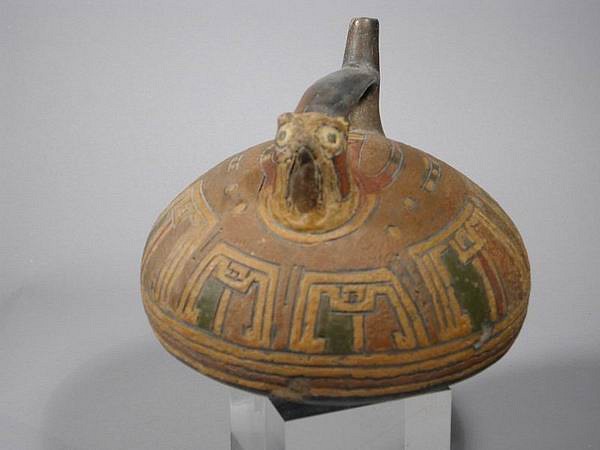
Peru, Paracas Ocucaje Bridge Spout Vessel
This Paracas vessel has one blind spout modeled in the form of a falcon’s head with feline ears. The compressed, ovoid body was decorated with a resin-painted and incised bird directly below the bridge spout handle. The chamber was enhanced with a series of squarish "U" shapes, accented with a single Chavinoid eye in profile. The circumference is decorated with blocks of dark olive green and yellow ochre. These geometric configurations resemble abstract bird forms, the style of which is consistent the Paracas Phase 8 ceramic style. The use of resin painted designs outlined by incisions, referred to as "zoned" design, can also be assigned to Phase 8. Literature and illustrations of the various phases of Paracas style ceramics are provided in Menzel, Rowe and Dawson, "The Paracas Pottery of Ica: A Study in Style and Time" (1969). Acquired from Auction in 2016 from an old estate.
Period: Peru, Paracas, Ocucaje Phase 8, South Coast, c. 700 - 200 BC
Period: Peru, Paracas, Ocucaje Phase 8, South Coast, c. 700 - 200 BC
Media: Ceramic
Dimensions: Height: 5 1/2 " x Diameter: 5 1/2"
$4,000
98137B
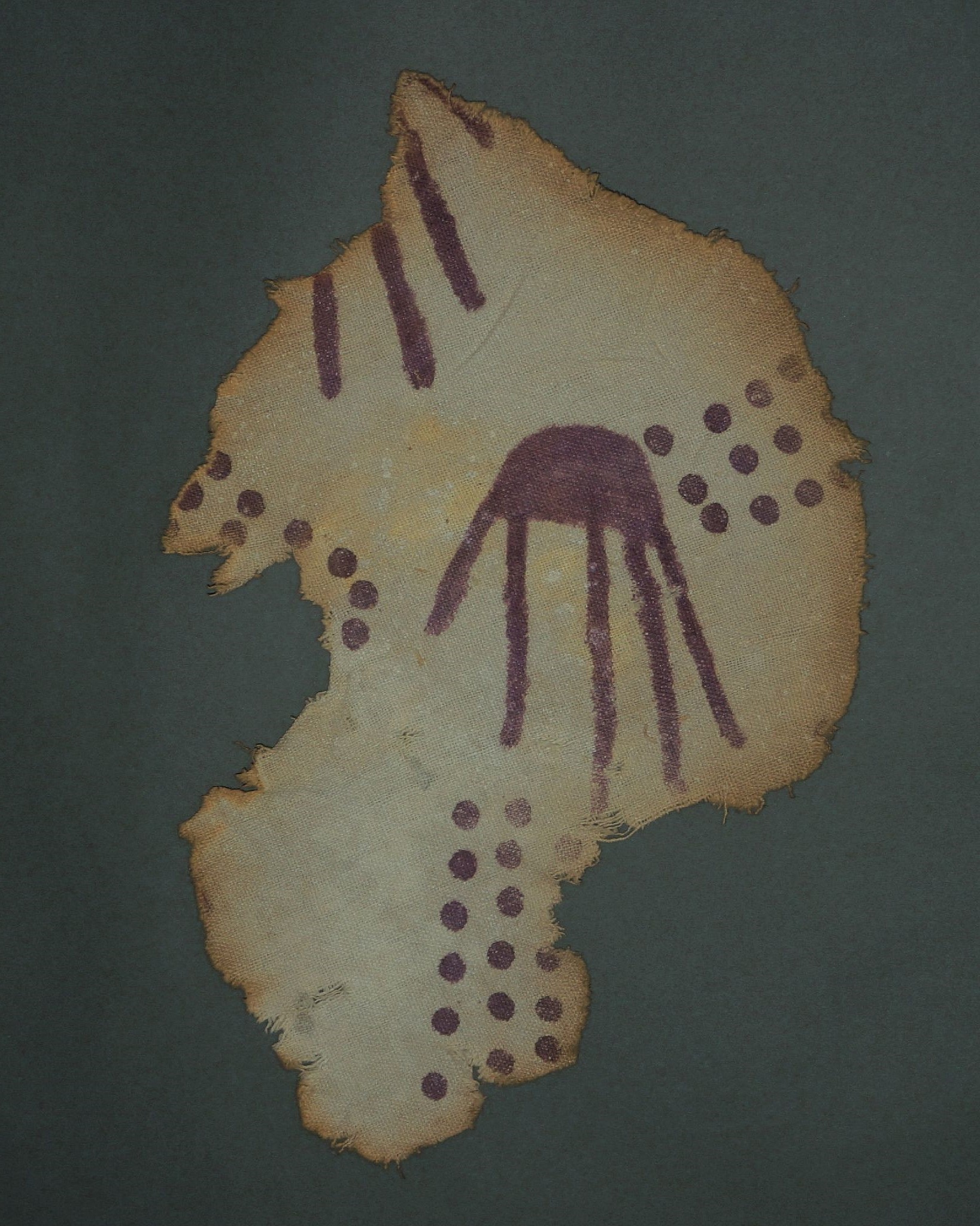



Peru, Paracas Painted Cloth Fragment with Purple Jellyfish
The jellyfish with its eggs is an iconic image from the Paracas period. The purple pigment was made from the secretion of the murex, a bivalve that lives on the rocky coast of Southern Peru. The murex's yellow secretion turns an intense reddish-purple when it touches cotton. The Paracas weavers were the only Peruvian craftsmen that used the murex dye, from the 3rd to 1st century BC. Close inspection reveals traces of other pigments that have disappeared over time, evidence of a more complicated decorative scheme. This murex bivavle also lives in the Mediterranean, and the same dye, known as Tyrian purple, was favored by the Greeks.Murex dyed weavings have also been found in excavations in Israel dating c.1900 BC according to the Oct 21, 2022 edition of Times of Israel. Acquired by David Bernstein in 2016.
Period: Peru, Paracas-Late phase, Ocucaje-South Coast, c. 300 - 100 BC
Period: Peru, Paracas-Late phase, Ocucaje-South Coast, c. 300 - 100 BC
Media: Textile
Dimensions: Length: 16 1/8" X 9 3/8"
$5,500
n6069
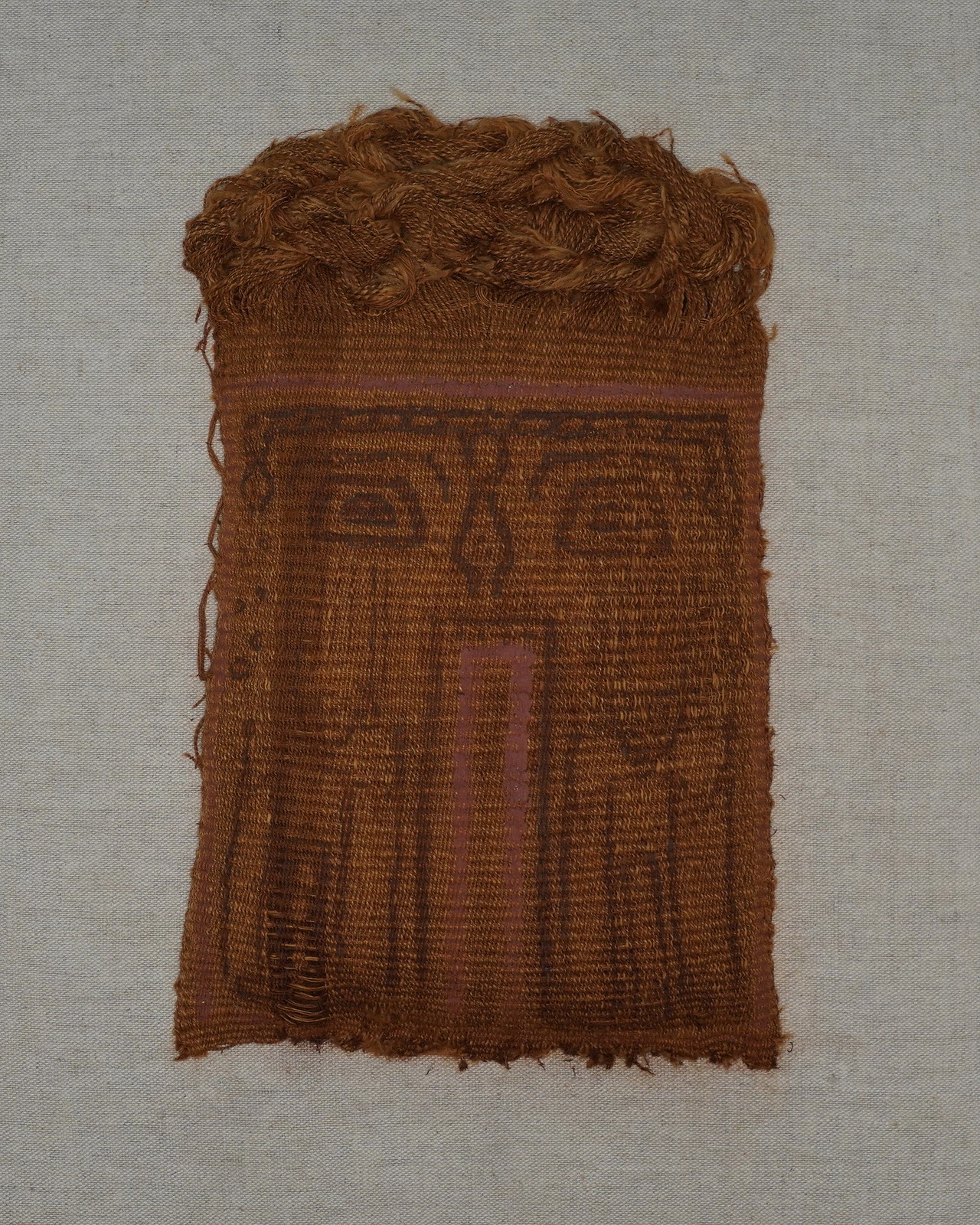


Peru, Paracas Painted Mummy Mask Depicting a Face Doubling as a Temple Entrance
This rare funerary mask has a double meaning and can be interpreted in two ways: at first glance it appears to the face of a deity with tears streaming down its cheek. On second glance, it is apparent that the rectangular mouth of the deity can also be interpreted as a grand entrance to a temple, a larger-than-life door flanked by two staff bearing guards. The scale of the guards relative to the size of the door paints a picture of an intimidating, awe-inspiring sensory experience that would have affected any individuals making a pilgrimage to the temple. Archaeologist Max Uhle discovered a similar mask with a square-eyed face that doubles as a temple entrance, two standing figures, and a straight headband; Uhle's mummy mask is illustrated in the book Painted Cloth Mummy Mask of Ica, Peru, By Lawrence Dawson, in figure 7. This mask is in better condition than the one illustrated in Dawson's book and has retained more of the original pigment colors over time. Acquired by David Bernstein in 2003.
Period: Peru, Paracas, Ocucaje Phase 9, Ica valley, South Coast, c. 300 - 200 BC
Period: Peru, Paracas, Ocucaje Phase 9, Ica valley, South Coast, c. 300 - 200 BC
Media: Textile
Dimensions: Height 11" x Width 8 3/4"
$16,000
M3004
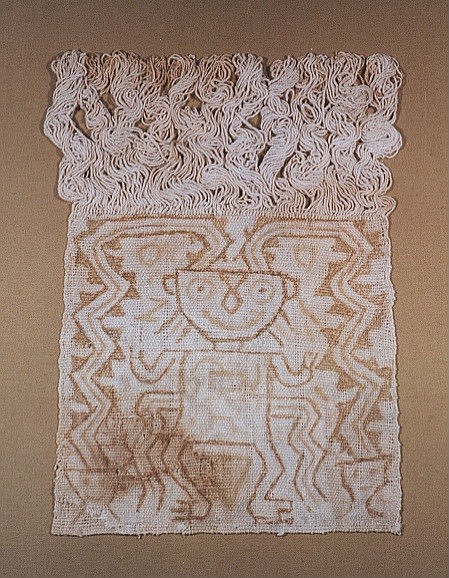
Peru, Paracas Painted Mummy Mask Textile with Figure and Serpents
The Paracas culture is known for its elaborate and whimsical painted textiles as well as its mummy masks, which were placed over the faces of the deceased. This cotton textile is woven in white thread and painted with varying shades of tan and brown pigment. The mysterious central deity is depicted standing with his arms and legs turned outward. Serpentine creatures emanate from either side of his head, their miniature faces resting at the ground near his feet. The cotton warps form a fringe along the top border. Ex. collection Pablo Soldi-Lou Slavitz in the US prior to 1960's.
Period: Peru, Paracas, Ocucaje Phase 9, Ica valley, South Coast, c. 300 - 200 BC
Media: Textile
Dimensions: Height: 16" x Width: 8"
$3,400
92005
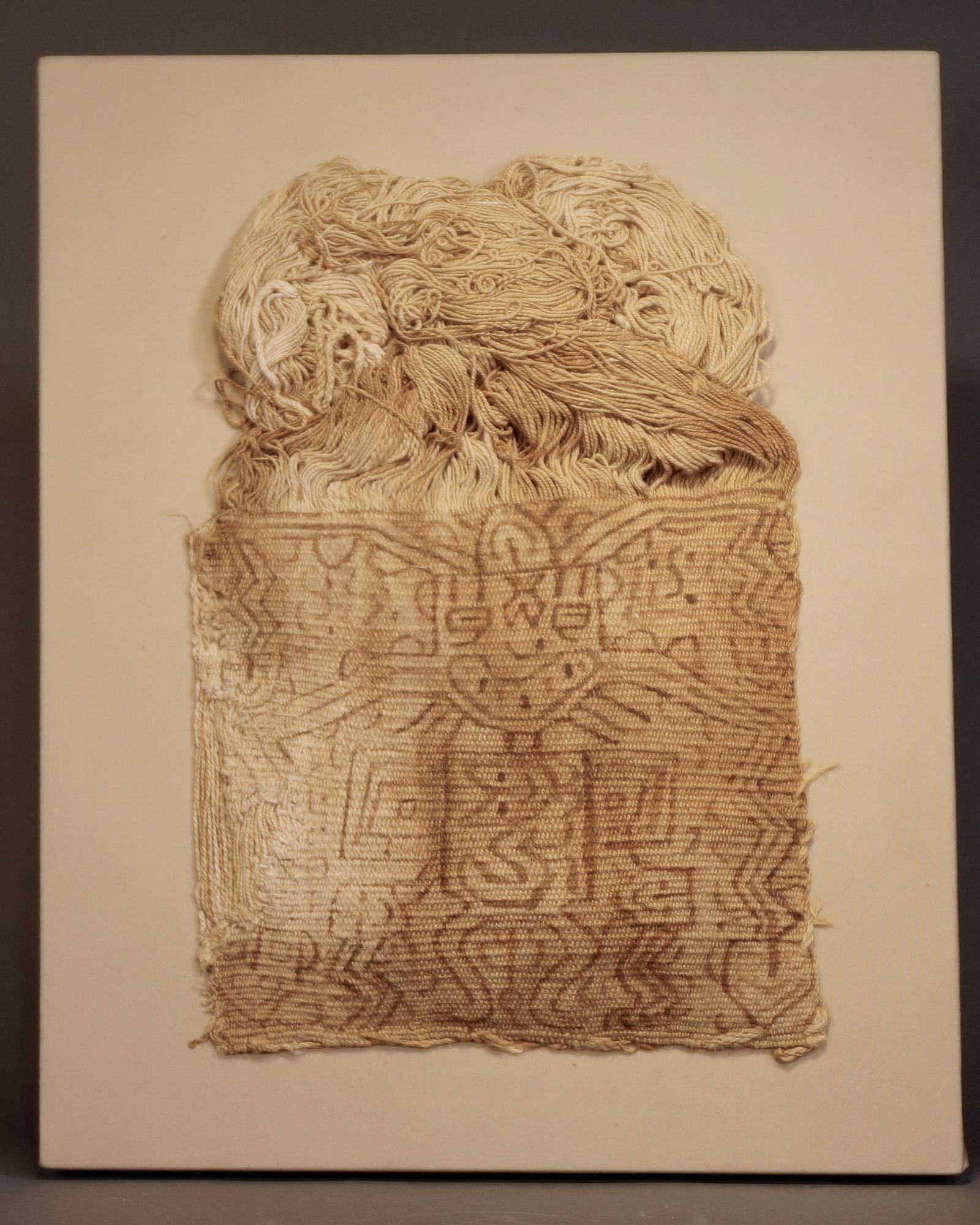
Peru, Paracas Painted Mummy Mask with Deity and Serpents
This woven mask is painted with an image of a front-facing deity flanked by serpents emanating from the deity’s head and mouth. This mask introduces several artistic innovations from the “Full Face†masks of Paracas Phase 9. The face is smaller, and the figure has a larger body, which makes the overall image less mask-like. The drawing is a good example of Horror Vacui, fear of empty the composition. Feline and trophy head elements fill the space around the main figure. A similar transition period mask is illustrated in Dawson's article PAINTED CLOTH MUMMY MASKS OF ICA, PERU, on pages 83-104 of Junius Bird Pre-Columbian Textile Conference in 1973. fig. 12.
Mounted on its original cotton backing. Some natural wear, exposed warps on the left side. The mask is complete with the original unspun cotton backing. Acquired by David Bernstein in 2007.
Period: Peru, Paracas, South Coast, c. 500 - 200 BC
Period: Peru, Paracas, South Coast, c. 500 - 200 BC
Media: Textile
Dimensions: Height:12.5" x Width: 8.25"
Mounted Height: 16" x Width 12"
$6,500
M7033H
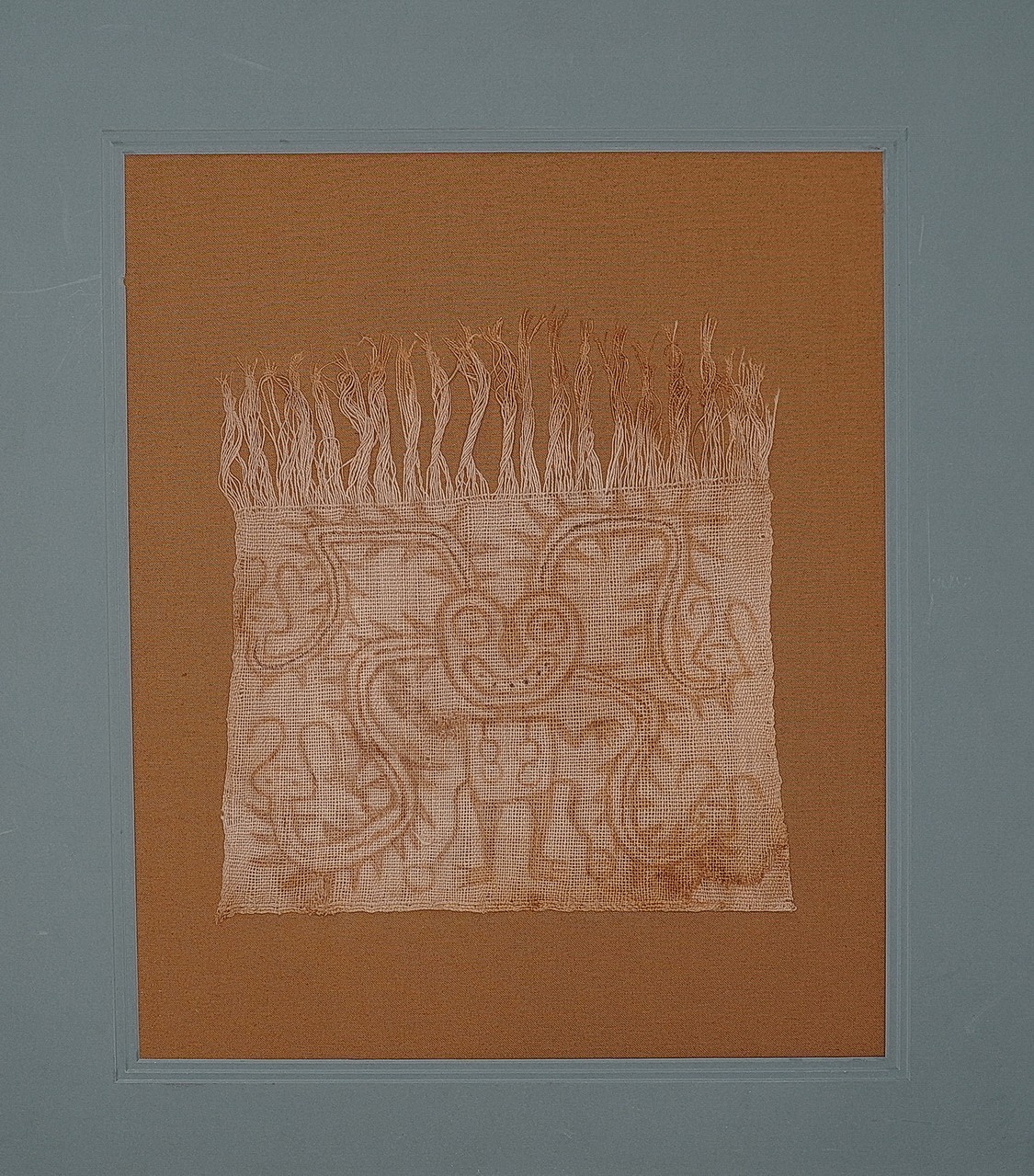


Peru, Paracas Painted Mummy Mask with Figure and 4 Serpents
This mummy mask has one serpent emerging from each side of the central feline Oculate Being's head. Two other serpents emerge from the top of the heart. The serpent heads could also be heads of marine eels are a unique feature not seen on many Paracas masks. The bodies are serrated, with thin spikes with a narrow line following the curve of their backs. The Oculate Being is shown as a figure rather than just a head and is depicted with curvilinear lines and an upturned mouth – indicative of the Paracas, c. 300 – 100 BC. There is also a short fringe on the top edge of the textile. Paracas funerary masks are discussed in L. Dawes' article PAINTED CLOTH MUMMY MASKS OF ICA, PERU, on pages 83-104 of Junius Bird Pre-Columbian Textile Conference in 1973. Formerly in the Louis Slavitz collection prior to 1970. Very good condition, mounted on an acid-free mat.
Period: Peru, Paracas, South Coast, c. 500 - 200 BC
Period: Peru, Paracas, South Coast, c. 500 - 200 BC
Media: Textile
$4,500
92004
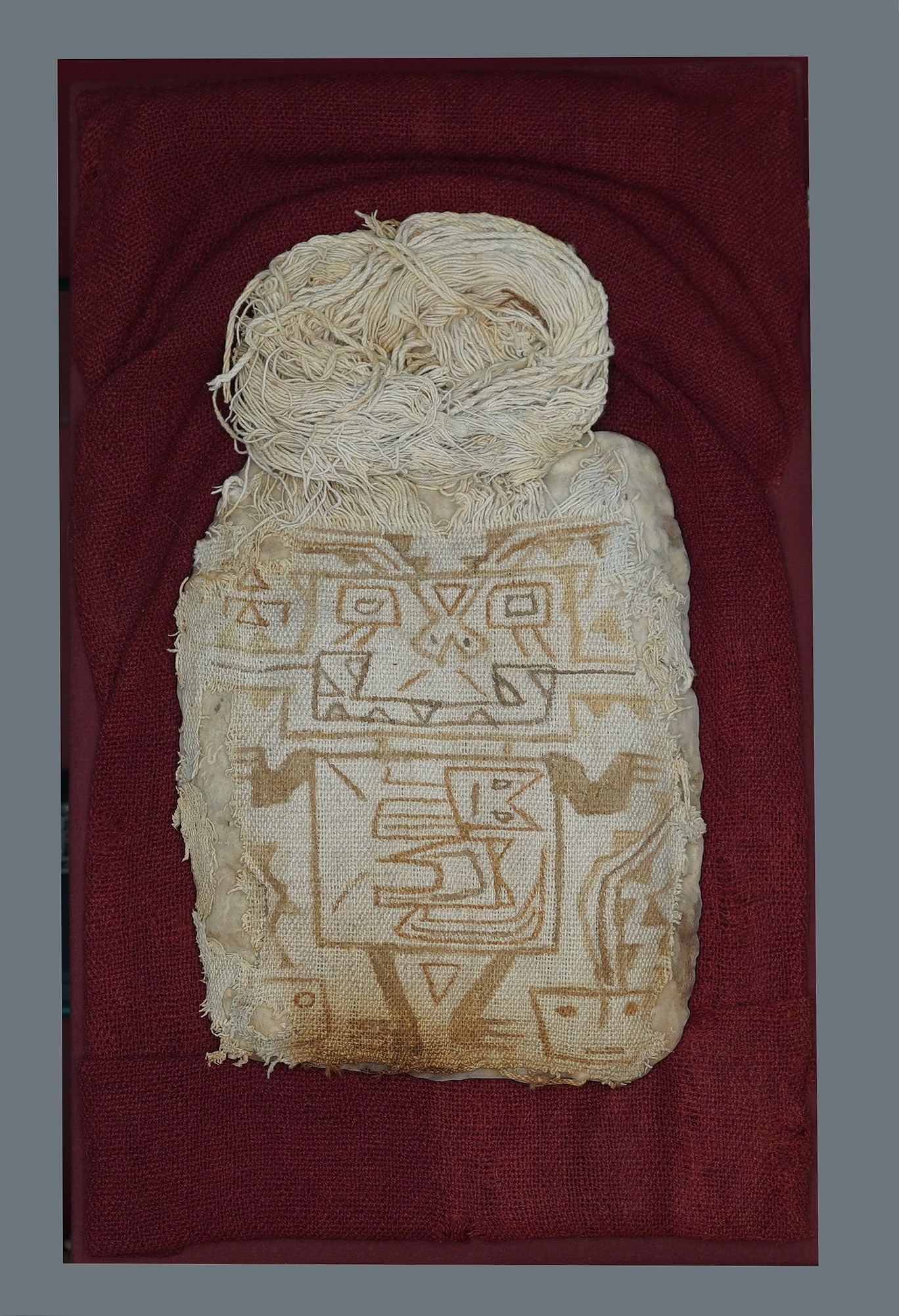


Peru, Paracas Painted Mummy Mask with Figure and Feline
This beautiful Paracas mummy mask is complete with its original ancient cotton and red wool backing and painted with natural pigments from the Andes. The painted figure has two serpents emanating from its mouth and a secondary creature nested inside the body, symbolizing shamanic transformation and rebirth. This example with a larger head on a body is a transition from the small head on the larger torso. Paracas funerary masks are discussed in the article PAINTED CLOTH MUMMY MASKS OF ICA, PERU on pages 83-104 of Junius Bird Pre-Columbian Textile Conference in 1973. Formerly in the Louis Slavitz collection prior to 1970.
Period: Peru, Paracas, Ocucaje Phase 9, Ica valley, South Coast, c. 300 - 200 BC
Period: Peru, Paracas, Ocucaje Phase 9, Ica valley, South Coast, c. 300 - 200 BC
Media: Textile
Dimensions: 19" x 12" including mounting and Plexiglas box.
$12,000
79004
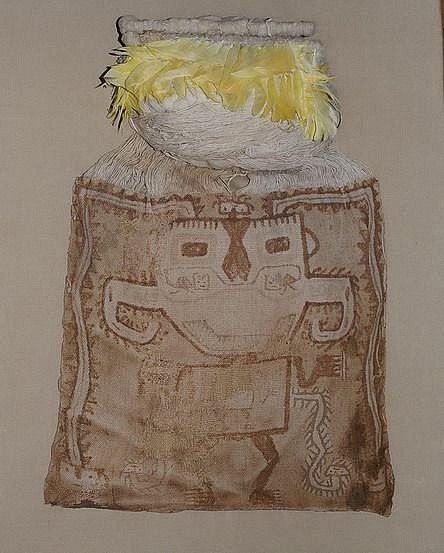


Peru, Paracas Painted Mummy Mask with Original Yellow Macaw Feathers
This is a large, complete mummy bundle mask with its original unspun cotton backing and loom ornament, embellished with yellow feathers. The frontal figure is painted with reddish brown pigment features a large head and smaller body, indicative of the Ocucaje 9 historical period. The main figure is surrounded on both sides by a serpent studded with conical spikes emanating from the head. This dentated serpent is a recognizable theme Andean art. Two small felines with their tails connect under the nose, forming a mustache. The exaggerated ears are also surrounded by spikes. It is complete with the original backing material and the loom stick. This maks is illusrated in Ancient Peruvian Textiles by Ferdinand Anton, 1984, fig.11, and is also featured in Brucken in die Sukunft, published by Deutsche Bank in 1992, page 2.
Small rips and tears. Professionally conserved and mounted on a stretcher. Was in the collection of Mrs. Marion Anton-Kock prior to 1970.
Period: Peru, Paracas, Ocucaje South Coast, c. 300 - 200 BC
Period: Peru, Paracas, Ocucaje South Coast, c. 300 - 200 BC
Media: Textile
Dimensions: Unmounted: H.16" x W.12"
Mounted: H.20.5" x W.16"
$22,500
M5003
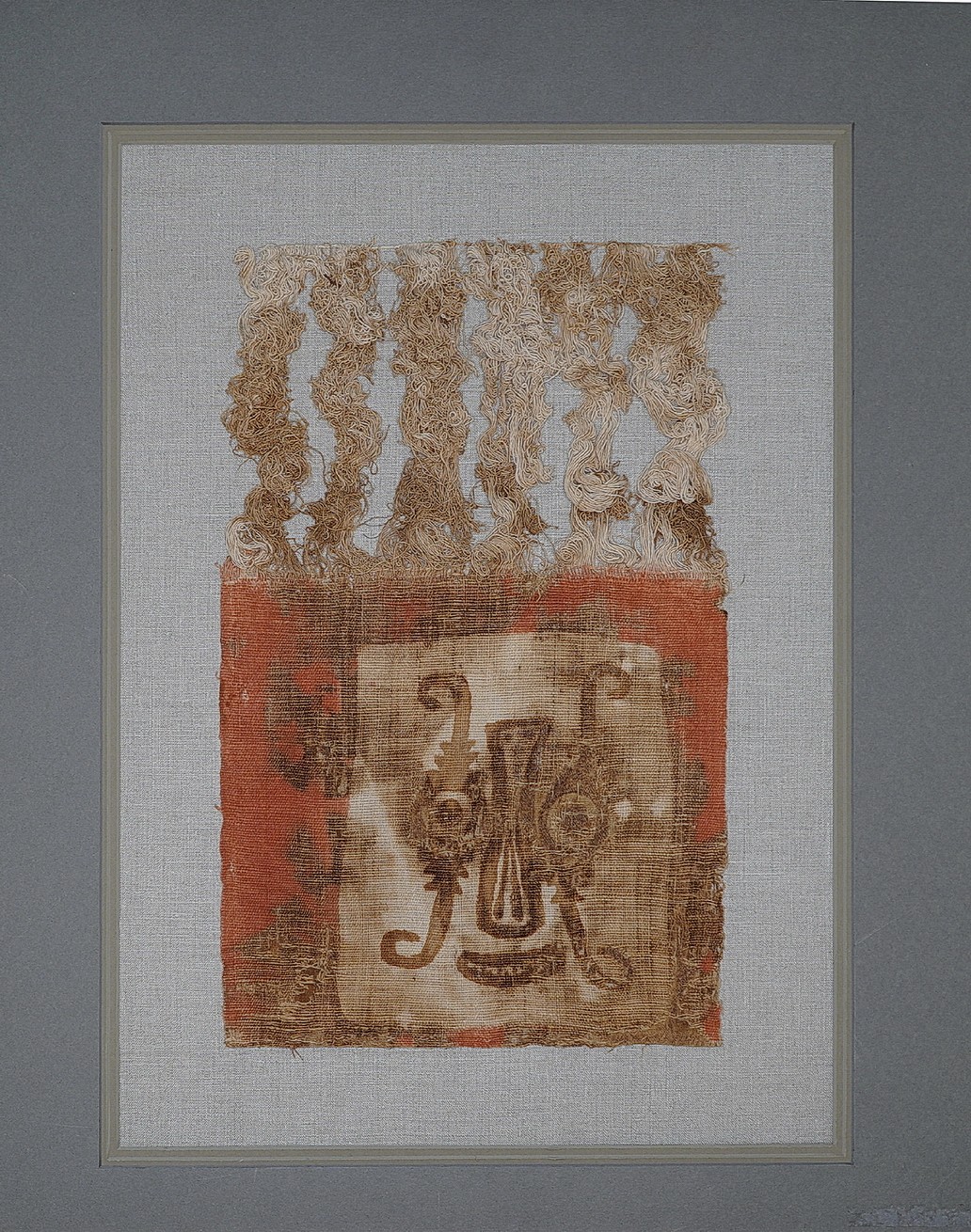




Peru, Paracas Painted Mummy Mask with Reversible Face
Mummy masks are among the earliest textiles in the Paracas textile tradition. They were constructed of plain weave cotton panels with images painted on one side and long, unwoven warp threads issuing from the top. They are referred to as 'mummy masks' because they were tied onto the faces of the wrapped remains of individuals who formed the elite society of Paracas. These masks may have been intended to ward off evil spirits. The figure portrayed on the mask is referred to by Menzel, Rowe and Dawson, in 'The Paracas Pottery of Ica: A Study in Style and Time' (1969) as the Oculate Being. This feline deity, usually distinguished by facial characteristics such as large circular eyes and an upturned mouth, often with a protruding tongue. Bodiless faces like the image on this textile are a feature of earlier Paracas mummy masks. Later examples are painted with the deity's entire figure. In this mask, a central square depicting the face is surrounded by a brilliant red border. The concentric eyes are enclosed within a stepped diamond with curls extending above and below. The nose is formed by two conjoined trapezoids, one with nostrils and the other with two long vertical lines. According to Dawson's Seriation of Features of Cloth Mummy Masks (1973). Paracas funerary masks are discussed in the article PAINTED CLOTH MUMMY MASKS OF ICA, PERU, on pages 83-104 of The Junius Bird Pre-Columbian Textile Conference in 1973. Formerly in the Louis Slavitz collection prior to 1970. Mounted on an acid free mat.
Period: Peru, Paracas, Ocucaje Phase 9, Ica valley, South Coast, c. 300 - 200 BC
Period: Peru, Paracas, Ocucaje Phase 9, Ica valley, South Coast, c. 300 - 200 BC
Media: Textile
Dimensions: H. 18 x W. 11 1/4 in. including fringe
$8,700
92007
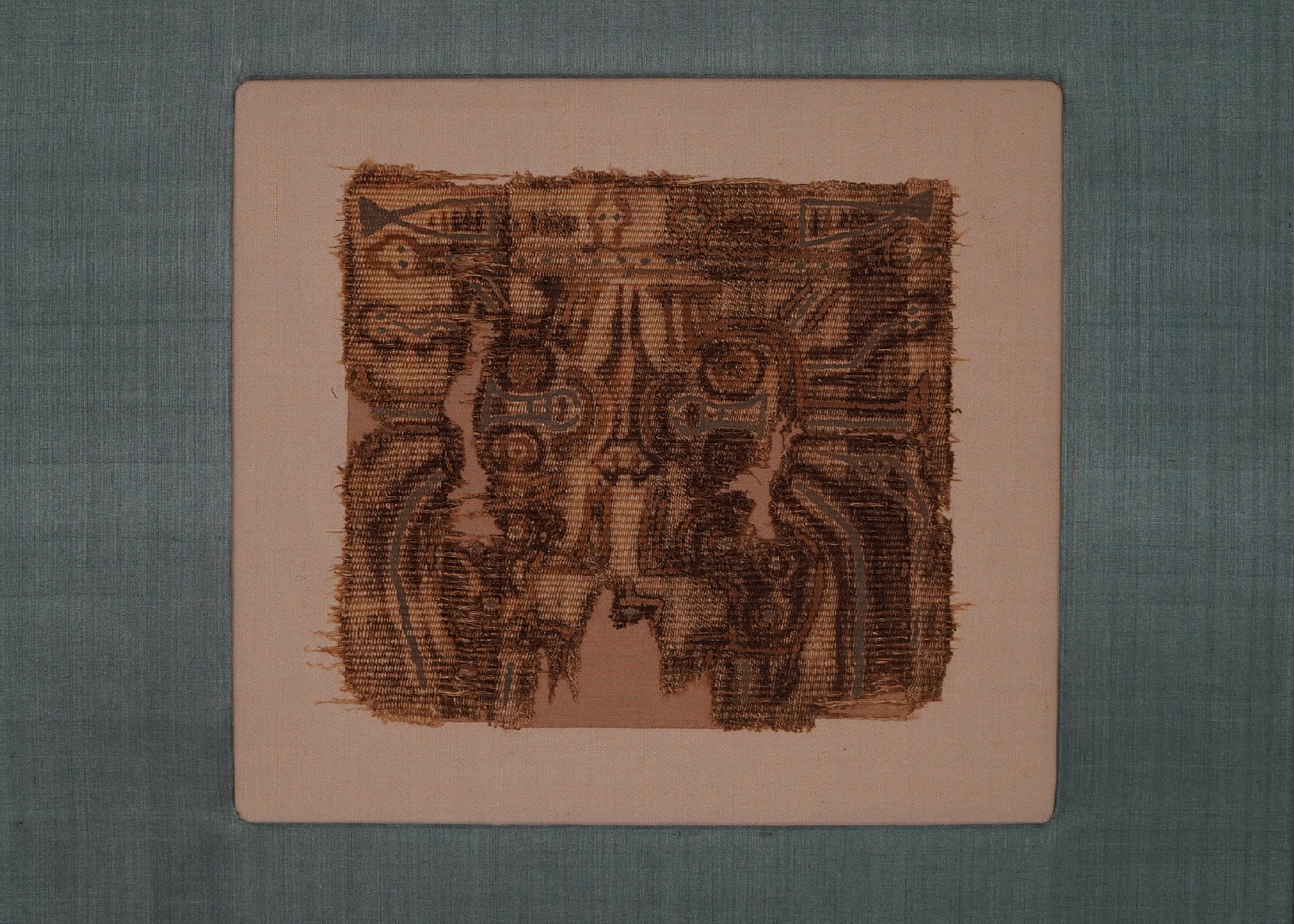


Peru, Paracas Painted Mummy Mask with Reversible Mirror Image
This wonderful painted mask can be viewed in two directions and displays fantastic compositional and design craftsmanship. The eyes are shared by two attendant profile felines with heads turned outwards and undulating serpents emanating from each head. A horizontal serpent lies above the main head. The clever symmetrical design integrates a variety of smaller animals which when combined, also form the larger central feline. Similar masks with the attendant felines are illustrated in Painted Cloth Mummy Masks of Ica, Peru by Lawrence Dawson, figures 2 & 5. Another unique feature is the unusually well preserved blue gray pigment highlighting the nose and serpents of each attendant figure. Acquired by David Bernstein in 1992. In good condition, professionally mounted on a covered mat board.
Period: Peru, Paracas, Middle Period, South Coast, c. 700 - 300 BC
Period: Peru, Paracas, Middle Period, South Coast, c. 700 - 300 BC
Media: Textile
Dimensions: Height: 8 ¾†x Length: 8â€
$4,700
92111
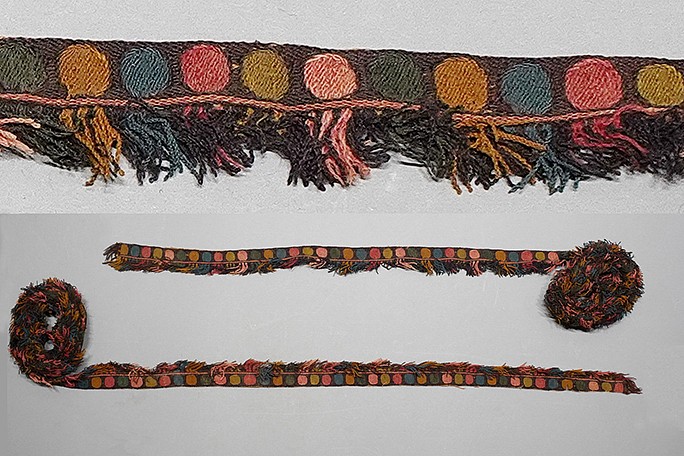


Peru, Paracas Pair of Embroidered Fringes with Alternating Colored Circles
The colored circles repeat in sections of six in blue, green, pinks and gold. All four ends are finished. The outer fringe extension is colored as the same circles. There are 145 circles on each fringe.
Beautiful colors and finished on each end. Unmounted. Private California collection, acquired in 1980.
Period: Peru, Paracas-Ocucaje 10, or Nasca 1, South Coast, c. BC 100 - AD 100
Period: Peru, Paracas-Ocucaje 10, or Nasca 1, South Coast, c. BC 100 - AD 100
Media: Textile
Dimensions: Length:70" X Width: 1" for each fringe.
$4,900
T-20
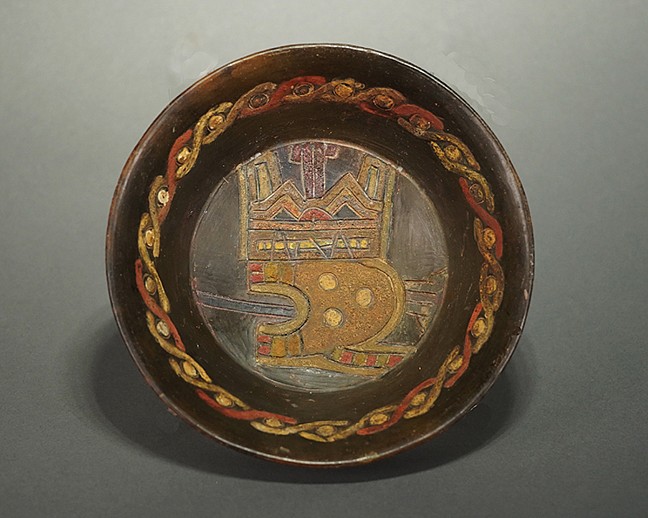





Peru, Paracas Phase 8 High Fired Ceramic Flared Dish with Feline in Profile
The dish is incised and painted with a feline in profile looking outwards. His pointed ears and brows are from Callango, phase 8. The upper edge is painted with a geometric intertwining helix design in red and yellow. On the outside rim is an incised and painted band of three intertwined designs. A similar dish is described in THE PARACAS POTTERY OF ICA by Menzel, Rowe, and Dawson, U.C Berkley, 1964, page 125, figs. 19-5k, and page 363, fig. 45. Estate of Ernst Barash prior to 1969.
Period: Peru, Paracas, Callango, Phase 8, South Coast, c. 700 - 200 BC
Media: Ceramic
Period: Peru, Paracas, Callango, Phase 8, c. 300 - 200 BC
$4,000
n4047
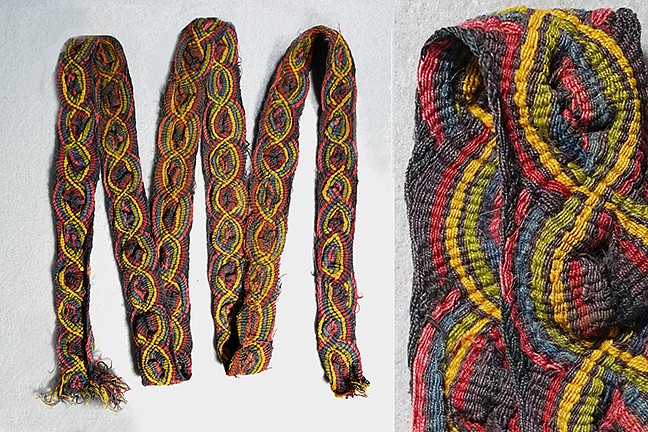


Peru, Paracas Plaited Sash with Double-Helix Pattern
This plaited triple-cloth turban sash is woven with vibrant shades of green, blue, yellow, pink, red, and brown. The intertwining double-helix pattern may represent interlocking serpents. Most Andean sashes are flat but the clever artisan who created this sash used the plaiting technique to create a three-dimensional structure resembling a snake. It is also possible that this design also imitates a tie-dye technique with the tied-off center. Acquired in 1999 from a California collector.
Period: Peru, Paracas, South Coast Early Intermediate Period, Phase II, c. AD 100 - 200
Period: Peru, Paracas, South Coast Early Intermediate Period, Phase II, c. AD 100 - 200
Dimensions: Length: 61 inches x Width: 1.25 inches
$6,500
99513
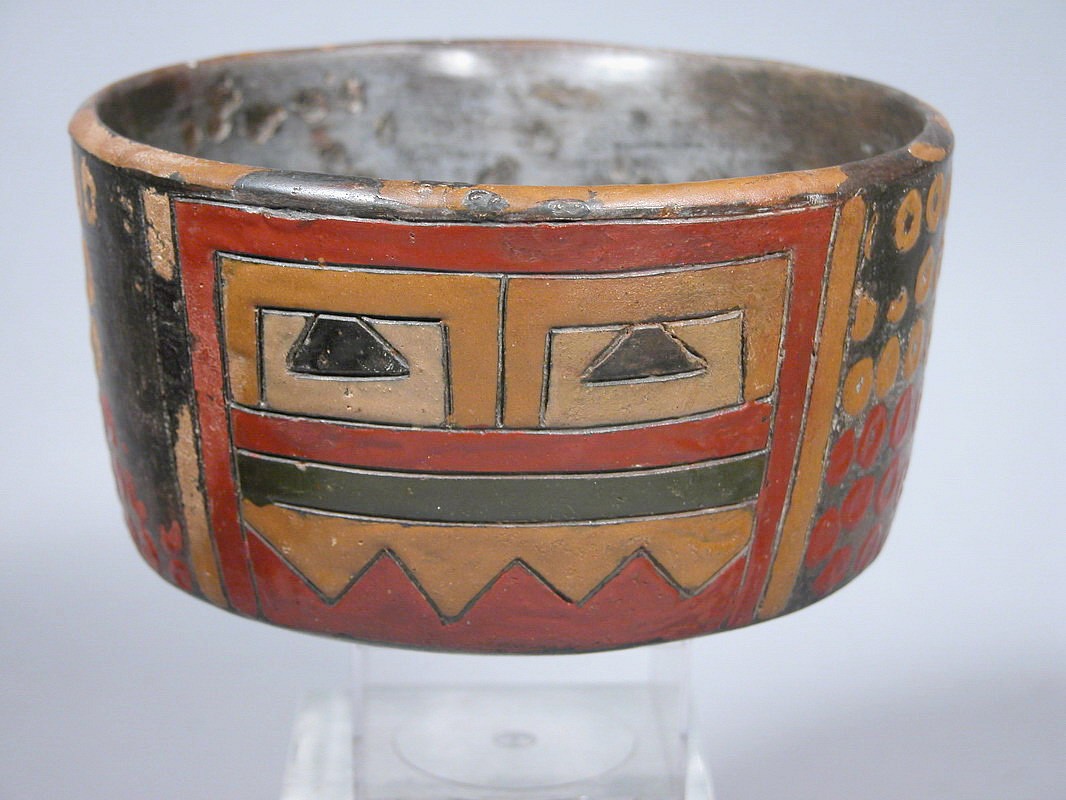

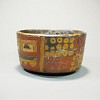


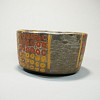
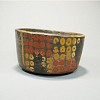
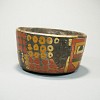


Peru, Paracas Polychrome Bowl with Incised Mask Design
This Paracas bowl was decorated with an abstracted geometric mask painted in rich post-fire pigments of red, ochre, olive green, and buff. The bowl also features geometric checkerboard patterns to the left and right of the face. There is a slight lip on the upper rim for pouring or drinking ritual libations. Abstract geometric vessels such as this were highly sought after by European and American painters during the heyday of the Modernist movement in the early and Mid-20th Century. A similar example is on display at the Metropolitan Museum of Art in New York and is illustrated in Alan Sawyer's, "Ancient Peruvian Ceramics," 1966, on page 74. This vessel has excellent provenance. It was acquired prior to 1970 and was loaned by the Landmann family of Westchester, NY, to the American Museum of Natural History in New York, where it was on view from 1984 to 1994.
Period: Peru, Paracas, Late Phase, South Coast, c. 300 - 200 BC
Period: Peru, Paracas, Late Phase, South Coast, c. 300 - 200 BC
Media: Ceramic
Dimensions: Height 3.14" Diameter 5.3/4"
$16,500
94081
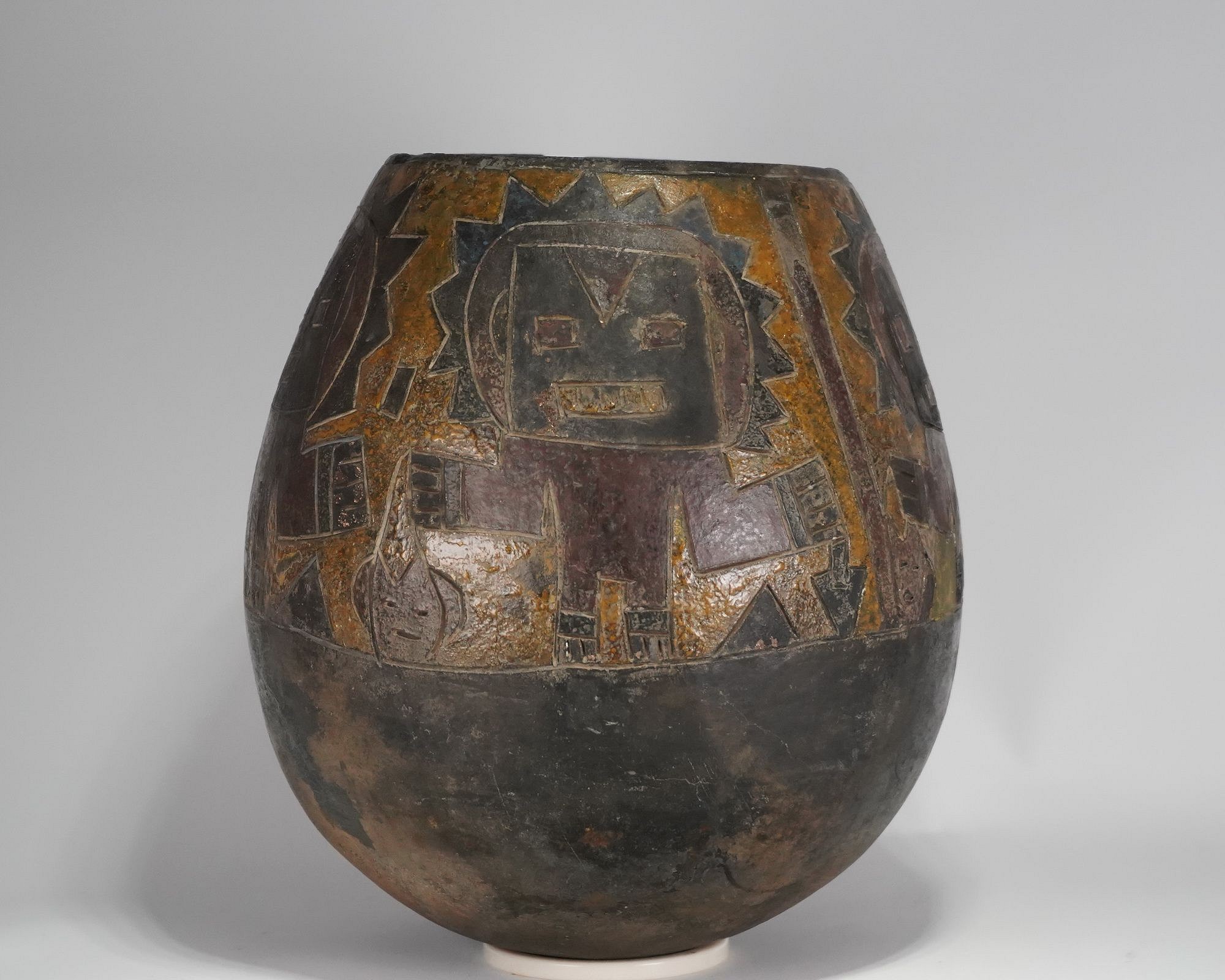





Peru, Paracas Style Ceramic Ovoid Urn
This beautiful ceramic funerary urn features four warriors, crafted with both lines and color applied to the surface with resin painting. Each shamanic warrior holds a trophy head, and one warrior also holds an obsidian pointed knife. The post fire resin painting features copper hued reds and browns, marron, yellow ochre, and dark blue. These large ovoid urns are rare, unique to a small 150 km area between the Pisco River and the Ica River, circa 200 to 100 BC. The shape and the drawing of the figures' facial features indicates that the urn is likely from the Late Paracas Period, Paracas Phases 9 and 10. A similar vessel from the same region in the collection of the National Museum of the American Indian is illustrated in Indian Art in South America, by Frederick Dockstader on page 100 and in PAINTED CLOTH MUMMY MASKS OF ICA, PERU,fig. 21.
Cracks restored especially to the lower section. There are large areas of loss of the original pigment.
Acquired by David Bernstein in 2012.
Period: Peru, Paracas, Ocucaje Phase 9, Ica valley, South Coast, c. 300 - 200 BC
Period: Peru, Paracas, Ocucaje Phase 8, Ica valley, South Coast, c. 300 - 200 BC
Media: Ceramic
Dimensions: Height: 11" x Diameter: 9 1/2"
$18,500
n2112
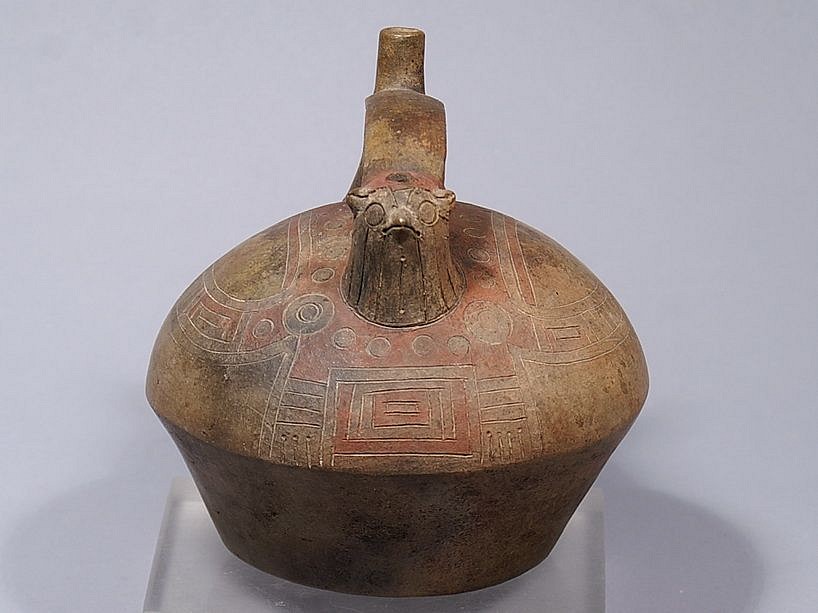







Peru, Paracas, Juan Pablo Style Falcon Bridge-spout Vessel
The blind spout at one end of the bridge handle of this vessel is modeled with a falcon's head, a typical feature of the Early Paracas style found at the Juan Pablo site. The surface on the upper body of the vessel has been delicately incised and painted to show the outstretched wings and tail feathers of the falcon. The falcon's body is decorated with circular pelt markings in a precise arrangement, with clearly delineated talons. The lower portion of the body has been left undecorated, as it would have been buried in the desert sand. The overall color scheme consists of red, orange, ochre, black, and cream pigments. This is a beautifully preserved example of Phase 3 of the Early Paracas period, in contrast to most Juan Pablo vessels which have been heavily restored. Similar examples of this style are illustrated and discussed in Alan R. Sawyer's "Ancient Peruvian Ceramics: The Nathan Cummings Collection," published by The Metropolitan Museum of Art, New York in 1966. Ex Collection of Jerome Pustilnik, acquired from Alan Lapiner prior to 1970.
Period: Peru, Paracas, Ocucaje, South Coast, c. 300 - 200 BC
Period: Peru, Paracas, Ocucaje, South Coast, c. 300 - 200 BC
Media: Ceramic
Dimensions: H. 5 3/4 x L. 5 1/2 in.
$8,500
91002
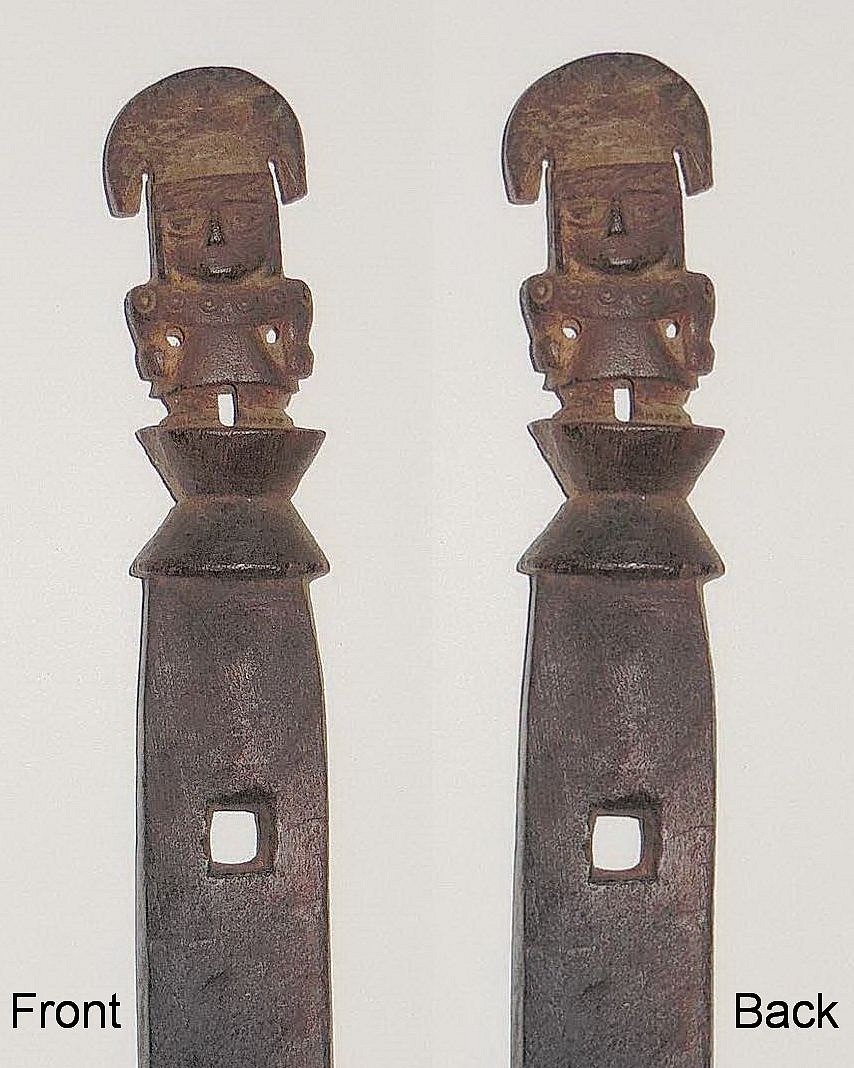









Peru, Pari of Huacho Carved Baby Carrier Posts with Reversible Figures
These beautiful wood baby carrier posts are elaborately carved with figures at the top. Each figure is reversible and appears fully carved form either side. Texas collection, prior to 1990.
Period: Peru, Huacho Valley, Late Intermediate Period, c. AD 700 - 1100
Media: Wood
Dimensions: Length: 31"
$2,400
p2030H
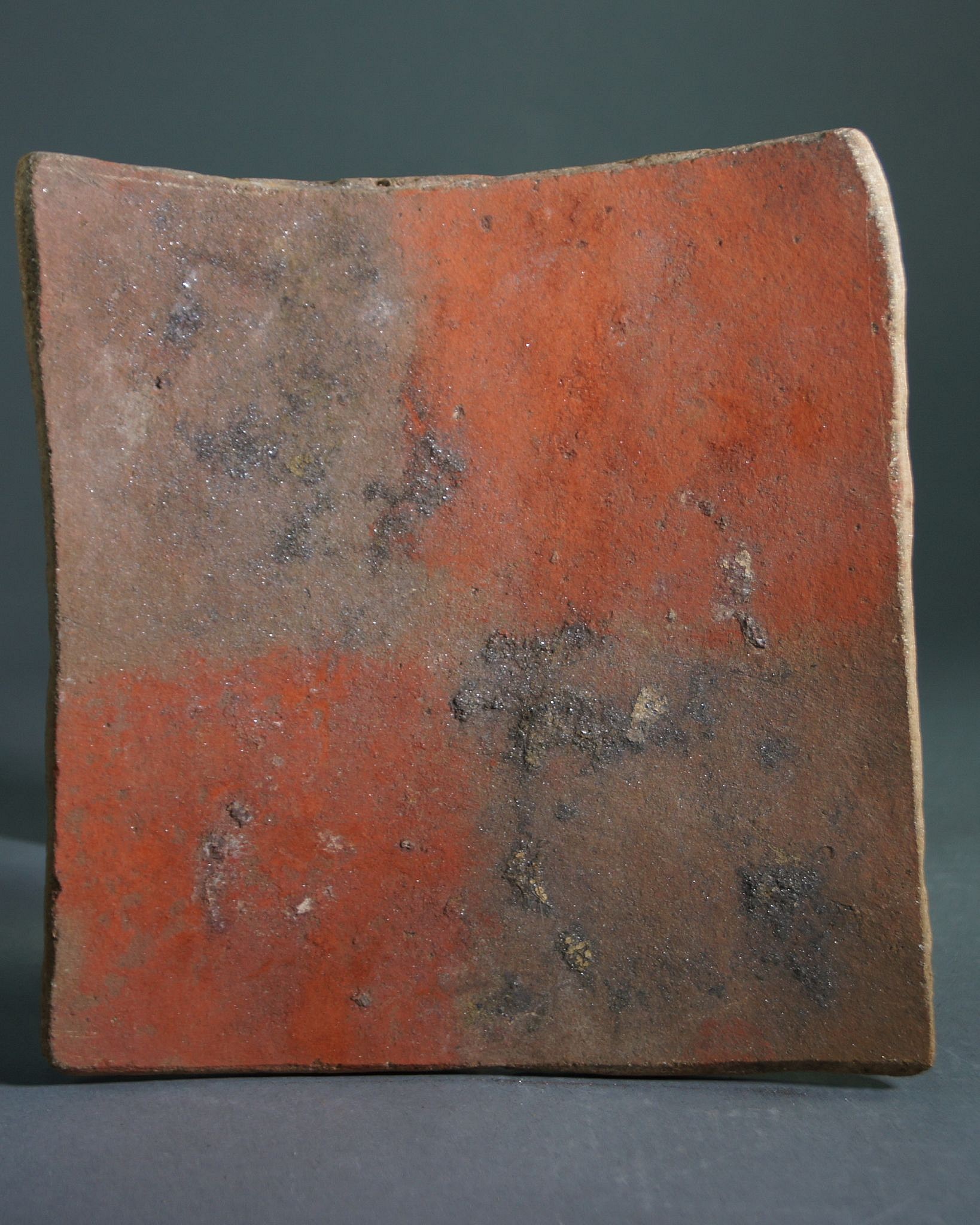





Peru, Pre-Inca Chucu “Tile” with Geometric Checkerboard
These "tiles" or “plaques known as Chucus, are offerings to the mountains. They are made from large storage vessels broken or collapsed and recycled with the inside wall painted with mineral pigments and hematite. They are found in caves stacked on top of each other and are generally considered as offerings to the gods for water and fertility. These plaques were string cut into squares or rectangles in sizes ranging from 5” to 18” squared. The “tiles” are decorated with a Checkerboard of Cinnabar and Hematite. Similar examples are illustrated in ANCESTORS OF THE INCAS-The lost Civilizations of Peru by Kauffman- Doig, pg.141
Period: Peru, Ica/Chincha, South Coast, c. AD 1000 - 1450
Media: Ceramic
Dimensions: Length 6" x Width 5.5"
$500
MM714
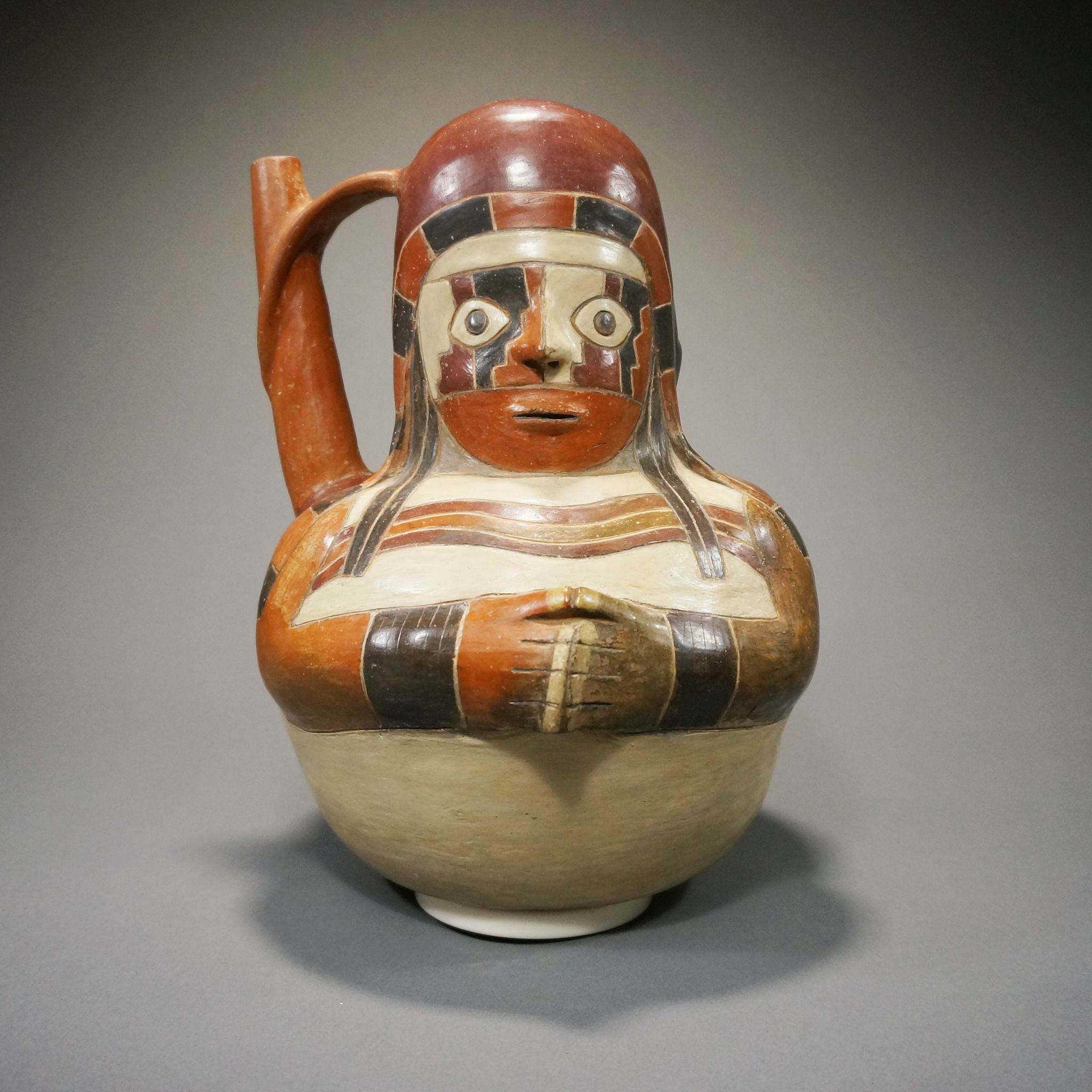
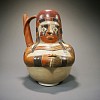


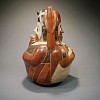
Peru, Proto Nasca Janus Head Effigy of a Smoker
This rare Nasca Janus-headed shaman has two faces, one on either side; both faces depict the same individual who morphs in behavior as the vessel is rotated, telling a narrative story. At the starting side of the narrative, the shaman is smoking a psychoactive plant, possibly tobacco combined with another entheogen. When the vessel is rotated, the same shaman has his face painted and is starring as if he is in a trance. In addition, he is seen wearing an elaborate ritual garb that includes a headdress, a face mask with a step-fret design, and a band of three waved lines across his chest. These garments were not every day utilitarian clothing, and instead indicate a ritual shamanic costume reserved for important ceremonies. The archaeological record indicates that many ancient Andean cultures may have smoked or drank preparations that contained mixtures of tobacco combined with other psychoactive substances. There are very few representations of people smoking in Andean art, but the Spanish chroniclers describe the prevalence of smoking tobacco among the Inca. The early date of this ceramic suggests the use of tobacco in Pre-Columbia as early as AD 100. Acquired in 2004 in Paris. Formerly in the collection of Jean Lions.
Period: Nasca, Proto Phase, South Coast, c. 100 BC - AD 200
Period: Peru, Nasca, Proto Phase, South Coast, c. 100 BC - AD 200
Media: Ceramic
Dimensions: Height: 10 1/4"
$28,000
M4047
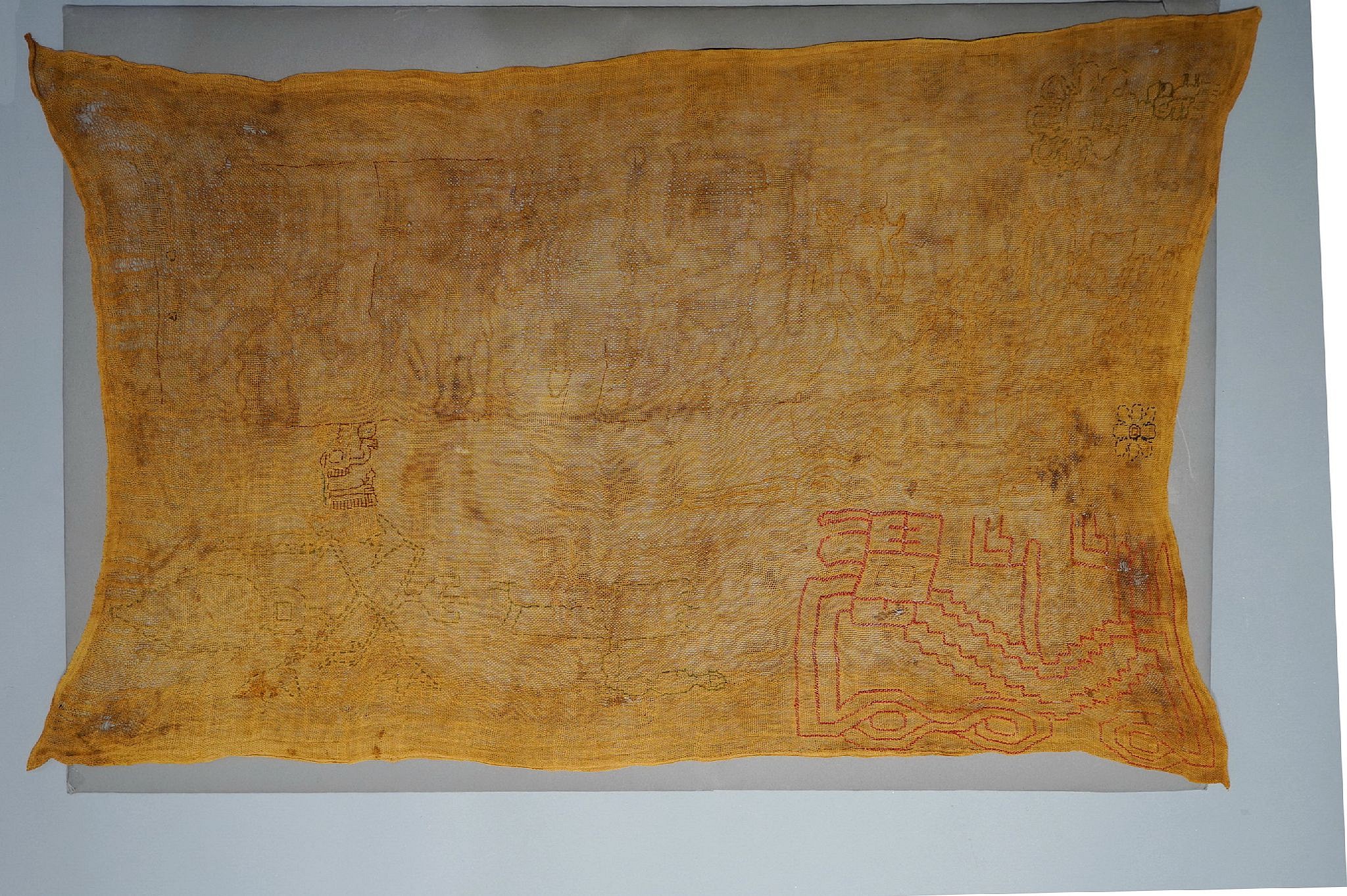








Peru, Proto-Nasca Sampler with Ten Unfinished Images
This intact sampler from the Cabildo site in the upper section of the Rio Grande de Nasca is described by Alan Sawyer in his book EARLY NASCA NEEDLEWORK, published in 1997. The woven backing cloth is complete, but the embroidered figures are still in progress and include partially finished figures and one red serpent. This textile shows how the Nasca craftsmen painted the imagery on the textile first, then outlined each figure with thread, and finally embroidered the imagery. The finished sampler would be double-embroidered with multiple colors and a lexicon of mythological characters and symbols. The book is an excellent reference for study of the richness and complexity of early Nasca imagery. This is a very rare example, as most are in the permanent collections of major museums, including the Art Institute of Chicago, the Metropolitan Museum of Art, New York, and the Textile Museum in Washington D.C. Ex. collection of Nobuko Kajitani, former chief textile conservator at the Metropolitan Museum of Art, prior to 1975.
Period: Peru, Nasca, Proto Phase, South Coast, c. 100 BC - AD 200
Period: Peru, Nasca, Proto Phase, South Coast Calbildo in the Rio de Grande de Nasca, c. 100 BC - AD 200
Media: Textile
Dimensions: Width: 32" x Height: 18"
$11,500
89100
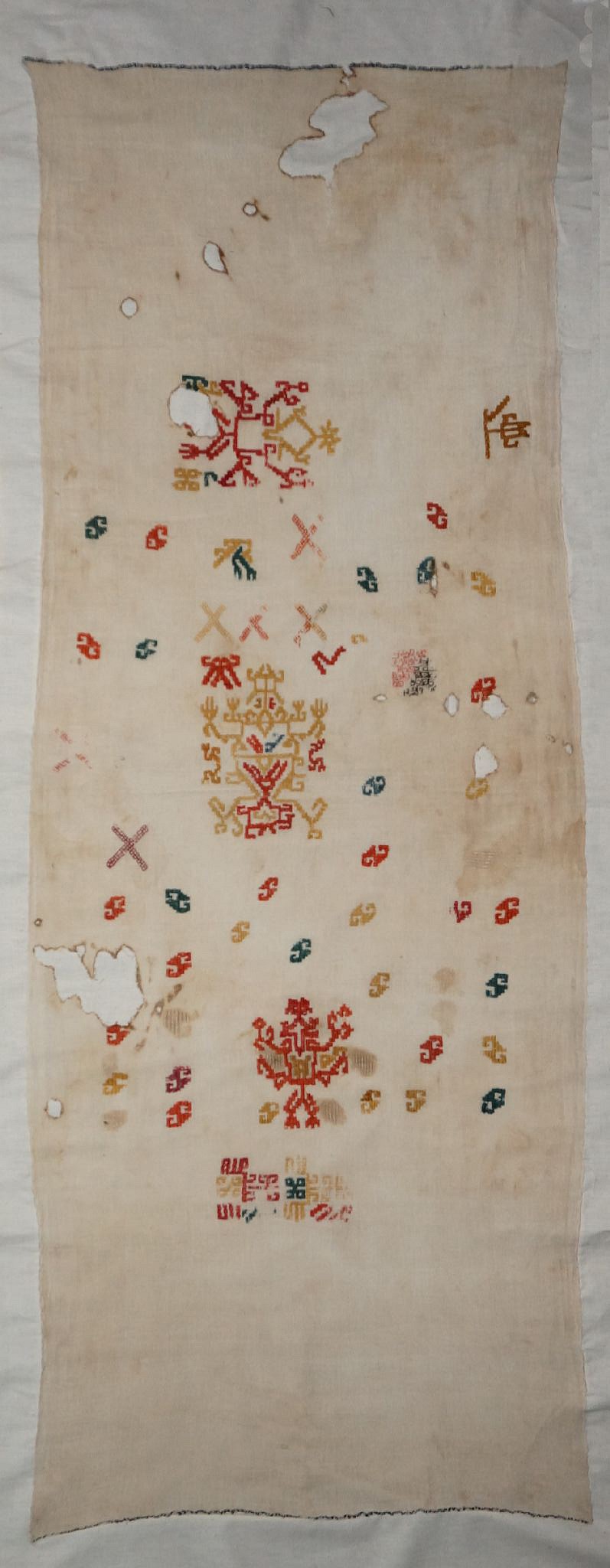



Peru, Proto-Nazca "Cabildo" Sampler with Three Figures in Gold and Red
This sampler is embroidered with abstract creatures with their hands held upwards. The sampler is embroidered with camelid dyed fiber in red, green and gold on a fine woven white cotton ground. The two figures at opposite ends have arms and legs with fancy appendages at the waist and an abstract face on top of each head. Samplers were used by the Paracas and Early Nasca to plan out designs for large textiles. The central figure appeas to be a shaman with a large head wearing a crown with three appendages on each side embroidered in gold. Nested inside the central figure is secondary figure embroidered in red, depicted upside down as if it is falling. The sampler is embellished with 42 individual connected step-volute patterns in red, green, gold and brown. In addition, there are five X's interspersed in the design. The panel is complete, in good condition, with all sides selvaged, and professionally lined. There are 3 small holes and 7 very small holes. Similar samplers are discussed and illustrated in "Early Nazca Needlework" by Alan Sawyer.
Period: Peru, Paracas, Ocucaje-South Coast , 300 - 200 BC
Period: Peru, Cabildo, South Coast, c. AD100 - 200
Media: Textile
Dimensions: Length: 63" x Width: 22"
$6,500
93129
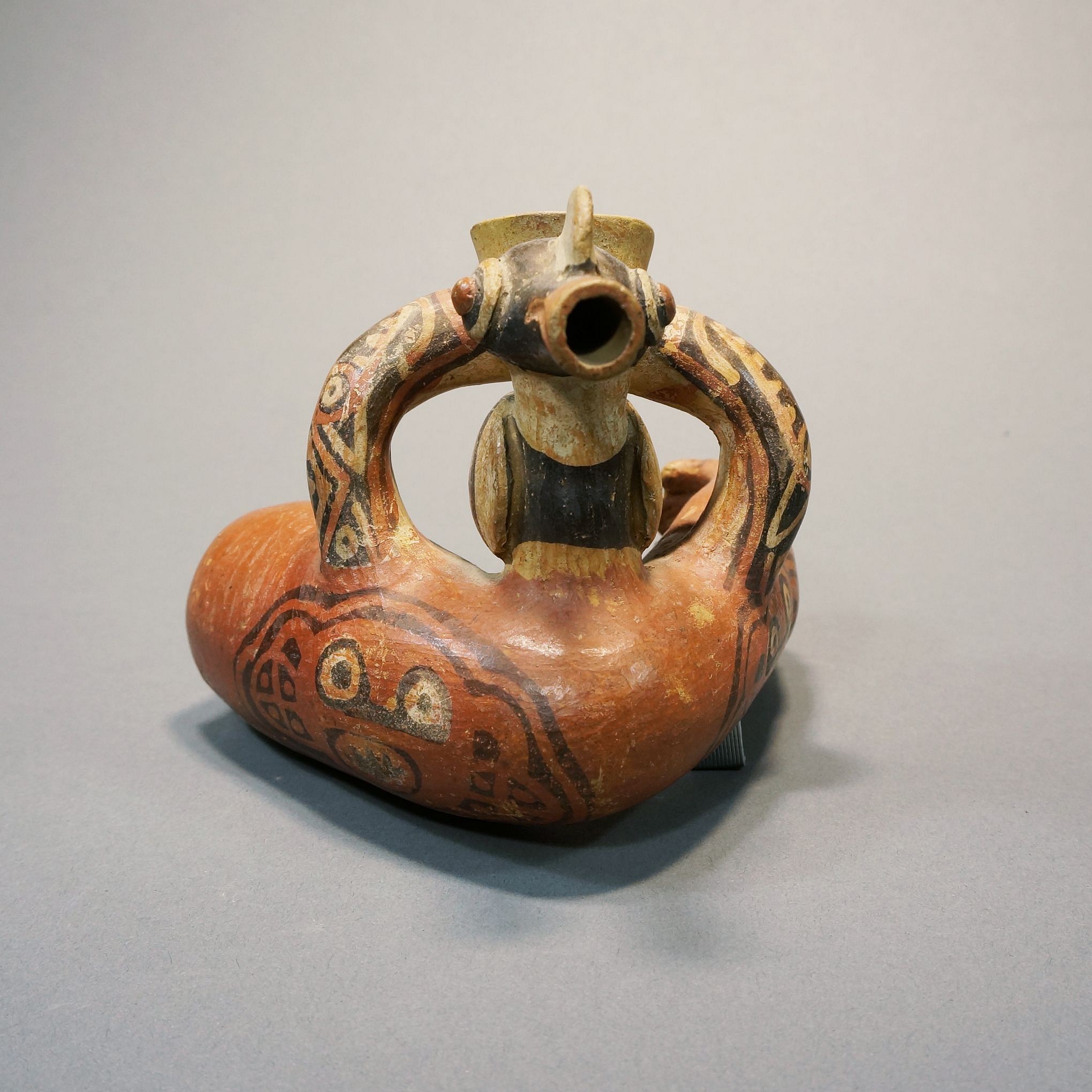
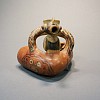
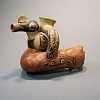
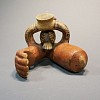
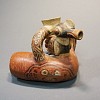
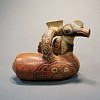
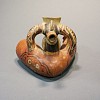


Peru, Recuay Bridge Spout Effigy Vessel
This unusual figurative effigy depicts a clenched human arm decorated with a tattoo of a face with ear spools and a large-eye condor siting under the bridge spout.  The painted face is referred to as the "circular head motif" and signifies a celestial deity (Grieder, Terrence, The Art and Archaeology of Pashash, 1978). The condor is the largest and most powerful bird in the Andes. The clenched fist motif depicts a severed bone, the meaning of which is not clear, however, condors were known to eat the remains of sacrificed captives.  A similar example is in the Berlin Volkeunde museum and is illustrated in KULTUREN RECUAY IV by Deiter Eisleb, pg.194.
Period: Peru, Recuay, North Highlands, c. 300 BC - AD 700
Media: Ceramic
Dimensions: Height 4 1/8"
$3,500
96148
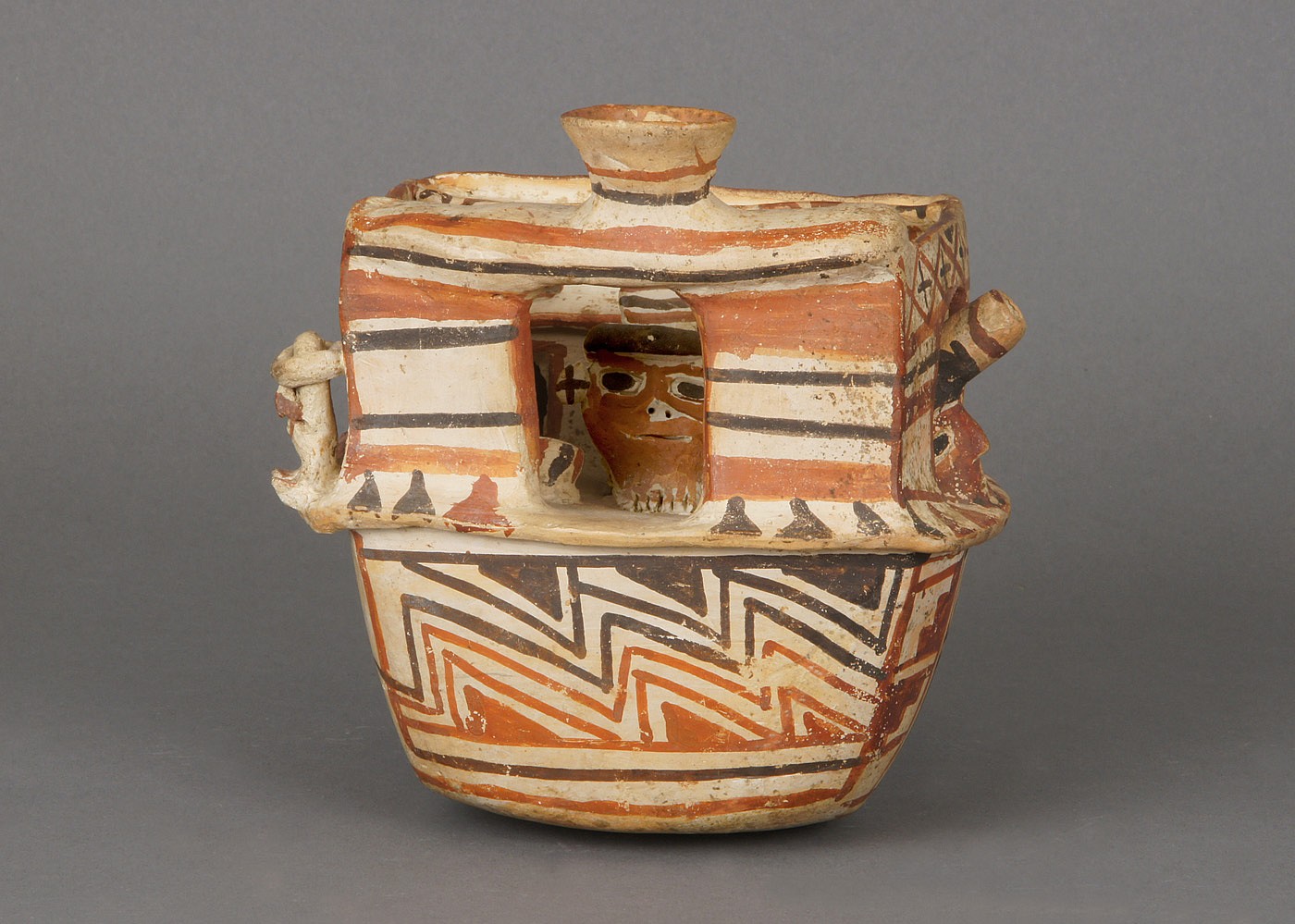









Peru, Recuay Ceramic House Scene
Creamware with geometric painted designs in red, orange and brown polychrome. This is an elaborate house model with six figures modeled inside. This is one of the few houses with two windows and a door, as most of the known examples have only one opening. The house is also a good example of negative resist decoration, which was characteristic of Recuay ceramics. Similar examples are illustrated in Lapiner, "Pre-Columbian Art of South America" (1976: pls. 422 and 433).
Period: Peru, Recuay, North Coast, circa 300 BC-AD300
Media: Ceramic
Dimensions: Length: 5 in x Width: 5 in. x Height: 5 in.
$8,000
M2032
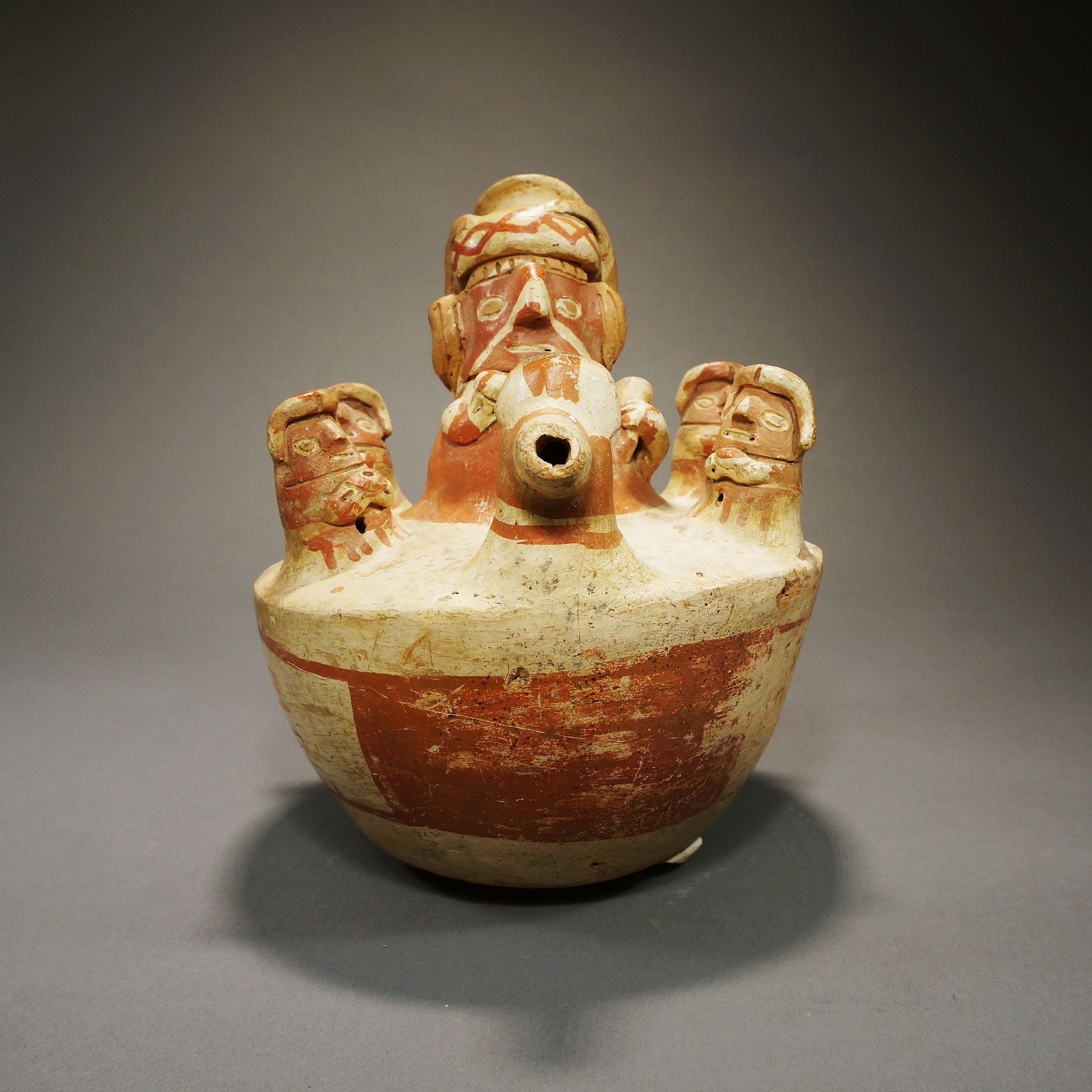
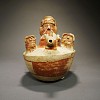
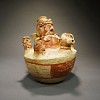
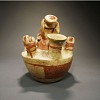



Peru, Recuay Ceremonial Procession or Audience Vessel
A shaman is the central figure surrounded by five attendants all holding what appears to be lime containers for the coca chewing ritual. The shaman is wearing an elaborate headdress while the attends are wearing cloth headdress. Decorated in orange slip on white ground. A very similar piece is illustrated in ALTPERUANISCHE KULTUREN - RECUAY IV pg. 117-120
Period: Peru, Recuay, North Highlands, c. 300 BC - AD 700
Media: Ceramic
Dimensions: Height 8" x Diameter 6.5"
Price Upon Request
M9014
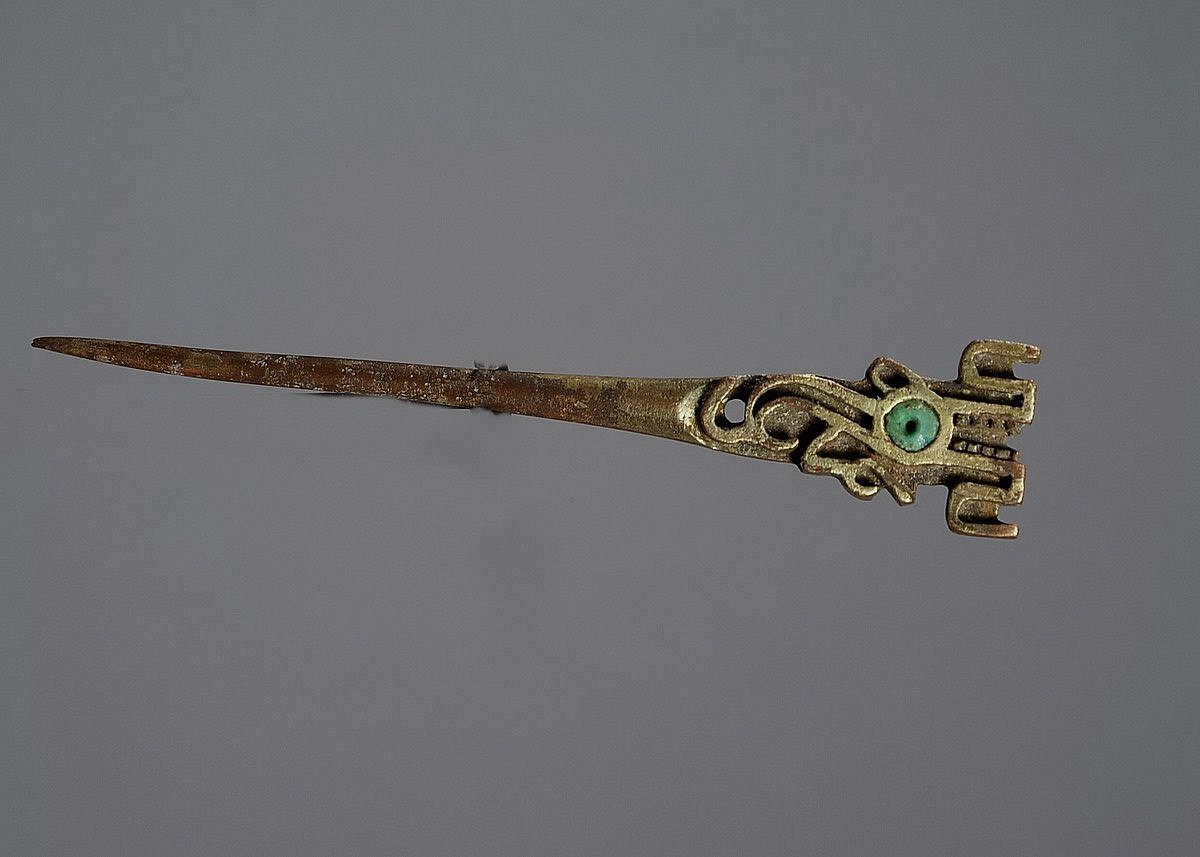





Peru, Recuay Gilt Copper Pin Decorated with the Moon Animal
This is a short tupú with a filigree design of the Moon creature, a North Coast deity invented by the Recuay and adopted by later societies. The creature may have been modeled after the Pampas Cat or the Andean Mountain Cat, a small feline that inhabits the region. The Recuay and Moche associated the Moon Animal with the crescent moon, stars and human sacrifice. There is a turquoise bead in the eye; other recessed areas of the casting also had inlays, which have been lost. Few Recuay gilded works have survived because the gilt tends to fall off over time. The Recuay had sophisticated techniques of metalworking, and this example is extremely well crafted. The gilding is thick (about 1mm). A similar pin was found at a Recuay site, and is on display at the American Museum of Natural History.
Period: Peru, Recuay, North Highlands, c. 300 BC - AD 700
Media: Metal
Dimensions: Length: 3 1/2" x Width at top: 5/8"
$1,700
M2029
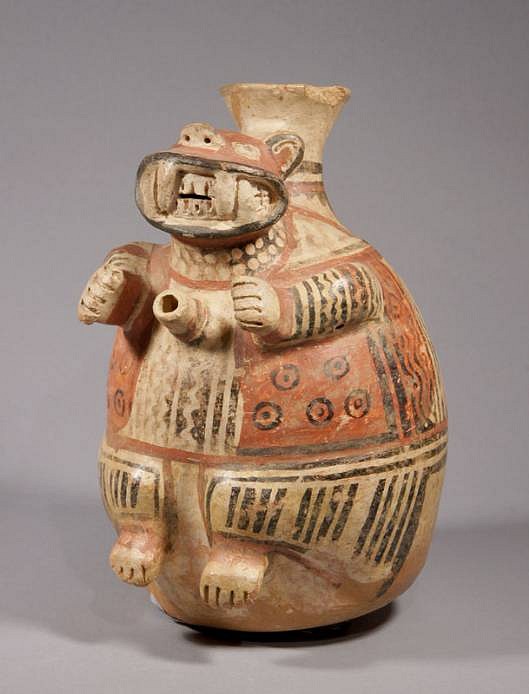







Peru, Recuay Mythical animal effigy vessel
The animal has attributes of a feline with oversized incisors and a long tail in the rear. The animal is anthropomorphic with human hands and feet displayed in a sitting position. He has red slip and negative resist decoration on a white ground. This motif is unusual in that the same posture is mostly represented by males on ceramics, while this is an animal. I know of other such examples illustrated in the literature.
Period: Peru, Recuay, North Coast, circa 300 BC-AD300
Media: Ceramic
Dimensions: Height 8"
Price Upon Request
M9015

Peru, Salinar Gold Filigree Earrings
This is an early example of Pre Moche ear ornaments utilizing the filagree technique, soldered wire in a spiral design. The design is fitted between a single bent and hammered curve. Mastering soldering of thin wires is a very difficult technique as the heat can melt the entire construction if done poorly. Similar earrings are illustrated in the book, TRUJILLO PRECOLUMBINO, Odebrecht, 1990, pg.297.
Period: Peru, Salinar- North Coast, c. 400 - 100 BC
Media: Metal
Dimensions: Each Height: 1" x Width: 0.9" Weight: 2.3 grams. combined.
$950
p1060



Peru, Salinar Group of Fourteen Gold Filigree Ear Ornaments
A group of 14 Salinar gold filigree nose ornaments of various designs and sizes. The Salinar people preceded the Moche on the North Coast of Peru in the Trujillo region. Ancient coastal Peruvians did not have access to bees or beeswax due to the dry coastal desert environment and were unable to use the lost wax casting method employed in ancient Colombia. Instead, they used soldering to create elaborate filigree ornaments. Soldering is technically complex, requiring carefully controlled temperatures along with the right mix of flux. This group of 14 individual gold filigree ear ornaments demonstrates the great level of skill and artistry achieved by the Salinar metalsmiths. Many of these filigree works are similar those illustrated in Trujillo Precolombino, by Jose Antonio de Lavalle, page 297. Three similar nose rings from the same region are also illustrated in RAIN OF THE MOON: Silver in Ancient Peru, published by The Metropolitan Museum of Art, 2001, fig. 1. Acquired in 2000 from a private New York collector.
Period: Peru, Salinar, North Coast, c. 300 BC - AD 100
Media: Metal
Dimensions: Range: 7/8" to 1 1/2" Width
$8,000
MM087
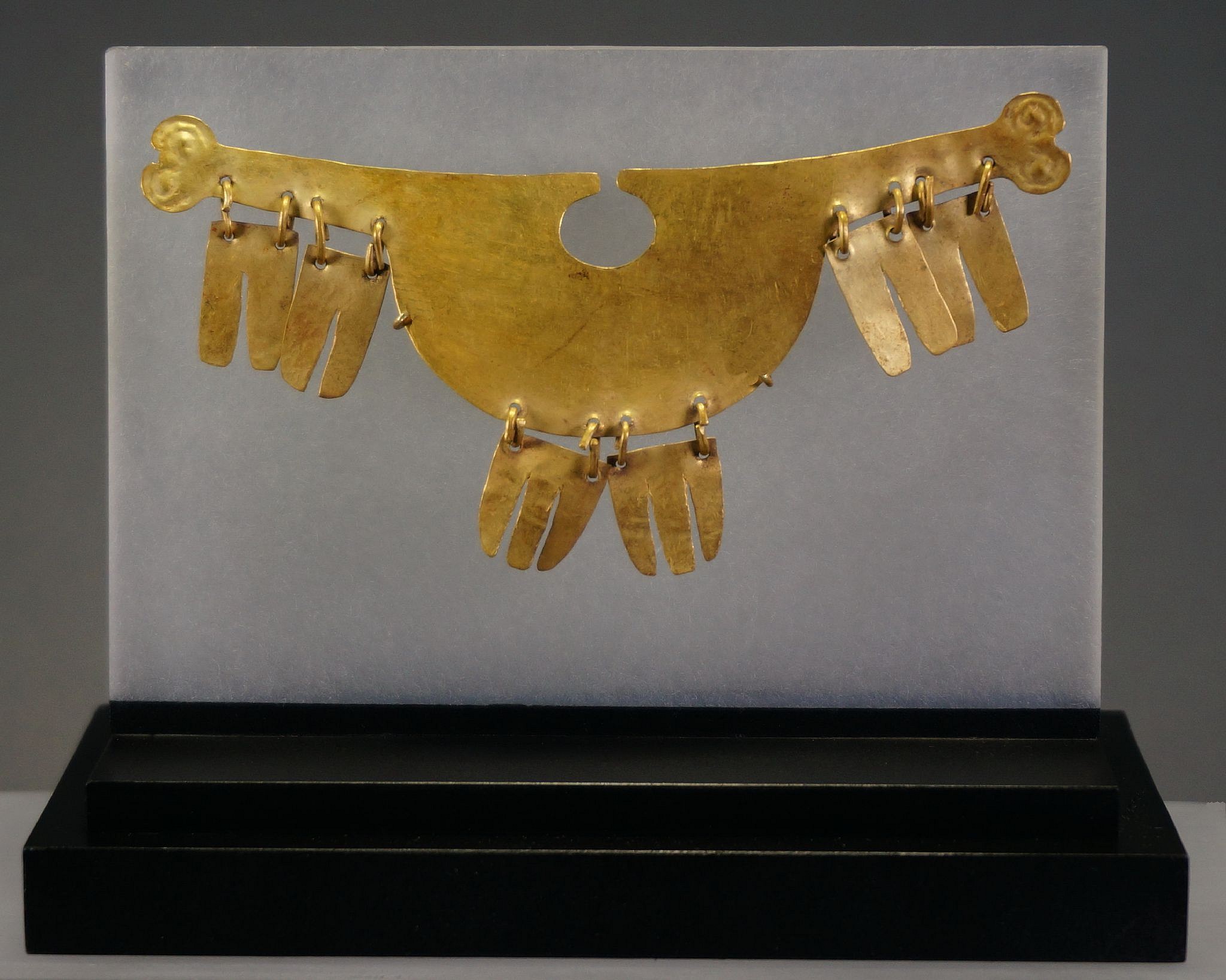


Peru, Salinar-Early Moche Gold Nose Ornament With Dangles in the Form of Bird Feathers
Unusual and rare nose ornament from the Salinar culture with stylized bird heads at each end and six dangles imitating feathers. A similar example is illustrated in "Oro del antiguo Peru" by José de Lavalle (1992: pl. 94).
Period: Peru, Viru, North Coast , c. 200 BC - AD 200
Media: Metal
Dimensions: Width 4" x Height 1 3/4"
Price Upon Request
96164
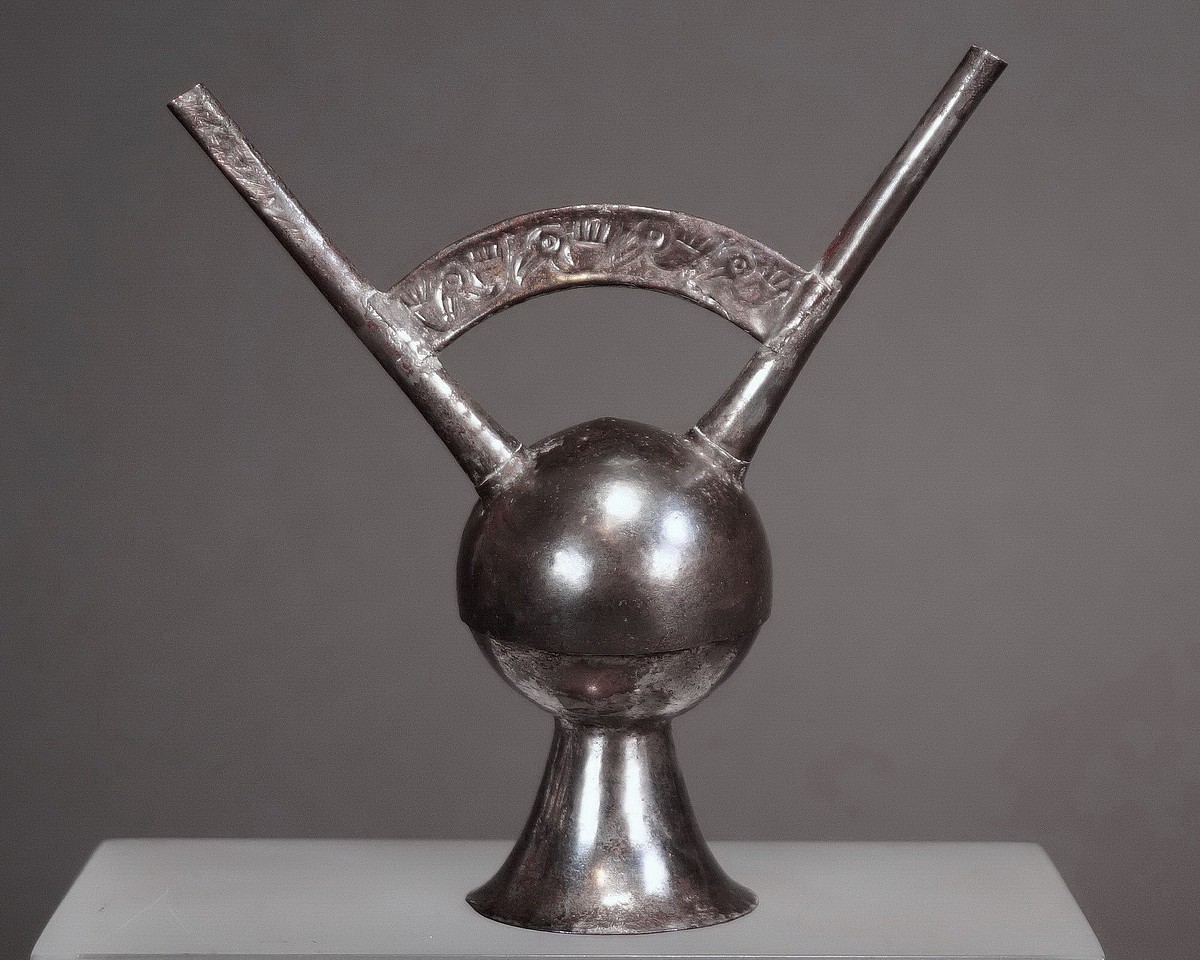



Peru, Sican Gilt Silver Miniature Double Spouted Vessel
The vessel was made for a child's tomb. It has an arched bridge with four marine birds embossed on each side and is made from 6 components that are soldered together. The base metal is copper, and there is a thin outer layer of silver, which is worn in a few places. Gilding, the method used to create this vessel, was a much more difficult process then sculpting with pure silver.
Period: Peru, Sican, Batan Grande (Upper Leche River Valley), North Coast, c. AD 850 - 1150
Media: Metal
Dimensions: Height: 5" x Width: 4 3/4"
Price Upon Request
n8036
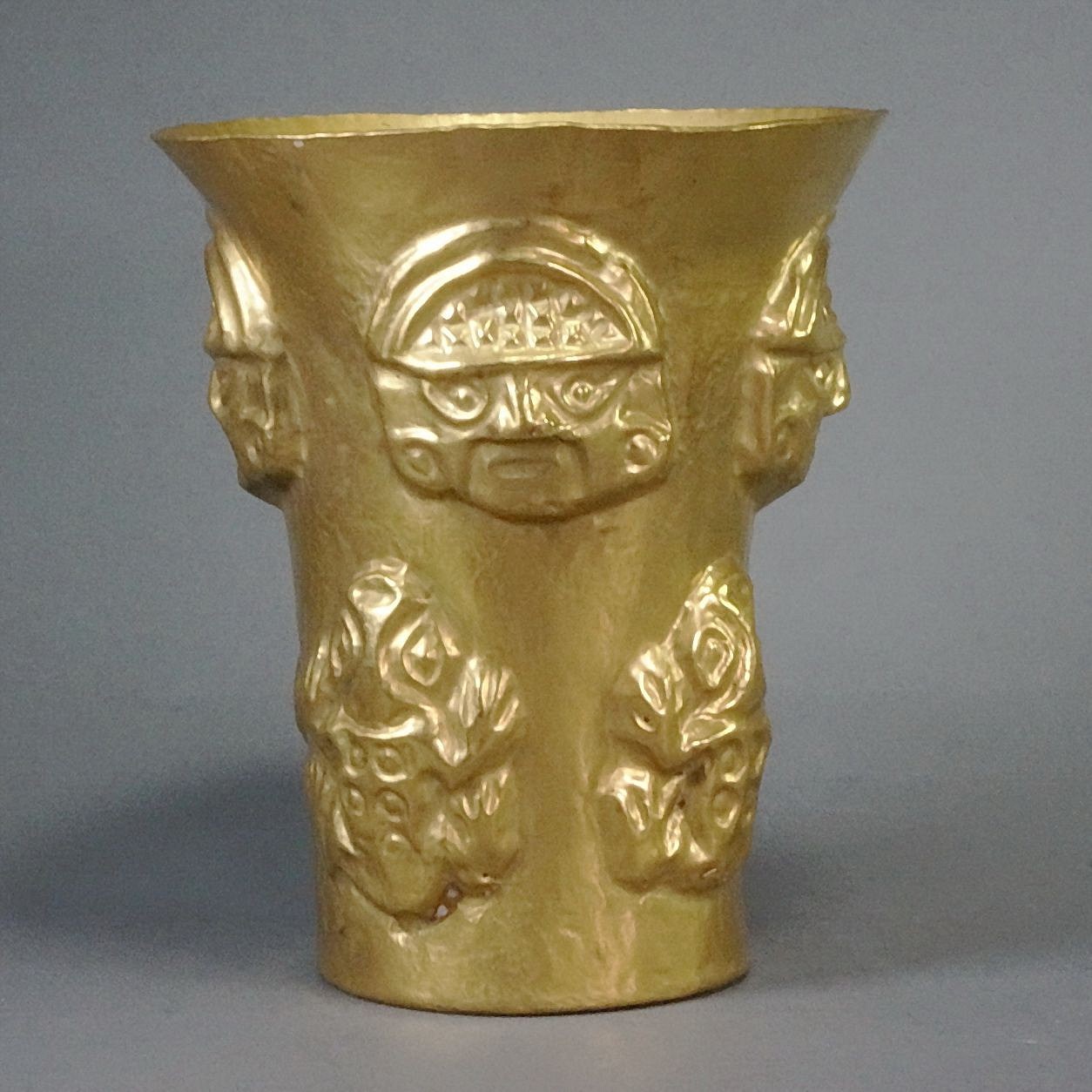
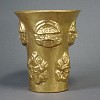




Peru, Sican Gold Beaker with Mask and Frog Motif
The Sican cache of gold came from the largest burial in the Americas at hacienda Batan Grande near the Chimu City of Chan Chan. These beakers were used to drink the ceremonial Chicha (Corn Beer). The masks and flared beakers were the most notable objects from this burial. The beakers came in various designs from frogs to Warriors. This beaker is unusual in that it has both masks and frog motifs. Illustrated in THE ART OF PRECOLUMBIAN GOLD, pg.227 the on the right. Exhibited in 1964, Los Angles # 202. Ex-Jan Mitchell collection, prior to 1980.
Period: Peru, Sican, Batan Grande (Upper Leche River Valley), North Coast, c. AD 850 - 1150
Media: Metal
Dimensions: Height: 5. 1/8" Diameter at top: 4 3/8" Weight: 184 grams
Price Upon Request
n7054




Peru, Sican Gold Flared Beaker with Embossed Toads
Bufo Marinus toads, depicted on this vessel beaker, are found on the dry coastal desert coast of Northern Peru. These toads are identifiable by their highly textured skin, represented by six sets of incised circles. Acquired from a private Texas collector, prior to the 1970s. Some traces of cinnabar.
Period: Peru, North Coast, Sican, Batan Grande,
Media: Metal
Dimensions: Height: 51/2" x Width: 4.2" Weight: 118 grams.
$32,000
N6001
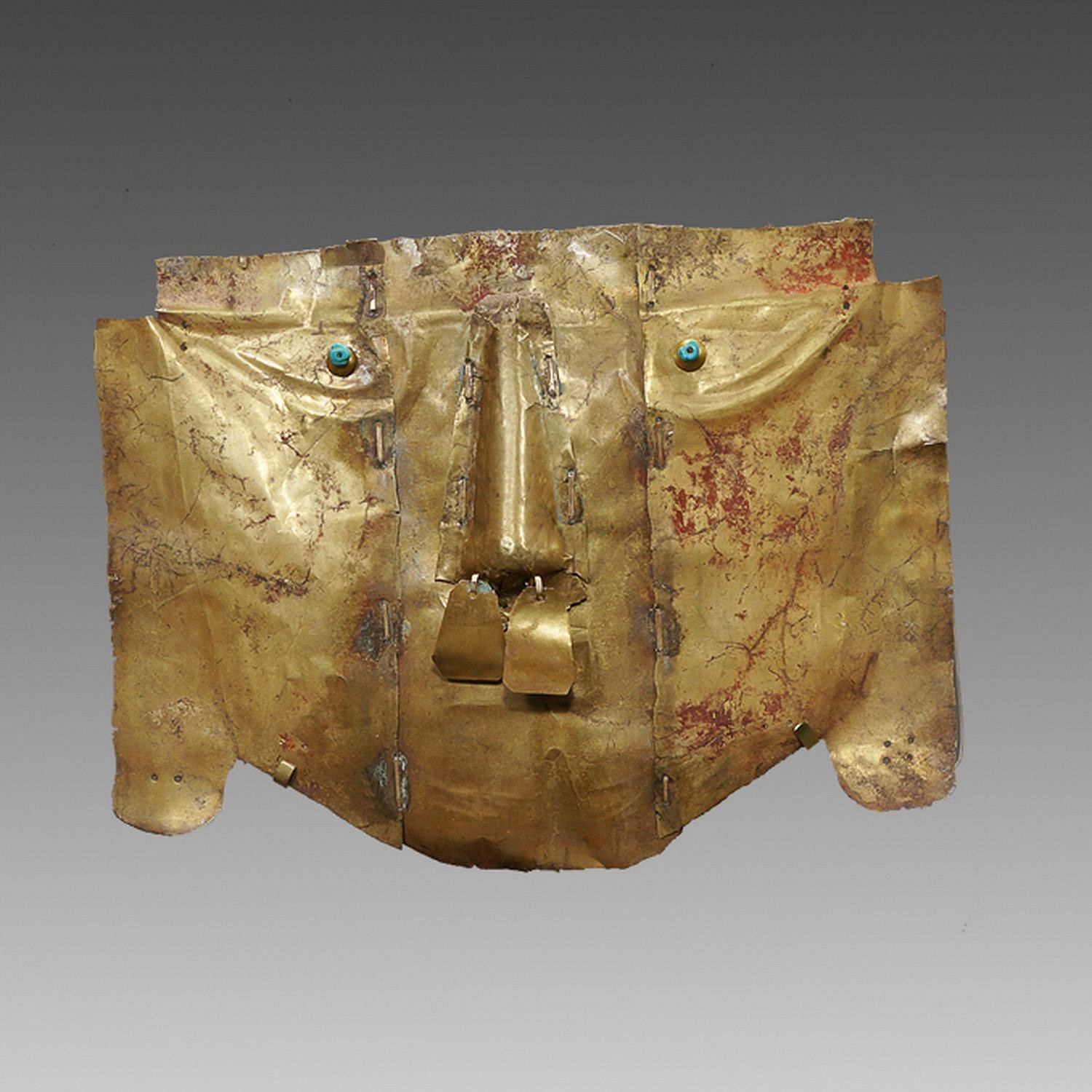
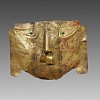




Peru, Sican Gold Mask of the Third Type
A classic type of mask from the 3rd Phase, constructed in 3 parts and held together by ancient gold staples. The eyes have turquoise bead pupils with gold hemispheres. Traces of the original cinnabar remain. Sicán masks are discussed in THE ART OF PRECOLUMBIAN GOLD - The Jan Mitchell Collection, page 66 - see example(s). The Sicán culture was extremely wealthy and was known to have built the largest city in the Americas, Chan- Chan, outside of the modern city of Trujillo. The Sicán were excellent gold workers, and when the Incas conquered them, they brought the metalsmiths to the Inca capital of Cuzco. Similar masks are illustrated in THE GOLD OF PERU-MUJICA GAILLO Collection. Ex. Private New York Collector.
Period: Peru, Sican, c. AD 800 - 1100
Media: Metal
Dimensions: Height: 7.75" x Width 10 1/8"
Price Upon Request
n4001
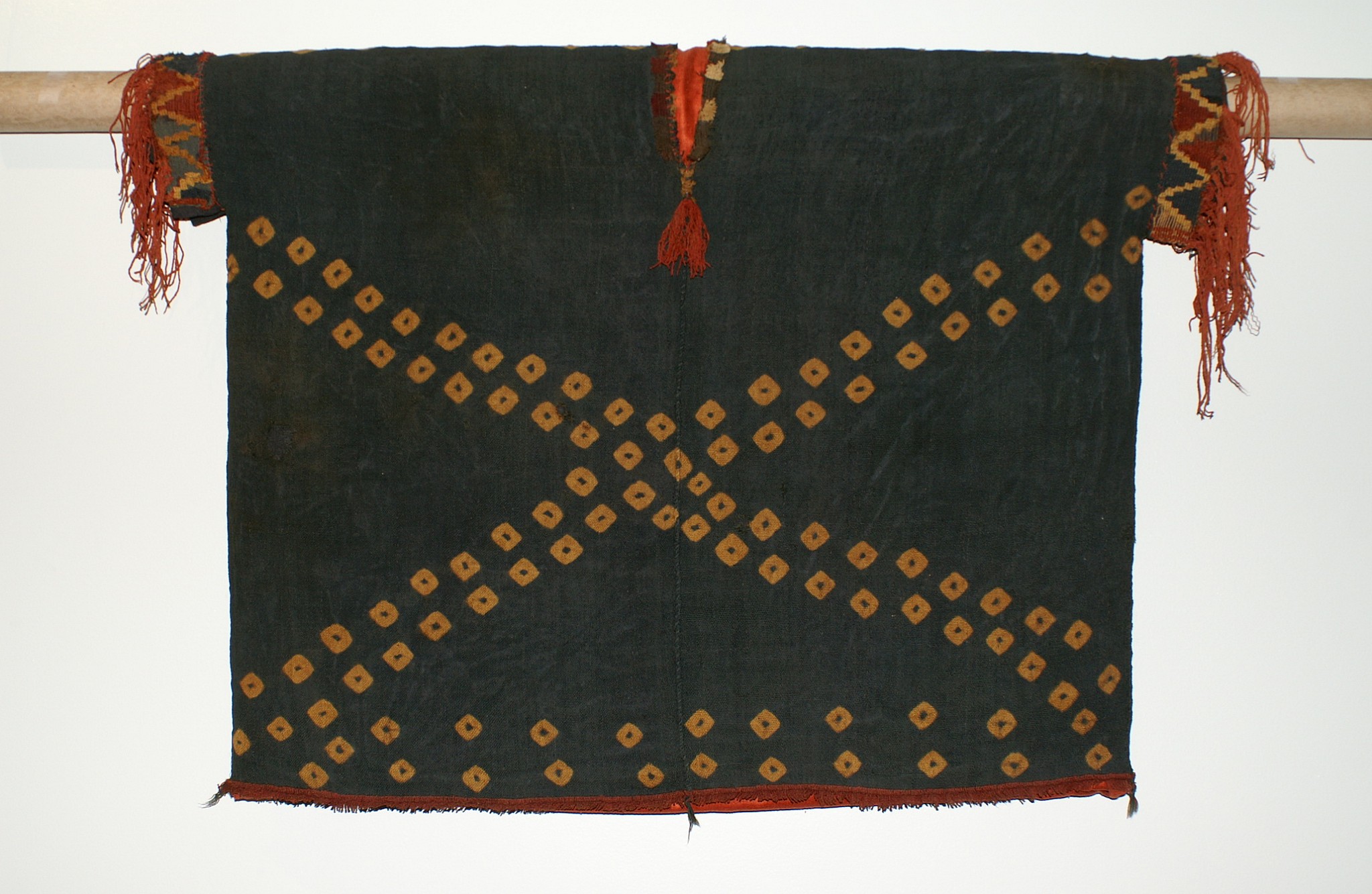



Peru, Sihuas Green Sleeved Poncho with tie-dye pattern
This is a nice poncho with diagonal yellow motifs against a green ground and red borders.
Period: Peru, Sihuas I, Southern Andes, circa 300 BC-AD100
Media: Textile
Dimensions: Height: 27" x Width: 32"
Price Upon Request
M7159
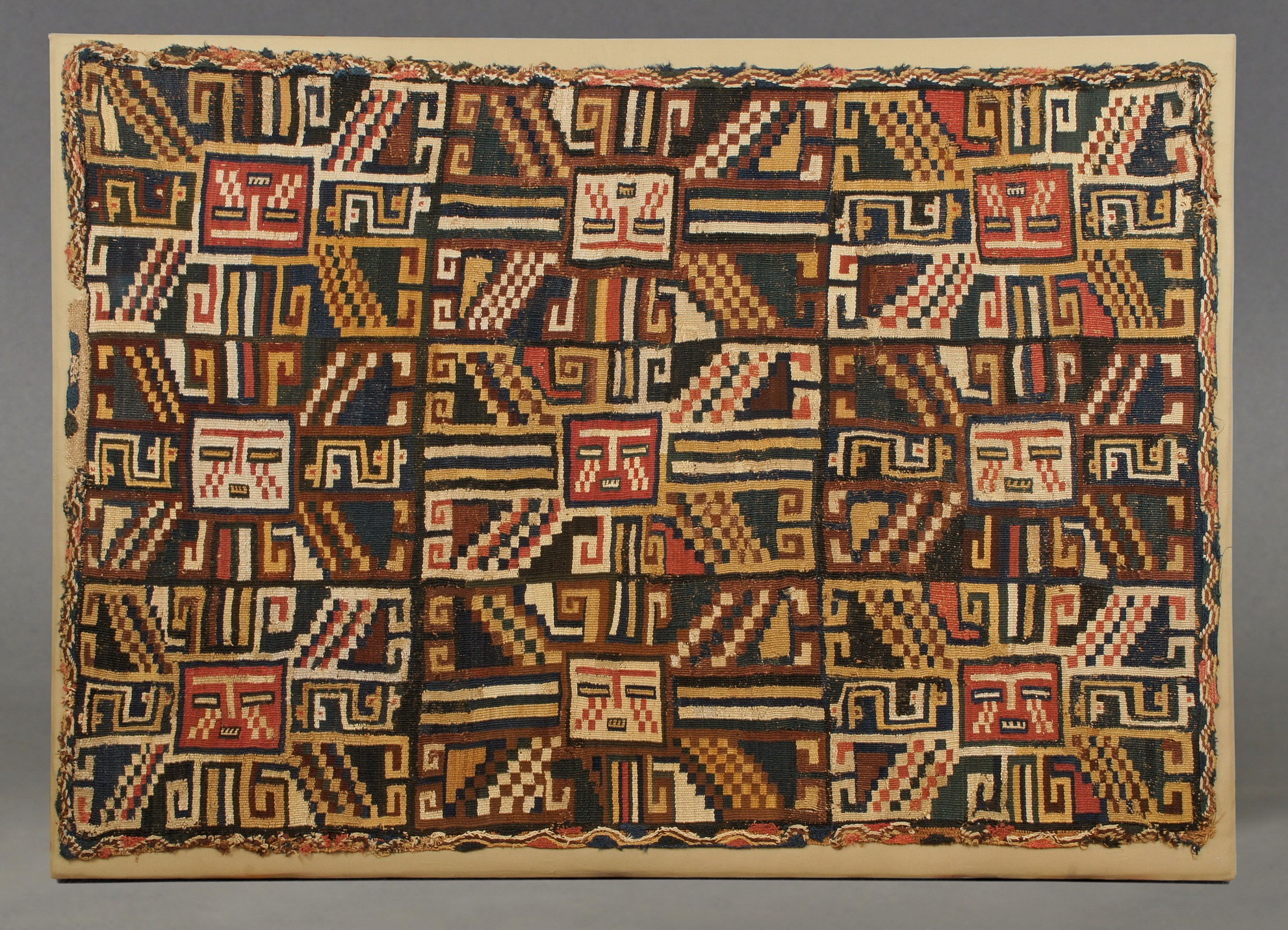



Peru, Sihuas Mantle with nine sun faces
The Sihuas sun face image was derived from the Tiwanaku Moon god. On this textile, the images are arranged 3 x 3 alternating in red and white sun faces. Rare double interlocking warp and weft with edges finished in the original pattern of a complicated oblique weave. According to Jorge Haeberle who has studied Sihuas textiles, this is one of only three known garments of this type. He thinks it was a head cloth with the opposing row of faces folded over from front to back showing the sun faces right side up on the front of the forehead. This weaving is very complicated and from the earliest Sihuas phase around 300 - 100 BC. There have been several larger Sijuas textiles with just a single sun face, while this one with the rows of faces compares to or perhaps influenced early known Tiwanaku and Pucuara weavings. The Sihuas complex of weaving began about 500 BC and was contemporany with Paracas embroideries. The Sihuas culture was eventually absorbed by the Nazca in the seventh century.
Period: Peru, Sihuas I, Southern Andes, circa 300 BC-AD100
Media: Textile
Dimensions: 37 1/2" x 46"
Price Upon Request
MM801
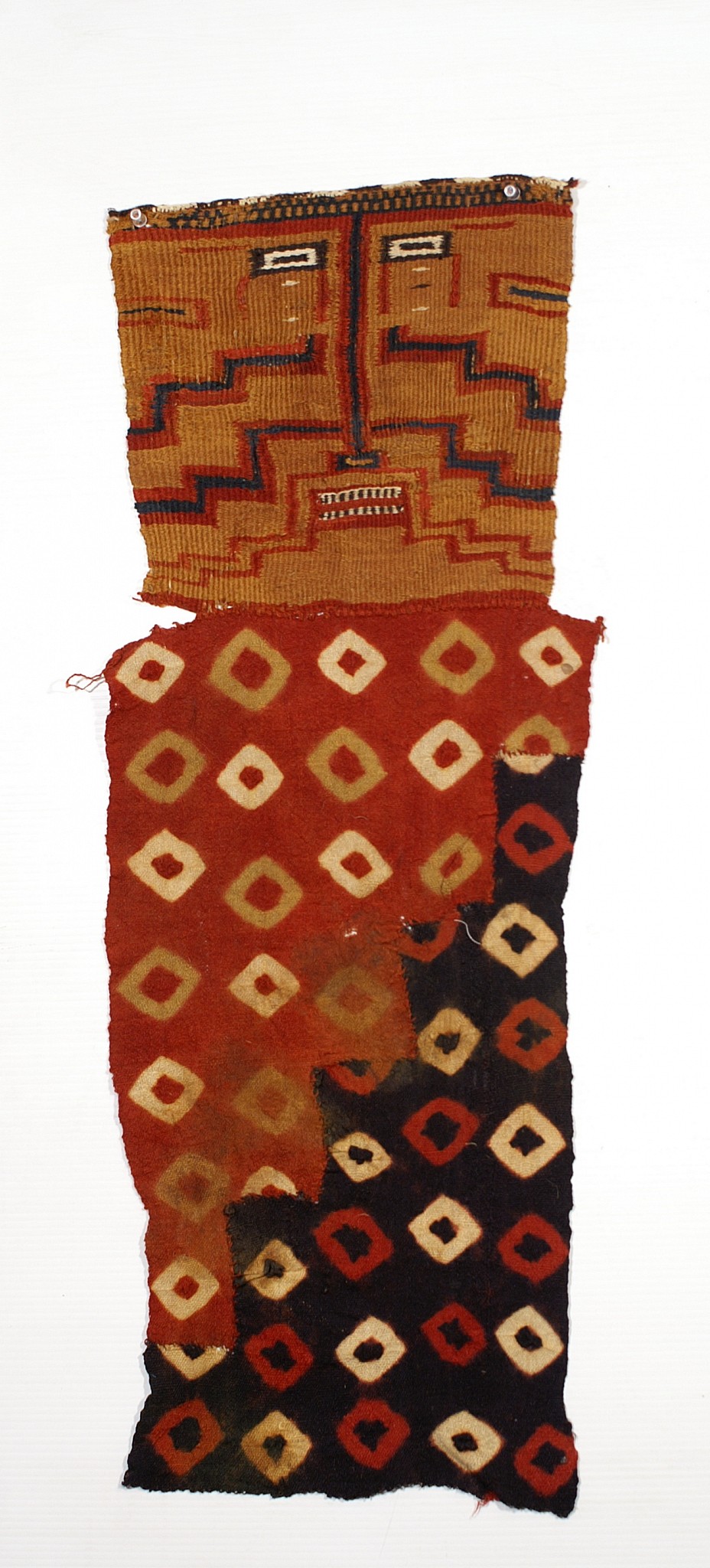
Peru, Sihuas Mummy Mask with tie-dye panel (twin blue)
This group of four panels represent a very rare type of textile in which the woven cloth was attached to a tie-dyed skirts. It seems that all four had ties at the top of the head. These textile figure cloths were probably placed over the deaceased in tombs. They date to the Sihuas III Phase.
Period: Peru, Sihuas III, Southern Andes ,circa 100 BC-AD300
Media: Textile
Dimensions: Height 46"x Width 24"
$25,000
M8050
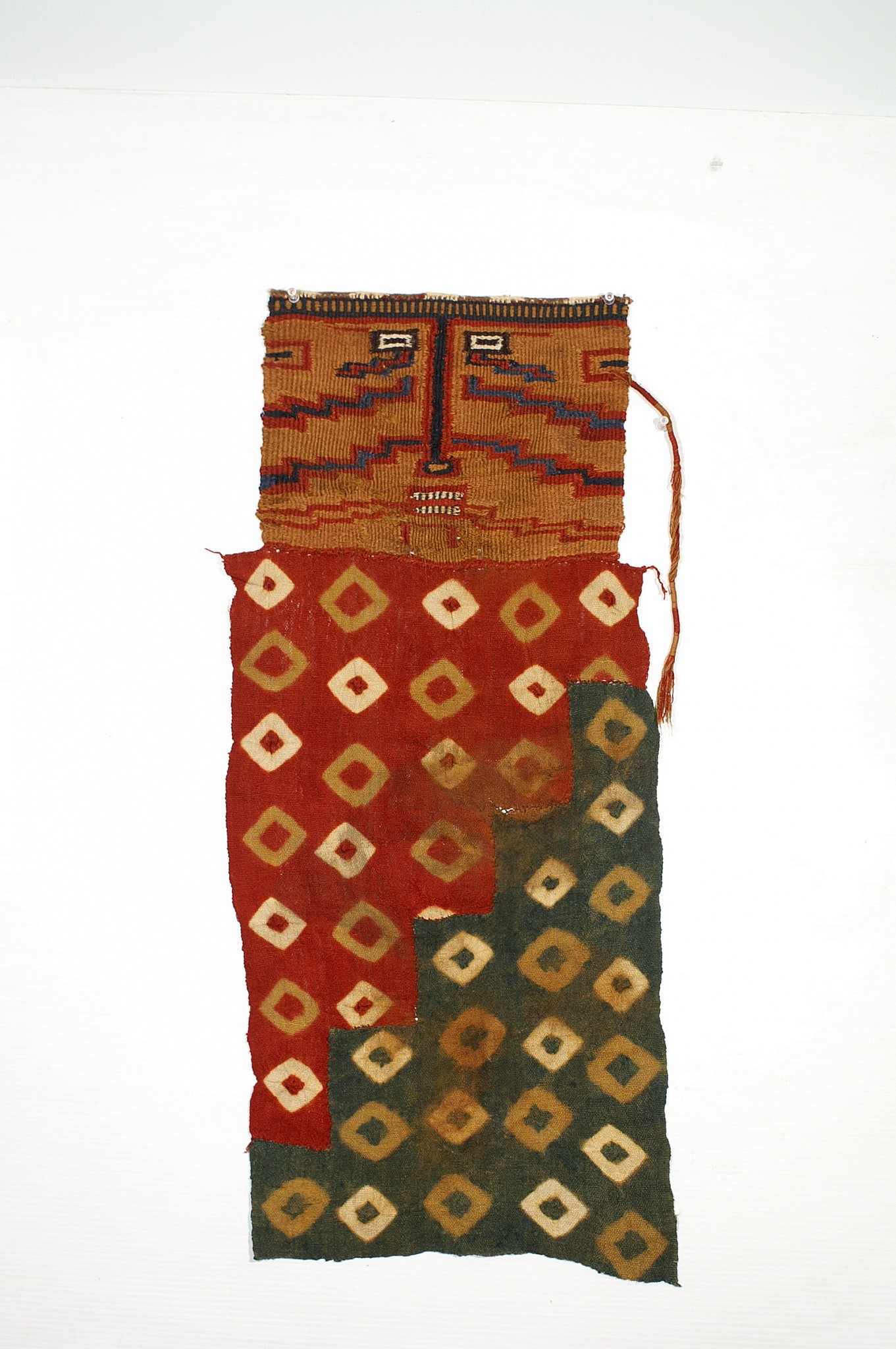
Peru, Sihuas Mummy Mask with tie-dye panel (twin green)
This group of four panels represent a very rare type of textile in which the woven cloth was attached to a tie-dyed skirts. It seems that all four had ties at the top of the head. These textile figure cloths were probably placed over the deaceased in tombs. They date to the Sihuas III Phase.
Period: Peru, Sihuas III, Southern Andes ,circa 100 BC-AD300
Media: Textile
Dimensions: Height 46" Width 27"
$25,000
M8053
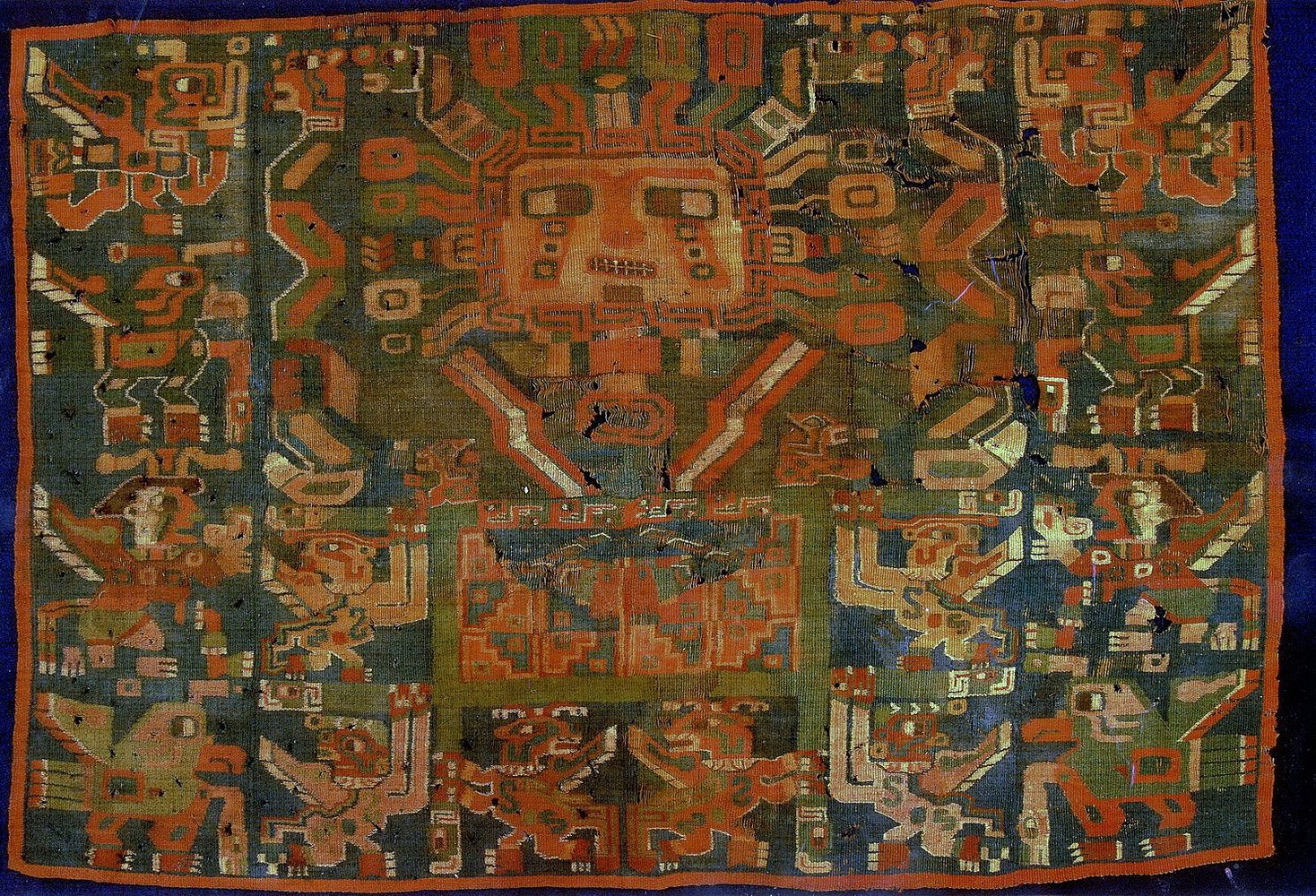





Peru, Sihuas Tapestry Panel Depicting a Sun Face Deity Holding a Staff in Each Hand
The panel depicts an elaborate Sun Face Deity holding fancy staffs with Puma heads in profile. The Deity wears a colorful headdress and an unusual chest decoration. Beneath the deity is a litter held by four attendants. In the center of the litter is a self-referential depiction of a tunic. Underneath the litter are two staff bearers that appear in front of the litter. On each side is a column of four unique kneeling anthropomorphized attendants with bird-like characteristics. Among the attendants are two figures with human faces who are blowing conch trumpets. A similar, less complicated example is illustrated in TIWANAKU: ANCESTORS OF THE INKA by Maragaret Young-Sanchez, fig. 1.9. Condition: There are losses and repairs throughout.
Period: Peru, South Coast, c. AD 200 - 1000
Media: Textile
Dimensions: Height: 20" x Width: 29"
Price Upon Request
N6012
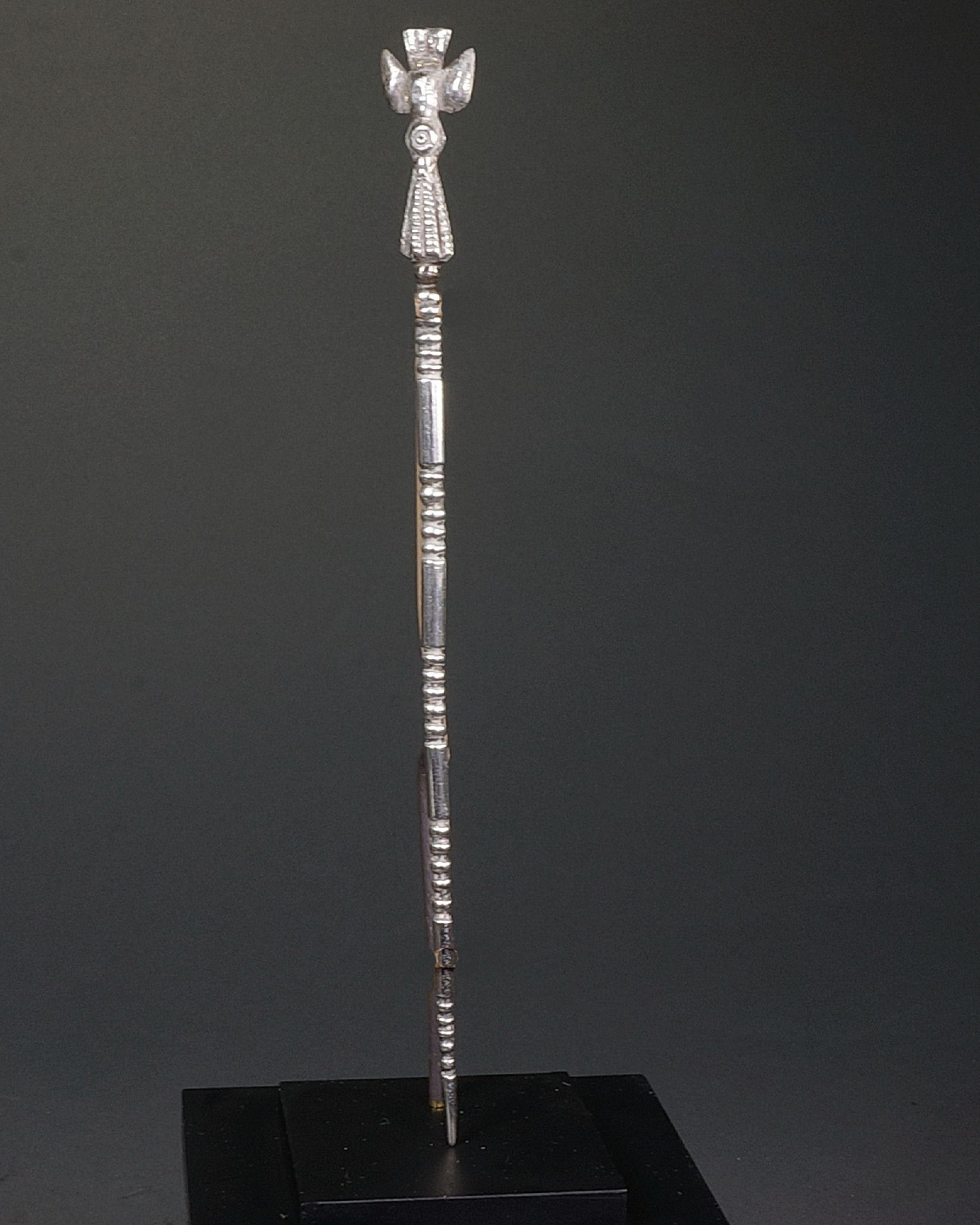


Peru, Silver Tupu with Bird Eating Corn Cob
This tupu depicts a bird diving into the corn cob. The shaft is decorated with spindle designs. Lost wax cast. Silver works do not survive as well as gold or bronze; this tupu is in a very good state of preservation.
Period: Peru, Chimu, North Coast, c. AD 900 - 1350
Media: Metal
Dimensions: Length: 5 1/4" x Weight: 8.5 grams
$1,750
MM611
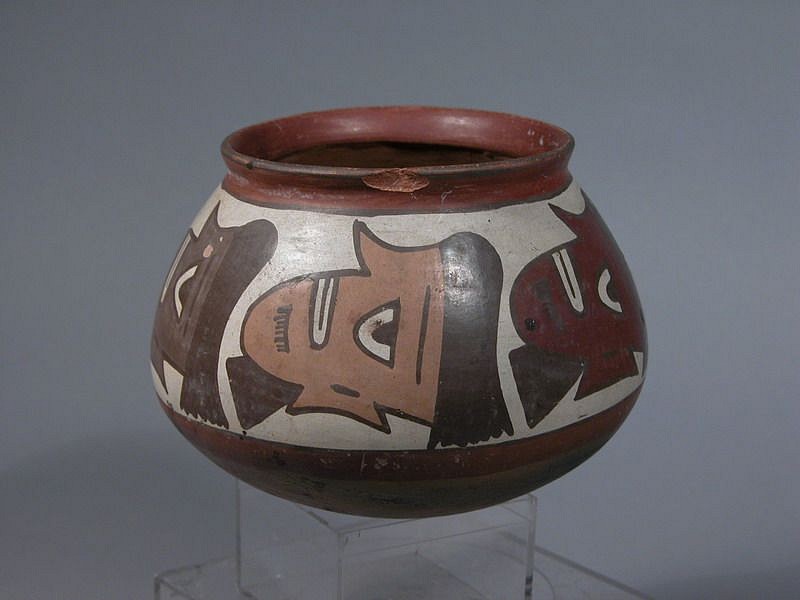




Peru, Small Nasca Bowl with Painted Trophy Heads
The trophy heads are in profile and alternating in red, grey and beige on a cream ground. Trophy head paintings by the same artist are in the Volkunde Museum in Berlin and are illustrated in ALTPERUANINISCHE KULTUREN –NAZCA II, in figures 120 & 121. Ex. collection Hans Monheim, Achen Germany.
Period: Peru, Nasca, South Coast, c. AD 400 - 800
Media: Ceramic
Dimensions: Height 3 3/4" x Diameter 3 3/8cm
Price Upon Request
M4035
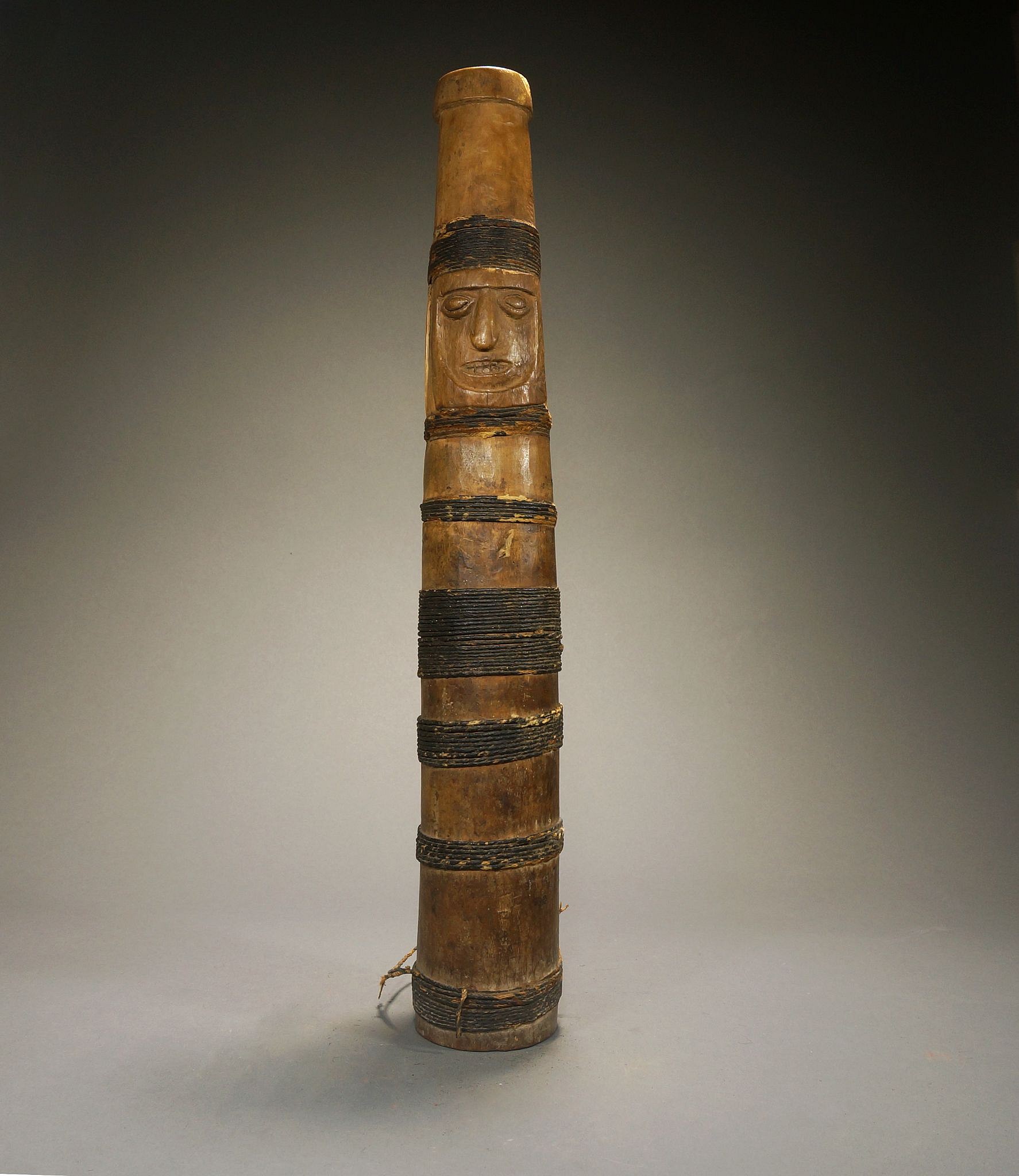



Peru, South Coast Wari Carved Wooden Trumpet with Face
This Wari trumpet has been wrapped in bands with a tar covered cotton rope. It has the typical trumpet pitch. This is a rare object to find so intact.
Period: Peru, Nazca, Late phase, South Coast, circa AD600-800
Media: Wood
Dimensions: Length: 16.5 Inches
$7,500
n3018
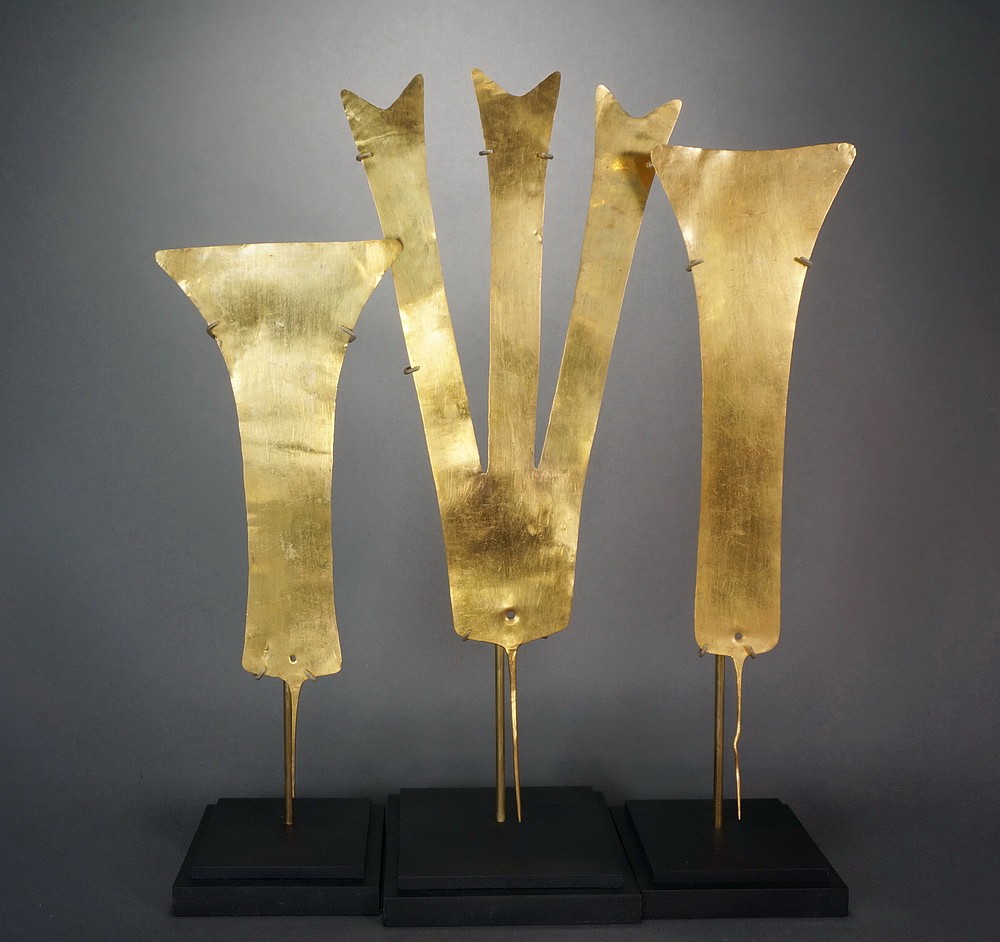




Peru, Three Chavin Gold Plumes for Headdress
Three hammered gold plumes were used as headdress or turban ornaments with tapering shafts. They were each fabricated from an individual nugget by repeatedly hammering and annealing. They are illustrated in TRUJILLO Precolumbino, Odebrecht-Lavalle, Editores 1990, pg 293. Other similar examples are illustrated in Oro del Antiguo Peru, pl. 51. These plumes are considered very large for early Peruvian goldwork.
Period: Peru, Chavin, Tembladera, Late Phase, North Coast, c. 900 - 200 BC
Media: Metal
Dimensions: Height: 9", 11", 12" Weight for the three 90 grams
XRF: Au.81, Ag. 9.5%, Cu. 10.1% average for the 3
Price Upon Request
94192




Peru, Three Moche Bi -Metallic Nose Ornaments
These ornaments are excellent examples of the Moche metalsmiths’ ability to use depletion gilding to vary the surface area with both gold and silver decoration. The Moche believed that metal possessed sacred power, and according to their cosmological myths, the process of bringing the silver and gold colors to the surface revealed the metal’s spiritual qualities. A similar nose ornament is illustrated in ANTIGUO ORO DEL PERU, pg. 15. Private collector, Florida, prior to 1980.
Period: Peru, Moche, North Coast, c. AD 100 - 600
Media: Metal
Dimensions: Width 4 3/4" Weight 24 grams.Width 3 5/8" Weight 13.8 grams.Width 3 7/16" Weight 14.8 grams.
$12,500
M5027
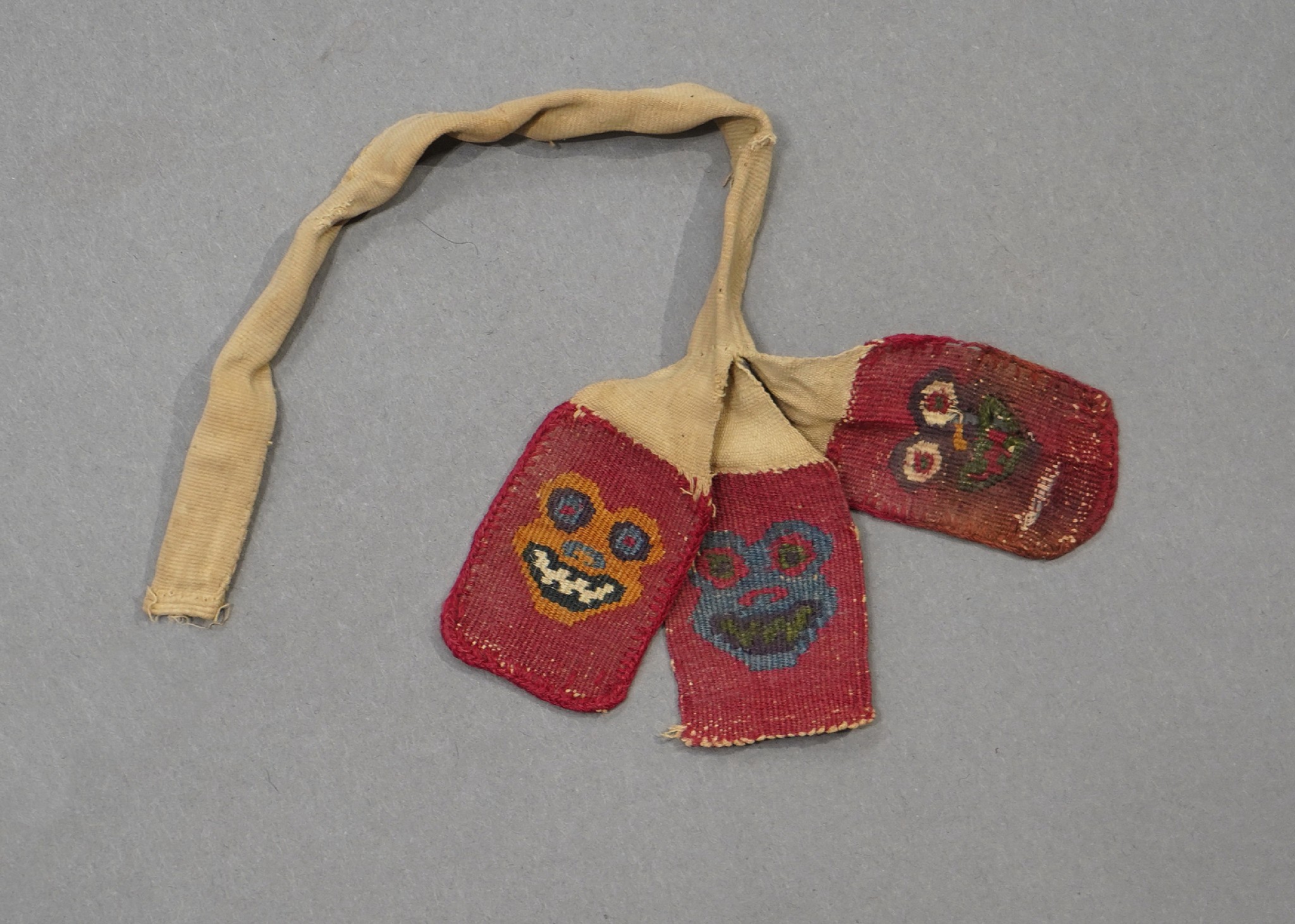
Peru, Three Wari Woven Tabs with Animal Heads
These woven tabs with stylized grinning toad faces were once part of a sash. The tabs are woven in orange, green, blue, white and black on a red ground. A similar set of tabs is illustrated in Animal Myth and Magic,by Vanessa Moraga, p. 110.
Period: Peru, Wari, South Coast, c. AD 600 - 900
Media: Textile
Price Upon Request
91095a
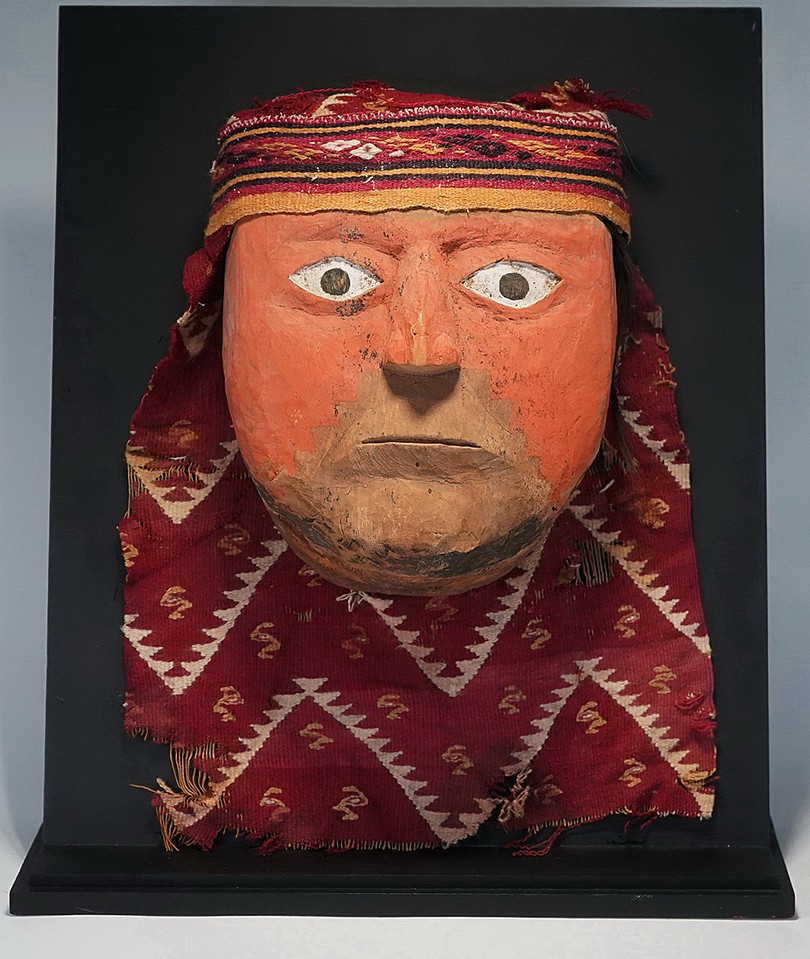



Peru, Three-Dimensional Huacho Carved Wood Mask with Headband
This wood mask with headband has an applied cinnabar decoration with an unusual step design around the mouth. This is an exceptional mask for Peru in that it is well carved in the round with a high degree of realism. Most of the wood masks from Peru are carved from flat slabs of wood with a small nose which is sometimes made separately and attached.
Period: Peru, Huacho valley, late intermediate period, circa AD700-1100
Media: Wood
Dimensions: H. 7 x W. 6 in. mask only
$22,500
91005
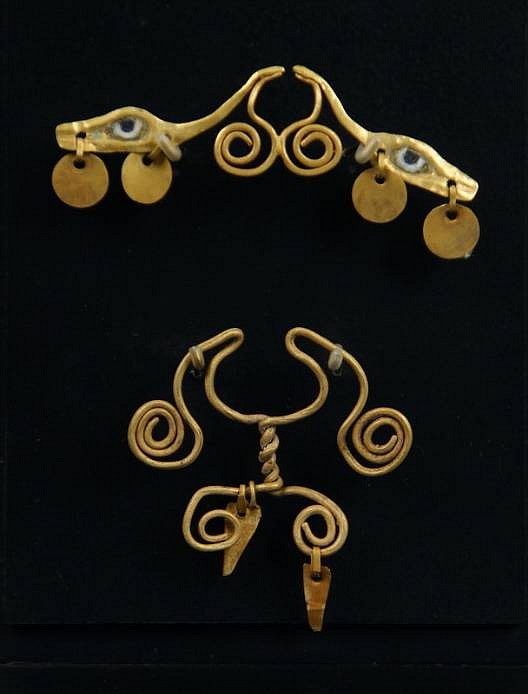



Peru, Two Chavin gold nose ornaments with openwork coils and dangles
One is fashioned from one continuous wire curled into double spirals and twisting into another set of doublle spirals flanking a central suspension plaque and two triangular dangles. The other has double spirals in the center framed by serpents heads, end to end, each with two suspended circular dangles. A similar one is illustrated in Oro Del Antiguo Peru, plate 42.
Period: Peru, Chavin, Tembladera, Late Phase, North Coast, circa 600 - 400 BC
Media: Metal
Dimensions: Height 1 3/4 inches; Width 2 1/2 inches
Price Upon Request
94154
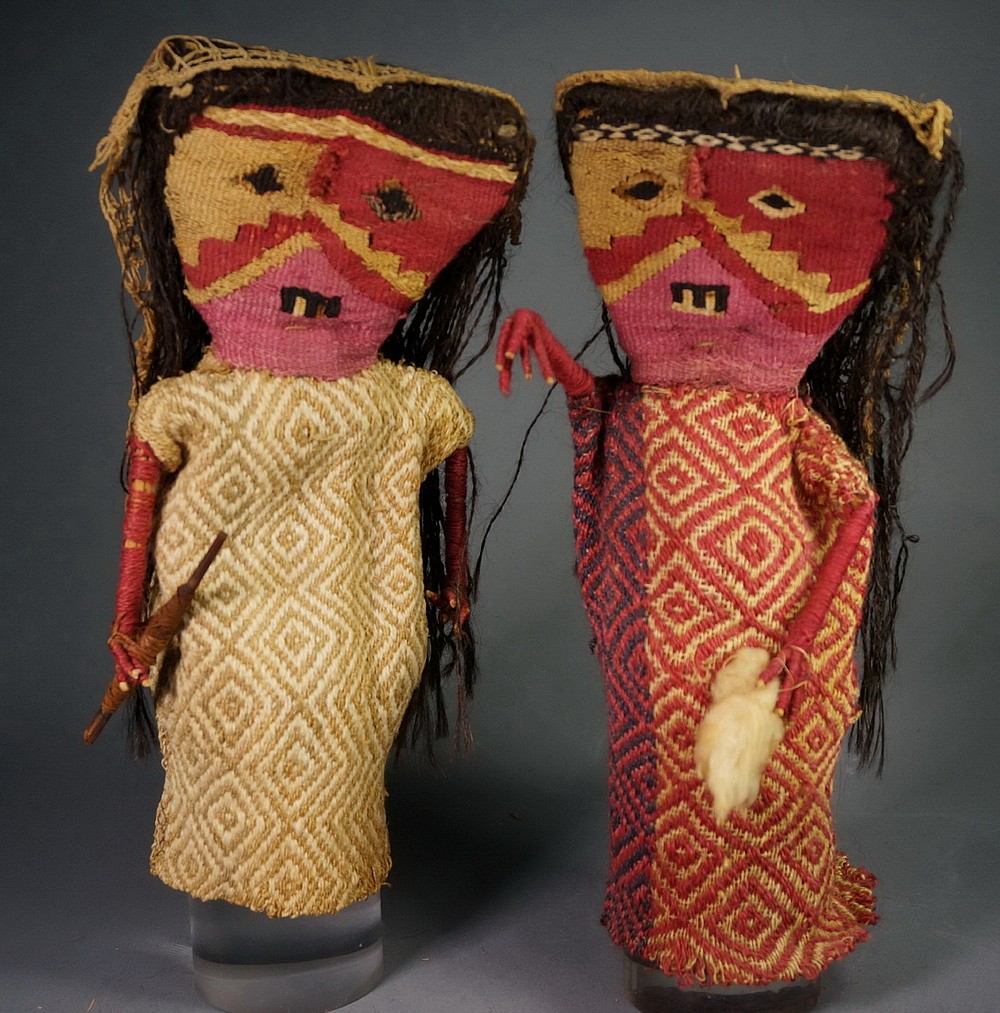





Peru, Two Female Chancay Dolls
The female tapestry faces are divided into three sections while those of the males are woven in two sections. One holds a wad of unspun cotton while the other holds a spindle with brown cotton strapped around it. Each has a witch’s veil covering the back of the head. Ex collection Justin and Barbara Kerr, prior to 1970.
Period: Peru, Chancay, Central Coast, c. AD 900 - 1500
Media: Textile
Dimensions: Height: 10 1/4" x Width of Face: 4 1/4"
$8,500
n7013
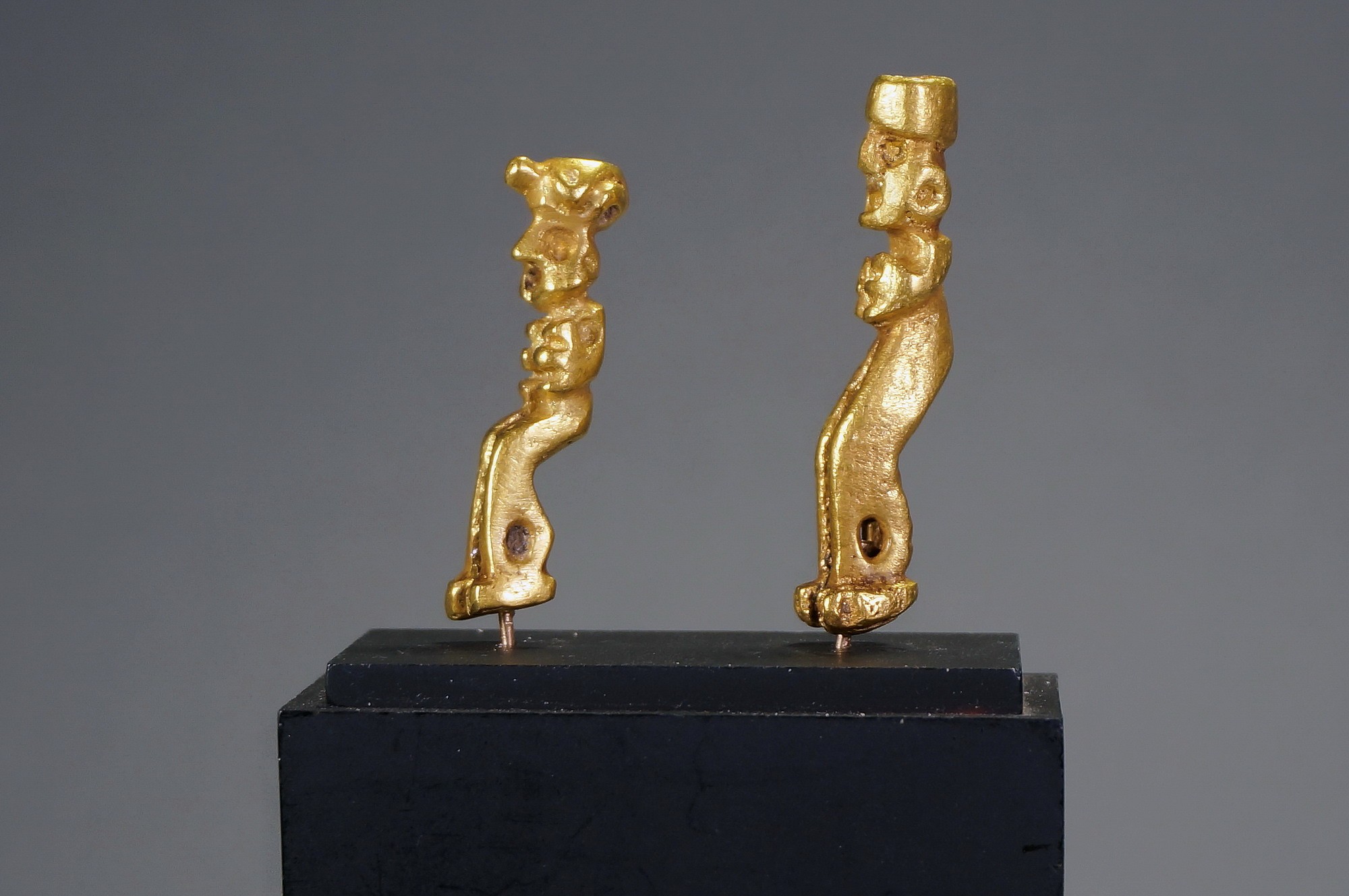




Peru, Two Inca Miniature Cast Gold Standing Figures
These two solid cast gold figures are highly unusual subjects. Each figure has exaggerated hands and elongated legs. Both figures have cast suspension holes above the ankles. The top of each figure has a hollow shape that could have been used to insert feathers. The only other example illustrated is in Oro del Antiguo Peru, lamina 210 (7 cm or 2.75"). One figure is wearing a headdress with a feline motif and the other one with a simple cylindrical shape. Ex. New York collector, prior to 1970.
Period: Peru, Inca, c. AD 1400 - 1532
Media: Metal
Dimensions: Height:1.5" and 1.75"; Weight: 24 grams for pair.
Price Upon Request
n7028

Peru, Two Miniature Nose Ornaments Demonstrating Early Goldwork Techniques
This beautiful set of miniature gold nose ornaments features two early Pre-Columbian goldwork techniques. The top ornament is from the Chavin culture and was formed using a combination of heating and annealing the gold. The bottom ornament is from the pre-Moche Salinar culture and features both granulation and filigree techniques.
Period: Peru, c. 100 BC - AD 300
Media: Metal
Dimensions: Chavin: Width:1 1/2" Weight: 4.2 grams.Salinar: Width: 1 1/4" Weight: 4.6 grams.
$1,850
90400
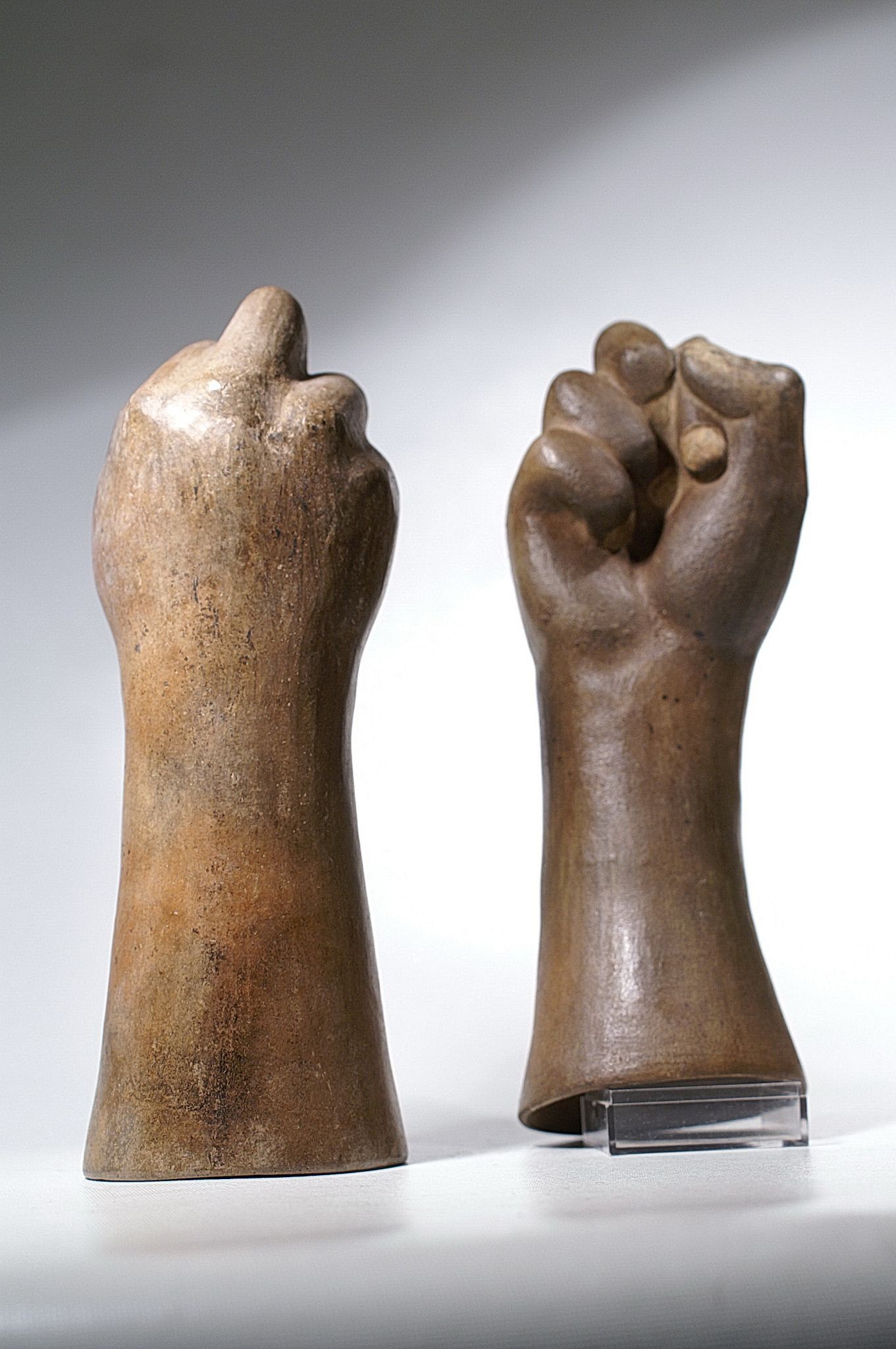





Peru, Two Moche Ceramic Hands with Clenched Fists
Although hands such as these are well documented for the Moche, it is rare to find two together from the same artist / workshop. The clenched fist, with raised middle knuckle, represents mountains and highland lagoons where sacrifices and divinatory rituals took place (Donnan, Moche Art of Peru 1978: 152-153 and fig. 235). Christopher Donnan further discusses the symbolism of such hands in "Andean Art at Dumbarton Oaks (1966: I: 136-139), where a bone carved as a clenched fist was studded with inlays of precious turquoise.
Period: Peru, Moche III, North Coast, c. AD 200 - 500
Media: Ceramic
Dimensions: Height 10"( 25cm) and Height 9 3/4"(24 cm)
Price Upon Request
M6064
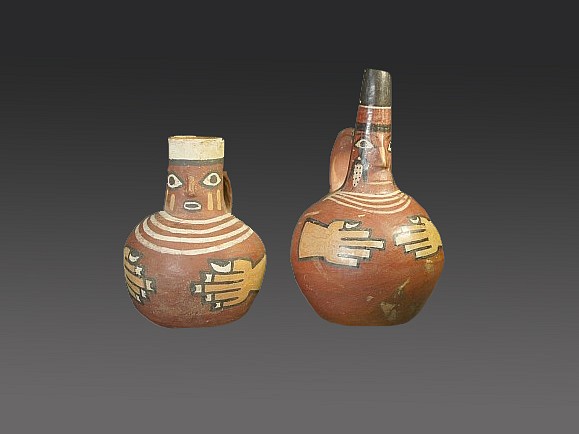

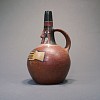
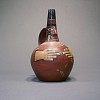
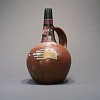
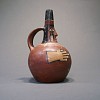
Peru, Two Wari Strap Handle Effigy Vessels with Faces on Spouts
Two lovely miniature single spout vessels depicting corn gods. Both are wearing 5 strand necklaces nicely tied at the back. These are stunning examples done in miniature with gestures of exaggerated hands holding the stomach as is after a feast. There is a group of Wari vessels which have necklaces and large hands, which could mean that they came from the same tomb. A similar example is illustrated in WARI LORDS OF THE ANCIENT ANDES. Pg 83. T-L tested in Berlin.
Period: Peru, Wari South Coast, circa AD650-900
Media: Ceramic
Dimensions: Height 6 3/4"
Price Upon Request
94120A
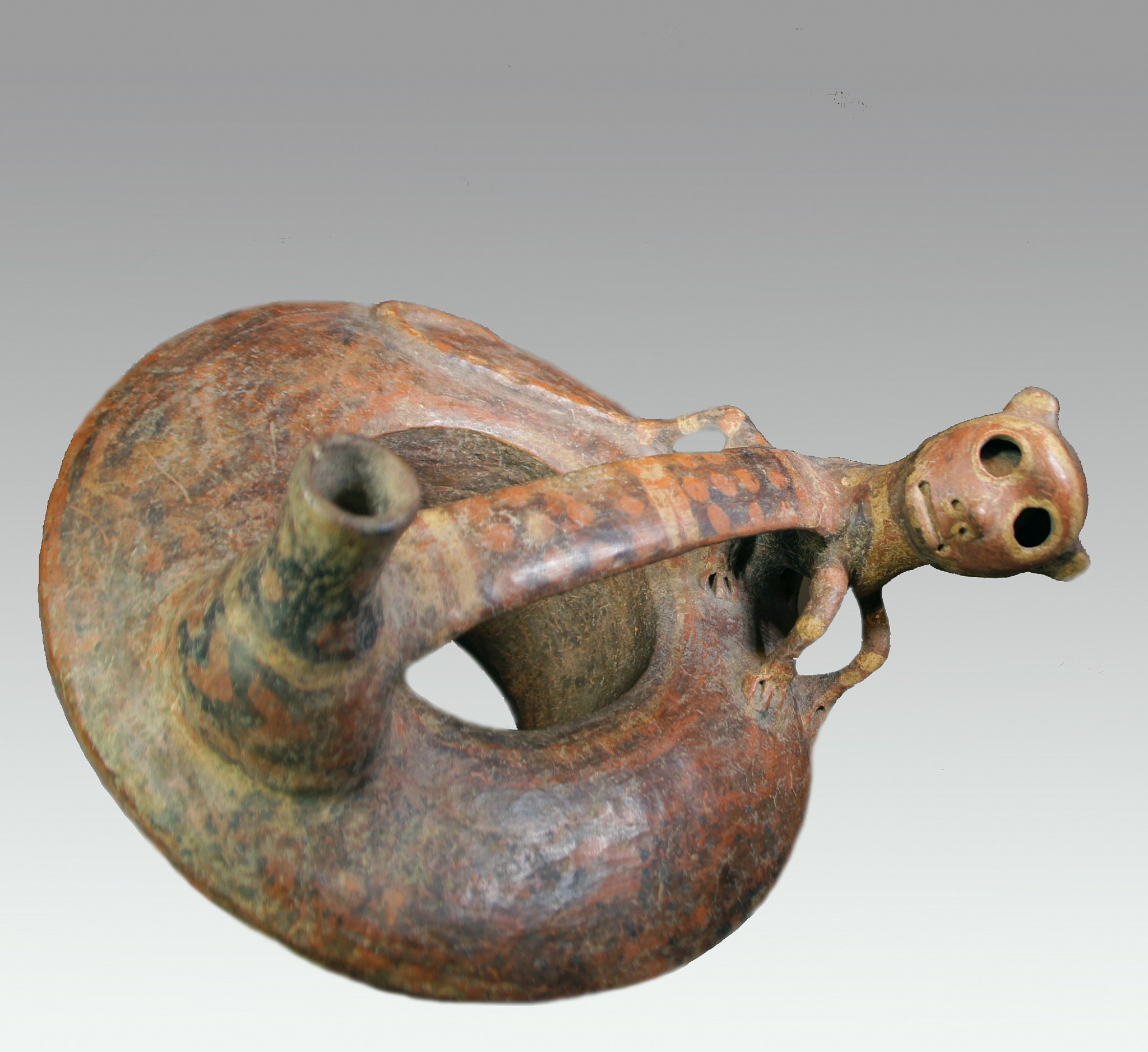





Peru, Vicús Donut-shaped Whistle Vessel with Monkey
This donut-shaped whistle vessel has a monkey figure one side of its bridge spout and the mouthpiece at the other end. The monkey sits on top of the vessel, with its head slightly tilted, hunched on its hind legs and placing his front legs forward and spread apart. The design motif consists of negative resist decoration. There is a whistle inside the monkey (not working) and would operate when the fluid inside the vessel moved the air out through it. A similar example can be found in Lapiner's "Pre Colombian Art of South America" pls.456 & 459. The piece has a crack on the bottom, which has been restored.
Period: Peru, Vicus, Far North Coast, c. AD 200 - 400
Media: Ceramic
Dimensions: Diameter 8 1/2 x h.7 in.
$3,300
92233
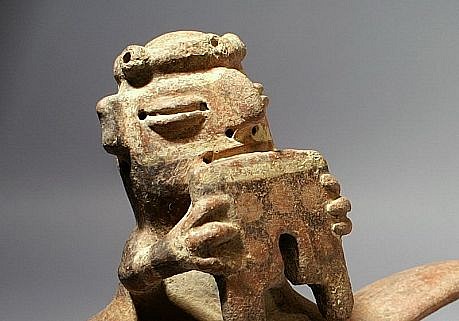




Peru, Vicus Double Chambered Whistling Vessel of a Figure Playing a Panpipe
This is the most published image of a whistling vessel from the early Vicus culture, but in actuality very few exist.
Period: Peru, Vicus, North Coast, circa 300 BC - AD 300
Media: Ceramic
Dimensions: Length: 11 1/2 in. x Height: 7 in.
$4,500
M2096

Peru, Vicus Embossed Gold Nose Ring
The section of Vicus, known as Loma Negra, yielded a horde of finely metal objects, mostly face and body embossed ornaments mostly made in gold, silver or copper. They are Moche in style, probably related to the early Moche ceramics at Loma Negra. This nose ring is embossed with imagery anthropomorphized feline. Above their heads, beneath their feet, and between them are bosses with a central raised dot. It is possible that the two central puncture marks were added at later date. A similar nose ring is illustrated in The Art of Pre-Columbian Gold: The Jan Mitchell Collection, page 209. Ex. Jan Mitchell collection, prior to the 1980s, by descent to his sons.
Period: Peru, Vicus, Far North Coast, c. 100 BC - AD 100
Media: Metal
Dimensions: Height: 3 in x Width: 4.5 in. Weight: 12 grams.
$3,000
p1251
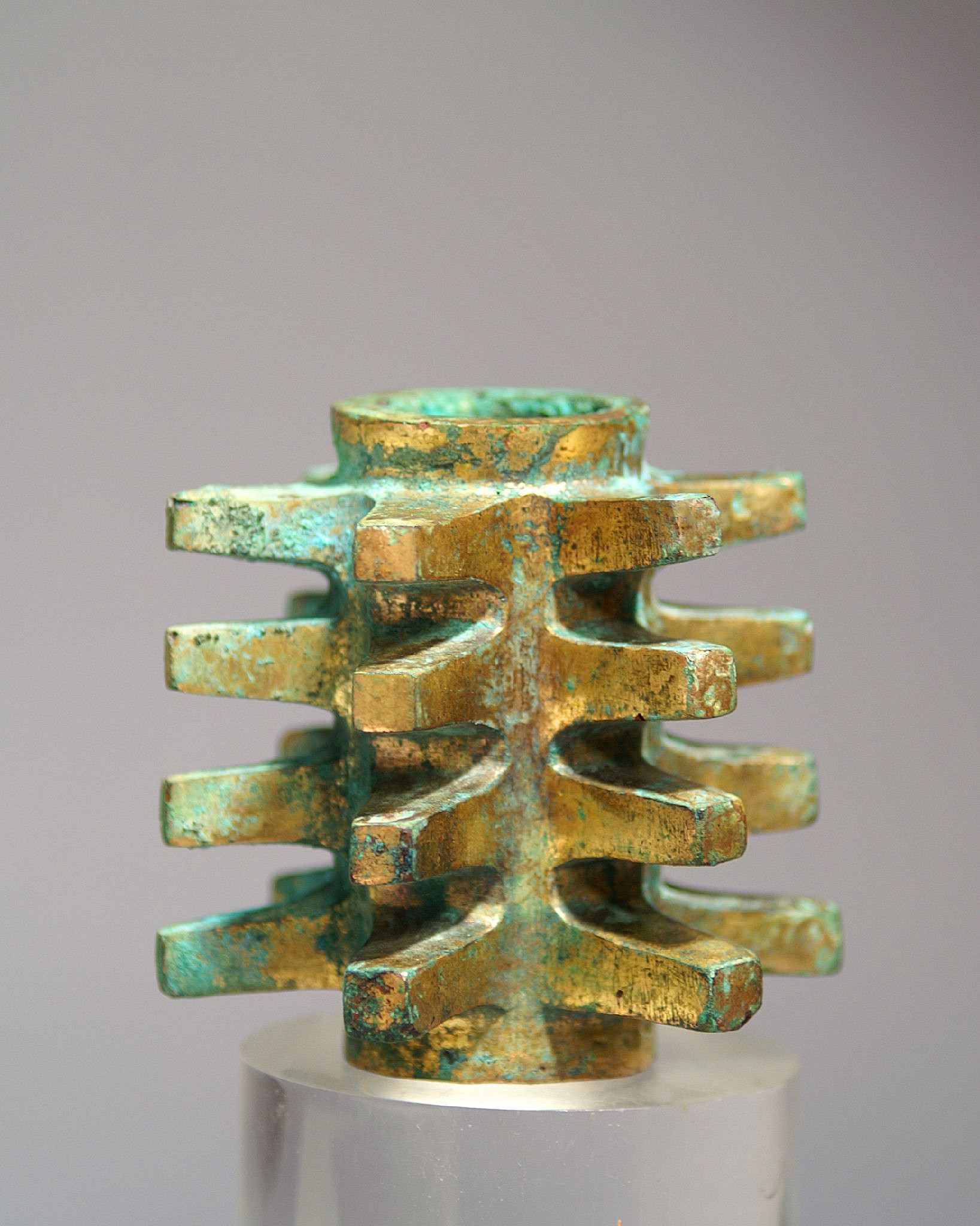


Peru, Vicús Gilt Copper Mace Head with four Levels of Six Pointed Stars
The mace has a richly gilded surface with traces of malchite corrosion inside and out. A similar mace with only three layers of stars and less intact gilt is illustrated in Mufareche (1999: #132). Mace heads were attached to wooden shafts and used as weapons. This is a particularly fine example from the early Vicús culture.
Period: Peru, Vicus, Far North Coast, c. 300 BC - AD 300
Media: Metal
Dimensions: Diameter 3" x length 3 5/8"
Price Upon Request
M3053
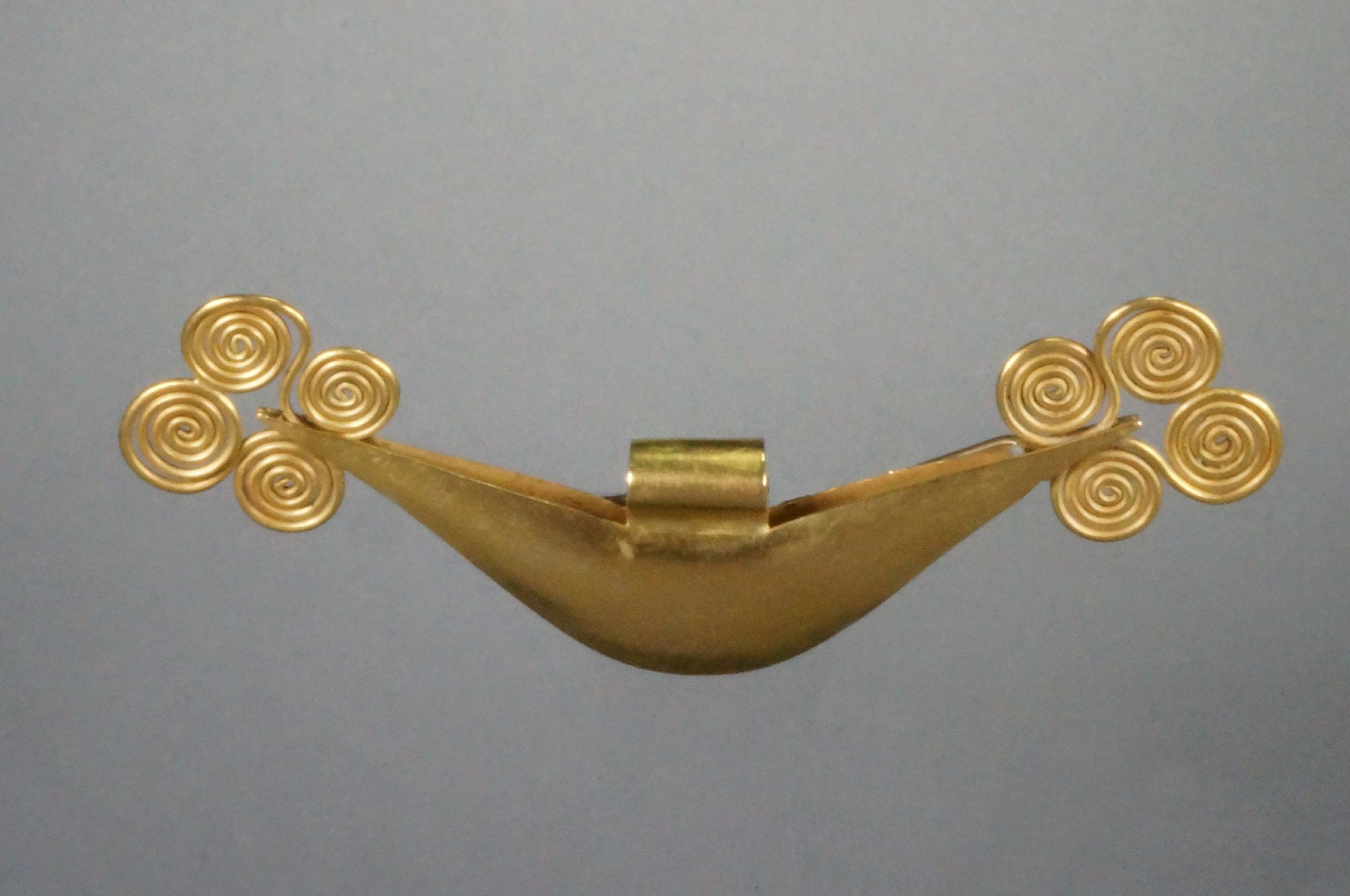


Peru, Vicús Gold Crescent Tweezers with Four Spirals on Each End
An elegant gold nose ornament with four wire spirals expertly soldered on each end. Made of two oblong sheets of gold with soldered filigree spirals reveals a high degree of craftsmanship. Tweezers were status implements fabricated in copper, silver and gold, with gold reserved for the highest level of status. Tweezers are often confused with nose ornaments, however they are spring loaded by annealing the metal, and were used to pluck the thick facial hairs of the Andean people. Shaving was not done in the New World, but was widely practiced in Europe and the Middle East.
Period: Peru, Vicus, Far North Coast, c. 300 BC - AD 300
Media: Metal
Dimensions: Width 6" Weight: 36.5 grams
XRF: Au. 83.8%, Ag. 20.0%, Cu.5.1%
Price Upon Request
96050
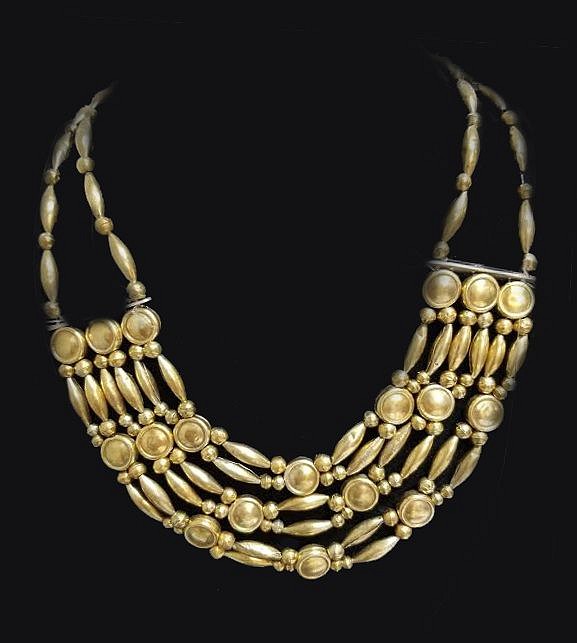



Peru, Vicus Gold Necklace of Soldered Discs and Rolled Oblong Beads
The necklace has been restrung to resemble the original ancient necklace. The beads were strung so that the necklace hangs flat. The roundels each have two sets of holes on either edge. The oblong beads are made from hemispheres and rolled, creating an elongated oblong shape. A necklace with similar shaped beads was found at the early Vicus site of Ayabeca in the far north of Peru.
Period: Peru, Vicus, Ayabeca, North Coast, c. 100 BC - AD 300
Media: Metal
Dimensions: Length: 23" without clasp. Height: 12" atcenter. Weight: 88 grams.
$17,000
88121
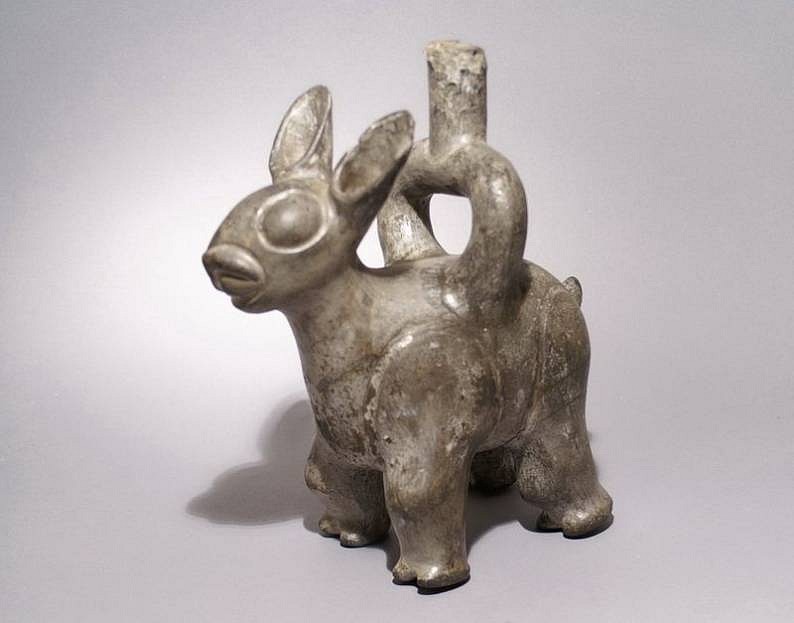




Peru, Viru ceramic greyware single spout vessel in the form of a Viscaya
A ceramic single spout vessel in the form of a standing Viscay, a large member of the rabbit family, noted by its long ears.
Period: Viru, North Coast Peru, c. 200 B.C. - 200 A.D.
Media: Ceramic
Dimensions: H. 9 1/2
$7,500
92047
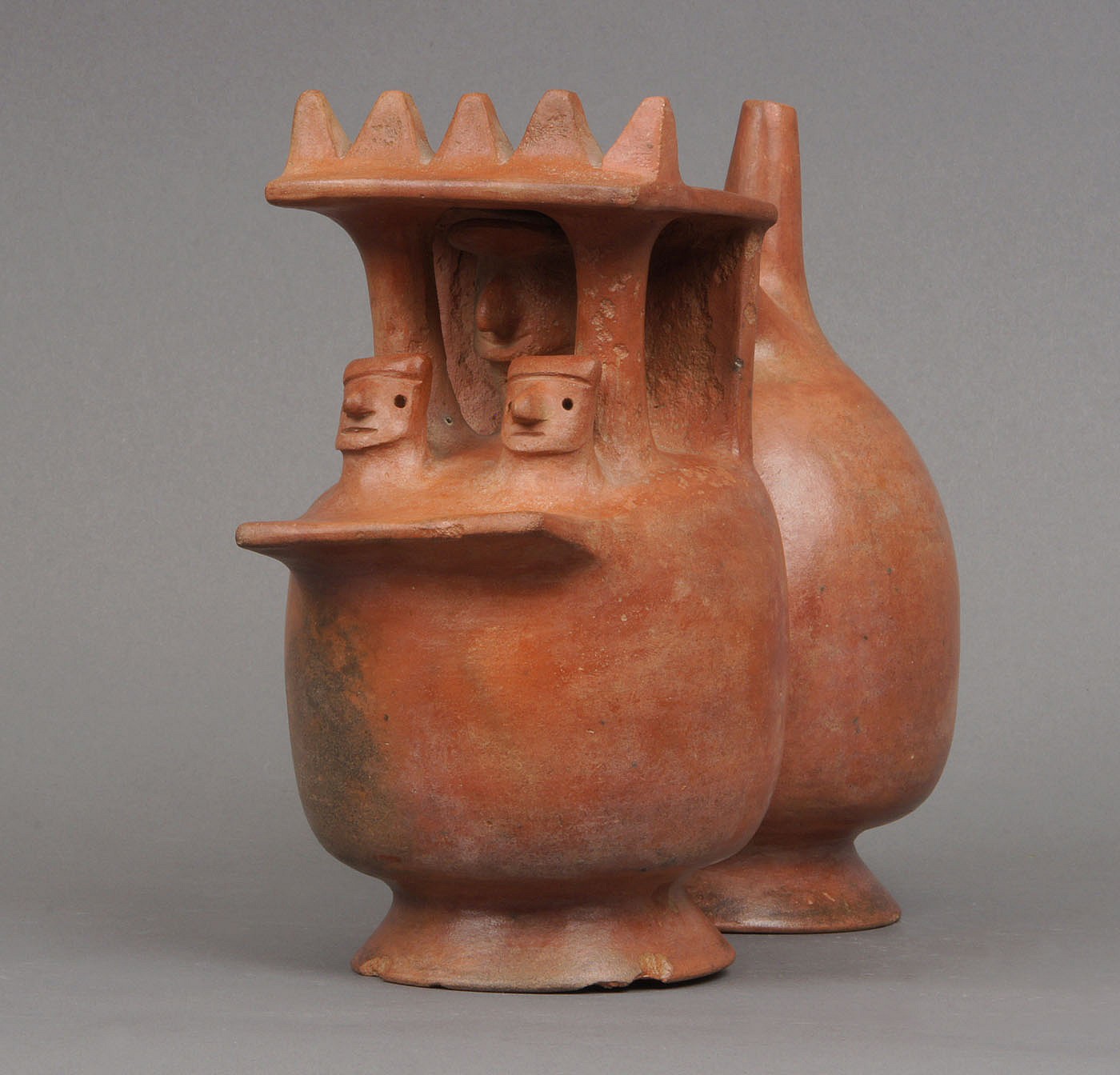



Peru, Virú Double Chambered Single Spout Whistling Vessel in the Form of a Temple
A strap handle orangeware vessel of a temple with lord and two attendants. The two heads could also be architectural elements or trophy heads. There are traces of negative resist decoration. Larco Hoyle describes and llustrates similar shaped vessels in his monograph "Cronologia del Norte de Peru, La Cultura Virú" (1945: 4 and 8).
Period: Peru, Virïº, North Coast,circa 300BC-AD200
Media: Ceramic
Dimensions: Height 8" Length 7 1/2"
$4,500
92080
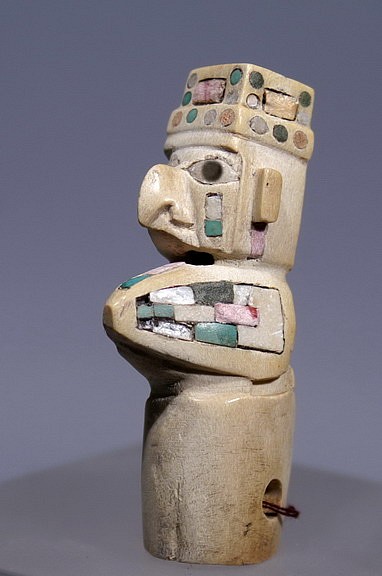




Peru, Wari Atl Atl Grip with Owl Deity With Head Turned Backward
This fancy carved bone grip has a "Sphinx like" appearance, with the torso and face of an owl, but its head is turned backwards. The inlays are original and made of shell, turqkuoise and snail shell. The hat is a classic Wari four-cornered hat, only worn only by the Wari culture.
Period: Peru, Wari, Central Coast, circa AD650-1100
Media: Shell
Dimensions: Height: 2 3/4" inches
Price Upon Request
M7153
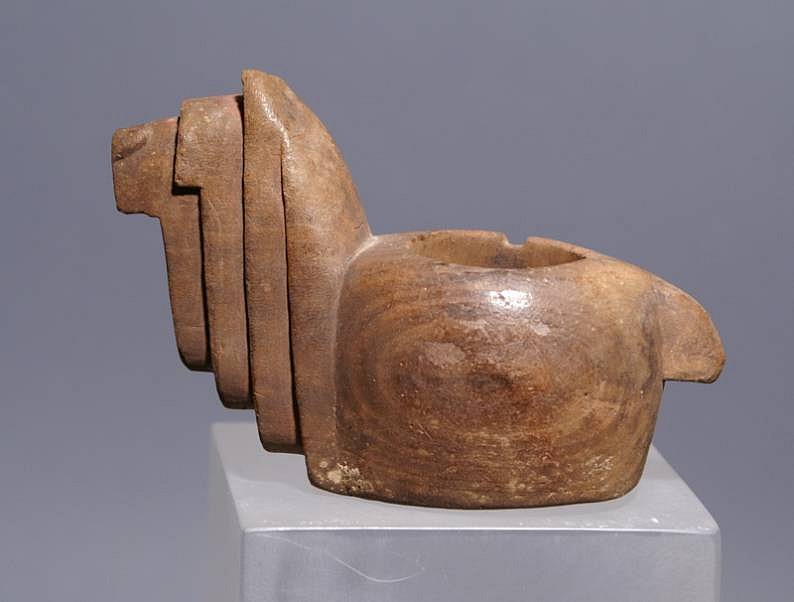





Peru, Wari Carved Wood Konopa in the form of an alpaca
Konopas were sacred offering containers carved in the shapes of llamas and alpacas. This example is carved from balsa wood in the unmistakable form of an alpaca, distinguished by its long hair, especially flopping over the eyes. A round cavity was carved into the animal's back for the purpose of holding an offering. Once filled, probably with a mixture of llama or alpaca fat and blood, the carving was subsequently placed in pastures to secure the fertility of herds and the land, both so essential to the ancient Peruvians. Most known extant konopas are from the later Inca period and were generally carved from stone. A wide variety of Inca stone examples are illustrated in "Gold of the Andes: The Llamas, Alpacas, Vicunas and Guanacos of South America," 2 vols. (Barcelona, 1994, Vol. I: 20 and 21). The stone Inca examples of alpaca konopas are from Helmut Schindler "The Norbert Mayrock Art Collection from Ancient Peru" (2000: 320).
Period: Peru, Wari, South Highlands, circa AD650-1100
Media: Wood
Dimensions: Height 2 1/2"
Price Upon Request
94016
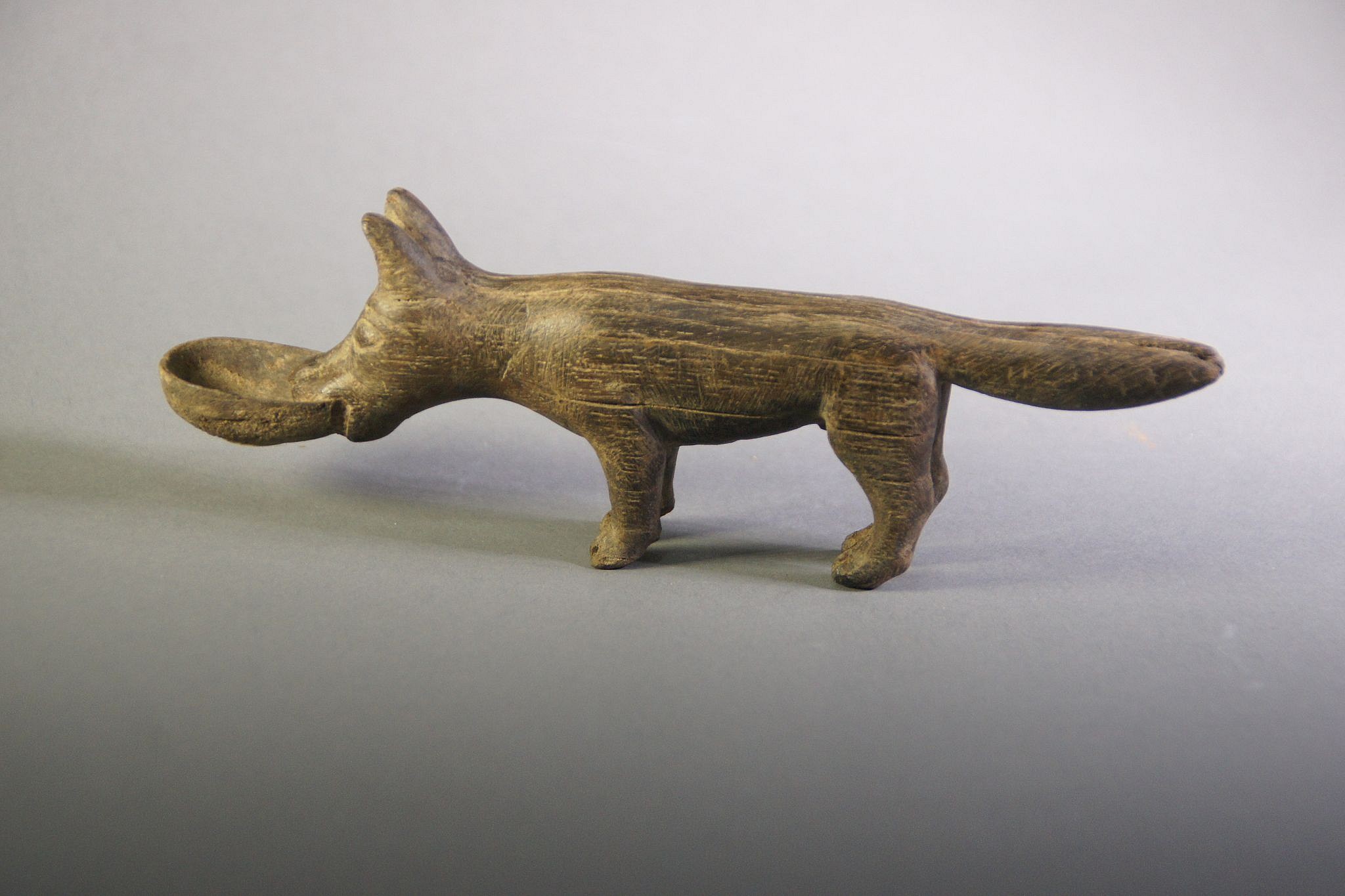



Peru, Wari Carved Wooden Dog with Bowl in Mouth
The dog has a fluffy tail and is holding a bowl in its mouth, asking for food.
Period: Peru, Wari South Coast, circa AD650-900
Media: Wood
Dimensions: Length: 7"
Price Upon Request
N3033
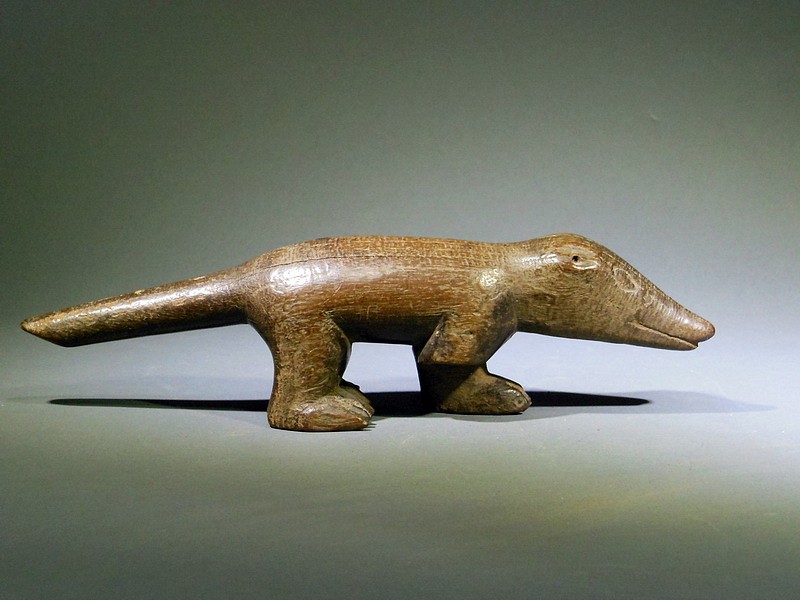


Peru, Wari Carved Wooden Oppossum with Leg Missing
This opossuml has large feet, a long tail and a long snout. He has ears which are are extremely short. His back feet have prehensile thumbs.
Period: Peru, Wari South Coast, circa AD650-900
Media: Wood
Dimensions: Length: 9 1/4"
Price Upon Request
n3032
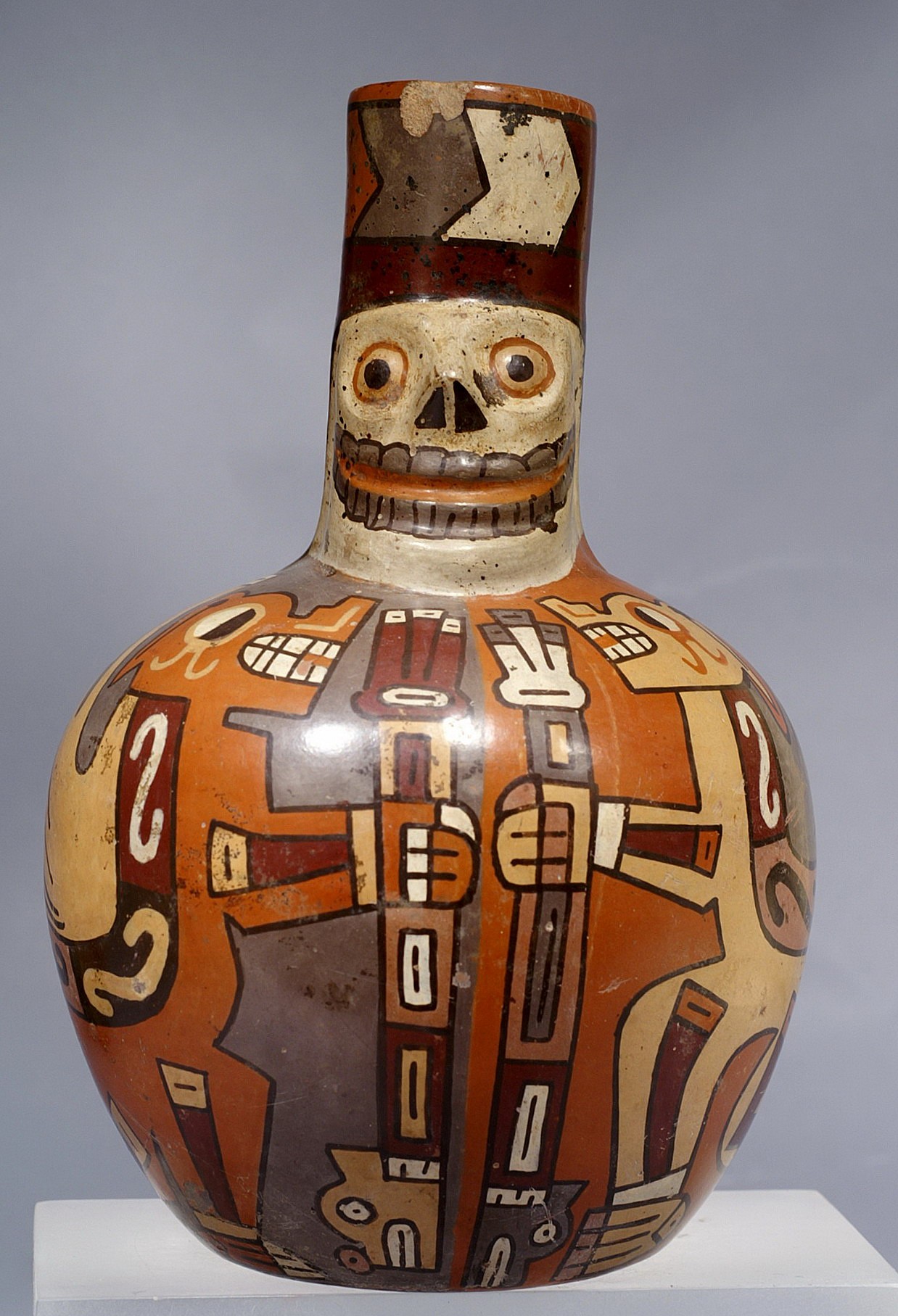




Peru, Wari Death-head Vessel with winged felines
This beaker with skeletal head in relief was painted with winged felines holding staffs. Both the skeletal relief and the mythical felines are characteristic of Wari pottery. A smaller similar vessel in the American Museum of Natural History in New York is published in Alan Lapiner, "Pre-Columbian Art from South America (1976: #542) and Margaret Young-Sanchez, "Tiwanaku: Ancestors of the Inca" (2004: fig. 6.6) Height 6 3/4" compared to the above of 8". The skeletal deity wears a class Wari tapestry tunic and a lovely hair-do on his black. The crouching winged pumas holding staffs are classic features of Wari Art & Iconography. This vessel was formerly in a German collection collected prior to 1970.
Period: Peru, Wari, South Coast, circa AD900-1100
Media: Ceramic
Dimensions: Height: 8"
Price Upon Request
M7046
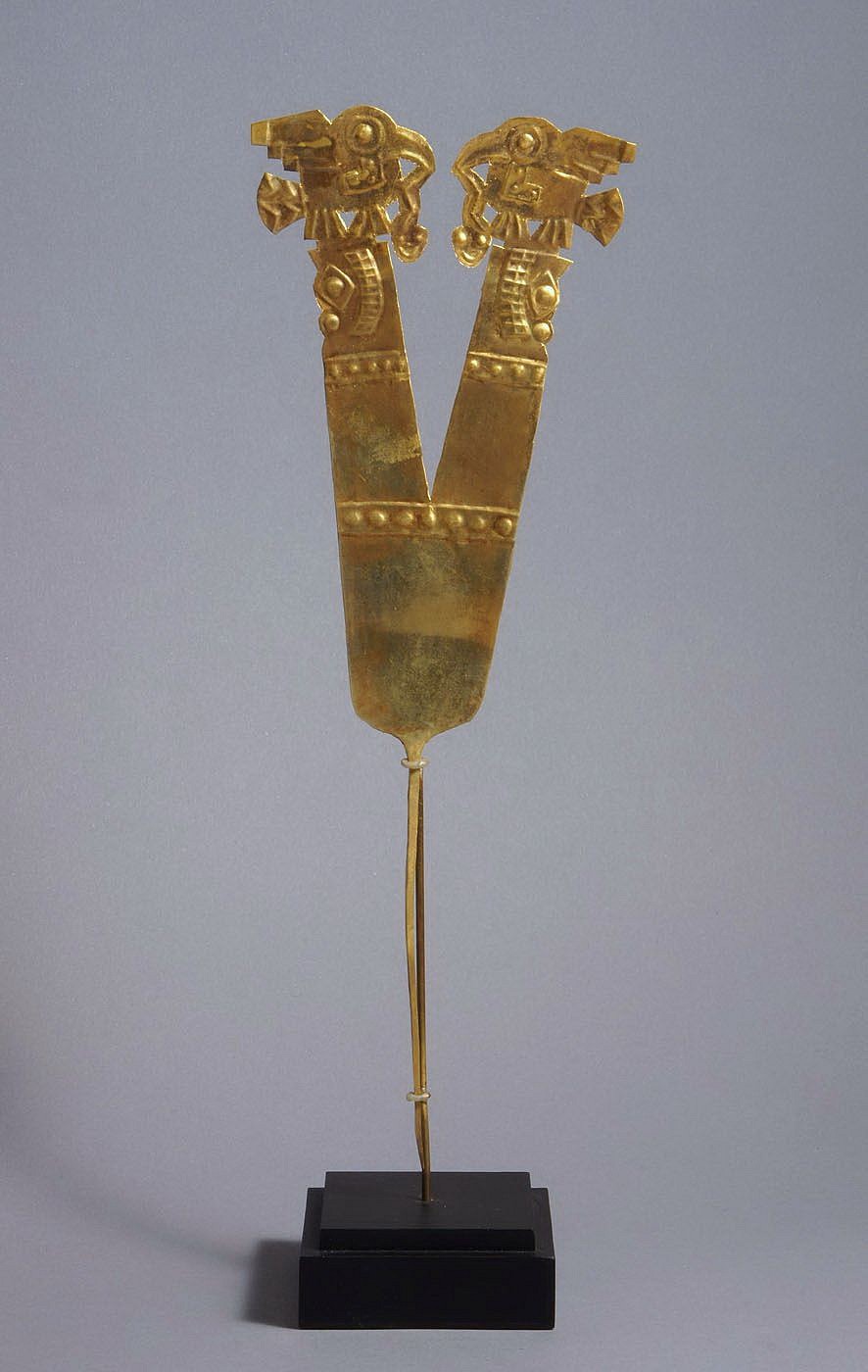


Peru, Wari Double-headed Gold Feather Plume with Embossed and Cutout Decoration
The feather plume is worked with embossed designs of two cutout birds standing on Puma heads and holding serpents in their beaks. The Puma Head can also be seen as a Condor head facing in the downward direction and seen in the classic Wari Tunics. The surfaces are beautifully burnished. A similar plume in the Berlin Museum measures 8 ¾†and is illustrated in WARI - Lords of the Andes, fig. 216. This plume is unusual in that it has two "branches" and is worked with both cutout and embossed designs while the others only have embossed work. Formerly in the collection of Robert Sonin.
Period: Peru, Wari, Central Coast, c. AD 650 - 1100
Media: Metal
Dimensions: Height 10 1/2"
$12,500
M7122b
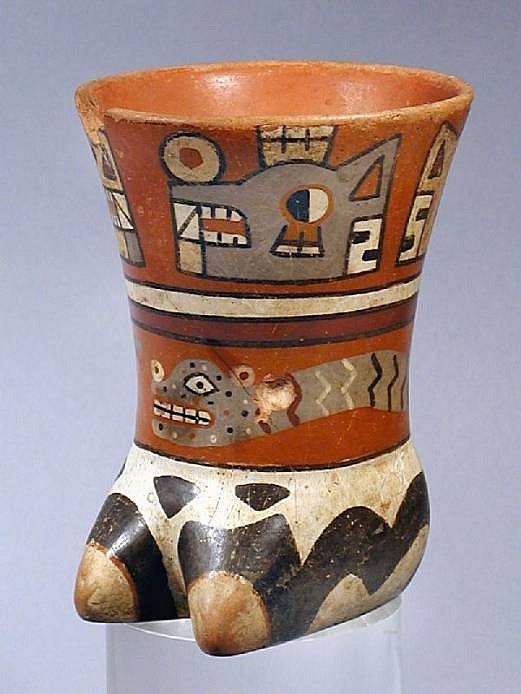



Peru, Wari Effigy Vessel of a llama hoof
The llama hoof is decorated in three bands, the upper with two sets of sun/moon heads facing each other. The middle band has an undulating serpent and the lower band is a black on white llama skin decoration.
Period: Peru, Wari, South Highlands/Coast, circa AD650-900
Media: Ceramic
Dimensions: Height 5"
Price Upon Request
M3079




Peru, Wari Embossed Gold Feather Plume Decoration Depicting a Pair of Vultures
This double-headed design features two cutout birds of prey holding serpents in their beaks. This style of gold plume would have been attached to the headdress of a high-status individual, signifying strength and power. A less elaborate gold plum by the same artist is illustrated in WARI: Lords of the Ancient Andes, page 227. Acquired from a New York collector prior to 1990.
Period: Peru, Wari, Central Coast, c. AD 650 - 1100
Media: Metal
Dimensions: Height 11 1/4" Weight: 26 grams.
Price Upon Request
m7122
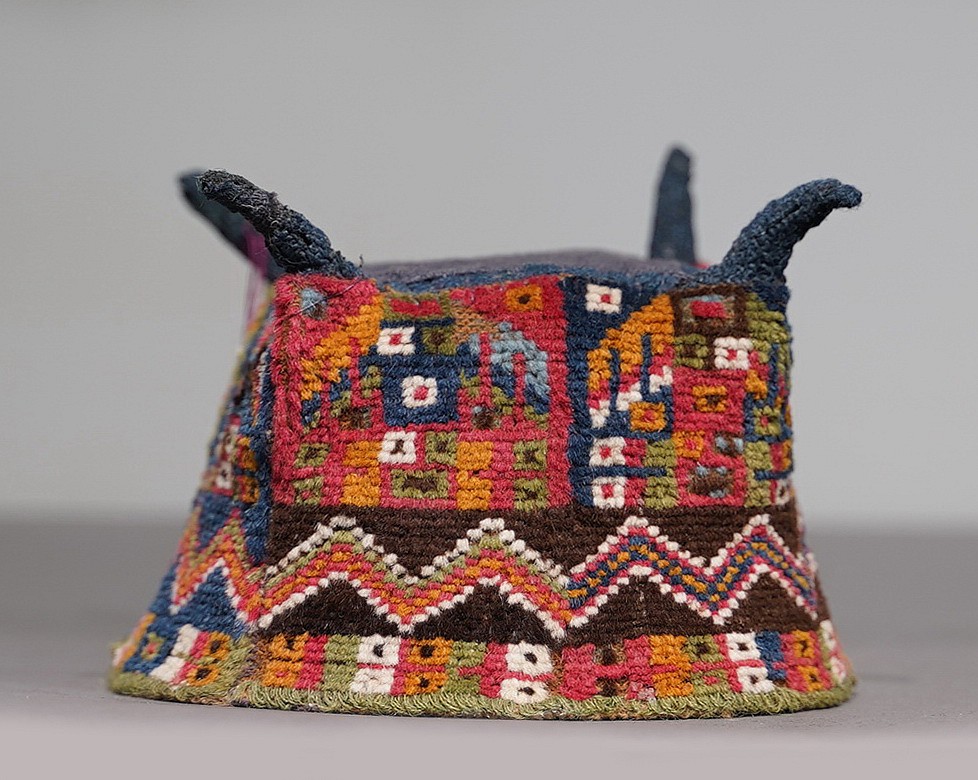





Peru, Wari Four-Corner Pile Hat Decorated in 3 Registers
The top register of this hat features 7 repeating panels in alternating colors, with background colors in red, green, and blue. The figure depicted in each panel is a totemic column consisting of (1) an abstract Rayed Deity’s face at bottom (2) a second deity face (in the middle) and (3) an elaborate headdress representing a bird with outstretched wings at the top. The faces and feather motif may derive from the Frontal Staff Deity, a major figure in Highland iconogpahy. The second register features an undulating band of white, red, blue, tan, and gold, on a dark brown ground. The lower register features a beautiful repeating band of geometric designs on a green ground, representing 8 repeating Reyed Deity faces. A four-cornered pile hat with similar elements is in the Metropolitan Museum of Art’s permanent collection. From the estate of Leslie Orgal, PhD - La Jolla, CA. prior to the 1980s.
Media: Textile
Dimensions: Height:. 4 1/2". x Length: 4" x Width:. 4"
$6,500
p4125

Peru, Wari Gold and Silver Bicephalous Arc (Serpent Deity) with Dangles
This ornament represents a plume of features, intended to be placed into a gold headband. When worn in ceremonies, the kinetic dangles would have moved and reflected a variety of colors of warm light, attracting the attention of onlookers.
Period: Peru, Wari South Coast, c. AD 650 - 1100
Media: Metal
Dimensions: Heigh: 8 1/2" x Width: 6" Weight:26 grams.
$7,800
p4162
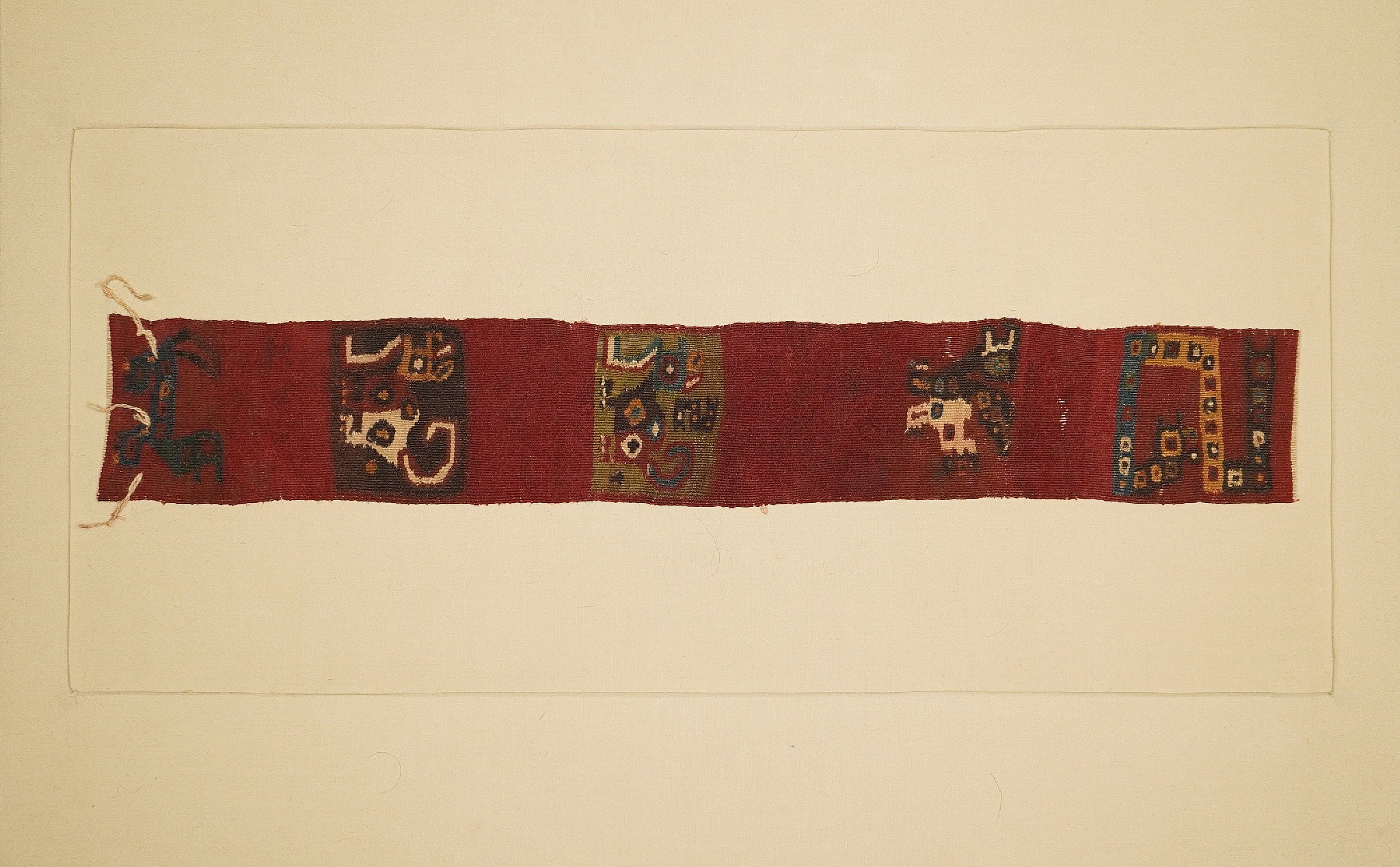




Peru, Wari Headband with 5 Animals Deities
This is a section of a headband with 5 different animal images, including a pair of intertwined serpents, a condor deity, and three chimeric feline deities. The animal deities are depicted with a variety of bright and neutral colors on a deep red ground, a classic Wari color arrangement. Excellent color. Ex. collection Ferdinand Anton, Germany, prior to 1980.
Period: Peru, Wari South Coast, c. AD 700 - 900
Media: Textile
Dimensions: Textile: W. 17" x W. 2 1/2"
Mat: W: 20" x H: 16"
$1,000
79045
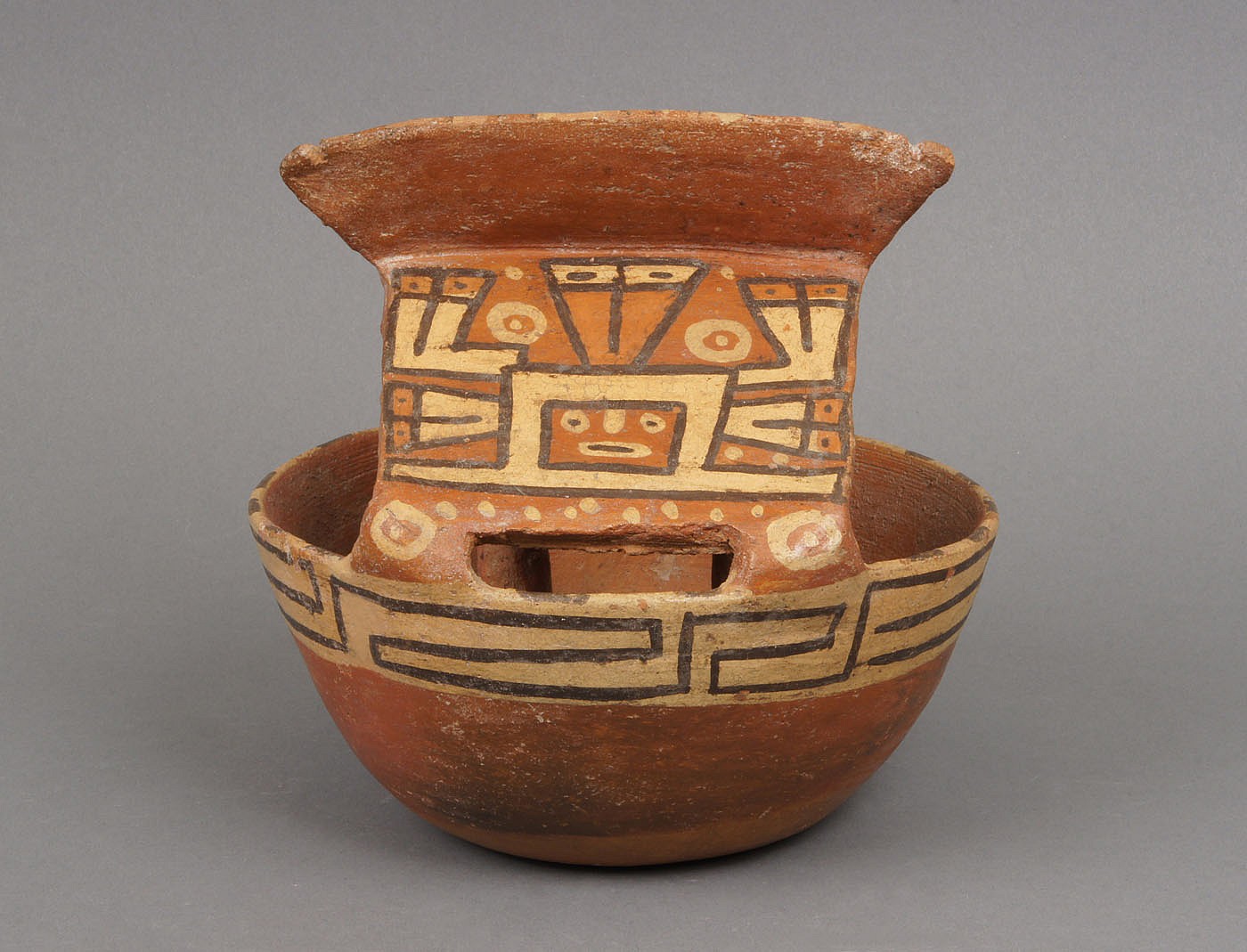





Peru, Wari House Vessel with Overhanging Roof on Two Pillars
An effigy bowl in the form of a temple with a decorated roof. The sloping roof supported by pillars was likely decorated with a fresco. There are some temples in Southern Peru which still have traces of fresco decoration dating from the early Wari period. The columns taper to the top and have a lentil support. Photographed by Justin Kerr for Alan Lapiner, New York, June 1968.
Period: South Coast Peru circa 700-950A.D.
Media: Ceramic
Dimensions: H. 7 in.
$5,400
91993
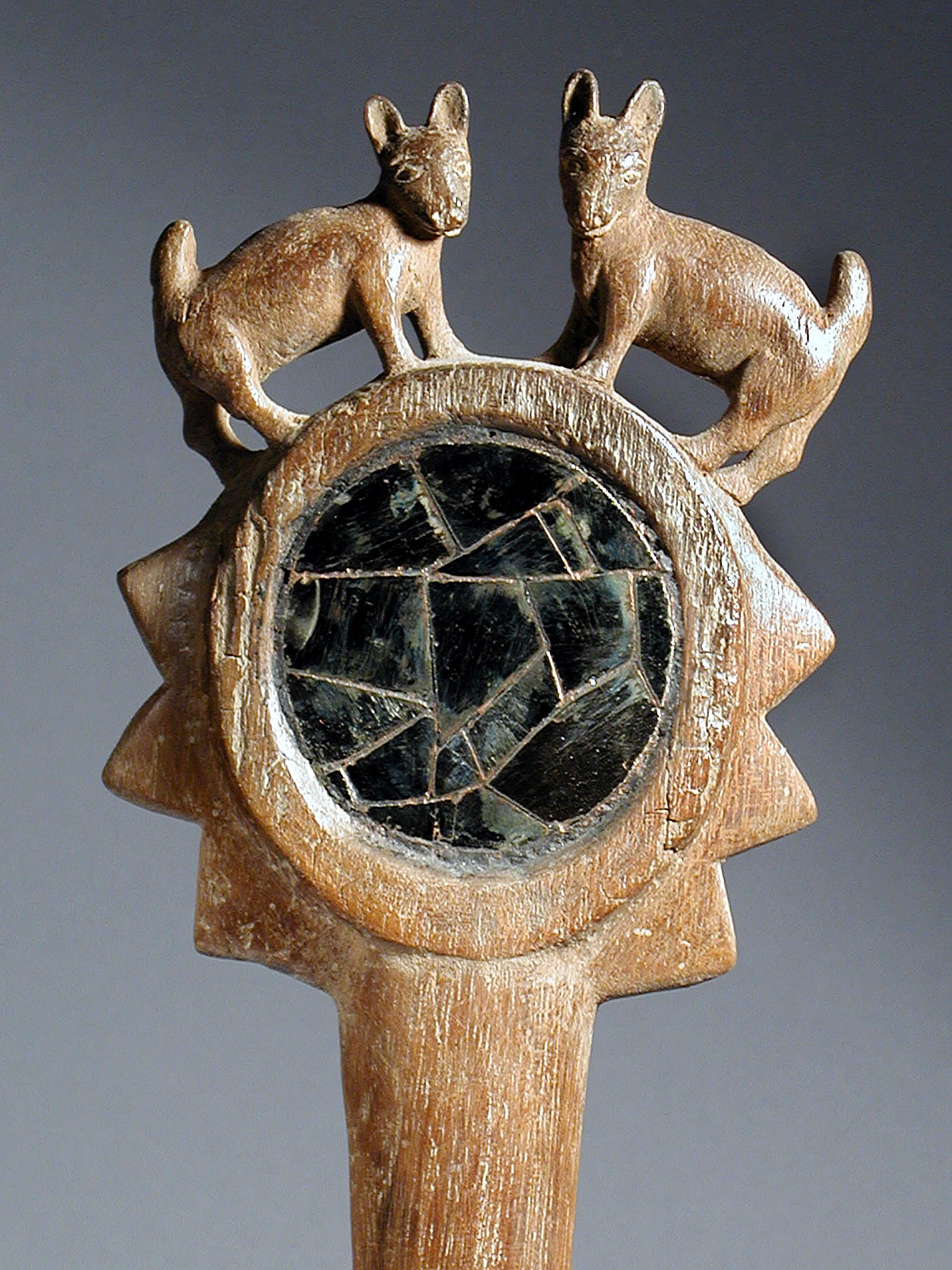


Peru, Wari Long Handle Wood Mirror Back with two deer carved on top
Elegantly carved wood handled mirror decorated with two felines perched on top facing outward. The mirror frame is carved with a mace-like knobs to give an overall impression of a scepter. The verso side is plain.
Period: Peru, Wari, Central Coast, circa AD650-1100
Media: Wood
Dimensions: Length 14 1/4"
Price Upon Request
94189
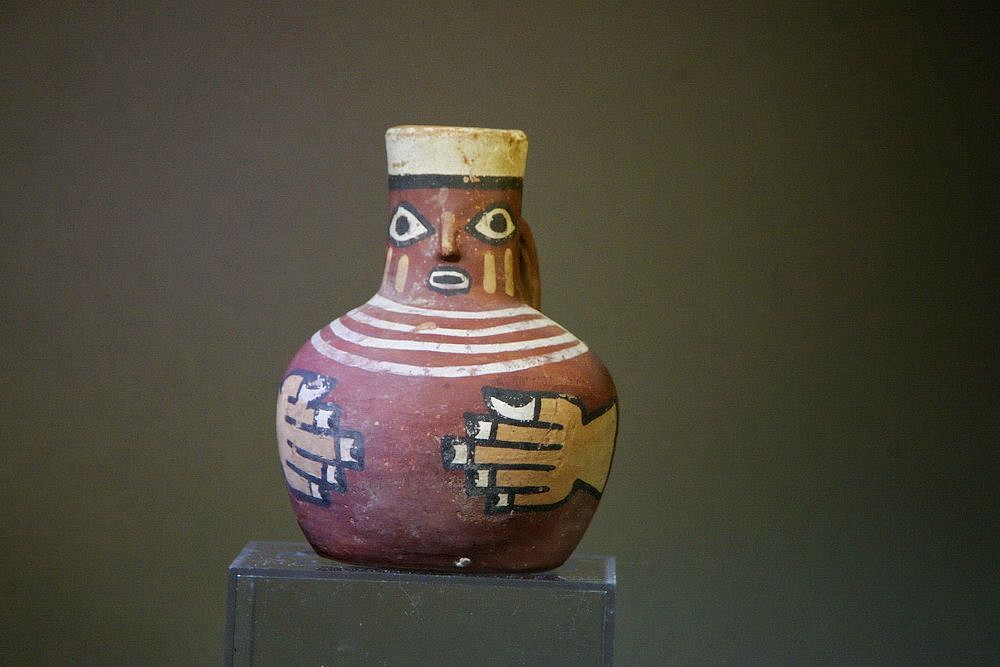





Peru, Wari Miniature Effigy of a Man with Large Hands
This is a common style of figurative vessel painted by the Wari and most likely represents a feasting man with a full belly. The Wari held large communal feasts where food was served along with chicha, corn beer, which was spiked with psychoactive plants such as Peruvian pepper – as found at Wari archaeological sites. This vessel is one of a set that was found at the same gravesite.
Period: Peru, Wari, South Coast, c. AD 650 - 900
Media: Ceramic
Dimensions: Height 4 3/4"
Price Upon Request
n3024





Peru, Wari Pair of Gold and Silver Ear Plugs
This pair of ear plugs has gilt gold fronts attached to silver plugs. The silver plugs were made using a wood matrix, which can be seen in a few exposed areas on the back. It is quite rare to see the wooden matrix intact underneath the gold as it usually disintegrates within a few hundred years. Similar ear spools are illustrated in PRE-COLOMBIAN ART OF SOUTH AMERICA by Alan Lapiner, plate 566.
Period: Peru, Wari, South Coast, c. AD 600 - 750
Media: Metal
Dimensions: Diameter: 2 5/8" x Depth: 3 1/8"
$7,500
n8032
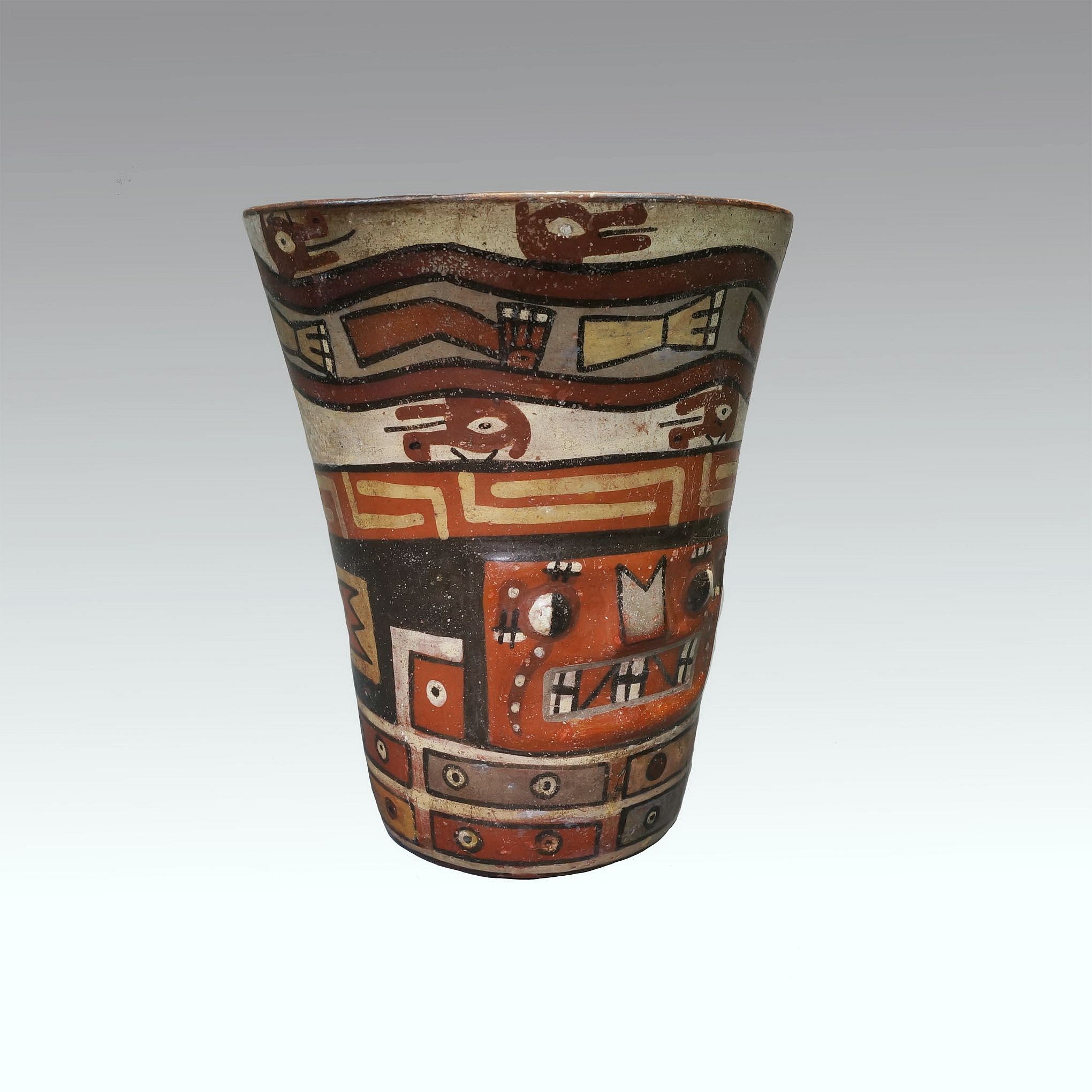
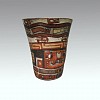
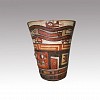
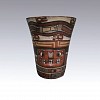
Peru, Wari Polychrome Kero
This is a very colorful example of a classic Wari kero wtih the facial features in relief. There are three registers above the deity's face and one below. Ex-collection Hans Monheim (Achen, Germany).
Period: Peru, Wari, South Highlands, c. AD 650 - 1100
Media: Ceramic
Dimensions: Height 71/4"
Price Upon Request
M4087
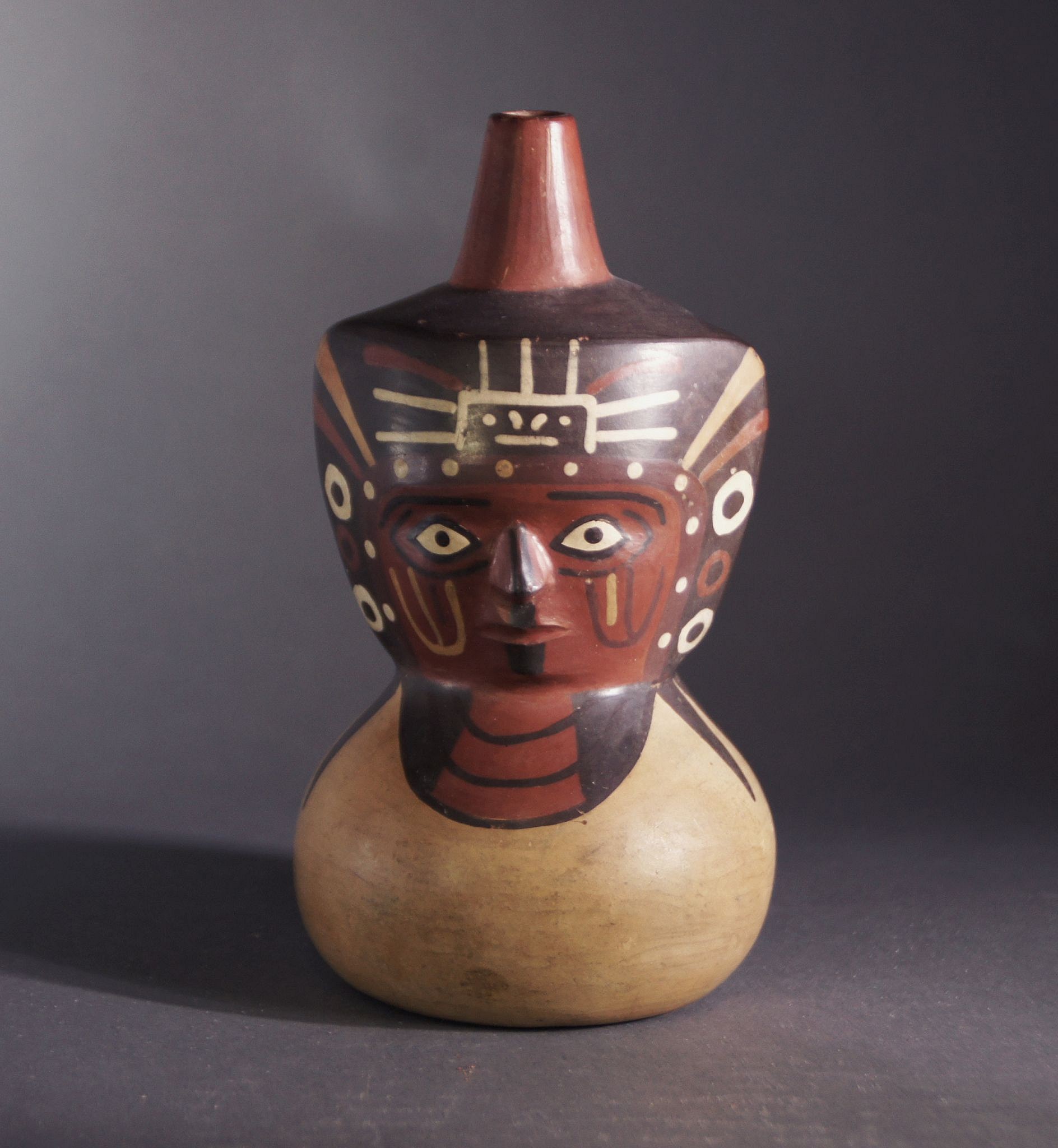


Peru, Wari Single Spout Figural Bottle with Elaborate Facial Decoration
This effigy vessel is painted with an individual wearing a diadem on his headdress and as well as a triple-strand necklace, indicating that he is a shaman or other important personage. He wears a black head covering, which is depicted draped around the shoulders. Ex. collection Anton Roeckl, Munich. T/L tested in Berlin.
Period: Peru, Wari, South Coast, c. AD 600 - 900
Media: Ceramic
Dimensions: 6 in.
Price Upon Request
94114A
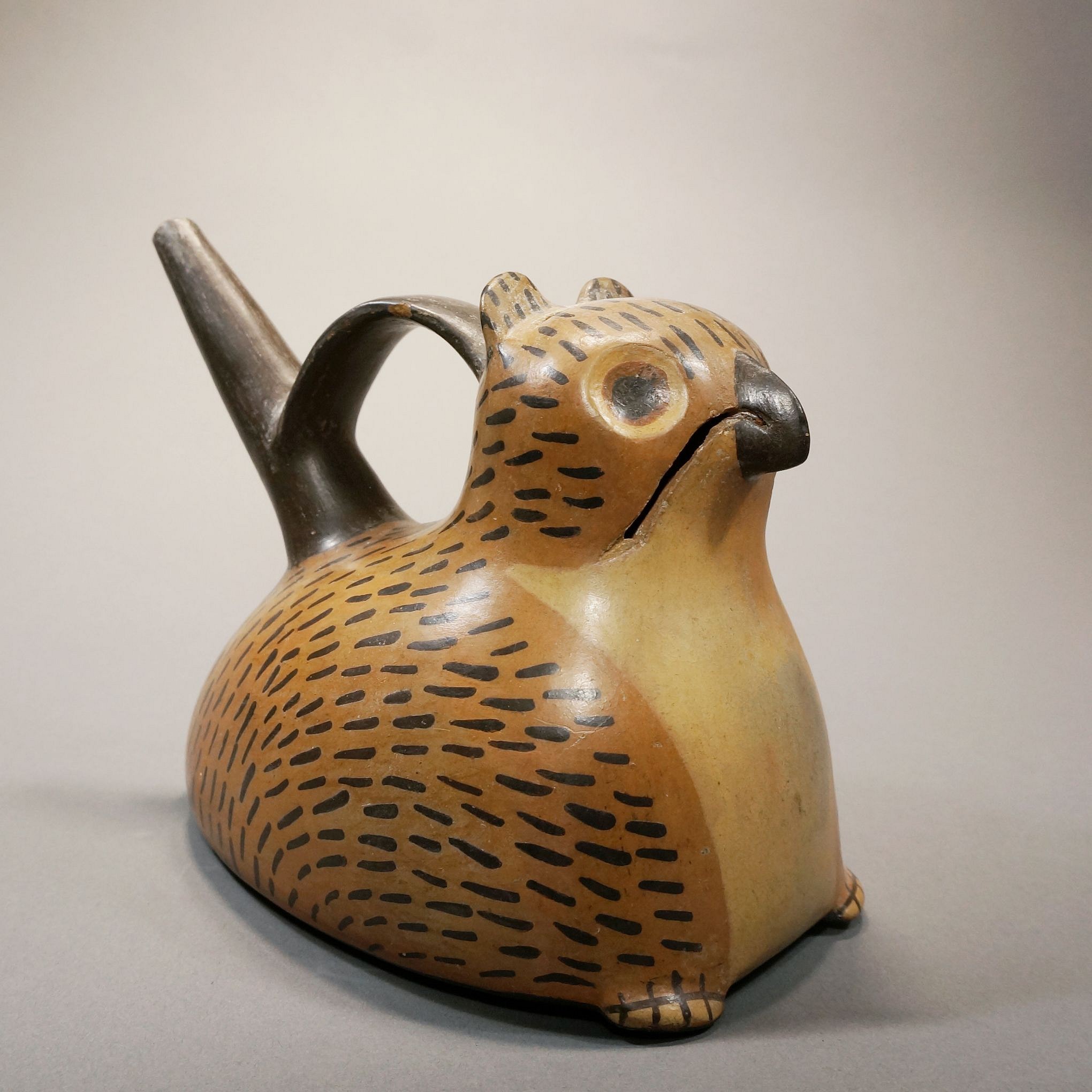
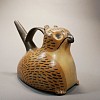
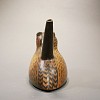
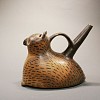
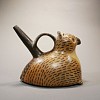
Peru, Wari Single Spout Owl Effigy Vessel in tan with black highlights
The effigy has black dashes representing feathers along its body. The chest of the owl is painted a lighter shade of tan with two feet protruding from the base. A very similar vessel is illustrated in José Antonio Lavalle "Nazca" (1986: 158). Ex-Collection Monheim (Achen, Germany).
Period: Peru, Wari, Coastal, circa AD650-1100
Media: Ceramic
Dimensions: Height 8" (20cm) x Length 8.5" (21.5cm)
Price Upon Request
M4093
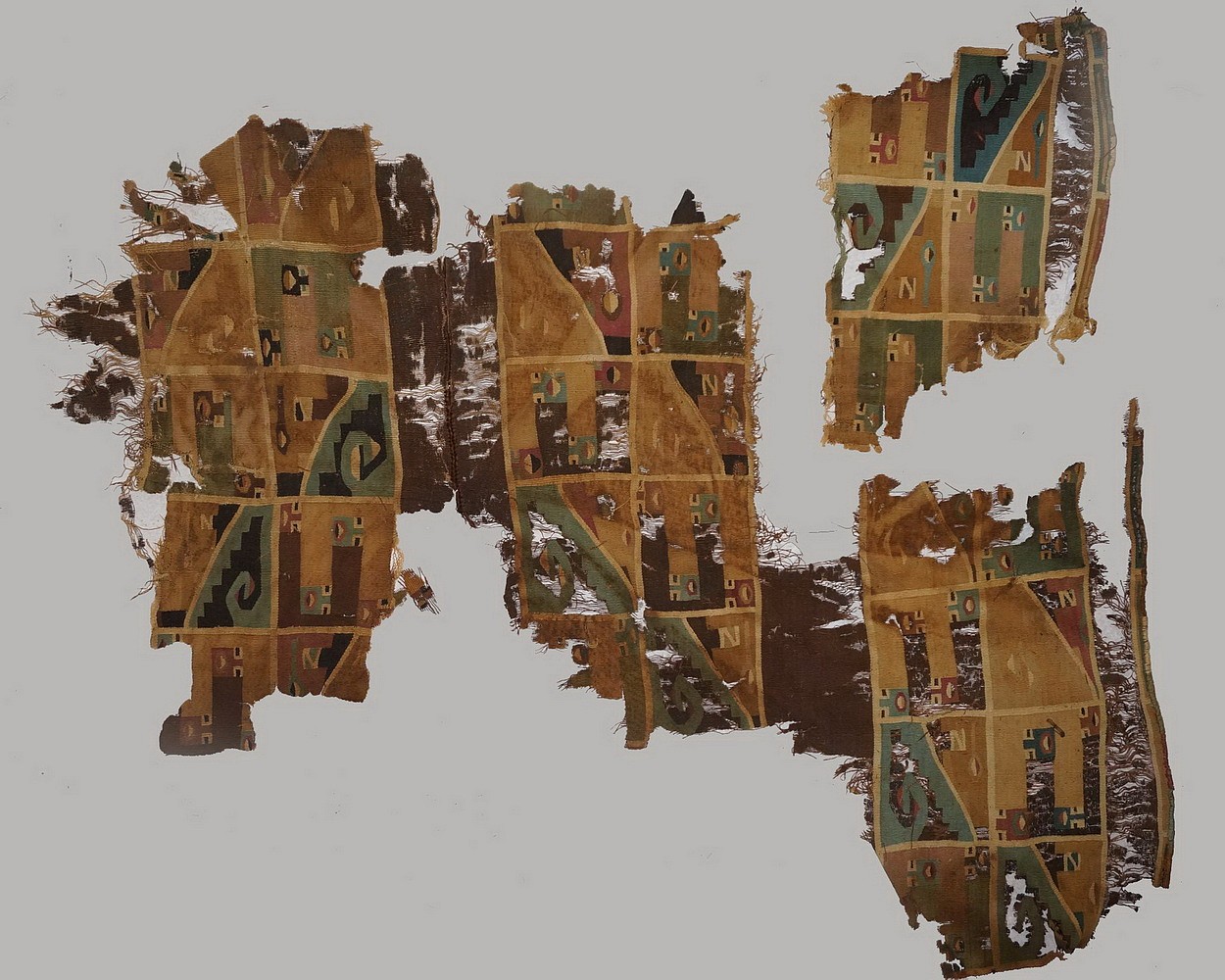



Peru, Wari Tapestry Sections to a Tunic from the Highlands
The tunic is a very finely woven section which depicts the classic step fret and puma motif. One large section includes the central seam with compressed design. Originally the tunic was woven with four bands of design separated by solid brown bands and the side seams had a compressed design. The warps are twisted with brown alpaca and white cotton indicating that the tunic was woven in the highlands. Included with the two main sections there are four additional sections that are incomplete.
Period: Peru, Wari, Highlands, c. AD 550 - 750
Media: Textile
Dimensions: Width: 30" X Height: 30"
Section: Width: 8" X Height 10"
4 extra sections measure from widths 5 1/2" to 8" and height from 5 1/2" to 12"
Price Upon Request
n7062
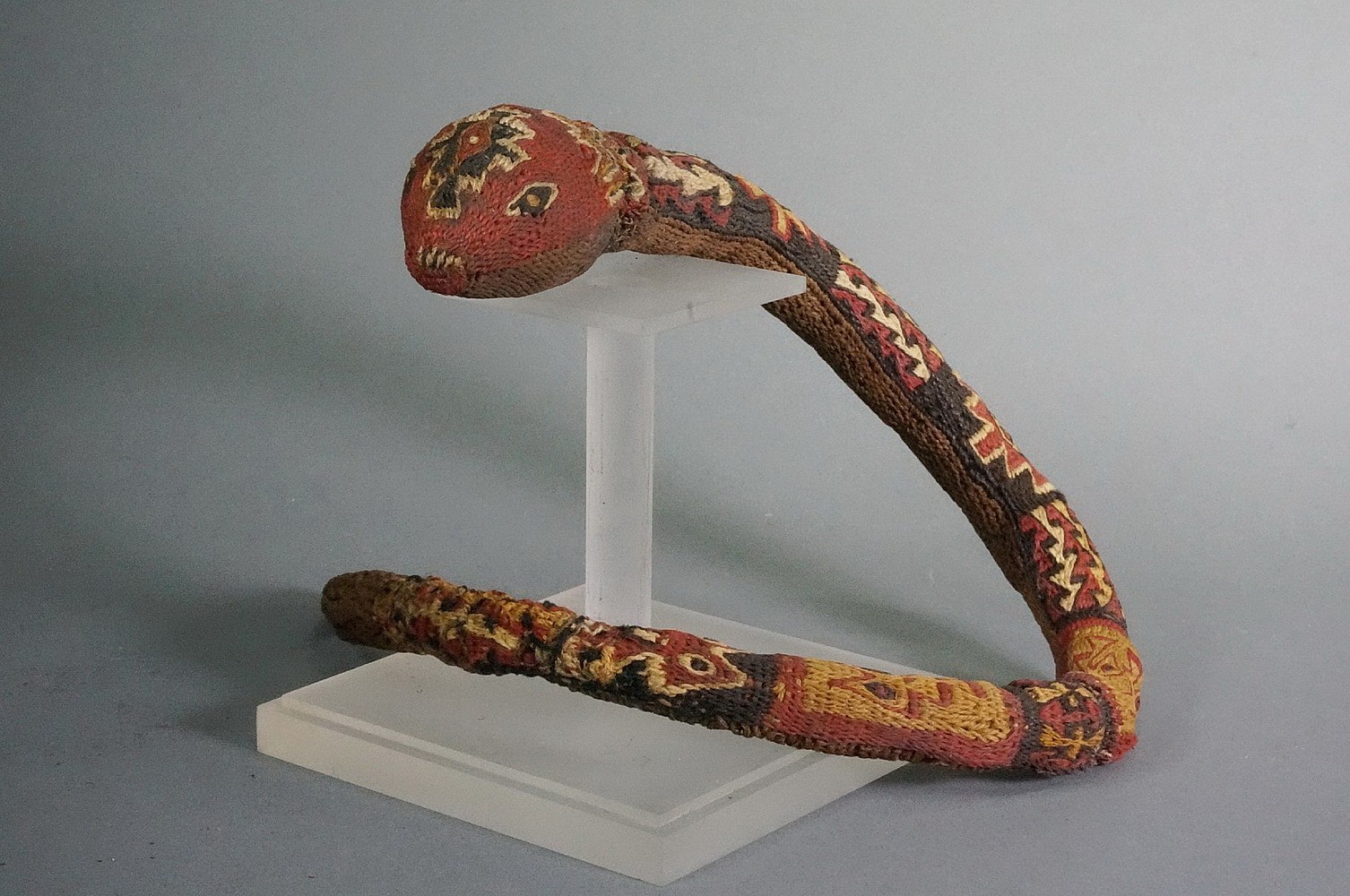




Peru, Wari three dimensional coil woven snake dance wand
Shamans use dance wands hypnotize their attendants. This wand has 6 different patterns on its back and a solid brown underside. The tip has a 3" section of woven hemp which appears to be poisonous. There are many poisonous snakes in Peru including the dangerous Bushmaster. Formerly in the collection of Justin and Barbara Kerr, acquired from Alan Lapiner in 1967.
Period: Peru, Wari, Late Phase, Central Coast, c. AD 900 - 1100
Media: Textile
Dimensions: Length: 19 1/2" x Diameter: 1 1/2" tapering to 3/8"
Price Upon Request
n7016








Peru, Wari Tie-Dye Panel in Longstrip with Diamond Resist Motif
This panel highlights the complex dye techniques which used in ancient Peru. There are two shades of red, the darker shade has been overdyed. The first time the panel was dipped into the dye bath, several circles were tied off and the entire panel was dyed red. The tied circles remained white and more circles were tied into the fabric. The panel was then dipped into a second bath of a darker red dye. This created the light red circles and the white circles on a dark red background. The ends are finished with a knit trim, dyed green, yellow, and red.
Period: Peru, Wari, South Coast, c. AD 600 - 900
Media: Textile
Dimensions: Length: 83" X Width: 4 3/4"-5"
Price Upon Request
96121
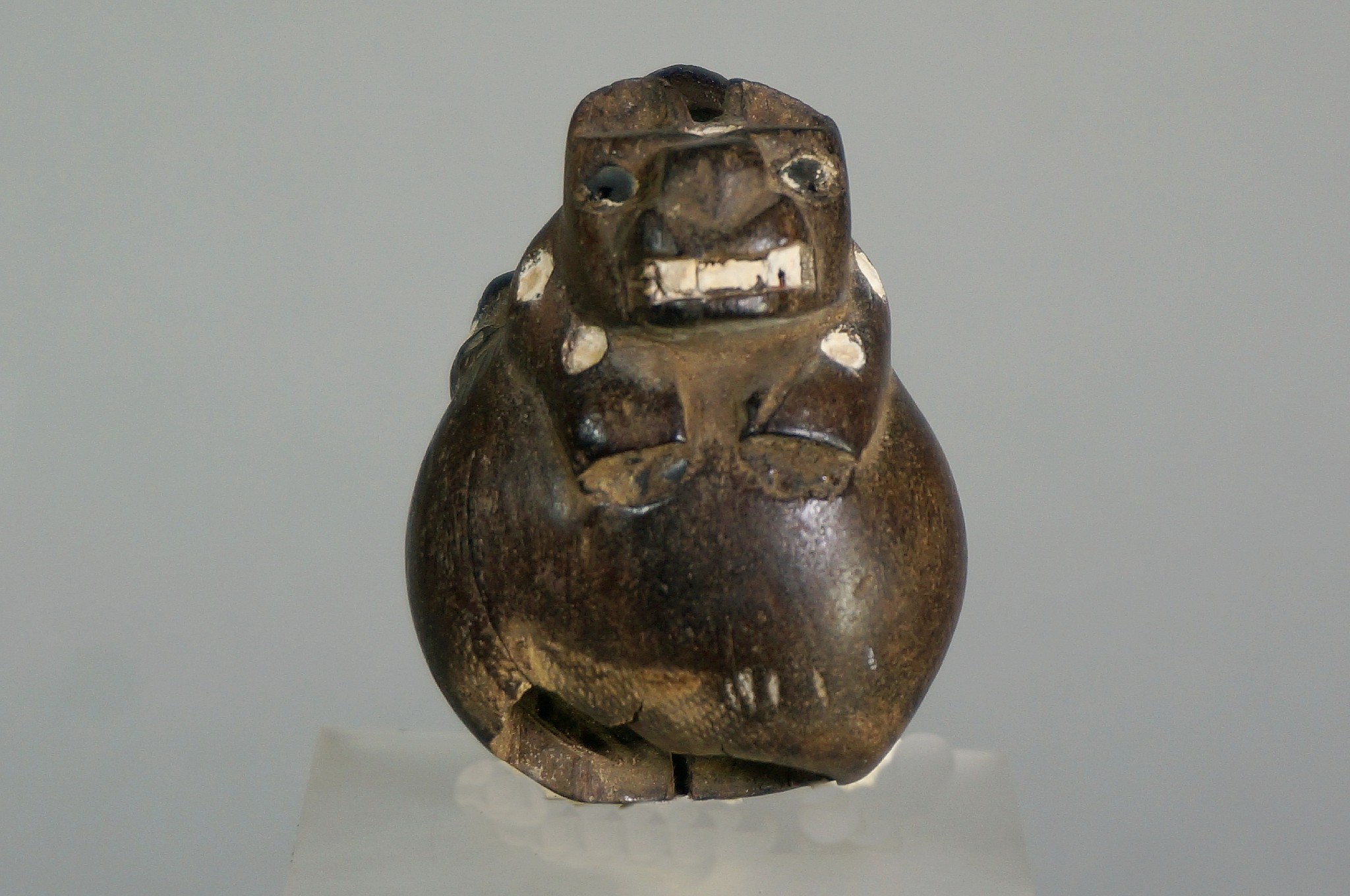





Peru, Wari Wood Lime Container with a Feline on Top with Original Shell Inlays
A small wood lime container with its original top. A recumbent feline is carved on top in high relief,
with traces of its shell teeth and spots. The bottom has been disfigured.
Period: Peru, Wari, South Coast, c. AD 600 - 900
Media: Wood
Dimensions: Height: 2"
$1,250
94265a
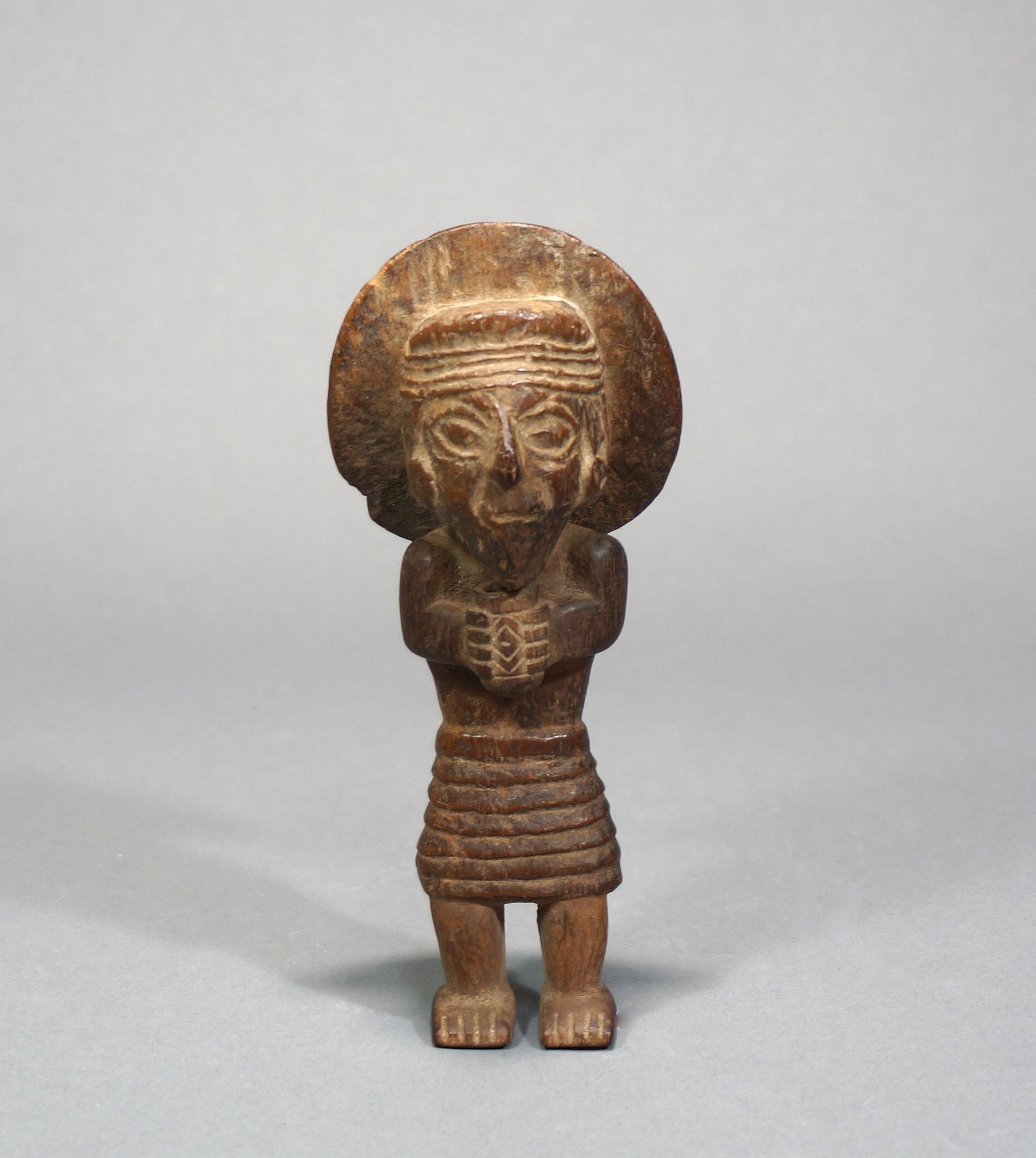




Peru, Wooden Man
Effigy figure of a high status individual wearing an unusual circular feather head dress and holding a kero. The shirt is also unusual, with a multi-layered construction.
Media: Wood
Dimensions: h: 5 3/4"
Price Upon Request
n4004
